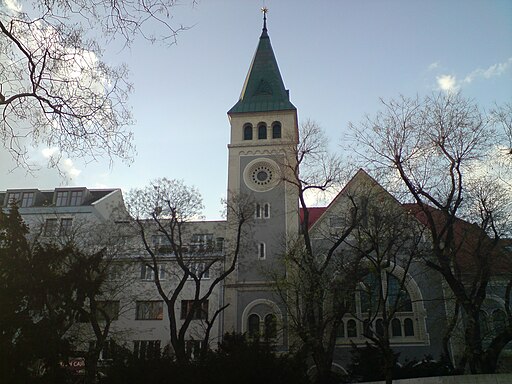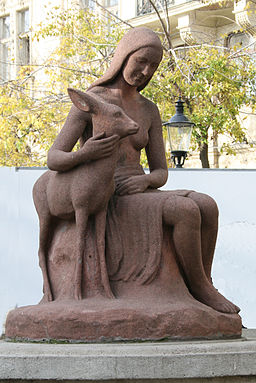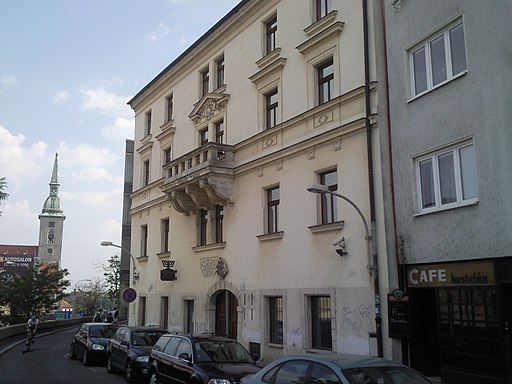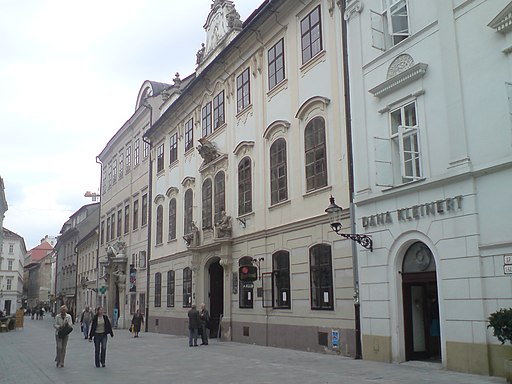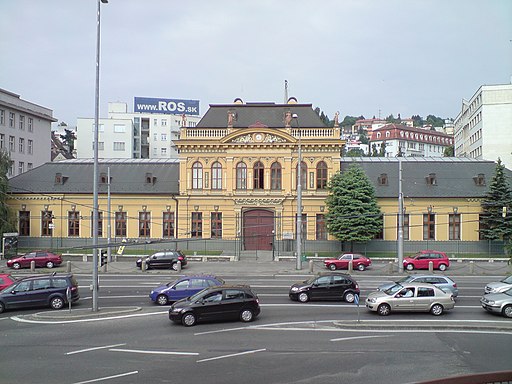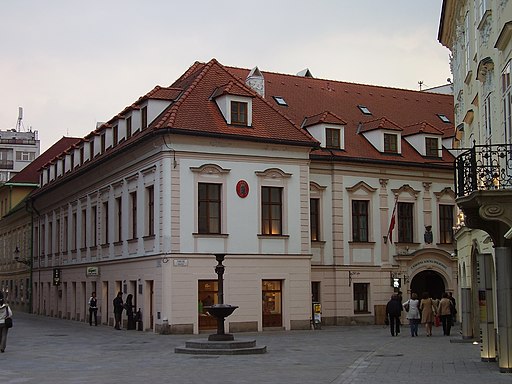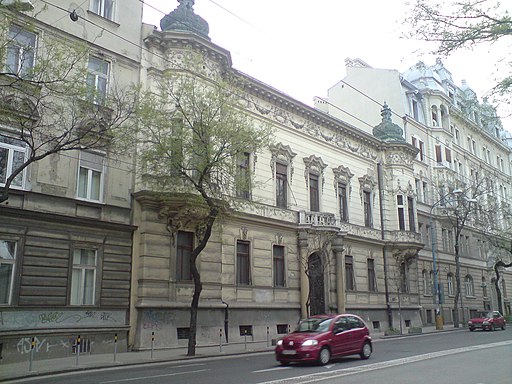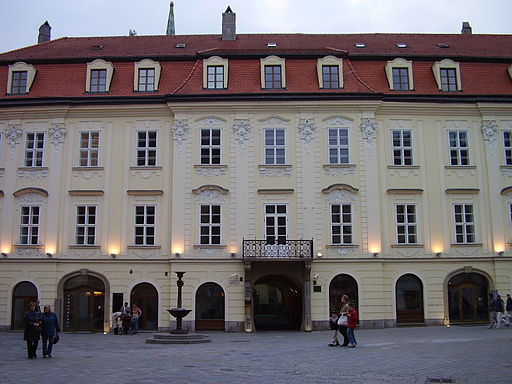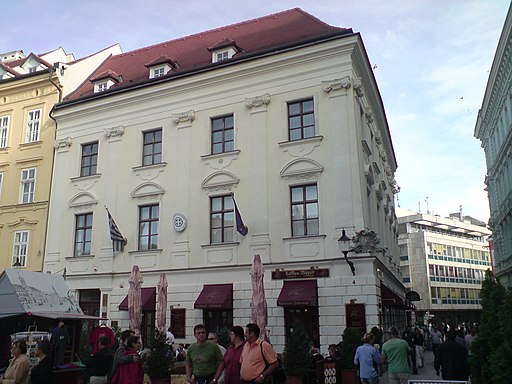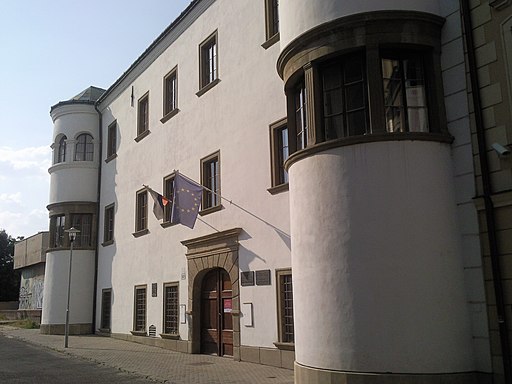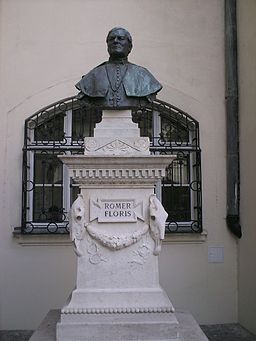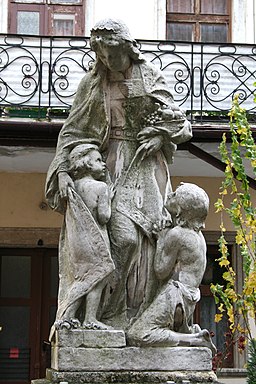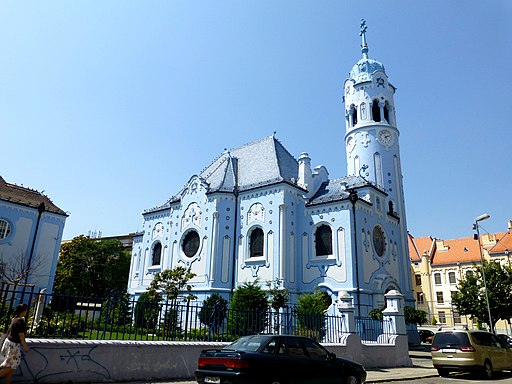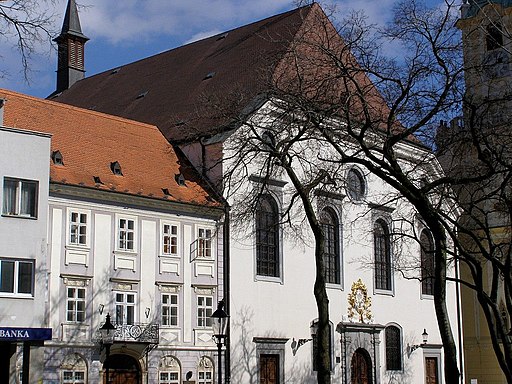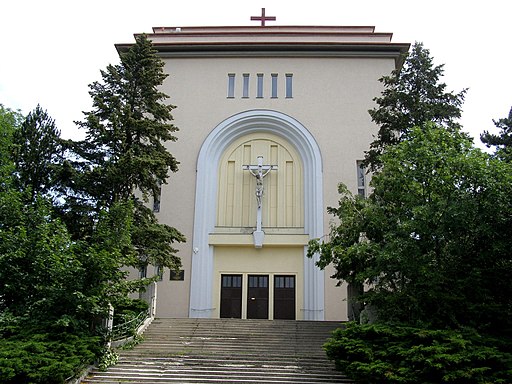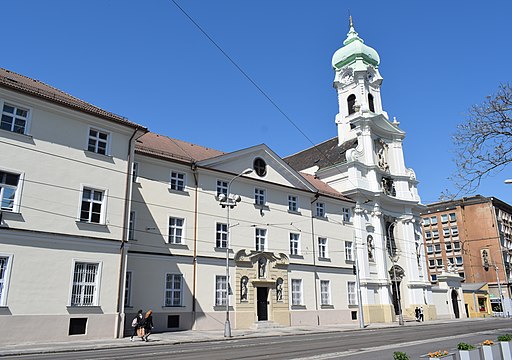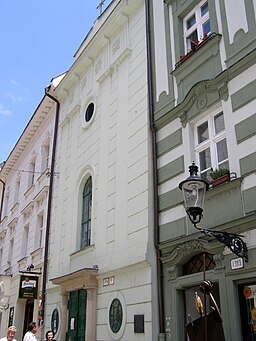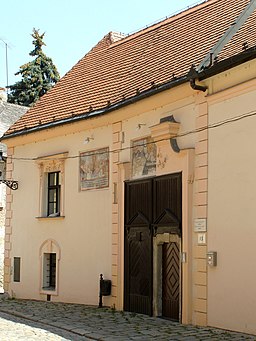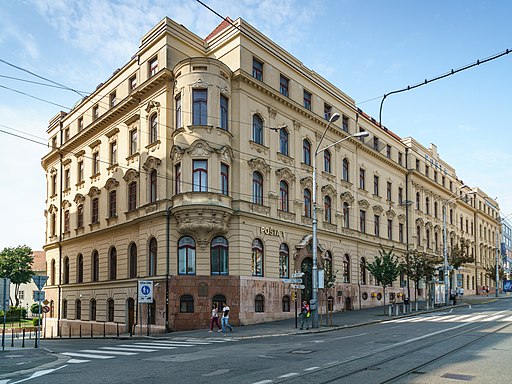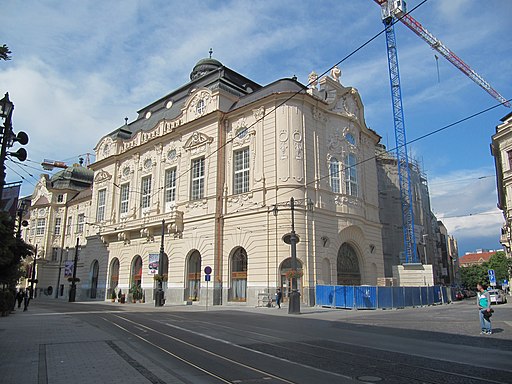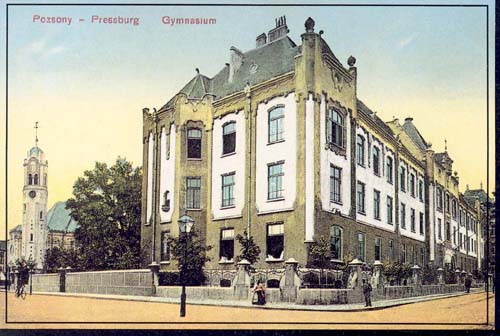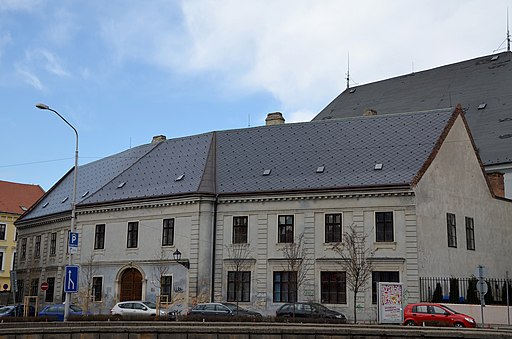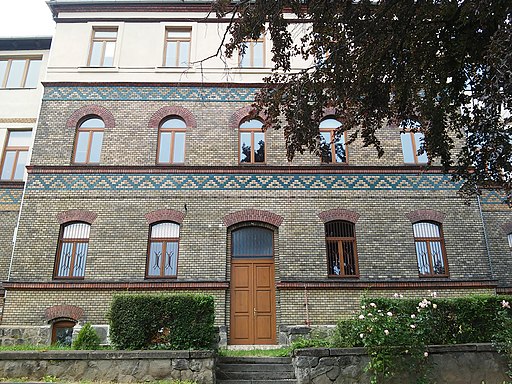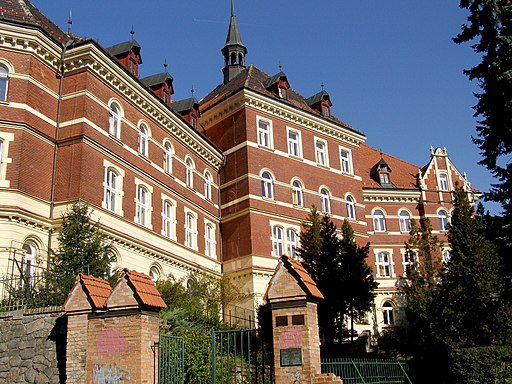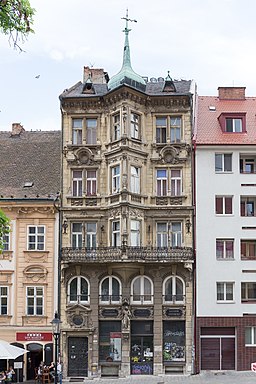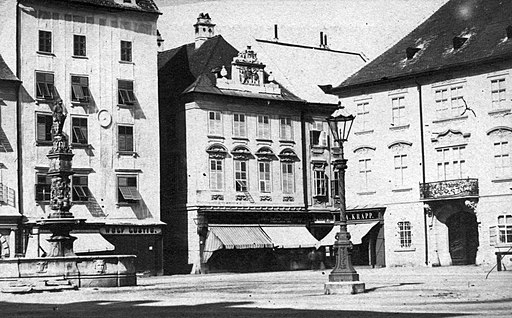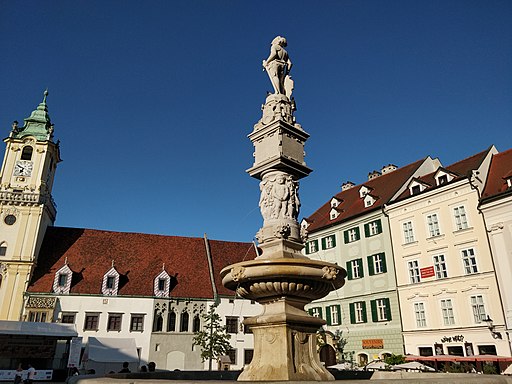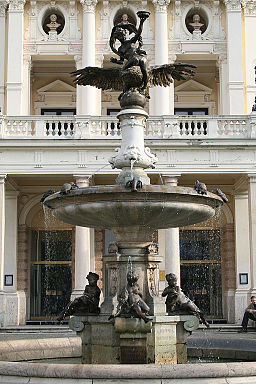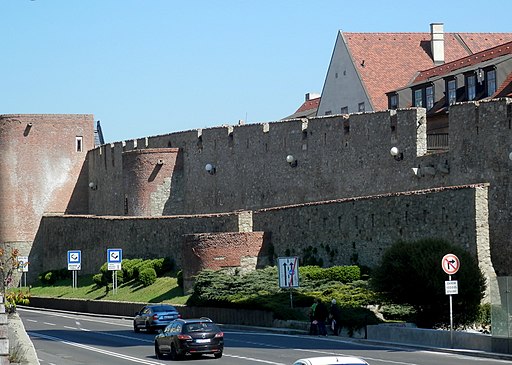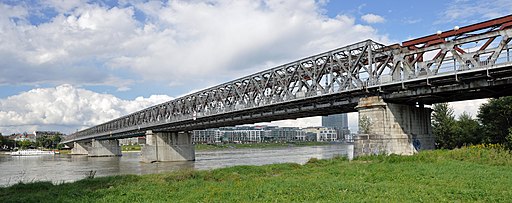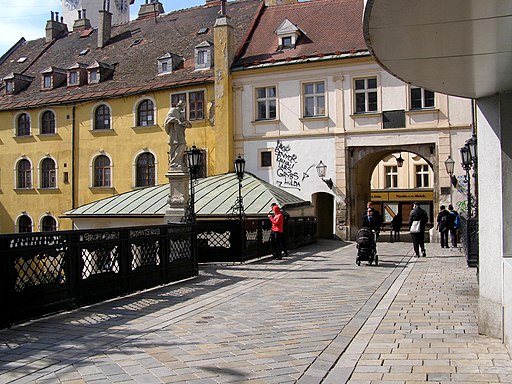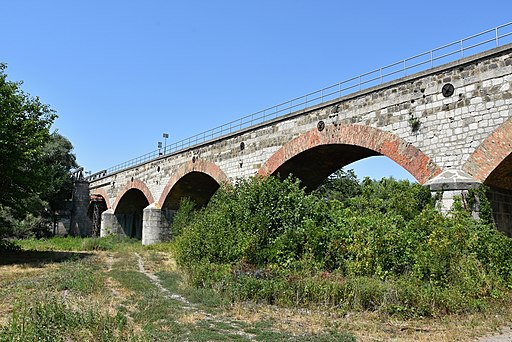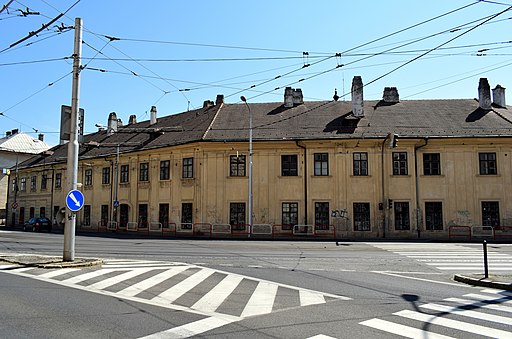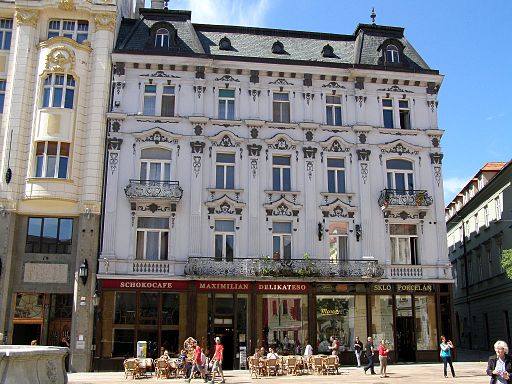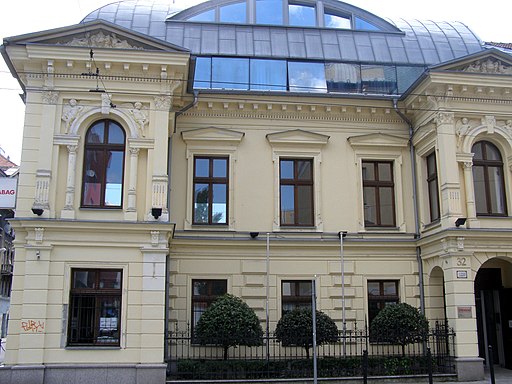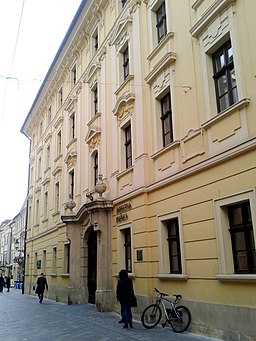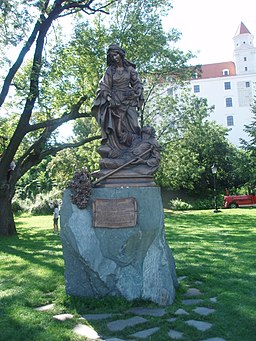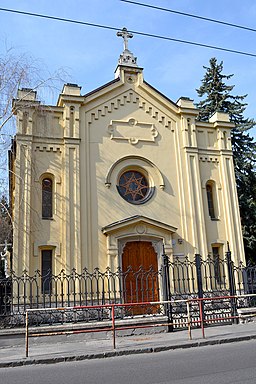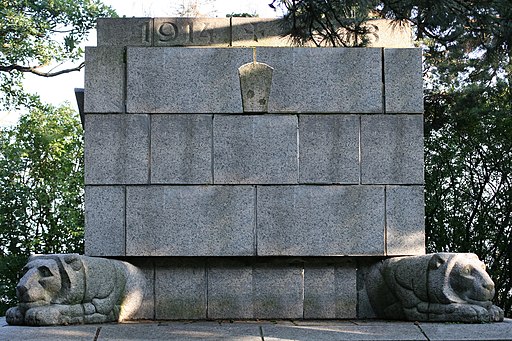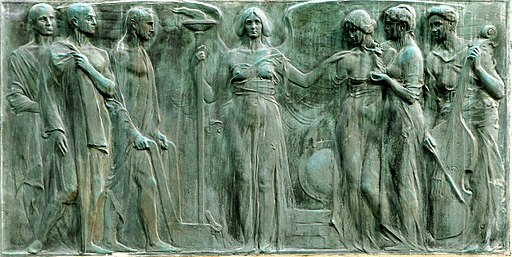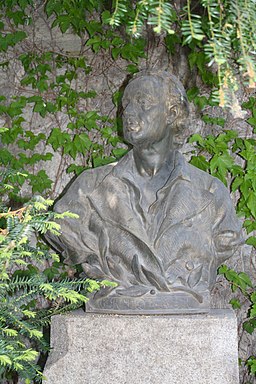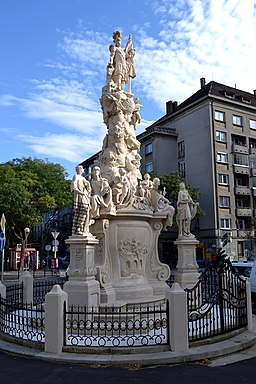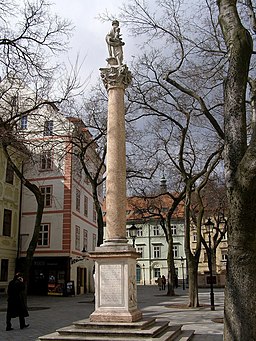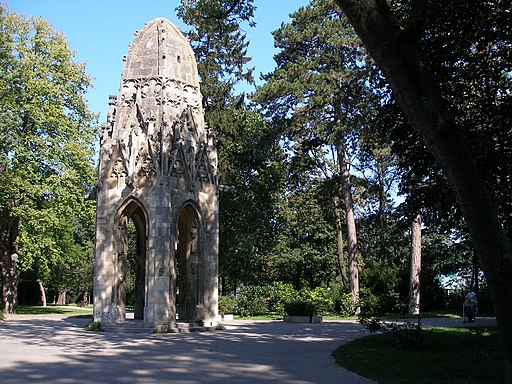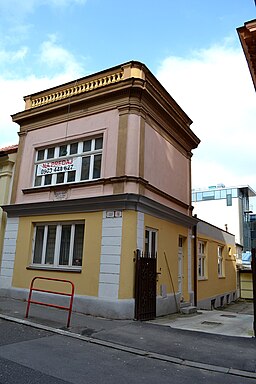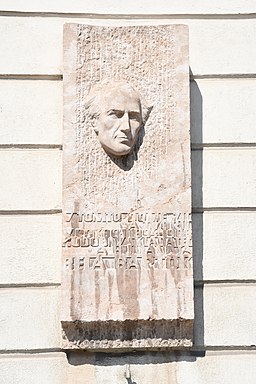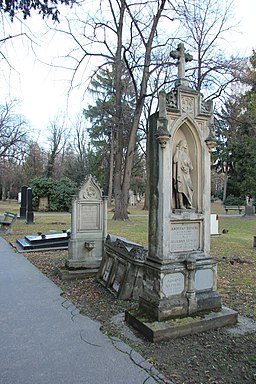Pozsony
Slovak:
Bratislava, Prešporok
Latin:
Posonium, Wratisslaburgium, Bisonium
Historical Hungarian county:
Pozsony
District:
Bratislavský kraj
GPS coordinates:
48.143452, 17.108374
Population
Population in 1910
| Total |
78223 |
| Hungarian |
40.53% |
| German |
41.92% |
| Slovak |
14.92% |
The present-day town was founded by Hungarians, who arrived in the Carpathian Basin in 895. It took its name from the first ispán of the county established by King Stephen I of Hungary in 1000. Its castle repeatedly defended the country from the German armies arriving with the purpose of conquest. King Sigismund of Hungary fortified it against the Czech Hussite plunderers, whose attack it could finally repel. King Matthias of Hungary founded a Renaissance university in the town called Academia Istropolitana in 1467. But Pozsony gained its real significance after the Turks occupied the country's capital, Buda, in 1541. The new capital of Hungary became Pozsony. In the following centuries, 10 ruling kings and 1 queen of the Habsburg House were crowned in St. Martin’s Cathedral, and the country assemblies were also mostly held in the town. Many churches, aristocratic palaces and public buildings were built in the town worthy of its rank. The anti-Habsburg Hungarian insurgents occupied it more than once. The Hungarian baron and ispán of Pozsony County Pálffy Pál expanded the palace and added the four ornamental towers and Empress Maria Theresia turned it into Baroque style. The country assembly in 1836 made Hungarian the official language of Hungary instead of the Latin. The first horse-drawn railway of Hungary was also opened between Pozsony and Nagyszombat. In 1919 the Czechoslovak army invaded the predominantly Hungarian and German town, fired at the peacefully protesting crowd and tore down the Hungarian statues. The violent Slovakization of the town began afterwards. After 1945 the remaining Hungarian and German inhabitants of the town were displaced, but the old buildings and monuments of the town will always preserve their memory.
Check out other towns in Hungary as well!
Ancient times
Celtic then Roman settlements.
from 568 to the 9th century
Large Avar settlement during the period of the Avar Khaganate. After the fall of the Avars, the Moravians occupied the northeastern corner of the Carpathian basin.
around 833
The Moravian Mojmir built a wooden palisade on top of the castle hill (time is uncertain).
895
Arrival of the Hungarians
Little more...
895
The alliance of the seven Hungarian tribes took possession of the then largely uninhabited Carpathian Basin. Until then, the sparse Slavic population of the north-western Carpathians had lived under Moravian rule for a few decades after the collapse of the Avar Khaganate in the early 9th century.
902
Hungarians destroyed the Moravian fortification, and settled in the area. The Moravian "Empire" ceased to exist in 907 for ever.
907
Battle of Pozsony
Little more...
907
The Hungarians, fighting as nomadic horse archers, won a crushing victory over the huge East Frank army that was trying to destroy them. In this way, the Hungarians managed to ensure not only their survival but also the independence of their new homeland.
1000
Foundation of the Hungarian Kingdom
Little more...
1000
The Kingdom of Hungary was established with the coronation of King Stephen I. He converted the Hungarians to Christianity and created two archdioceses (Esztergom and Kalocsa) and ten dioceses. He divided Hungary into counties led by ispáns, who were appointed by the king.
1000
Saint Stephen organized the counties, as the units of the royal administration of Hungary. Pozsony (Poson) County was created, and on top of the castle hill a new fort was constructed with wooden walls filled with earth. The head of the castle and the county had the title "ispán", and he was a man of the king.
1029
The area between the Lajta (Leitha) and Fischa rivers was a "gyepű" (a scarcely populated borderland) between Hungary and the Holy Roman Empire. The Germans were plundering the area, and the Hungarians, in retaliation, broke into Bavaria.
1030
Under the pretext of this, the Holy Roman Emperor Conrad II attacked Hungary to make it a vassal. The Bohemian vassal of the Emperor occupied Pozsony. Stephen I of Hungary applied the strategy of scorched earth. The hungry and weakened German army retreated and was surrounded and defeated by the Hungarians near Vienna. The area between the Lajta (Leitha) and Fischa rivers went under Hungary rule.
1041
The Hungarian notables dethroned the tyrannical Orseolo Péter (Peter) and elected Aba Sámuel as the new king of Hungary. Péter sought refuge at the Holy Roman Emperor Henry III.
1042
Aba Sámuel's army was devastating in present day Austria to slow down the German attack. Henry III occupied Pozsony and advanced to the Garam River.
1043
Henry III launched a new attack but his army got stuck in the marshes of the Rábca River. A peace was negotiated and Aba Sámuel renounced the area between the Lajta (Leitha) and Fischa rivers and the Marchfeld (the lower right banks of the Morava river).
1044
The Hungarian notables turned against Aba Sámuel and asked Henry III to intervene on their side. They defeated Aba Sámuel at Ménfő and Orseolo Péter occupied the throne.
1045
To solidify his rule Orseolo Péter swore fealty to Henry III.
1046
The Hungarians rose up against Orseolo Péter. Archbishop Gellért invited the expelled sons of Vazul (the cousin of Stephen I), Endre and Levente, to the throne. They soon marched in with Russian auxiliary troops. They pretended to support the parallel pagan uprising of Vata and together they chased away Orseolo Péter, but the pagans killed Archbishop Gellért. After András was crowned, he put down the pagan uprising.
1051
Henry III attacked Hungary, but the Hungarians managed to turn back his fleet carrying his supplies with a trick, by making them believe it was the order of the Emperor. The Hungarians hit the starving Germans with constant skirmishes. Finally Henry III begged for peace. King András sent them plenty of food, and the Germans, being happy to have survived, rushed home. The Vértes Mountain got its name after the plenty of armors (vért in Hungarian) and weapons the Germans left behind.
1052
Henry III lay siege to Pozsony, but failed. According to the legend, his fleet was sunk by Kund the Diver.
1074
After the battle of Mogyoród, King Salamon, supported by Henry IV, fled to Pozsony before his cousins, Géza and László. Géza became the new king of Hungary.
1108
Prince Álmos, a pretender to the throne of Hungary asked the help of Henry V. The Emperor besieged Pozsony, but after several months he finally gave up and made peace with Kálmán, the king of Hungary.
1146
Prince Borisz, a pretender to the throne of Hungary, with the army of Henry II, Duke of Bavaria, occupied Pozsony, but on 11 September 1146 Géza II of Hungary defeated their army in the battle by the Fischa River.
1241-1242
Mongol Invasion
Little more...
1241-1242
The hordes of the Mongol Empire invaded Hungary and almost completely destroyed it. One third to one half of the population was destroyed. The Mongols also suffered heavy losses in the battle of Muhi and they could not hunt down the king. After their withdrawal, King Béla IV reorganized Hungary. He allowed the feudal lords to build stone castles because they were able to successfully resist the nomadic Mongols. The vast majority of stone castles were built after this. The king called in German, Vlach (Romanian) and Slavic settlers to replace the destroyed population.
1241
The castle of Pozsony successfully withstood the Mongolian attack.
after 1242
King Béla IV ordered the construction of stone castles throughout Hungary, because they were successful against the Mongols. A stone castle was constructed in Pozsony as well, as a royal castle. Most of the castles in present day Slovakia were constructed in this period by Hungarian nobles.
1262
Béla IV of Hungary named his son Béla as his heir. This angered his other son István, who defeated the army of Béla IV at Pozsony.
April 1271
King Ottokar II of Bohemia occupied Pozsony along with other castles and towns of northwest Hungary. He established a great power, his domain stretched from Silesia to the Adriatic Sea. He wanted to be Holy Roman Emperor, but the electors fearing his power elected Rudolf from the House of Habsburg instead.
July 2, 1271
After the defeat of the army of Ottokar at Mosony, according to the peace treaty, the occupied territories were recovered by King Stephen V of Hungary.
August 6, 1272
After the death of Stephen V of Hungary, the Aba family rose up against Queen Elisabeth and they wanted to kidnap her child László, the heir to the throne. The rebellion was subdued, but the Abas fled to the court of Ottokar II of Bohemia and handed over the castle of Pozsony to him, who wanted to extend his power over Hungary.
early May 1273
Master Egyed of the Aba clan repented his treason, returned to Hungary and gave back Pozsony Castle to King László IV of Hungary.
August 8, 1273
Ottokar II of Bohemia invaded Hungary with a great army of 60 thousand Czech and German soldiers. Ottokar besieged and captured Pozsony. Afterwards he conquered the whole Pozsony County up to the Vág River.
November 21, 1276
The joint action of Rudolf I of Germany (also known as Rudolf of Habsburg) and László IV of Hungary (or Ladislaus the Cuman) forced Ottokar II of Bohemia to make peace. Hungary regained its territories and Ottokar made himself a vassal of Rudolf I of Germany.
July 12, 1277
King László IV of Hungary and Rudolf I strengthened their alliance. Ottokat II of Bohemia, who was reluctant to fulfill his obligations, finally gave back the occupied Hungarian castles.
26th of August, 1278
In the battle of Marchfeld the allied armies of Rudolf and László IV of Hungary finally defeated Ottokar II of Bohemia. This event marked the rise of the House of Habsburg. The Hungarian cavalry played a decisive role in the battle.
1301
The extinction of the House of Árpád
Little more...
1301
The House of Árpád, the first Hungarian royal dynasty, died out with the death of King Andrew III. Hungary was ruled by oligarchs, the most powerful of whom was Csák Máté, whose main ally was the Aba family. King Charles I (1308-1342), supported by the Pope, eventually emerged as the most prominent of the contenders for the Hungarian throne. But it took decades to break the power of the oligarchs.
1301
András III, the last Hungarian king of the House of Árpád died. His widow, Elisabeth moved to Vienna, and later to a nunnery. Pozsony County went under Austrian administration under the title of her sustenance.
February 1327
King Charles I of Hungary made an alliance with King John of Bohemia in Nagyszombat in order to support Duke Otto of Austria against the other Austrian dukes.
February 1328
Charles I of Hungary launched his campaign against Austria and occupied several castles. On the 23th of July John of Bohemia also attacked.
September 21, 1328
A peace was negotiated in Bruck an der Leitha. Hungary recovered Pozsony, which had been under Austrian administration since 1301. It was managed by royal ispáns afterwards.
1386
During the game of thrones after the death of King Louis I of Hungary (Louis the Great), Queen Mary, the wife of Sigismund (later Holy Roman Emperor), pawned Pozsony County to the Moravian marquess Jodok and Prokop to gain their support.
1389
King Sigismund of Hungary paid the debt. Unlike Jodok, Prokop was unwilling to return the properties to Sigismund, so the Hungarian king had to retake many castles of Pozsony County by siege. Sigismund gave Pozsony to his most faithful follower, the polish Stibor of Stiboric who died in 1414.
1405
King Sigismund made Pozsony a free royal town.
1423
King Sigismund demolished the old castle of Pozsony, and ordered the construction of a large rectangular palace surrounded by massive stone walls, which were made ready for cannons. Only the Crown Tower was left of the old castle. Among other factors they were preparing for the Hussite threat.
1428
Czech Hussite plunderers set the outskirts of Pozsony on fire, but they didn't dare to attack the castle.
1440
After the death of King Albert, the Estates of Hungary elected the Polish Ulászló to the throne. Elisabeth, the widow queen, in order to secure the throne for László, her baby boy, called in the Czech Hussite mercenary leader Jan Jiskra. She gave him the title "Captain of the Mining Towns and Kassa", and gave him the castle of Zólyom.
1440-1441
The Czech Hussites soon occupied most of northern Hungary. They reinforced the castles and turned them into bandit lairs. They were pillaging everywhere and large areas became uninhabited. They wiped out the local German and Hungarian population, who were replaced by Czech and other Slavic settlers. The Czech Hussite devastation largely contributed to the Slavicisation of northern Hungary (now Slovakia).
1441
The followers of Queen Elisabeth tried to occupy Pozsony in vain from the followers of Ulászló I. Ulászló I was supported by Hunyadi János.
1450
Pozsony County became the property of Hunyadi János the Turk beater.
1453
Hunyadi János had to hand Pozsony over to King László V, who appointed the baron Cillei Ulrik as ispán of Pozsony.
1456
Siege of Nándorfehérvár (Belgrade)
Little more...
1456
The Turkish army of Sultan Mehmed II, the conqueror of Constantinople, besieged the castle of Nándorfehérvár (Belgrade), which was the southern gateway to Hungary. But the Hungarian army, led by Hunyadi János, won a decisive victory over the twice to three times larger Turkish army. The Pope had earlier ordered that church bells should be rung every noon to pray for the victory of the defenders. Hunyadi János died of plague in the camp after the battle.
1462
The army of King Matthias of Hungary, under the command of Szapolyai Imre and István defeated the Hussites. Soon their leader, Jiskra also surrendered and handed over his castles to the king.
1467
King Mátyás founded a renaissance university in Pozsony, the Academia Istropolitana. King Mátyás (Mathias) ruled Hungary from 1458 to 1490.
1526
Battle of Mohács and the splitting of Hungary into two parts
Little more...
1526
Sultan Suleiman I launched a war against Vienna, instigated by the French. Ferdinand I, Duke of Austria, was the brother-in-law of King Louis II of Hungary. The army of the Ottoman Empire defeated the much smaller Hungarian army at Mohács, and King Louis II died in the battle. A group of the barons elected Ferdinand I of the House of Habsburg to the throne, who promised to defend Hungary from the Turks. He was the younger brother of the most powerful European monarch Emperor Charles V. But the nobility chose the most powerful Hungarian baron, Szapolyai János, who was also crowned as King John I. The country was split in two and a decades-long struggle for power began.
1526
The Ottomans defeated the Hungarian army at the battle of Mohács. Queen Mary fled to the castle of Pozsony. Upon receiving the news about the death of King Louis II, a group of the barons elected Ferdinand of the House of Habsburg to the throne.
1527
Pozsony opened its gates before the army of King Ferdinand.
1541
The Turkish occupation of the capital, Buda, and the division of Hungary into three parts
Little more...
1541
The Turks conquered Buda, the capital of Hungary, after the death of King John I. The central part of the country was under Turkish rule for 150 years. The western and northern parts (including present-day Slovakia) formed the Kingdom of Hungary ruled by the Habsburg emperors. The eastern parts (now mainly under Romanian rule) were ruled by the successors of King John I of Hungary, who later established the Principality of Transylvania.
1541
The former capital of Hungary, Buda, was occupied by the Turks. Pozsony became the capital of the Kingdom of Hungary. 10 ruling kings and 1 ruling queen were crowned in Pozsony.
1561
Ferdinand ordered the reconstruction and modernization of the castle.
1570
The establishment of the Principality of Transylvania
Little more...
1570
John II (John Sigismund), the son of King John I of Hungary, renounced the title of King of Hungary in favor of King Maximilian of the House of Habsburg, and henceforth held the title of Prince. This formally created the Principality of Transylvania, which was the eastern half of Hungary not ruled by the Habsburgs and was also a vassal of the Ottoman Empire. John II died in 1571, after which the three nations of Transylvania (the Hungarian nobility, the Székelys and the Saxons) elected the prince.
1604-1606
Uprising of Bocskai István
Little more...
1604-1606
The alliance of the Habsburgs and the Principality of Transylvania was defeated by the Ottoman Empire in the Fifteen Years' War. The war devastated Transylvania, which was occupied by the Habsburg imperial army, and General Basta introduced a reign of terror. The nobility and the burghers were upset about the terror, the plundering mercenaries and the violent Counter-Reformation. Bocskai István decided to lead their uprising after the Habsburg emperor tried to confiscate his estates. Bocskai also rallied the hajdú warriors to his side. He was elected Prince of Transylvania and soon liberated the Kingdom of Hungary from the Habsburgs. In 1605 Bocskai István was crowned King of Hungary with the crown he received from the Turks.
1605
The army of Bocskai István set the outskirts on fire, which were not yet protected by walls, but they could not occupy the town and the castle.
23 June 1606
Peace of Vienna
Little more...
23 June 1606
Bocski István made peace with Emperor Rudolf. Their agreement secured the constitutional rights of the Estates of Hungary, and the freedom of religion. The counties of Szatmár, Bereg and Ugocsa were annexed to the Principality of Transylvania. Bocskai died of illness in the same year, leaving to his successors the idea of unifying Hungary from Transylvania.
1619
The campaign of Prince Bethlen Gábor of Transylvania in the Thirty Years' War
Little more...
1619
At the beginning of the Thirty Years' War (1618-1648), Prince Bethlen Gábor of Transylvania went to war against the Habsburg emperor as an ally of the rebelling Czech-Moravian-Austrian estates. The whole Kingdom of Hungary joined him, only the Austrian defenders of Pozsony had to be put to the sword. With his allies, he laid siege to Vienna. However, he was forced to abandon the siege because the Habsburg-loyal Hungarian aristocrat Homonnai Drugeth György attacked his heartland with Polish mercenaries. On 25 August 1620, the Diet of Besztercebánya elected Bethlen Gábor King of Hungary as vassal of the Turks. He continued to fight after the defeat of the Czechs at White Mountain on 8 November 1620, but without real chance to achieve decisive victory, he decided to come to an agreement with Emperor Ferdinand II.
1619
Bethlen Gábor, Prince of Transylvania, broke into the outskirts of Pozsony, which were already protected by walls. His soldiers cut down 1500 German mercenaries. The defenders of the castle of Pozsony surrendered. Bethlen acquired the Holy Crown of Hungary, which was guarded in the castle.
late October 1619
The army of Prince Bethlen Gábor of Transylvania united with their Czech and Moravian allies under Pozsony. They were preparing for the siege of Vienna.
October 9, 1620
The Imperial army of Dampierre tried to occupy Pozsony, but they were repelled by the defenders and Dampierre also died. Afterwards Prince Bethlen Gábor returned to Pozsony and gave up the planned siege of Vienna. He sent a cavalry of 8000 horsemen to support the Czech insurgents. But the Czechs suffered a decisive defeat on 8 November 1620 in the battle of White Mountain.
April 29, 1621
Pozsony surrendered to the imperial army of General Buquoy.
August 17, 1621
The army of Prince Bethlen Gábor reached Pozsony.
August 31, 1621
Prince Bethlen Gábor of Transylvania gave up the siege of Pozsony and marched to Moravia instead.
31 December 1621
Peace of Nikolsburg
Little more...
31 December 1621
Prince Bethlen Gábor of Transylvania made peace with Emperor Ferdinand II. Their agreement secured the constitutional rights of the Estates of Hungary, and later it was supplemented with the freedom of religion. Bethlen renounced the title of King of Hungary in exchange for seven counties of the Upper Tisza region (Szabolcs, Szatmár, Bereg, Ugocsa, Zemplén, Borsod, Abaúj) for the rest of his life, other estates in Hungary as his private property and the imperial title of Duke of Oppeln and Ratibor (Opole and Racibórz), one of the Duchies of Silesia. Prince Bethlen went to war against the Habsburgs in 1623 and 1626, but was unable to negotiate more favourable terms.
1635-1649
The Hungarian baron and ispán of Pozsony County Pálffy Pál reconstructed the castle. He expanded the palace with a third floor and four decorative towers. The palace gained its present day form.
1664
Victory over the Turks at Szentgotthárd and the shameful Peace of Vasvár
Little more...
1664
The imperial army achieved a significant victory over the Turks at the battle of Szentgotthárd. Despite this, Emperor Leopold I concluded a 20-year peace treaty with the Turks at Vasvár on terms that made it look as if the Turks had won. This caused a huge outcry in Europe and among the Hungarian nobility, who expected the country to be liberated after the victory. The formerly Habsburg-loyal Catholic Hungarian barons began to plot against the Emperor with the leadership of Wesselényi Ferenc. In 1668, at the end of the Franco-Spanish War, King Louis XIV of France withdrew his support for the conspiracy, and the support of the Turks was not obtained.
1671
Exposure of the Wesselényi conspiracy
Little more...
1671
After the exposure of the anti-Hapsburg Wesselényi conspiracy, the main organisers, Zrínyi Péter, Nádasdy Ferenc and Frangepán Ferenc were executed. Wesselényi Ferenc died in 1667. The Croatian uprising, which was part of the conspiracy, was crushed by the Habsburgs in 1670.
1671
After the unveiling of the Wesselényi-conspiracy, Bónis Ferenc was executed in the castle of Pozsony.
after 1671
Kuruc Movement
Little more...
after 1671
Many noble, burgher and preacher fled to the Principality of Transylvania and the territory under Turkish occupation from the reprisals after the exposure of the anti-Habsburg Wesselényi-conspiracy and from the violent Counter-Reformation. They were joined by dismissed Hungarian soldiers of the Turkish border forts, who were replaced by German mercenaries. They were called the fugitives (bujdosók). They started an armed movement against the Habsburg rule. Because of the Turkish ban, the Principality of Transylvania could not openly support them. From 1677, the French supported their cause with money and Polish mercenaries. They achieved their first serious success when they temporarily occupied the mining towns of northern Hungary (now central Slovakia) under the command of Thököly lmre. He then became the sole leader of the movement. In 1679, the French made peace with Emperor Leopold I and withdrew their support for the fugitives. Between 1678 and 1681 Thököly Imre led successful raids against the Habsburgs and their supporters in the territory of the Kingdom of Hungary. The insurgents were called kurucs.
1673
The castle was reinforced with 3 cannon bastions against the kuruc rebels.
1682
Thököly Imre, Prince of Upper Hungary
Little more...
1682
Thököly Imre, the leader of the kuruc insurgents, gained the support of the Turks. He launched a campaign against the Habsburgs in the Kingdom of Hungary. With the support of the Turkish army, he occupied the town of Kassa and also the important stronghold of Fülek. He was then recognized by the Turks as King of Hungary, but he chose the title of Prince of Upper Hungary.
July 26, 1683
Pozsony opened its gates for the insurgents of Thököly Imre, but the castle resisted, and had to be besieged. The Imperial army retreated towards Vienna because of the approaching large Turkish army.
July 27, 1683
The insurgents under the command of Petróczy István crushed the Imperial troop sent by Charles V, Duke of Lorraine, to help the defenders of Pozsony Castle.
July 29, 1683
Charles V, Duke of Lorraine, came personally to liberate Pozsony from the siege of the insurgents. By this maneuver he managed to prevent the Hungarian insurgents of Thököly Imre from uniting with the Turkish army sent to capture Vienna, and he also managed to unite with the Polish army.
1683
Turkish defeat at Vienna and the formation of the Holy League
Little more...
1683
The combined armies of the Habsburg Empire and the Kingdom of Poland defeated the Turkish army besieging Vienna. Emperor Leopold I wanted to make peace with the Turks, but was refused by Sultan Mehmed IV. In 1684, at the persistent urging of Pope Innocent XI, the Holy League, an alliance of the Kingdom of Poland, the Habsburg Empire, the Republic of Venice and the Papal States, was formed to expel the Turks from Hungary. Thököly Imre, who had allied himself with the Turks, was gradually driven out of northern Hungary.
1685
The Turkish captivity of Thököly Imre and the fall of the kuruc movement
Little more...
1685
The Pasha of Várad captured Thököly Imre as he was asking for Turkish help and offered him to Emperor Leopold I for peace. But the Imperial emissaries laughed at his face, because, having the upper hand, they no longer cared for Thököly. On the news of his capture, the town of Kassa and the kuruc strongholds surrendered to the Emperor one after the other. The Turks, seeing their fatal mistake, released Thököly the following year and tried to restore his authority, but his power was broken forever and the Hungarian insurgents no longer trusted the Turks. Most of the insurgents joined the imperial army and helped to liberate the rest of Hungary from the Turks.
1686
Recapture of Buda and the liberation of Hungary from the Turks
Little more...
1686
The army of the Holy League recaptured Buda from the Turks by siege. In 1687, the Imperial army invaded the Principality of Transylvania. The liberation was hindered by the French breaking their promise of peace in 1688 and attacking the Habsburg Empire. By 1699, when the Peace of Karlóca was signed, all of Hungary and Croatia had been liberated from the Ottoman Empire with the exception of Temesköz, the area bounded by the Maros, the Tisza and the Danube rivers. It was not until the Peace of Požarevac in 1718 that Temesköz was liberated from the Turks. However, the continuous war against the Turkish invaders and the Habsburg autocracy, which lasted for more than 150 years, wiped out large areas of the Hungarian population, which had previously made up 80% of the country's population, and was replaced by Vlachs (Romanians), Serbs and other Slavic settlers and Germans. The Habsburgs also favoured the settlement of these foreign peoples over the 'rebellious' Hungarians.
1703-1711
Hungarian War of Independence led by Prince Rákóczi Ferenc II
Little more...
1703-1711
After the expulsion of the Turks, the Habsburgs treated Hungary as a newly conquered province and did not respect its constitution. The serfs rose up against the Habsburg ruler because of the sufferings caused by the war and the heavy burdens, and they invited Rákóczi Ferenc II to lead them. Trusting in the help promised by King Louis XIV of France, he accepted. Rákóczi rallied the nobility to his side, and soon most of the country was under his control. The rebels were called the kurucs. In 1704, the French and the Bavarians were defeated at the Battle of Blenheim, depriving the Hungarians of their international allies. The Rusyn, Slovak and Vlach peasants and the Saxons of Szepes supported the fight for freedom, while the Serbs in the south and the Saxons in Transylvania served the Habsburgs. Due to lack of funds Rákóczi could not raise a strong regular army, and in 1710, Hungary was also hit by a severe plague. Rákóczi tried unsuccessfully to forge an alliance with Tsar Peter the Great of Russia. In his absence, without his knowledge, his commander-in-chief, Károlyi Sándor, accepted Emperor Joseph I's peace offer. The Peace of Szatmár formally restored the Hungarian constitution and religious freedom and granted amnesty, but did not ease the burden of serfdom. Rákóczi refused to accept the pardon and went into exile. He died in Rodosto, Turkey.
1703
The kuruc rebels occupied Pozsony County but Pozsony remained a Habsburg stronghold.
October 1706
Rákóczi ordered the kuruc general Forgách Simon to capture Pozsony, but the burghers bribed him to save the town. Forgách was arrested for this later.
1708
After the defeat at Trencsén Castle the rebels lost control of Pozsony County.
1741
During the war of the Austrian succession Empress Maria Theresia fled to Pozsony. Here the Hungarian Parliament voted for the military support of the Habsburg Empire. But previously they made the Empress accept all their demands. The mustered 11 regiment of Hungarian hussars then saved the Habsburg Empire. The decision of the estates of Hungary was influenced by the reemerging Ottoman threat, and they also wanted to avoid another civil war.
1761-1765
Maria Theresia reconstructed the castle of Pozsony in Baroque style.
1780
The first Hungarian language newspaper, the "Magyar Hírmondó" was published in Pozsony.
1780
Joseph II moved the furniture and treasures of the castle to Vienna.
from 1783
The castle functioned as a catholic seminary.
1802
The castle was used as a military barracks.
1806
For a short time the army of Napoleon occupied the castle.
1809
The French army occupied the castle once again and they damaged the structures with cannon fire.
30th of May, 1811
The castle of Pozsony accidentally burned down.
1825-1848
Hungarian Reform Era. The reformers in the Hungarian Diet (Parliament) in Pozsony demanded to make Hungarian the official language of Hungary instead of the Latin, and to modernize the still feudal society and economy of Hungary. The official language became the Hungarian in 1836, but the important economic and social reforms were successfully prevented by the resistance of the Habsburgs and the aristocracy.
1840
The first horse-drawn railway was opened in Hungary from Pozsony to Szentgyörgy.
1848-1849
Hungarian Revolution and War of Independence
Little more...
1848-1849
Following the news of the Paris Revolution on 22 February 1848, the Hungarian liberal opposition led by Kossuth Lajos demanded the abolition of serfdom, the abolition of the tax exemption of the nobility, a parliament elected by the people, and an independent and accountable national government. The revolution that broke out in Pest on 15 March expressed its demands in 12 points, which, in addition to the above mentioned, included the freedom of the press, equality before the law, the release of the political prisoners and the union with Transylvania. A Hungarian government was formed, Batthyány Lajos became prime minister, and on 11 April Emperor Ferdinand V ratified the reform laws. On August 31 the Emperor demanded the repeal of the laws threatening with military intervention. In September the Emperor unleashed the army of Jelacic, Ban of Croatia, on Hungary, but they were defeated by the Hungarians in the Battle of Pákozd on 29 September. An open war began for the independence of Hungary. The Habsburgs incited the nationalities against the Hungarians. The Rusyns, the Slovenes and most of the Slovaks and Germans supported the cause persistently, but the Vlachs (Romanians) and the Serbians turned against the Hungarians. The glorious Spring Campaign in 1849 led by General Görgei Artúr liberated almost all of Hungary. On 1 May 1849, Emperor Franz Joseph, effectively admitting defeat, asked for the help of Tsar Nicholas I of Russia, who sent an intervention army of 200,000 soldiers against Hungary. The resistance became hopeless against the overwhelming enemy forces and on 13 August Görgei Artúr surrendered to the Russians at Világos. Bloody reprisals followed, and on 6 October 1849, 12 generals and a colonel of the Hungarian Revolution, the martyrs of Arad, were executed in Arad. On the same day, Batthyány Lajos, the first Hungarian Prime Minister, was executed by firing squad in Pest. The Habsburgs introduced total authoritarianism in Hungary, but they also failed to fulfil their promises to the nationalities that had betrayed the Hungarians.
1867
Austro-Hungarian Compromise
Little more...
1867
The Habsburg Empire was weakened by the defeats it suffered in the implementation of Italian and German unity. The Hungarians wanted to return to the reform laws of 1848, but they did not have the strength to do so. Emperor Franz Joseph and the Hungarian opposition, led by Deák Ferenc, finally agreed to restructure the Empire and abolish absolutism. Hungary was given autonomy in its internal affairs, with its own government and parliament, which was essential for the development of its economy and culture. However, foreign and military affairs remained in the hands of the Habsburgs and served their aspiration for becoming a great power. The majority wanted Hungary's independence, but they were excluded from political power.
1914
Elisabeth University was founded in Pozsony.
1914-1918
World War I
Little more...
1914-1918
As part of the Austro-Hungarian Monarchy, Hungary took part in the war on the side of the Central Powers.
31th, Oktober 1918
The Czechoslovak Legion tried to occupy Pozsony but the 16-17 year-old pupils of the cadet school of Sopron repelled the attack.
November 1918 - January 1919
The Czech, Romanian and Serbian occupation of Hungary
Little more...
November 1918 - January 1919
In Hungary, the freemasonic subversion brought the pro-Entente Károlyi Mihály to power. The new government, naively trusting the Entente powers, met all their demands and disbanded the Hungarian military, which rendered the country completely defenseless in the most dire need. Under French and Italian command, Czech, Romanian and Serbian troops invaded large parts of Hungary, where they immediately began the takeover. They fired Hungarian railway workers, officials and teachers, banned the use of the Hungarian language, abolished Hungarian education, and disposed of everything that reminded them of the country's Hungarian past. Hundreds of thousands of Hungarians were forced to leave their homeland, and the forcible assimilation of the remaining Hungarians was begun.
2nd of January, 1919
The Czechoslovak Legion occupied Pozsony without a fight.
12th of February, 1919
Pozsony's Hungarian and German population peacefully protested against the occupation. The Czechoslovak Legion fired on the demonstrators. 9 people died, hundreds were injured.
after 1919
The Czechoslovaks destroyed the signs of the town's Hungarian origin. They renamed it to Bratislava, changed the names of the streets and squares, destroyed Hungarian statues and ordered the removal of the Hungarian and German shop signs. They fired Hungarian employees. They prohibited the Hungarian and German language education, and closed the Elisabeth University. Many people were forced to flee. They moved in Slovaks in large numbers to change the ethnic composition of the city.
4 June 1920
Trianon Dictate
Little more...
4 June 1920
Hungary was forced to sign the Treaty of Trianon, although the country was not invited to the peace talks. Hungary lost two thirds of its territory that had belonged to it for more than 1000 years. One-third of the Hungarian population came under foreign rule. On the basis of the national principle, countries with a more mixed and less ethnically balanced composition than the former Hungary were created, such as Czechoslovakia and the Kingdom of Serbs, Croats and Slovenes (later Yugoslavia). For example, while 48% of the population of the territory ceded to Czechoslovakia was Slovak and 30% Hungarian, 54% of the population of the former Hungary was Hungarian and 10.6% Slovak. And in the territory that is now part of Serbia, the Hungarians outnumbered the Serbs. The part of the territory allocated to Romania from Hungary was larger than the remaining territory of Hungary, despite the fact that there were 10 million Hungarians and less than 3 million Romanians in the former Hungary. While Hungary used to have the most liberal nationality policy in Europe, the successor states had no respect at all for the national and cultural rights of the indigenous Hungarians and engaged in forced assimilation. The Trianon Dictate destroyed the organic economic unity of the region. Before the First World War, Hungary had a dynamic economy, more advanced than Spain's. After 1920, the successor states formed the so-called "Little Entente", putting Hungary under an economic blockade and sabotaging it on the international stage.
4th of June, 1920
The Trianon Dictate annexed Pozsony to Czechoslovakia, despite the fact, that the Slovaks formed only a minority in the town. The population was 40% Hungarian, 42% German, 15% Slovak.
2nd of November, 1938
The First Vienna Award gave back to Hungary most of the Hungarian populated territories of Czechoslovakia, with the silent approval of France and Great-Britain. Pozsony was not included.
14 March 1939
First independent Slovakia was established
Little more...
14 March 1939
The first independent Slovakia was established under German patronage. Josef Tiso became president of the country. In 1938, Hungary regained 11,927 km2 of territory from Czechoslovakia under the First Vienna Award. Its population was 869 thousand people, 86.5% of whom were Hungarian. From the remaining territory that Hungary did not get back, Slovakia was formed.
1939-1945
Pozsony was the capital of the Slovak Republic.
Autumn 1944 - Spring 1945
Soviet occupation
Little more...
Autumn 1944 - Spring 1945
The Soviet Red Army occupied Hungary and Slovakia, which resulted in the recreation of Czechoslovakia.
4th of April, 1945
The Soviet Red Army occupied Pozsony, and Czechoslovakia was recreated. The Hungarian populated territories were once again annexed by Czechoslovakia.
1945
In the internment camp of Pozsonyligetfalu (south of the Danube) thousands of Hungarian and German citizens were massacred by Czechoslovak soldiers.
5 April 1945
Beneš decrees and the persecution of Hungarians
Little more...
5 April 1945
In Hungarian-majority Kassa, the president of occupying Czechoslovakia, Edvard Beneš, promulgated his government program, the so-called Beneš decrees. As part of this, the Hungarian population was deprived of their rights. Their complete expulsion was planned, with the support of the Soviet Union, and only the veto of the USA prevented it. Under the 'Reslavakization' programme, only those Hungarians who recognised themselves as Slovaks were allowed to regain their rights, thus renouncing all linguistic and cultural rights. In the violent expulsions that followed, nearly 200,000 Hungarians were deprived of their property and expelled from their homeland on the basis of their nationality.
after 1945
As part of the Benes decrees the town's Hungarian and German population was expelled from Czechoslovakia. Their properties were confiscated.
1947
Paris Dictate
Little more...
1947
The Paris Dictate, in accordance with Soviet interests, did not recognise the just territorial revisions made by the two Vienna decisions and handed the reclaimed Hungarian-majority territories back to Czechoslovakia, Romania and Yugoslavia, where the Hungarians were subjected to severe atrocities, expulsions and deprivation of rights. It also seceded three more villages south of Pozsony from Hungary to Czechoslovakia.
1 January 1993
Dissolution of Czechoslovakia
Little more...
1 January 1993
Czechoslovakia disintegrated due to ethnic differences between Czechs and Slovaks, shortly after the withdrawal of Soviet tanks. Slovakia was formed entirely from territory carved out of historic Hungary, and Slovak national identity is still largely based on falsified history and artificial hatred of Hungarians. Despite deportations, expulsions, forced assimilation and strong economic pressure, there are still nearly half a million Hungarians living in the country.
1st of January, 1993
Czechoslovakia was dissembled. Pozsony became the capital of the newly created Slovakia.
2007
The Slovak Parliament confirmed the Benes decrees. Around half a million Hungarians still live in Slovakia, but many don't dare to confess their nationality.
2010
Slovakia successfully prevented the Hungarian minority of Slovakia to regain its Hungarian citizenship.
Castles
Pozsony
Bratislavský hrad
Condition:
Renovated / Good
Show on map
Visit
Manor houses
Csáky Manor
Csákyho kaštieľ
Currently:
Closed to the public
Note:
The manor functions as the monastery of the Franciscan nuns.
Show on map
Visit
Sights
All
Churches, religious buildings
Public buildings
Cultural facilities
Commerce, industry, hospitality
Town infrastructure
Private buildings
Memorials
Museums and Galleries
Churches, religious buildings
St. Martin's Cathedral
Dóm sv. Martina
Show on map
Visit
St. Martin's Cathedral
History
The Romanesque church dedicated to the Most Holy Savior that once stood on its site was built between 1204 and 1221. It became a parish church at the beginning of the 14th century. This church was expanded in Gothic style between 1311 and 1314. The Gothic constructions lasted for centuries. During the reign of King Matthias of Hungary, the church was expanded to its current size in late Gothic style between 1467 and 1487.
Archbishop Esterházy Imre of Esztergom ordered the addition of the Baroque Chapel of St. John the Almsgiver to the north side of the church in 1732. It is the artwork of Georg Rafael Donner. Donner also created the equestrian statue of St. Martin dressed in Hungarian Hussar costume. The statue was part of the former main altar, but now it stands in the southern nave of the church.
The church was renovated between 1863 and 1878 in Neo-Gothic style according to the plans of Lippert Jézsef. 11 kings and 8 queens of Hungary were crowned in the church between 1563 and 1830 (of whom 10 kings and 1 queen were actually ruling).
The tower of the church is 85 meters high and on top of the spire the 164 centimeters tall copy of the Holy Crown of Hungary weighing 150 kilograms can be seen.
Several famous Hungarians rest in the crypt of the church, including Archbishop Pázmány Péter, the founder of the University of Nagyszombat (now ELTE in Budapest).
The codex containing one of the oldest Hungarian-language text, the Funeral Cermon and Prayer dating back to 1192, was found in the church by the Jesuit monk Pray György in 1770.
The new Danube-bridge (UFO) and the related road infrastructure built by Czechoslovakia in the 20th century cut the church from the Castle Hill and resulted in the destruction of a large part of the old town of Pozsony.
St. Elisabeth of Hungary Church (Blue church)
Kostol svätej Alžbety
Show on map
Visit
St. Elisabeth of Hungary Church (Blue church)
History
The church was built between 1909 and 1913 in Hungarian Art-Nouveau style according to the plans of Lechner Ödön. The mosaics decorating the facade and the tiles of the roof were manufactured by the
Zsolnay-factory in Pécs (Hungary).
The Czechoslovak invaders removed the white marble relief of Queen Elisabeth from the church and placed it on the neighboring parish building.
Primate's Palace
Primaciálny palác
Originally:
Bishop's / Archbishop's Palace
Show on map
Visit
Primate's Palace
History
Archbishop Batthyány József of Esztergom ordered the construction of the palace, which took place between 1778 and 1781 according to the plans of Melchior Hefele. The tympanum is decorated by the archbishop's coat of arms and his cardinal's hat.
The Peace of Pozsony was signed in its Mirror Room on December 26, 1805 after the united Austrian and Russian army was defeated by Napoleon in the battle of Austerlitz. Emperor Ferdinand V signed the so-called April Laws here on April 11, 1848. The laws demanded by the Hungarian Revolution abolished the serfdom among other things and converted Hungary to a constitutional monarchy.
In 1849 Haynau signed the death sentences of the Hungarian revolutionaries here after the Habsburgs managed to suppress the Hungarian Revolution with Russian help. Batthiány Lajos, the first Hungarian prime minister, 13 generals of the Hungarian War of Independence and many revolutionaries were executed. There is a series of 17th century English gobelins (tapestry) in the palace depicting the tragic love of Hero and Leander. The gobelins were purchased by Archbishop Batthyány Lajos from Cardinal Mazarin.
The chapel of St. László can be found in the palace and the fountain of St. George the Dragon Slayer is in its inner courtyard.
Church and Nunnery of the Notre-Dame Nuns
Kostol Notre Dame
Originally:
church and monastery
Currently:
church and monastery
Show on map
Visit
Church and Nunnery of the Notre-Dame Nuns
History
The church was built in 1754 in Baroque style. The construction of the monastery started in 1750. The nuns of the Augustinian order of Canons used the monastery and they also maintained an elementary school.
Franciscan Church of the Annunciation
Kostol Zvestovania
Originally:
church and monastery
Show on map
Visit
Franciscan Church of the Annunciation
History
The Franciscan monastery was established after the Mongol invasion in 1241-1242. The construction of the church was ordered by King László IV of Hungary in 1290. It was consecrated in 1297 in the presence of King Andrew III of Hungary. The two-story chapel of St. John on the northern side of the church dates back to 1380. After the earthquakes in 1586 and in 1590, the church was reconstructed in Renaissance style by 1619. There is a Chapel of Loretto on its northern side from 1708. Its western facade comes from 1745 and its furnishing was made in the 18th century. Its main altar was made in the 18th century and it contains the statues of St. Stephen of Hungary and his son, St. lmre.
The construction of the tower had been continuous since 1410 and it gained its current form in 1897 according to the plans of Schulek Frigyes. Its original Gothic spire can be found in a town park in Pozsonyligetfalu, south of the Danube.
From 1563 to 1830 the kings of Hungary knighted the worthy nobles to knights of the golden spur after the coronation ceremony in this church.
St. Salvator Jesuit Church
Kostol Najsv. Spasiteľa
Show on map
Visit
St. Salvator Jesuit Church
History
The founding stone of the Lutheran church was laid on May 19, 1636 with the permission of the emperor. The construction was completed in 1648. In 1672 the military ordered by Archbishop Szelepcsényi György occupied the church by force against the protest of the Lutheran burghers of Pozsony. Afterwards the church was given to the Jesuits.
St. László of Hungary Church
Kostol sv. Ladislava
Show on map
Visit
St. László of Hungary Church
History
The church is part of the four-winged hospital next to it, which was built between 1830 and 1832 in Classicist style according to the plans of Feigler Ignác Sr.
The architect Stornó Ferenc Jr. led the restoration of the church in 1891, and the stained glass windows of the church were also made by him.
Church, Monastery and Hospital of the Brothers of Mercy
Kostol Navštívenia Panny Márie
Originally:
church and monastery, hospital / clinic / sanatorium / doctor's office
Show on map
Visit
Church, Monastery and Hospital of the Brothers of Mercy
History
The Brothers Hospitallers of Saint John of God (or just Brothers of Mercy) were invited to Pozsony by Archbishop Szelepcsényi György of Esztergom in 1672. The church and the monastery were built between 1692 and 1728. There was a hospital and a pharmacy in the monastery. It was the seat of the Hospitaller Order of the Brothers of Saint John of God in Hungary between 1882 and 1903.
Ruins of St. James's Chapel and St. Lawrence's Church
Kaplnka sv. Jakuba
Originally:
church, chapel
Show on map
Visit
Ruins of St. James's Chapel and St. Lawrence's Church
History
The northwestern gate of the town of Pozsony was called St. Lawrence's Gate and it led to the village of Szentlőrinc (St Lawrence). Its first parish church was the Chapel of St. James, and its ruins can be inspected under a glass roof. It was a round chapel built around 1100, and a Gothic cemetery chapel was built on its site in the 14th century. The St. Lawrence's church was a three-nave Gothic church built a few meters to the north of the chapel at the beginning of the 14th century. The church was modified in the 15th century and in 1529 it was demolished due to defense concerns with respect to the Turkish threat. In 1774 the cemetery, the St. James's chapel, the St. Lawrence's Gate and the town walls were all demolished. They marked the location of the foundation walls of St. Lawrence's church in the pavement.
Church of Our Lady of the Snow
Kostel Panny Márie Snežnej
Show on map
Visit
Church of Our Lady of the Snow
History
Plagues devastated the population of Pozsony between 1678 and 1679 and between 1712 and 1713. Afterwards votive chapels were built, one on the Calvary and one on Mélyút dedicated to Virgin Mary. These were built by the Lautermann family. Between 1820 and 1825 Scheider József, parish priest of Pozsony, built a new Baroque chapel from public contributions on the site of the small chapel on Mélyút. Its architect was Feigler Ignác. Straiter József, provost of Pozsony, consecrated the new chapel on September 25, 1824. This chapel was demolished in order to build the new ferroconcrete parish church on its site between 1943 and 1948 according to the plans of Bohuslav Fuchs, Vécsei Ignác and Dezider Quastler.
Ursuline Church and Monastery
Kostol Uršulínok
Originally:
church and monastery
Show on map
Visit
Ursuline Church and Monastery
History
The Ursuline nuns settled down in Pozsony in 1676. Archbishop Esterházy Imre of Esztergom financed the construction of the building of the nunnery, elementary school and teacher training academy in 1731. The church was originally built by the Lutheran congregation in 1640.
St. Elisabeth of Hungary Church and Monastery in the Old Town
Originally:
church and monastery
Show on map
Visit
St. Elisabeth of Hungary Church and Monastery in the Old Town
History
The construction took place between 1739 and 1745 according to the plans of Pilgram Ferenc Antal. It was financed by Archbishop Esterházy Imre of Esztergom.
Church of Blossom Valley
Blumentálsky kostol
Show on map
Visit
Church of Blossom Valley
History
The first church of Virágvölgy was created in 1770 from a granary. The second church was built in 1784. The third church that can be seen today was constructed between 1885 and 1888 according to the plans of Rumpelmayer Frigyes. The large three-nave Neo-Romanesque basilica was consecrated on October 28, 1888 by Archbishop Simor János of Esztergom.
Clarissan Church and Monastery
Kostol povýšenia Svätého kríža
Originally:
church and monastery
Show on map
Visit
Clarissan Church and Monastery
History
The church was constructed in the first half of the 14th century on the site of the former Cistercian church.
Its tower was built in the 15th century. The monastery was reconstructed in the 17th century in Renaissance style. After the battle of Mohács the Dominican nuns of the monastery on Margaret Island found refuge in the Clarissan monastery of Pozsony, and they brought with them the earthly remains of St. Margaret of Hungary. According to the tradition the relics were walled up in the crypt of the church in 1782, when the order was banned by the impious Emperor Joseph II, and they are still there. Later the Catholic grammar school and the Academy of Law moved to the monastery. The tower was restored between 1888 and 1889 in Neo-Gothic style by the architect Schulek Frigyes.
The monastery functions as library, while the church serves as gallery and concert hall.
Holy Trinity Church in Váralja
Kostol Najsvätejšej Trojice
Show on map
Visit
Holy Trinity Church in Váralja
History
The founding stone was laid by Bishop Berényi József in 1734 and the church was consecrated in 1738. It was built in Baroque style. The parish wing is from the 19th century. The entrance to the courtyard is decorated by the statues of St. John of Nepomuk and St. Florian.
St. Stephen of Hungary Capuchin Church and Monastery
Kostol sv. Štefana
Originally:
church and monastery
Show on map
Visit
St. Stephen of Hungary Capuchin Church and Monastery
History
The Capuchin monks settled down in Pozsony at the end of the 17th century. They started to build the church in 1708 from the contribution of Countess Eleonóra Terézia. The first mess was conducted by Archbishop Keresztély Ágost of Esztergom in 1709. The monastery was built between 1711 and 1717 and was consecrated by Bishop Erdődy László of Nyitra. The monastery was expanded in 1727. The church had to be rebuilt between 1735 and 1737, because its foundation sank. Its Baroque main altar was created in 1737 by the Capuchin Father Berthold, and it depicts St. Stephen of Hungary in the company of his son St. Imre as he offers the crown to Virgin Mary, patron saint of Hungary.
The side altars of St. Francis of Assisi and St. Anthony of Padua were painted by Anton Karl Rosier in 1737. The organ loft and the new organ was made between 1819 and 1824.
The church was reconstructed to its current Neo-Romanesque and Neo-Gothic style between 1860 and 1861 according to the plans of Feigler Ignác Jr. The sculpture of St. Stephen of Hungary stands in the niche above the entrance. There is a Baroque lmmaculata column in front of the church from 1725.
Trinity Church
Kostol svätého Jána z Mathy
Show on map
Visit
Trinity Church
History
The Baroque church was built between 1717 and 1725 for the Trinitarian Order according to the plans of Franz Janggl. The Trinitarians freed Christians from Turkish captivity by paying the demanded ransom. On the main altar painted around 1745 Saint John of Matha and Saint Felix of Valois can be seen as they free the captives from the Turks. The statues of St. Agnes of Rome and St. Catherine of Alexandria stand on the
sides of the altar. The side altar of the church was built by the Zichy family and they dedicated it to Virgin Mary.
Calvinist Church
Kalvínsky kostol
Show on map
Visit
Calvinist Church
History
The church was built between 1912 and 1913 in Neo-Romanesque style according to the plans of Wimmer Ferenc and Opaterny Flóris.
St. Michael Church in Váralja
Pravoslávny chrám svätého Mikuláša
Show on map
Visit
St. Michael Church in Váralja
History
The Gothic one-nave church was built in the middle of the 14th century. The church was demolished in the middle of the 16th century in order to improve the defense of the town against the Turks. The church was rebuilt in its current early Baroque form in 1661. The construction was financed by Khuen Franciska, the wife of Pálffy Pál, Palatine of Hungary. The coat of arms of the Hungarian Pálffy family can be seen on the facade. The Greek Catholic congregation acquired the church in 1936. In 1950 the Czechoslovak communists dissolved the Greek Catholic Church and gave its properties to the Eastern Orthodox Church.
Cave of Our Lady of Lourdes
Grota Matki Bożej z Lourdes
Originally:
chapel, mine / quarry
Show on map
Visit
Cave of Our Lady of Lourdes
History
The chapel was created in 1892 in one of the cavities of the former quarry. There are stairs leading from the cave to the Church of Our Lady of the Snow above the quarry.
St. Catherine Chapel
Kaplnka sv. Kataríny
Show on map
Visit
St. Catherine Chapel
History
The construction of the chapel was ordered by the Cistercian monk Columbai Ferenc, and it took place between 1311 and 1325. It is the oldest Gothic building in Pozsony. The Cistercians used it until the 16th century, later the Capuchins occupied it. The facade was reconstructed in Classicist style in 1840 according to the plans of Feigler Ignác.
Memorial Chapel of World War I
Show on map
Visit
Memorial Chapel of World War I
History
The 13th company erected the monument in memory of World War I. The Hungarian sculptor Rigele Alajos served in that company. He and Pastinszky Mihály created the memorial chapel dedicated to Virgin Mary.
St. Elisabeth of Hungary Parish Office
Show on map
Visit
St. Elisabeth of Hungary Parish Office
History
The church and the parish building were constructed between 1907 and 1913 in Hungarian Art-Nouveau style according to the plans of Lechner Ödön. A large Art-Nouveau grammar school was also constructed in its neighborhood.
Small Provost Residence
Originally:
monastery / nunnery / canon's house / provost residence
Show on map
Visit
Small Provost Residence
History
The building dates back to around 1200. The frescos on its facade are from the 17th and 18th centuries.
Provost Residence
Prepoštský palác
Originally:
monastery / nunnery / canon's house / provost residence
Show on map
Visit
Provost Residence
History
The provost was mentioned for the first time at the beginning of the 12th century. The building was mentioned for the first time in 1311. In 1632 Draskovich György demolished the building and constructed a new one. It was renovated in 1776. On April 27, 1886 Queen Elisabeth visited Provost Rónay Jácint and this event is commemorated by a red marble plaque.
Emericanum
Show on map
Visit
Emericanum
History
Lósy Imre, Canon of Pozsony and later Archbishop of Esztergom, established the seminary for training priests on January 26, 1642 and named it after St. Imre. The building was renovated in 1724.
Orthodox Synagogue, Jewish Museum
Synagóga
Show on map
Visit
Orthodox Synagogue, Jewish Museum
History
The terrible ferroconcrete building was constructed between 1923 and 1926 according to the plans of Szalatnay Artúr. There is a Jewish museum in the building.
Public buildings
House of Parliament of Hungary
Palác Uhorskej kráľovskej komory
Originally:
parliament, public administration, court
Show on map
Visit
House of Parliament of Hungary
History
The building was constructed in 1753. The country assemblies of Hungary were held in the building between 1802 and 1848. Count Széchenyi István founded the Hungarian Academy of Sciences in the building in 1825. The country assembly of 1843-1844 declared Hungarian as the official language of Hungary (previously it was the Latin). The building functioned as a barracks from 1849. From 1859, during the absolutism that followed the suppression of the Hungarian Revolution, the regional Imperial government (Helytartóság) used the building. The Royal High Court occupied the building in 1891. It has been a university library since 1953.
former County Hall
Show on map
Visit
former County Hall
History
The founding stone of the county hall was laid in 1844. The architect was Feigler Ignác. This building was the county hall of Pozsony County within Hungary.
Old Town Hall
Stará radnica
Show on map
Visit
Old Town Hall
History
The building was mentioned for the first time in the 14th century. Its oldest western part dates back to 1288 and it was the Gothic house of town judge Jakab. It was purchased by the town in 1387 and the second part with the pointed arches and the tower was added at that time. The tower originally served as a chapel. The gate was built around 1442. The Renaissance arcade courtyard was constructed in 1581. In the 16th century the neighboring Unger house was integrated into the building. The tower was reconstructed in Baroque style at the end of the 17th century. The Rococo palace of the Hungarian Appony family was incorporated into the town hall in 1867.
At present the building hosts the Town Museum and the Town Archives.
Pálffy Palace, Town Gallery
Pálffyho palác
Originally:
county hall, palace
Show on map
Visit
Pálffy Palace, Town Gallery
History
The core of the building dates back to the 13th century, the era of the House of Árpád in Hungary. It was turned into a Gothic palace in the 15th century. In the 17th and 18th centuries the palace was modified and it functioned as the seat of Pozsony County within Hungary. In the 1850s the county moved to a new building and the Pálffy family reconstructed the building in late Classicist style. Now it hosts the town gallery of Pozsony.
Palace of the Regional Imperial Government (Helytartóság)
Miestodržiteľský palác
Originally:
public administration
Show on map
Visit
Palace of the Regional Imperial Government (Helytartóság)
History
The regional Imperial government occupied the building in the 18th century and in the 19th century during the absolutism followed by the suppression of the Hungarian Revolution in 1848. It was called Consiliaris House. It gained its current form in 1762 with the integration of the Zsigrai or Balázs House. Later the Hungarian Royal Financial Directorate used the building.
former Chamber of Commerce and Industry
Originally:
seat of an institution
Show on map
Visit
former Chamber of Commerce and Industry
History
The building was constructed between 1903 and 1904 according to the plans of Hubert József.
Fisherman's and Boatman's Guild House
Originally:
seat of an institution, restaurant / confectionery / café
Show on map
Visit
Fisherman's and Boatman's Guild House
History
The two-story Rococo building was built between 1759 and 1760. According to the tradition it was the guild house of the fishermen and the boatmen of Pozsony. The tavern addressed to The Black Bear was located on the ground floor in the 18th and 19th centuries.
As a result of the Slovak town destruction (i.e. the construction of the new Danube-bridge and the related road infrastructure) in the second half of the 20th century, the old town districts Váralja and Terézváros were nearly completely destroyed. This is one of the surviving buildings.
Water Barracks
Slovenská národná galéria
Originally:
barracks, prison/jail
Show on map
Visit
Water Barracks
History
The Baroque building of the barracks was built in 1763 according to the plans of Franz Anton Hillebrandt. It could host two entire infantry regiments.
The building was also used as prison. Baron Mednyánszky László, a major in the Hungarian War of Independence between 1848 and 1849, spent his last night in its prison cell. Under his command the small Hungarian garrison of Liptóvár resisted the Imperial army of Simunich for more than four weeks. He and his fellow soldier Gruber Fülöp were hanged by Haynau on June 5, 1849 on Mount Donkey (Szamárhegy). This made them the first victims of the terror of Haynau, who was entrusted with the bloody retribution carried out after the fall of the Hungarian Revolution. Mount Donkey is now occupied by a monstrous Soviet monument called Slavín.
The Hungarian author Madách lmre, the writer of the famous play The Tragedy of Man, was also imprisoned here, just as the Lutheran pastor and Hungarian revolutionary Rázga Pál, who was also executed on June 18, 1849.
The southern wing of the barracks facing the Danube was demolished in 1940. After World War II the Slovak National Gallery occupied the building. lt got its new "modern" wing between 1969 and 1977.
Post Office
Poštový palác
Show on map
Visit
Post Office
History
The building of the post office was constructed in 1913 in Hungarian Art-Nouveau style according to the plans of Pártos Gyula.
former Hungarian Royal State Hospital
Univerzitná nemocnica Bratislava
Originally:
hospital / clinic / sanatorium / doctor's office
Currently:
hospital / clinic / sanatorium / doctor's office
Show on map
Visit
former Hungarian Royal State Hospital
History
The first building of the hospital was opened in 1864 and new buildings were added continuously until 1899.
Cultural facilities
Academia Istropolitana
Academia Istropolitana
Originally:
university / college
Currently:
university / college
Show on map
Visit
Academia Istropolitana
History
The papal bull of Pope Paul II that allowed King Matthias of Hungary to establish a university was issued on May 19, 1465. The university was opened in Pozsony because Gmaintl István, a burgher of Pozsony, left his properties on the treasury. The head of the university became Archbishop Vitéz János of Esztergom, who was also its greatest sponsor. He invited renowned professors from abroad, but he himself was also a highly educated humanist. Sorrowfully Vitéz János led a conspiracy against King Matthias in 1671 and died in 1672, which meant also the demise of the university. The education ceased officially with the death of King Matthias in 1490. Emperor Joseph II was the next ruler to open a university in Pozsony in 1784.
former Town Theatre, Slovak National Theatre
Slovenské národné divadlo
Show on map
Visit
former Town Theatre, Slovak National Theatre
History
The theatre was built between 1885 and 1886 according to the plans of Fellner Nándor and Helm Henrik. The theatre was opened on 22 September 1886 with the staging of Ban Bánk, the famous drama of the Hungarian playwright Katona József. The entire Hungarian government took part in the celebration with the leadership of Prime Minister Tisza Kálmán. The famous Hungarian writer Jókai Mór was also present and he wrote a prologue for this event. The Hungarian composer Erkel Ferenc conducted the performance of the Hungarian Royal Opera personally. He composed the opera based on the drama of Katona József. The busts of Katona József, Liszt Ferenc, Mozart, Goethe and Shakespeare decorate the facade. Originally the bust of Kölcsey Ferenc, the poet of the national anthem of Hungary, was located where now the bust of Mozart can be seen.
former Dancing and Concert Hall (Vigadó), Slovak Philharmonic Orchestra
Reduta
Originally:
dancing / concert hall
Currently:
dancing / concert hall
Show on map
Visit
former Dancing and Concert Hall (Vigadó), Slovak Philharmonic Orchestra
History
The building was constructed between 1911 and 1915 according to the plans of Jakab Dezső and Komor Marcell.
Jesuit College
Originally:
school, university / college
Currently:
university / college
Show on map
Visit
Jesuit College
History
Archbishop Pázmány Péter of Esztergom established the Jesuit College on September 11, 1626. The construction of the new building started in 1628. The eastern wing was completed in 1629, the southern wing was completed in 1633 and the wing facing the town walls was completed in 1635. This building hosted the Jesuit College and the grammar school until 1714, when they moved to the former house of Behaim Balázs on Batthyány Square (now Primate Square), which was one of the oldest buildings in Pozsony. In 1858 the Academy of Law occupied the building. The academy moved from Nagyszombat to Pozsony in 1784. At present the Cyril and Methodius Catholic Faculty of Theology occupies the building.
former Roman Catholic Main Grammar School
Gamča
Show on map
Visit
former Roman Catholic Main Grammar School
History
The building of the grammar school was constructed between 1906 and 1908 in Hungarian Art-Nouveau style according to the plans of Lechner Ödön.
Archbishop Pázmány Péter of Esztergom established the Jesuit College of Pozsony on September 11, 1626. The construction of the new building of the college started in 1628. The college and the grammar school were located in that building until 1714, when it was moved to the former house of Behaim Balázs on Batthiány Square (now Primate Square). lt was one of the oldest buildings of Pozsony and it was in a bad condition. The school later moved to the former monastery of the Clarissans. After the dissolution of the Jesuit Order, the Benedictines managed the school. The Benedictines were exiled in 1850 for their patriotic behavior after the fall of the Hungarian Revolution and War of Independence, and the language of the education became German during the absolutism. In 1861 the school could return to Hungarian-language education and after 1867 it became a royal Catholic grammar school with 8 classes. The famous Hungarian composer Bartók Béla was also its student. In 1919 Pozsony was invaded by the Czechoslovak army and they turned the school into a Slovak-language grammar school. Although more than twice as many Hungarians lived in the town, the invaders did not allow the school to start new first class with Hungarian-language education.
Second Lutheran Lyceum of Pozsony
Bývalé Ev. Lýceum
Show on map
Visit
Second Lutheran Lyceum of Pozsony
History
The Lutherans were allowed to build a lyceum in Pozsony in 1783, which is located on 15 Convent Street. When it became too small, the second three-story lyceum was built between 1854 and 1855 in early eclectic style. It functioned until 1895, when the modern grammar school was built on Védcölöp (Palisade) Street.
First Lutheran Lyceum of Pozsony
Ústredná knižnica SAV
Note:
Library of the Slovak Academy of Sciences
Show on map
Visit
First Lutheran Lyceum of Pozsony
History
The Lutherans were allowed to build a lyceum in Pozsony in 1783, which is located on 15 Convent Street. The lyceum used the building for around 70 years until the second three-story lyceum was built between 1854 and 1855. Kossuth Lajos, the political leader of the Hungarian Revolution and War of Independence between 1848 and 1849, was also the student of the lyceum.
former Hungarian Royal School of Viticulture and Winemaking
Ústredný kontrolný a skúšobný ústav poľnohospodársky
Originally:
university / college
Currently:
public administration
Note:
Central Agricultural Inspectorate and Experimental Institute
Show on map
Visit
former Hungarian Royal School of Viticulture and Winemaking
History
The school was opened in 1880. It also had a chemical laboratory.
Mary Orphanage
Základná škola
Originally:
orphanage / children's shelter
Show on map
Visit
Mary Orphanage
History
The building of the orphanage established in 1831 was constructed in 1900 in eclectic style. The orphanage was managed by the Merciful Sisters from 1893. There is an elementary school in the building.
Commerce, industry, hospitality
Old Market Hall
Stará tržnica
Originally:
commercial building
Currently:
commercial building
Show on map
Visit
Old Market Hall
History
The market hall was built in 1910 according to the plans of Laubner Gyula. The Czechoslovak Legion invaded Pozsony in January 1919. The Hungarian and German majority of the town peacefully protested against the invasion on the square in front of the market hall on February 12, 1919, when the Czechoslovak soldiers fired a hail of bullets at the civilians killing 8 people. On the day of their burial a Czech soldier shot to death a 14 years old student.
The market hall is not in use.
former Austro-Hungarian Bank
Show on map
Visit
former Austro-Hungarian Bank
History
The bank was built in 1902 according to the plans of Hubert József. Hubert József was the architect of the Austro-Hungarian Bank, and he planned buildings for 32 branches throughout the country. The Austro-Hungarian Bank was established in 1878 as the central bank of Austria-Hungary. In 1892 the bank gained right to issue the new currency, the crown, which was the common currency of the Austro-Hungarian Monarchy and was based on gold standard.
former Hungarian Discount and Currency Exchange Bank
Currently:
insurance company
Show on map
Visit
former Hungarian Discount and Currency Exchange Bank
History
The building of the bank was built in 1911. Previously the house of the medieval patrician Auer family stood on its site, where Queen Mary, the widow of King Louis II of Hungary, who died in the battle of Mohács, also stayed.
Kern House
Kernov dom
Originally:
restaurant / confectionery / café, house
Currently:
house, restaurant / confectionery / café
Show on map
Visit
Kern House
History
The house was built in Empire style in 1845 according to the plans of Feigler Ignác Sr. Its owner, Kern Endre, run a café, a confectionery and a restaurant in the building. There is a bronze plaque on the corner of the building commemorating a rather unworthy event. In 1938 the Indian Prime Minister Nehru and his daughter, Indra Ghandi, met the Slovak communist Vladimir Clementis in the restaurant. Clementis was an extremely nationalist politician, who hated the Hungarians (this is not a contradiction, in fact Slovak and Romanian communists were all anti-Hungarian chauvinists). Clementis, as a Minister of Foreign Affairs of Czechoslovakia, played a key role in the violent expulsion of the Hungarians, and in their deprivation of properties and rights.
Red Crab Pharmacy, Pharmacy Museum
Múzeum farmácie - lekáreň U červeného raka
Show on map
Visit
Red Crab Pharmacy, Pharmacy Museum
History
It has an original furnishing of Viennese Empire style.
Salvator Pharmacy
Lekáreň u Salvátora
Show on map
Visit
Salvator Pharmacy
History
The Salvator Pharmacy was established by Archbishop Lippay György of Esztergom in the 17th century and was operated by the Jesuits. The building was constructed in 1894 in Neo-Renaissance style according to the plans of Rudolf Adler. The sculpture of Jesus in the center of the facade was made by Rigele Alajos. The pharmacy had a Baroque furnishing dating back to 1727, but it disappeared during the privatization after the fall of the socialism. There is a plaque on its facade written in Hungarian, German and Slovak.
Carlton Hotel
Radisson Blu Carlton Hotel
Originally:
hotel / tavern / guesthouse
Currently:
hotel / tavern / guesthouse
Show on map
Visit
Carlton Hotel
History
A tavern addressed to "The swan" stood on its site already in the 13th century. The restaurant addressed to "The three green trees" opened in the building in 1760. In 1838 Johann Lőwy, the director of the horse-drawn tram connecting Pozsony to Nagyszombat, purchased the building. The terminal of the railway was in the neighborhood on the Coronation square. Between 1844 and 1846 the one-story building became a three-story hotel with new Classicist appearance and was renamed to "To the green tree".
In 1905 the first cinema in the town was opened in the building with the name Elektrobioscop.
In 1913 two other neighboring buildings were integrated into the hotel and they got a new uniform facade. One of them was its former rival, the Savoy Hotel. The two united hotels got the name Carlton Hotel. It was managed by Palugyay Károly and his wife, Antónia. The building was modified to its current form between 1925 and 1929.
Kossuth Lajos, the political leader of the Hungarian Revolution and War of Independence between 1848 and 1849, stayed in The Green Tree Hotel in March 1848. On March 17, 1848 he made a speech to the crowd from the already demolished balcony of the hotel and announced that Emperor Ferdinand V entrusted Batthyány Lajos with setting up the first Hungarian government the previous day.
House of Green Rooms
Originally:
restaurant / confectionery / café, inn/pub, event center, theatre/opera
Show on map
Visit
House of Green Rooms
History
The house got its name because in the Middle Ages its facade and its rooms were decorated with green frescos. During the reign of King Ferdinand I of Hungary in the 16th century, country assemblies and other events were organized in the building, but it had also been functioning as an inn and restaurant for quite some time. Bónis Ferenc was sentenced to death in this building on April 10, 1671 because of his participation in the Wesselényi-conspiracy. A small theatre was created in its rear part in 1760-61 and it served as the town's theatre until 1775, when the permanent theatre of the Csáky family was built.
Town infrastructure
Michael Gate
Michalská brána
Show on map
Visit
Michael Gate
History
One of the four medieval town gates. The tower was created with one floor during the reign of King Sigismund of Hungary and it was expanded upwards between 1511 and 1513. It was reconstructed between 1753 and 1758 when the topmost octagonal part was added as well as the Baroque spire. The statue of St. Michael the Archangel stands on the top. The tower hosts an exhibition of medieval arms and it also offers a view of the town.
Horse-drawn Tram Station
Budova bývalej Konskej železnice
Originally:
railway station
Show on map
Visit
Horse-drawn Tram Station
History
The first and only horse-drawn tramway of Hungary was built between 1837 and 1846. It was 50 kilometers long and it connected Pozsony with Nagyszombat through the towns of Szentgyörgy, Bazin and Modor. The horses were replaced by steam-powered locomotives in 1872. The station was built between 1839 and 1840 in Empire style.
Roland Fountain
Maximiliánova fontána
Show on map
Visit
Roland Fountain
History
The construction of the Renaissance fountain was ordered by King Maximilian I of Hungary (Emperor Maxilimian II). The sculptor Andreas Luthringer created the fountain in 1572. According to the tradition a fire broke out in the town in 1563 during the coronation of King Maximilian, that is why he initiated the construction of the fountain, which was also used for putting out fires.
Ganymedes Fountain
Ganymedova fontána
Show on map
Visit
Ganymedes Fountain
History
The fountain was created in 1888 at the initiative of Pisztóry Félix. The costs were covered by the First Savings Bank of Pozsony. It is the artwork of the sculptor Tilgner Viktor from Pozsony.
Fountain of St. George the Dragon Slayer
Fontána sv. Juraja
Show on map
Visit
Fountain of St. George the Dragon Slayer
History
The fountain once decorated the famous Garden of Pozsony. Archbishop Forgách Ferenc of Esztergom established the 30 hectares garden in the 17th century and it became famous throughout Europe. After the elimination of the garden the Baroque statue was moved to the inner courtyard of the Primate's Palace.
Ruins of the Fisherman's Gate
Predbránie rybárskej brány
Show on map
Visit
Ruins of the Fisherman's Gate
History
The Fisherman's Gate was one of the four earliest gates of the town walls of Pozsony. The gate opened towards the suburbs on the banks of the Danube River. In 1529 the gate was walled up due to the Turkish threat. It was later reopened and renovated between 1754 and 1756, when it was also renamed to Maria Theresia (after the Empress). In 1776 the gate and the town walls were demolished to let the town grow.
Town Walls
Mestské hradby
Originally:
town fortification
Currently:
town fortification
Show on map
Visit
Town Walls
History
Pozsony became a free royal town in 1291 thanks to King Andrew III of Hungary. Its fortifications were built in the second half of the 13th century. It had four gates but the only one that was left is the Michael Gate.
The town fortifications gained their final form during the reign of King Sigismund of Hungary at the beginning of the 15th century. In 1775 Empress Maria Theresia ordered the demolition of the town walls because they hindered the expansion of the town.
Castle Stairs
Show on map
Visit
Castle Stairs
History
Once there was a gatehouse at the bottom of the stairs. There is a Gothic gate at the upper end of the stairs from the end of the 15th century. It was built during the reign of King Matthias of Hungary.
Old Bridge
Starý Most
Show on map
Visit
Old Bridge
History
The construction of the bridge in 1891 was ordered by the Hungarian minister Baross Gábor. The bridge was named after Emperor Franz Joseph. The railway towards Szombathely (Hungary) also crossed the Danube on this bridge. After the Czechoslovak invasion in 1919 the bridge was renamed to Stefánik (Stefánik was a Slovak separatist born in northern Hungary, who betrayed his homeland and joined the French Foreign Legion during WW l.). The retreating Germans exploded the bridge in 1945. The Soviet army built a temporary steel bridge on the piers of the old bridge with German prisoners of war. The temporary bridge was named after the Red Army, and although it was built for only a couple of years, it still stands.
The new Danube Bridge was opened for the traffic in 1974. It was built by the Czechoslovak rulers of Pozsony at the expense of demolishing entire historic town quarters of Pozsony.
Bridge of the Michael Gate
Show on map
Visit
Bridge of the Michael Gate
History
The only one medieval town gate that was spared is the Michael Gate. One section of the moat before the gate can still be seen, and the bridge leads across it. The original bridge was made of wood, which was replaced by a brick bridge of three arches in 1727, after the town's fortifications had already lost their significance. In 1898 the bridge was widened, was given a new iron railing and one semicircular balcony was created on each side in the middle. The sculptures of St. John of Nepomuk and St. Michael were placed on them. In 1984 the statues, which were in a bad condition, were replaced by their replicas, and the Hungarian-Ianguage inscriptions on their pedestals were covered with Slovak-language plaques. After the Czechoslovak invasion in 1919, the town was forcefully Slovakized, and the Slovaks still can't stand seeing any sign of the town's Hungarian past. You can go down to the bottom of the moat using the stairs next to the Vörös Rák (Red Crab) Pharmacy.
The first railway tunnel of Hungary
Originally:
overpass / viaduct / tunnel
Currently:
overpass / viaduct / tunnel
Show on map
Visit
The first railway tunnel of Hungary
History
The railway between Pozsony and Marchegg (Lower-Austria) was opened for the traffic in 1848. It went through this tunnel, which was built between 1846 and 1848. Its original length was 703,6 meters. It was expanded to double-track between 1900 and 1902.
Marchegg Viaduct
Originally:
overpass / viaduct / tunnel
Currently:
overpass / viaduct / tunnel
Visit
Marchegg Viaduct
History
In 1836 the Hungarian Parliament decided to build the railway connecting Pest (now Budapest) to Vienna through Pozsony. The Hungarian Central Railway Company started the construction of the line in 1844. The viaduct leads across the Morava River, which formed the border between Austria and Hungary. The viaduct was built between 1845 and 1850 and connected Hungary with the village of Marchegg in Lower-Austria. A wooden bridge was erected over the river in the central part of the stone viaduct, and it was destroyed by the Austrians in 1866 during their retreat from the Prussians. In 1868 a new steel bridge was built in its place.
Ruins of the Red Bridge
Červený most
Originally:
overpass / viaduct / tunnel
Currently:
overpass / viaduct / tunnel
Show on map
Visit
Ruins of the Red Bridge
History
In 1836 the Hungarian Parliament decided to build the railway connecting Pest (now Budapest) to Vienna through Pozsony. The Hungarian Central Railway Company started the construction of the line in 1844. The railway between Pozsony and Vienna led through this bridge over the Vödric stream. The first train hauled by steam-powered locomotive passed through the bridge on August 20, 1848. The single-track railway was expanded to double-track in 1881. The retreating German troops exploded the bridge on April 4, 1945. A new bridge was built next to the ruins of the old one in 1948.
Railway Overpass in Pozsony Újváros (New Town)
Originally:
overpass / viaduct / tunnel
Currently:
overpass / viaduct / tunnel
Show on map
Visit
Railway Overpass in Pozsony Újváros (New Town)
History
In 1836 the Hungarian Parliament decided to build the railway connecting Pest (now Budapest) to Vienna through Pozsony. The Hungarian Central Railway Company started the construction of the line in 1844. The section between Pozsony and Párkánynána was opened for the traffic in 1851. This section of the line was attached to Czechoslovakia in 1920 in spite of the fact that it went all the way through areas with ethnically Hungarian population.
Lion Fountain
Show on map
Visit
Lion Fountain
History
The lion holding the coat of arms of Pozsony is a replica of the statue that was once part of the drinking fountain on the Franciscan Square. The original statue can be found in the Town Museum. It was attached to a 17th century Baroque column, which once decorated the famous garden of the Archbishop of Esztergom. The land where the former Garden of Pozsony was located is now entirely occupied by the town. The pool was made in the 20th century.
Fountain of the Woman with the Jug
Žena s krčahom
Show on map
Visit
Fountain of the Woman with the Jug
History
The fountain was created in 1804.
Fountain of Ducks
Kačacia fontána
Show on map
Visit
Fountain of Ducks
History
The fountain was erected in 1914. It is the artwork of Kühmayer Róbert.
Nimph and Roe Fountain
Dievča so srnkou
Show on map
Visit
Nimph and Roe Fountain
History
The model of the fountain was made by the Hungarian sculptor Rigele Alajos in 1938. He wanted to cast it in bronze, but he died in 1940. Eventually the fountain was created from artificial stone by Kühmyer Róbert in 1942.
Private buildings
Grassalkovich Palace
Grasalkovičov palác
Currently:
public administration
Note:
Slovak Presidential Residence
Show on map
Visit
Grassalkovich Palace
History
Count Grassalkovich Antal, the head of the Hungarian Royal Chamber, had the late Baroque-Rococo palace built according to the plans of Andreas Mayerhofer. The Fountain of Peace made by Bártfay Tibor can be seen in front of the palace. Joseph Haydn visited the palace several times while he was in the service of the Esterházy family. The Grassalkovich family was a rich Hungarian aristocratic family of Croatian origin. The family became indebted and in 1841 it got extinct. Later the Habsburg family acquired the palace. The last owner of the palace, Archduke Friedrich, Duke of Teschen, lived in it until 1905. In 1939 the palace became the residence of Josef Tiso, the president of the first independent Slovakia. It has been the residence of the president of Slovakia since 1996.
Episcopal Summer Palace
Letný arcibiskupský palác
Currently:
public administration
Note:
Office of the Government of the Slovak Republic
Show on map
Visit
Episcopal Summer Palace
History
The land was purchased by Archbishop Forgách Ferenc of Esztergom at the turn of the 17th century, where he established the Garden of Pozsony, which was the first arboretum of Hungary. Archbishop Lippay György of Esztergom built a late Renaissance palace between 1642 and 1666. Archbishop Barkóczy ordered the reconstruction and expansion of the palace in Baroque style according to the plans of Franz Anton Hillebrand, which took place between 1761 and 1765. Now the office of the government of Slovakia occupies the building.
Aspremont Summer Palace
Originally:
palace, chapel
Currently:
university / college
Show on map
Visit
Aspremont Summer Palace
History
Aspremont János Gobert, royal chamberlain, ordered the construction of the Baroque palace for the purpose of his summer residence in 1770. The architect was Talher József. Soon it became the property of the Esterházy family, and Haydn, as he was their court musician, played in the palace several times. In the 1850a Schiftbeck Károly purchased the building and created apartments in it. One of its most beautiful part is the Baroque Chapel of the Holy Cross. Currently the palace is occupied by a university.
The former Erdődy Garden, now Medic Garden, is connected to the palace from the south. This French garden was created in the 18th century. The statue of Petőfi Sándor, the great poet of the Hungarian Revolution in 1848, can be found in the garden.
Zsigray Mansion, Museum of Jewish Culture
Žigraiova kúria
Originally:
mansion / manor house, synagogue
Show on map
Visit
Zsigray Mansion, Museum of Jewish Culture
History
Zsigray János, vice ispán of Pozsony, built the mansion in the 17th century. Later it functioned as the place of worship of the Polish Hasidic Jews. Now it is occupied by the Museum of Jewish Culture in Slovakia.
Blaskovics House and Plaque of Petőfi Sándor
Show on map
Visit
Blaskovics House and Plaque of Petőfi Sándor
History
The bronze plaque was unveiled in 2011. It is the artwork of Mag Gyula. The first plaque was placed on March 15, 1900 on the building where Petőfi Sándor lived while he stayed in Pozsony. Petőfi Sándor was the great poet of the Hungarian Revolution and War of Independence between 1848 and 1849.
Garzuli-Schilson House
Veľvyslanectvo Japonska
Show on map
Visit
Garzuli-Schilson House
History
The house was owned by the Garzuli family, then by the Baron Schilson family. Afterwards it was acquired by the First Savings Bank of Pozsony. The iron hook on the corner of the house was used when they closed the Appony Street with a chain so that the noise of the carriages would not disturb the deliberations at the town hall. The house hosts the Japanese Embassy.
Balassa Palace
Balašov palác
Show on map
Visit
Balassa Palace
History
The palace of Count Balassa János was built between 1752 and 1762 according to the plans of Franz Anton Hillebrand, the chief architect of the Chamber.
Rákóczi House
Show on map
Visit
Rákóczi House
History
The House was owned by the famous Hungarian Rákóczi family. The house became the seat of the health insurance fund of the district in 1893.
Palugyay Palace
Palugyayov palác
Show on map
Visit
Palugyay Palace
History
The palace was built for Palugyai Ferenc in 1882 according to the plans of Rumpelmyer Viktor in French Mansard style.
Palugyay Palace
Palugyayov palác
Originally:
palace, wine house / winery
Currently:
public administration
Show on map
Visit
Palugyay Palace
History
The palace was built in 1902 according to the plans of Feigler Ignác Jr. in Palladian architectural style. It was a residence and a winery as well. An underground pipe transferring wine connected the building with the railway station.
House of Kempelen Farkas
Show on map
Visit
House of Kempelen Farkas
History
The famous inventor Kempelen Farkas (Wolfgang von Kempelen) was born in Pozsony on January 23, 1734. He was one of the last polymaths. His study published in 1791 laid the foundations of scientific phonetics. His speaking machine mimicked the human sound-producing organs. His chess-playing automaton called The Turk presented in 1769 became a world sensation. He also designed a steam machine with steam condenser, a water-lifting machine with two water pumps for improving the water supply of Buda, the predecessor of the steam turbine, the fountains of Schönbrunn Palace in Vienna and several others.
Esterházy Palace
Slovenská národná galéria
Show on map
Visit
Esterházy Palace
History
The palace of the Esterházy family, one of the richest Hungarian aristocratic families, was built in 1870 according to the plans of A. Huter. It is occupied by the Slovak National Gallery.
Kutscherfeld Palace
Kutscherfeldov palác
Show on map
Visit
Kutscherfeld Palace
History
The construction of this Baroque palace was ordered by Leopold von Kutscherfeld, the head of the Hungarian Chamber from 1760, and took place in 1762. In 1813 the Hungarian Esterházy aristocratic family purchased the palace. It is occupied by the French Embassy.
Motesiczky Palace
Motešických Palác
Currently:
hotel / tavern / guesthouse
Show on map
Visit
Motesiczky Palace
History
In the Middle Ages the tavern addressed to the Wild Man stood on its site. The most notable guests stayed in the tavern during the country assemblies of Hungary and during coronations. Later the Hungarian mathematician, engineer and cartographer Mikoviny Sámuel (1698 1750) lived in the building.
The palace was built for the Baron Motesiczky family in 1840 in Classicist style. On its first floor the Casino of Pozsony, a gathering place for the Hungarian aristocracy, was located.
Between 2008 and 2010 a celebrated Czech architect marred the building by adding extra floors to its top and turned it into a luxury hotel.
Wittmann-Pauli Palace
Palác Leopolda de Pauliho
Show on map
Visit
Wittmann-Pauli Palace
History
A 15th century royal mansion stood on its site, where the Hungarian monarchs passing the town of Pozsony stayed.
The Baroque palace was built between 1775 and 1776 according to the plans of Franz Römish. It was ordered by Leopold de Pauli, the governor of the Habsburg family estates. There is a Rococo pavilion in its backyard. The nine years old Liszt Ferenc, the most famous Hungarian composer, gave a piano concert in this house in 1820, which is commemorated by a Slovak-language plaque.
Keglevics Palace
Keglevičov palác
Show on map
Visit
Keglevics Palace
History
The Hungarian aristocracy built several palaces in Pozsony in the 18th and 19th centuries, as it was the capitol of Hungary. The construction of this Baroque palace was ordered by Keglevich József, whose family was of Croatian origin, and took place in the first half of the 18th century. In 1796 Beethoven gave a concert in the building. Its strange looking skylights were added during the reconstruction in 1998.
Zichy Palace
Zichyho palác
Show on map
Visit
Zichy Palace
History
The Hungarian aristocracy built several palaces in Pozsony in the 18th and 19th centuries, as it was the capitol of Hungary. The palace was built by Zichy Ferenc in 1775 in Classicist style.
Pálffy Palace
Pálffyho palác
Currently:
restaurant / confectionery / café, embassy
Show on map
Visit
Pálffy Palace
History
The Pálffy family, one of the richest Hungarian aristocratic families, had several palaces in Pozsony, the former capitol of Hungary. The construction of this Baroque palace was ordered by Pálffy Lipót, the successful general of Empress Maria Theresia, and took place in 1747. It is now the building of the Austrian Embassy. According to the Slovak-Ianguage plaque the 6 years old Mozart gave a concert in the building in 1762.
Mirbach Palace, Town Gallery
Mirbachov palác
Show on map
Visit
Mirbach Palace, Town Gallery
History
Michael Spech, owner of a brewery, ordered the construction of the Baroque palace, and it took place between 1768 and 1770. Afterwards County Gyáky Imre, Count Nyáry Károly then Count Mirbach Emil owned the building. The tympanum is decorated by the coat of arms of the Nyáry family. The palace is now occupied by the Gallery of Fine Art of Pozsony.
Pisztory Palace
Pistoriho Palác
Originally:
palace, pharmacy
Currently:
cinema, theatre/opera, library
Show on map
Visit
Pisztory Palace
History
The pharmacist Pisztory Félix had the palace built in the last third of the 19th century. There was a pharmacy on its ground floor. After the Soviet invasion in 1945, a museum glorifying Lenin was opened in the building.
Csoma Palace
Čomov palác
Show on map
Visit
Csoma Palace
History
The Hungarian aristocracy built several palaces in Pozsony in the 18th and 19th centuries, as it was the capitol
of Hungary.
The Baroque palace was built in 1778 according to the plans of Georg Karl Zillack. In 1923 the palace was visited by Albert Einstein.
Erdődy Palace, Andy Warhol Gallery
Erdődyho palác
Currently:
restaurant / confectionery / café, gallery
Show on map
Visit
Erdődy Palace, Andy Warhol Gallery
History
The Hungarian aristocracy built several palaces in Pozsony in the 18th and 19th centuries, as it was the capitol of Hungary. The construction of this Baroque palace was ordered by Erdődy György, Judge Royal of Hungary, and took place in 1770 according to the plans of Mathias Walch. There is a restaurant and an Andy Warhol gallery in the building. Warhol's parents were Rusyns and migrated to the USA in 1909 from the village of Mezőlaborc, which belonged to Hungary.
Nester Palace
Veľvyslanectvo Spolkovej republiky Nemecko
Originally:
palace, casino
Show on map
Visit
Nester Palace
History
Josef von Nester had the palace built in Classicist style in 1856 according to the plans of Feigler Ignác. It is now the building of the German Embassy.
Pálffy Palace
Pálfiho palác
Note:
College of Fine Arts.
Show on map
Visit
Pálffy Palace
History
The Pálffy family, one of the richest Hungarian aristocratic families, had several palaces in Pozsony, the former capitol of Hungary. The construction of this Neo-Baroque palace was ordered by Pálffy János and took place between 1884 and 1885. It is now used by the College of Fine Art.
Jeszenák Palace
Jesenákov palác
Currently:
embassy, restaurant / confectionery / café
Show on map
Visit
Jeszenák Palace
History
The Hungarian aristocracy built several palaces in Pozsony in the 18th and 19th centuries, as it was the capitol of Hungary. This palace was built by the Jeszenák family in the 18th century. Their coat of arms can be found on the corner of the building. The building is occupied by a confectionery and the Greek Embassy.
Segner Manison
Segnerova kúria
Originally:
mansion / manor house
Currently:
restaurant / confectionery / café
Show on map
Visit
Segner Manison
History
The mansion was built by Andreas Segner, the town judge of Pozsony, in late Renaissance style in 1648. Johann Andreas von Segner (1704-1777) was born in the building. He was a physicist, mathematician, university professor and the inventor of the Segner wheel, which made him the father of water turbine.
Brämer Mansion, Museum of Hungarian Culture
Slovenské národné múzeum - Múzeum kultúry Maďarov na Slovensku
Originally:
mansion / manor house
Show on map
Visit
Brämer Mansion, Museum of Hungarian Culture
History
The building was created in the second half of the 16th century using an earlier Gothic house. It was turned into a Renaissance mansion by a military officer named Brämer around 1600. The northern Baroque courtyard wing was added in the 18th century. The Museum of Hungarian Culture in Slovakia is located in the building.
Kamper House, Museum of Archeology
Slovenské národné múzeum - Archeologické múzeum
Show on map
Visit
Kamper House, Museum of Archeology
History
The house was built in 1601 in Renaissance style. At present it is a museum of archeology.
House of the Good Shepherd
Múzeum hodín - Dom U dobrého pastiera
Show on map
Visit
House of the Good Shepherd
History
The architect Matthaus Höllrigl built the house between 1760 and 1765. The house got its name from the statue placed on its southeastern corner. lt illustrates Jesus as the Good Shepherd. There is an exhibition of watchmaking in the house.
Memorials
Statue of Petőfi Sándor
Originally:
statue / memorial / relief
Currently:
statue / memorial / relief
Show on map
Visit
Statue of Petőfi Sándor
History
The statue was unveiled in 1911 on the square in front of the theatre. It is the artwork of the sculptor Radnai Béla from Pozsony. Petőfi Sándor was the great poet of the Hungarian Revolution and War of Independence between 1848 and 1849.
The Czechoslovak invaders dismantled the statue and stored its pieces in a stables. It was found in 1955. The Czechoslovak administration allowed to reerect the statue only in an out-of-the-way town park in Pozsonyligetfalu south of the Danube, where Slovak nationalists vandalized it on a regular basis and the Hungarians commemorating at the statue were observed by agents. Because of the frequent protests the statue was dismantled, restored and reerected in 2002 in the lockable Medic Garden, which is surrounded with high a iron fence.
former Monument of Maria Theresia
Originally:
statue / memorial / relief
Show on map
Visit
former Monument of Maria Theresia
History
The monument of Empress Maria Theresia was unveiled on May 16, 1897 in the presence of Emperor Franz Joseph. lt was the artwork of the Hungarian sculptor Fadrusz János. The model of the monument won a grand prize at the World Expo in Paris in 1900.
On the night of 26 to 27 October 1921 the Czechoslovak invaders torn down the statue and smashed it into pieces with iron bars. The statue of Ludovit Stúr made by Bártfay Tibor was erected on its site in 1972. Ludovit Stúr was a Slovak subversive politician who recruited volunteers to fight on the side of the Habsburg Empire in order to suppress the Hungarian Revolution and War of Independence between 1848 and 1849. He did not achieve great success, because the large majority of the Slovak minority of northern Hungary (now Slovakia) fought on the side of the Hungarians. Sorrowfully his ideological successors managed to undermine the integrity of Hungary and come to power by convincing the Entente Powers to create Czechoslovakia, the predecessor of Slovakia, without asking for the will of the people. This gave them the means to incite never ending hatred towards Hungarians, which was and still is indispensable for maintaining their power.
Statue of St. Elisabeth of Hungry
Originally:
statue / memorial / relief
Currently:
statue / memorial / relief
Show on map
Visit
Statue of St. Elisabeth of Hungry
History
The statue was made by the Italian sculptor Norbert Sadei in 2001 and it was erected in the courtyard of the castle of Pozsony.
Millennium Tree
Show on map
Visit
Millennium Tree
History
The linden tree was planted in 1896 for the 1000th anniversary of Hungary. In the 1970s the Slovak mayor of Pozsony had the tree cut down. A new linden tree was placed on the same site in 1997.
Lutheran Cemetery at the Gate of the Goats and a Neogothic Cemetery Chapel
Bratská jednota baptistov
Originally:
graveyard, chapel
Currently:
graveyard, chapel
Show on map
Visit
Lutheran Cemetery at the Gate of the Goats and a Neogothic Cemetery Chapel
History
The cemetery was created by the Lutheran community in 1793. The Neo-Gothic cemetery chapel was built in 1868. The cemetery got its name from the former Gate of the Goats, which was one of the gates of the palisade that protected the Castle Hill from the north. Goats were driven out to graze on the nearby hills through that gate.
Two martyrs of the Hungarian Revolution and War of Independence between 1848 and 1849 rest in the cemetery: the Lutheran pastor Rázga Pál and Baron Jeszenák János, ispán of Nyitra, who led the fights against the pro-Habsburg Slovak insurgents.
Statue of Johann Nepomuk Hummel
Originally:
statue / memorial / relief
Currently:
statue / memorial / relief
Show on map
Visit
Statue of Johann Nepomuk Hummel
History
Johann Nepomuk Hummel (1778-1837) was a freemason music composer. His statue was unveiled in 1887 at the initiative of the local Masonic lodge.
Bust of Fadrusz János
Originally:
statue / memorial / relief
Show on map
Visit
Bust of Fadrusz János
History
Fadrusz János was the sculptor of the Monument of Maria Theresia erected in Pozsony in 1897. The great Hungarian sculptor died in 1903. Pleigler Janos created his statue that was erected in 1912 facing the Monument of Maria Theresia, so it was that he could see the destruction of his artwork by the Czechoslovak invaders. The Slovaks put his statue in the storage of the Town Gallery in 1959 and it has been there ever since.
Memorial of World War I
Pamätník obetiam 1. sv. vojny Four lions alebo 4 levy.
Originally:
statue / memorial / relief
Currently:
statue / memorial / relief
Show on map
Visit
Memorial of World War I
History
The statue was created by Rigele Alajos in 1925.
Allegory of Work and Arts Relief
Originally:
statue / memorial / relief
Currently:
statue / memorial / relief
Show on map
Visit
Allegory of Work and Arts Relief
History
The bronze relief is the artwork of Tóth István made around 1910.
Statue of the Iron Defender of the Homeland
Originally:
statue / memorial / relief
Show on map
Visit
Statue of the Iron Defender of the Homeland
History
The statue carved by the sculptor Rigele Alajos was erected before the theatre on May 23, 1915. Those who wished to donate for the invalid soldiers could buy an iron nail for one crown and hammer it into the wooden statue. The statue illustrated a soldier fighting in World War I. In Hungary soldiers were called "honvéd", which literally means "defender of the homeland". In 1919 the Czechoslovak invaders destroyed the statue. In 1929 Rigele Lajos recreated it from stone and it was reerected in the village of Gútor.
Bust of Liszt Ferenc
Busta Franz Liszt
Originally:
statue / memorial / relief
Currently:
statue / memorial / relief
Show on map
Visit
Bust of Liszt Ferenc
History
The bust of the great Hungarian composer was made by the sculptor Tilgner Viktor. The metal railing of the small garden in front of the statue depicts a sheet music containing the beginning of the Coronation mess composed by Liszt Ferenc.
Statue of Rómer Flóris
Originally:
statue / memorial / relief
Currently:
statue / memorial / relief
Show on map
Visit
Statue of Rómer Flóris
History
The Hungarian Rómer Flóris Ferenc was born in Pozsony in 1815. He was a great historian in the 19th century and also a great initiator of archeology and the protection of historic monuments in Hungary. His statue was created by Stróbl Alajos and was erected on Franciscan Square in 1907. In 1998 the Slovak town administration hid it into one of the corners of the old town hall.
Busts of Petőfi Sándor and Vörösmarty Mihály
Originally:
statue / memorial / relief
Currently:
statue / memorial / relief
Show on map
Visit
Busts of Petőfi Sándor and Vörösmarty Mihály
History
The busts of the great Hungarian poets are located in the niches of the wall of the eclectic building from the end of the 19th century.
Statue of Georg Raphael Donner
Originally:
statue / memorial / relief
Currently:
statue / memorial / relief
Show on map
Visit
Statue of Georg Raphael Donner
History
Georg Raphael Donner (1693-1741) was an Austrian sculptor, who was employed by Archbishop Esterházy lmre in Pozsony. One of his works is the equestrian statue of St. Martin dressed in Hungarian Hussar costume in the southern nave of St. Martin's church.
Bust of Erdődy Pálffy István
Originally:
statue / memorial / relief
Show on map
Visit
Bust of Erdődy Pálffy István
History
The bust of Erdődy Pálffy István was unveiled in 1913. The Czechoslovak invaders destroyed it at the end of World War I.
Statue of St. Elisabeth of Hungry
Alžbeta Durínska
Originally:
statue / memorial / relief
Currently:
statue / memorial / relief
Show on map
Visit
Statue of St. Elisabeth of Hungry
History
The statue of Rigele Alajos stands in the courtyard of the former Provost Residence (now seminary). The statue was erected in 1907. It was ordered by Komlóssy Ferenc, Provost of Pozsony.
Memorial of the Victims of the Fusillade in Pozsony in the cemetery of Csalogányvölgy
Originally:
statue / memorial / relief, graveyard
Currently:
graveyard, statue / memorial / relief
Show on map
Visit
Memorial of the Victims of the Fusillade in Pozsony in the cemetery of Csalogányvölgy
History
The victims of the fusillade on February 12, 1919 rest in the cemetery of Csalogányvölgy. The Czechoslovak Legion invaded Pozsony in January 1919. The Hungarian and German majority of the town peacefully protested against the invasion on 12 February, when the Czechoslovak soldiers fired a hail of bullets at the civilians killing 8 people. On the day of their burial a Czech soldier shot to death a 14 years old student.
Immaculata Column
Originally:
statue / memorial / relief
Currently:
statue / memorial / relief
Show on map
Visit
Immaculata Column
History
The column was erected in 1723 before the Church of St. Stephen of Hungary.
Column of St. Florian
Stĺp svätého Floriána
Originally:
statue / memorial / relief
Currently:
statue / memorial / relief
Show on map
Visit
Column of St. Florian
History
The statue was erected in Virágvölgy (Flower Valley) in 1732. Originally it stood on the square before the Lőrinc Gate, which was the northeastern entrance of the town. It was moved to the square in front of the Roman Catholic church of Virágvölgy in 1938.
Trinity Statue
Morový stĺp
Originally:
statue / memorial / relief
Currently:
statue / memorial / relief
Show on map
Visit
Trinity Statue
History
The statue was erected in the 18th century in memory of the great plague between 1710 and 1713. Among the statues on its pedestal, St. Stephen of Hungary can be seen as he offers the crown to Virgin Mary.
Marian Column
Mariánsky stĺp
Originally:
statue / memorial / relief
Currently:
statue / memorial / relief
Show on map
Visit
Marian Column
History
Emperor Leopold I erected the column in 1675 as a gratitude for the successful unveiling of the Wesselényi-conspiracy. The Catholic Hungarian nobility started to conspire against the Habsburg emperor, because Leopold I made peace with the Ottoman Empire for 20 years instead of launching a campaign for the liberation of Hungary from the Turks after the crushing defeat of the Turkish army at Szentgotthérd in 1664. Bónis Ferenc, a participant of the conspiracy, was executed in Pozsony.
The Old Spire of the Franciscan Church
Gotická veža z františkánskeho kostola
Originally:
statue / memorial / relief
Currently:
statue / memorial / relief
Show on map
Visit
The Old Spire of the Franciscan Church
History
The Gothic spire of the Franciscan church in the Old Town was removed in 1895 due to its poor condition.
The new spire was inaugurated in 1897 in the presence of Emperor Franz Joseph.
Plaque of Kisfaludy Sándor
Show on map
Visit
Plaque of Kisfaludy Sándor
History
The Hungarian poet Kisfaludy Sándor (1772-1844) studied in Pozsony in the 1790s. In 1863 Samarjay Károly placed the plaque on the building commemorating the visit of the poet in Pozsony in 1817 as a response to the aggressive Germanization after the suppression of the Hungarian Revolution in 1848-1849.
Plaque of Bartók Béla
Show on map
Visit
Plaque of Bartók Béla
History
The family of the famous Hungarian composer Bartók Béla moved to Pozsony in 1888 and he attended the Royal Catholic Grammar School of Pozsony between 1892 and 1899. The plaque is written in Slovak only.
St. Andrew Catholic Cemetery
Ondrejský cintorín
Show on map
Visit
St. Andrew Catholic Cemetery
History
The cemetery dates back to around 1784. In the 1970s the highway was widened and a 5 meters wide section was cut off of the cemetery. Sorrowfully the most valuable cemetery chapel and crypts (including the crypts of the Palugyay and the Csáky families) were sacrificed.
Afterwards most of the graves were disposed of by the Slovaks, so only a small portion of them survived. But they still represent quite well that Pozsony was inhabited by Germans and Hungarians in the past.
Museums and Galleries
Primate's Palace
Primaciálny palác
Originally:
Bishop's / Archbishop's Palace
Show on map
Visit
Primate's Palace
History
Archbishop Batthyány József of Esztergom ordered the construction of the palace, which took place between 1778 and 1781 according to the plans of Melchior Hefele. The tympanum is decorated by the archbishop's coat of arms and his cardinal's hat.
The Peace of Pozsony was signed in its Mirror Room on December 26, 1805 after the united Austrian and Russian army was defeated by Napoleon in the battle of Austerlitz. Emperor Ferdinand V signed the so-called April Laws here on April 11, 1848. The laws demanded by the Hungarian Revolution abolished the serfdom among other things and converted Hungary to a constitutional monarchy.
In 1849 Haynau signed the death sentences of the Hungarian revolutionaries here after the Habsburgs managed to suppress the Hungarian Revolution with Russian help. Batthiány Lajos, the first Hungarian prime minister, 13 generals of the Hungarian War of Independence and many revolutionaries were executed. There is a series of 17th century English gobelins (tapestry) in the palace depicting the tragic love of Hero and Leander. The gobelins were purchased by Archbishop Batthyány Lajos from Cardinal Mazarin.
The chapel of St. László can be found in the palace and the fountain of St. George the Dragon Slayer is in its inner courtyard.
Old Town Hall
Stará radnica
Show on map
Visit
Old Town Hall
History
The building was mentioned for the first time in the 14th century. Its oldest western part dates back to 1288 and it was the Gothic house of town judge Jakab. It was purchased by the town in 1387 and the second part with the pointed arches and the tower was added at that time. The tower originally served as a chapel. The gate was built around 1442. The Renaissance arcade courtyard was constructed in 1581. In the 16th century the neighboring Unger house was integrated into the building. The tower was reconstructed in Baroque style at the end of the 17th century. The Rococo palace of the Hungarian Appony family was incorporated into the town hall in 1867.
At present the building hosts the Town Museum and the Town Archives.
Michael Gate
Michalská brána
Show on map
Visit
Michael Gate
History
One of the four medieval town gates. The tower was created with one floor during the reign of King Sigismund of Hungary and it was expanded upwards between 1511 and 1513. It was reconstructed between 1753 and 1758 when the topmost octagonal part was added as well as the Baroque spire. The statue of St. Michael the Archangel stands on the top. The tower hosts an exhibition of medieval arms and it also offers a view of the town.
Zsigray Mansion, Museum of Jewish Culture
Žigraiova kúria
Originally:
mansion / manor house, synagogue
Show on map
Visit
Zsigray Mansion, Museum of Jewish Culture
History
Zsigray János, vice ispán of Pozsony, built the mansion in the 17th century. Later it functioned as the place of worship of the Polish Hasidic Jews. Now it is occupied by the Museum of Jewish Culture in Slovakia.
Orthodox Synagogue, Jewish Museum
Synagóga
Show on map
Visit
Orthodox Synagogue, Jewish Museum
History
The terrible ferroconcrete building was constructed between 1923 and 1926 according to the plans of Szalatnay Artúr. There is a Jewish museum in the building.
Pálffy Palace, Town Gallery
Pálffyho palác
Originally:
county hall, palace
Show on map
Visit
Pálffy Palace, Town Gallery
History
The core of the building dates back to the 13th century, the era of the House of Árpád in Hungary. It was turned into a Gothic palace in the 15th century. In the 17th and 18th centuries the palace was modified and it functioned as the seat of Pozsony County within Hungary. In the 1850s the county moved to a new building and the Pálffy family reconstructed the building in late Classicist style. Now it hosts the town gallery of Pozsony.
Water Barracks
Slovenská národná galéria
Originally:
barracks, prison/jail
Show on map
Visit
Water Barracks
History
The Baroque building of the barracks was built in 1763 according to the plans of Franz Anton Hillebrandt. It could host two entire infantry regiments.
The building was also used as prison. Baron Mednyánszky László, a major in the Hungarian War of Independence between 1848 and 1849, spent his last night in its prison cell. Under his command the small Hungarian garrison of Liptóvár resisted the Imperial army of Simunich for more than four weeks. He and his fellow soldier Gruber Fülöp were hanged by Haynau on June 5, 1849 on Mount Donkey (Szamárhegy). This made them the first victims of the terror of Haynau, who was entrusted with the bloody retribution carried out after the fall of the Hungarian Revolution. Mount Donkey is now occupied by a monstrous Soviet monument called Slavín.
The Hungarian author Madách lmre, the writer of the famous play The Tragedy of Man, was also imprisoned here, just as the Lutheran pastor and Hungarian revolutionary Rázga Pál, who was also executed on June 18, 1849.
The southern wing of the barracks facing the Danube was demolished in 1940. After World War II the Slovak National Gallery occupied the building. lt got its new "modern" wing between 1969 and 1977.
House of Kempelen Farkas
Show on map
Visit
House of Kempelen Farkas
History
The famous inventor Kempelen Farkas (Wolfgang von Kempelen) was born in Pozsony on January 23, 1734. He was one of the last polymaths. His study published in 1791 laid the foundations of scientific phonetics. His speaking machine mimicked the human sound-producing organs. His chess-playing automaton called The Turk presented in 1769 became a world sensation. He also designed a steam machine with steam condenser, a water-lifting machine with two water pumps for improving the water supply of Buda, the predecessor of the steam turbine, the fountains of Schönbrunn Palace in Vienna and several others.
Esterházy Palace
Slovenská národná galéria
Show on map
Visit
Esterházy Palace
History
The palace of the Esterházy family, one of the richest Hungarian aristocratic families, was built in 1870 according to the plans of A. Huter. It is occupied by the Slovak National Gallery.
Zichy Palace
Zichyho palác
Show on map
Visit
Zichy Palace
History
The Hungarian aristocracy built several palaces in Pozsony in the 18th and 19th centuries, as it was the capitol of Hungary. The palace was built by Zichy Ferenc in 1775 in Classicist style.
Mirbach Palace, Town Gallery
Mirbachov palác
Show on map
Visit
Mirbach Palace, Town Gallery
History
Michael Spech, owner of a brewery, ordered the construction of the Baroque palace, and it took place between 1768 and 1770. Afterwards County Gyáky Imre, Count Nyáry Károly then Count Mirbach Emil owned the building. The tympanum is decorated by the coat of arms of the Nyáry family. The palace is now occupied by the Gallery of Fine Art of Pozsony.
Erdődy Palace, Andy Warhol Gallery
Erdődyho palác
Currently:
restaurant / confectionery / café, gallery
Show on map
Visit
Erdődy Palace, Andy Warhol Gallery
History
The Hungarian aristocracy built several palaces in Pozsony in the 18th and 19th centuries, as it was the capitol of Hungary. The construction of this Baroque palace was ordered by Erdődy György, Judge Royal of Hungary, and took place in 1770 according to the plans of Mathias Walch. There is a restaurant and an Andy Warhol gallery in the building. Warhol's parents were Rusyns and migrated to the USA in 1909 from the village of Mezőlaborc, which belonged to Hungary.
Brämer Mansion, Museum of Hungarian Culture
Slovenské národné múzeum - Múzeum kultúry Maďarov na Slovensku
Originally:
mansion / manor house
Show on map
Visit
Brämer Mansion, Museum of Hungarian Culture
History
The building was created in the second half of the 16th century using an earlier Gothic house. It was turned into a Renaissance mansion by a military officer named Brämer around 1600. The northern Baroque courtyard wing was added in the 18th century. The Museum of Hungarian Culture in Slovakia is located in the building.
Kamper House, Museum of Archeology
Slovenské národné múzeum - Archeologické múzeum
Show on map
Visit
Kamper House, Museum of Archeology
History
The house was built in 1601 in Renaissance style. At present it is a museum of archeology.
House of the Good Shepherd
Múzeum hodín - Dom U dobrého pastiera
Show on map
Visit
House of the Good Shepherd
History
The architect Matthaus Höllrigl built the house between 1760 and 1765. The house got its name from the statue placed on its southeastern corner. lt illustrates Jesus as the Good Shepherd. There is an exhibition of watchmaking in the house.
Red Crab Pharmacy, Pharmacy Museum
Múzeum farmácie - lekáreň U červeného raka
Show on map
Visit
Red Crab Pharmacy, Pharmacy Museum
History
It has an original furnishing of Viennese Empire style.
{"item":"town","set":{"mapcenter":{"lat":"48.1434520000","long":"17.1083740000"},"townlink":"pozsony-bratislava","town":{"townId":1,"active":1,"name_HU":"Pozsony","name_LO":"Bratislava; Pre\u0161porok ","name_GE":"Pressburg","name_LT":"Posonium; Wratisslaburgium; Bisonium","seolink":"pozsony-bratislava","listorder":1,"oldcounty":1,"country":2,"division":1,"altitude":"126\u2013514","gps_lat":"48.1434520000","gps_long":"17.1083740000","population":426,"hungarian_2011":3.4,"population_1910":78223,"hungarian_1910":40.53,"german_1910":41.92,"slovak_1910":14.92,"romanian_1910":0,"rusin_1910":0,"serbian_1910":0,"croatian_1910":0,"slovenian_1910":0,"coatofarms":"","coatofarms_ref":"","picture":"own","picture_ref":"","georegion":"Little Hungarian Plain, southern foothills of the Little Carpathians","river":"Danube","description":"The present-day town was founded by Hungarians, who arrived in the Carpathian Basin in 895. It took its name from the first isp\u00e1n of the county established by King Stephen I of Hungary in 1000. Its castle repeatedly defended the country from the German armies arriving with the purpose of conquest. King Sigismund of Hungary fortified it against the Czech Hussite plunderers, whose attack it could finally repel. King Matthias of Hungary founded a Renaissance university in the town called Academia Istropolitana in 1467. But Pozsony gained its real significance after the Turks occupied the country's capital, Buda, in 1541. The new capital of Hungary became Pozsony. In the following centuries, 10 ruling kings and 1 queen of the Habsburg House were crowned in St. Martin\u2019s Cathedral, and the country assemblies were also mostly held in the town. Many churches, aristocratic palaces and public buildings were built in the town worthy of its rank. The anti-Habsburg Hungarian insurgents occupied it more than once. The Hungarian baron and isp\u00e1n of Pozsony County P\u00e1lffy P\u00e1l expanded the palace and added the four ornamental towers and Empress Maria Theresia turned it into Baroque style. The country assembly in 1836 made Hungarian the official language of Hungary instead of the Latin. The first horse-drawn railway of Hungary was also opened between Pozsony and Nagyszombat. In 1919 the Czechoslovak army invaded the predominantly Hungarian and German town, fired at the peacefully protesting crowd and tore down the Hungarian statues. The violent Slovakization of the town began afterwards. After 1945 the remaining Hungarian and German inhabitants of the town were displaced, but the old buildings and monuments of the town will always preserve their memory.","nameorigin":"","history":"Ancient times|Celtic then Roman settlements.@from 568 to the 9th century|Large Avar settlement during the period of the Avar Khaganate. After the fall of the Avars, the Moravians occupied the northeastern corner of the Carpathian basin.@around 833|The Moravian Mojmir built a wooden palisade on top of the castle hill (time is uncertain).@#1|@902|Hungarians destroyed the Moravian fortification, and settled in the area. The Moravian \u0022Empire\u0022 ceased to exist in 907 for ever.@#2|@#3|@1000|Saint Stephen organized the counties, as the units of the royal administration of Hungary. Pozsony (Poson) County was created, and on top of the castle hill a new fort was constructed with wooden walls filled with earth. The head of the castle and the county had the title \u0022isp\u00e1n\u0022, and he was a man of the king.@1029|The area between the Lajta (Leitha) and Fischa rivers was a \u0022gyep\u0171\u0022 (a scarcely populated borderland) between Hungary and the Holy Roman Empire. The Germans were plundering the area, and the Hungarians, in retaliation, broke into Bavaria.@1030|Under the pretext of this, the Holy Roman Emperor Conrad II attacked Hungary to make it a vassal. The Bohemian vassal of the Emperor occupied Pozsony. Stephen I of Hungary applied the strategy of scorched earth. The hungry and weakened German army retreated and was surrounded and defeated by the Hungarians near Vienna. The area between the Lajta (Leitha) and Fischa rivers went under Hungary rule.@1041|The Hungarian notables dethroned the tyrannical Orseolo P\u00e9ter (Peter) and elected Aba S\u00e1muel as the new king of Hungary. P\u00e9ter sought refuge at the Holy Roman Emperor Henry III.@1042|Aba S\u00e1muel's army was devastating in present day Austria to slow down the German attack. Henry III occupied Pozsony and advanced to the Garam River.@1043|Henry III launched a new attack but his army got stuck in the marshes of the R\u00e1bca River. A peace was negotiated and Aba S\u00e1muel renounced the area between the Lajta (Leitha) and Fischa rivers and the Marchfeld (the lower right banks of the Morava river).@1044|The Hungarian notables turned against Aba S\u00e1muel and asked Henry III to intervene on their side. They defeated Aba S\u00e1muel at M\u00e9nf\u0151 and Orseolo P\u00e9ter occupied the throne.@1045|To solidify his rule Orseolo P\u00e9ter swore fealty to Henry III.@1046|The Hungarians rose up against Orseolo P\u00e9ter. Archbishop Gell\u00e9rt invited the expelled sons of Vazul (the cousin of Stephen I), Endre and Levente, to the throne. They soon marched in with Russian auxiliary troops. They pretended to support the parallel pagan uprising of Vata and together they chased away Orseolo P\u00e9ter, but the pagans killed Archbishop Gell\u00e9rt. After Andr\u00e1s was crowned, he put down the pagan uprising.@1051|Henry III attacked Hungary, but the Hungarians managed to turn back his fleet carrying his supplies with a trick, by making them believe it was the order of the Emperor. The Hungarians hit the starving Germans with constant skirmishes. Finally Henry III begged for peace. King Andr\u00e1s sent them plenty of food, and the Germans, being happy to have survived, rushed home. The V\u00e9rtes Mountain got its name after the plenty of armors (v\u00e9rt in Hungarian) and weapons the Germans left behind.@1052|Henry III lay siege to Pozsony, but failed. According to the legend, his fleet was sunk by Kund the Diver.@1074|After the battle of Mogyor\u00f3d, King Salamon, supported by Henry IV, fled to Pozsony before his cousins, G\u00e9za and L\u00e1szl\u00f3. G\u00e9za became the new king of Hungary.@1108|Prince \u00c1lmos, a pretender to the throne of Hungary asked the help of Henry V. The Emperor besieged Pozsony, but after several months he finally gave up and made peace with K\u00e1lm\u00e1n, the king of Hungary.@1146|Prince Borisz, a pretender to the throne of Hungary, with the army of Henry II, Duke of Bavaria, occupied Pozsony, but on 11 September 1146 G\u00e9za II of Hungary defeated their army in the battle by the Fischa River.@#5|@1241|The castle of Pozsony successfully withstood the Mongolian attack.@after 1242|King B\u00e9la IV ordered the construction of stone castles throughout Hungary, because they were successful against the Mongols. A stone castle was constructed in Pozsony as well, as a royal castle. Most of the castles in present day Slovakia were constructed in this period by Hungarian nobles.@1262|B\u00e9la IV of Hungary named his son B\u00e9la as his heir. This angered his other son Istv\u00e1n, who defeated the army of B\u00e9la IV at Pozsony.@April 1271|King Ottokar II of Bohemia occupied Pozsony along with other castles and towns of northwest Hungary. He established a great power, his domain stretched from Silesia to the Adriatic Sea. He wanted to be Holy Roman Emperor, but the electors fearing his power elected Rudolf from the House of Habsburg instead.@July 2, 1271|After the defeat of the army of Ottokar at Mosony, according to the peace treaty, the occupied territories were recovered by King Stephen V of Hungary.@August 6, 1272|After the death of Stephen V of Hungary, the Aba family rose up against Queen Elisabeth and they wanted to kidnap her child L\u00e1szl\u00f3, the heir to the throne. The rebellion was subdued, but the Abas fled to the court of Ottokar II of Bohemia and handed over the castle of Pozsony to him, who wanted to extend his power over Hungary.@early May 1273|Master Egyed of the Aba clan repented his treason, returned to Hungary and gave back Pozsony Castle to King L\u00e1szl\u00f3 IV of Hungary.@August 8, 1273|Ottokar II of Bohemia invaded Hungary with a great army of 60 thousand Czech and German soldiers. Ottokar besieged and captured Pozsony. Afterwards he conquered the whole Pozsony County up to the V\u00e1g River.@November 21, 1276|The joint action of Rudolf I of Germany (also known as Rudolf of Habsburg) and L\u00e1szl\u00f3 IV of Hungary (or Ladislaus the Cuman) forced Ottokar II of Bohemia to make peace. Hungary regained its territories and Ottokar made himself a vassal of Rudolf I of Germany.@July 12, 1277|King L\u00e1szl\u00f3 IV of Hungary and Rudolf I strengthened their alliance. Ottokat II of Bohemia, who was reluctant to fulfill his obligations, finally gave back the occupied Hungarian castles.@26th of August, 1278|In the battle of Marchfeld the allied armies of Rudolf and L\u00e1szl\u00f3 IV of Hungary finally defeated Ottokar II of Bohemia. This event marked the rise of the House of Habsburg. The Hungarian cavalry played a decisive role in the battle.@#6|@1301|Andr\u00e1s III, the last Hungarian king of the House of \u00c1rp\u00e1d died. His widow, Elisabeth moved to Vienna, and later to a nunnery. Pozsony County went under Austrian administration under the title of her sustenance.@February 1327|King Charles I of Hungary made an alliance with King John of Bohemia in Nagyszombat in order to support Duke Otto of Austria against the other Austrian dukes.@February 1328|Charles I of Hungary launched his campaign against Austria and occupied several castles. On the 23th of July John of Bohemia also attacked.@September 21, 1328|A peace was negotiated in Bruck an der Leitha. Hungary recovered Pozsony, which had been under Austrian administration since 1301. It was managed by royal isp\u00e1ns afterwards.@1386|During the game of thrones after the death of King Louis I of Hungary (Louis the Great), Queen Mary, the wife of Sigismund (later Holy Roman Emperor), pawned Pozsony County to the Moravian marquess Jodok and Prokop to gain their support.@1389|King Sigismund of Hungary paid the debt. Unlike Jodok, Prokop was unwilling to return the properties to Sigismund, so the Hungarian king had to retake many castles of Pozsony County by siege. Sigismund gave Pozsony to his most faithful follower, the polish Stibor of Stiboric who died in 1414.@1405|King Sigismund made Pozsony a free royal town.@1423|King Sigismund demolished the old castle of Pozsony, and ordered the construction of a large rectangular palace surrounded by massive stone walls, which were made ready for cannons. Only the Crown Tower was left of the old castle. Among other factors they were preparing for the Hussite threat.@1428|Czech Hussite plunderers set the outskirts of Pozsony on fire, but they didn't dare to attack the castle.@1440|After the death of King Albert, the Estates of Hungary elected the Polish Ul\u00e1szl\u00f3 to the throne. Elisabeth, the widow queen, in order to secure the throne for L\u00e1szl\u00f3, her baby boy, called in the Czech Hussite mercenary leader Jan Jiskra. She gave him the title \u0022Captain of the Mining Towns and Kassa\u0022, and gave him the castle of Z\u00f3lyom.@1440-1441|The Czech Hussites soon occupied most of northern Hungary. They reinforced the castles and turned them into bandit lairs. They were pillaging everywhere and large areas became uninhabited. They wiped out the local German and Hungarian population, who were replaced by Czech and other Slavic settlers. The Czech Hussite devastation largely contributed to the Slavicisation of northern Hungary (now Slovakia).@1441|The followers of Queen Elisabeth tried to occupy Pozsony in vain from the followers of Ul\u00e1szl\u00f3 I. Ul\u00e1szl\u00f3 I was supported by Hunyadi J\u00e1nos.@1450|Pozsony County became the property of Hunyadi J\u00e1nos the Turk beater.@1453|Hunyadi J\u00e1nos had to hand Pozsony over to King L\u00e1szl\u00f3 V, who appointed the baron Cillei Ulrik as isp\u00e1n of Pozsony.@#7|@1462|The army of King Matthias of Hungary, under the command of Szapolyai Imre and Istv\u00e1n defeated the Hussites. Soon their leader, Jiskra also surrendered and handed over his castles to the king.@1467|King M\u00e1ty\u00e1s founded a renaissance university in Pozsony, the Academia Istropolitana. King M\u00e1ty\u00e1s (Mathias) ruled Hungary from 1458 to 1490.@#8|@1526|The Ottomans defeated the Hungarian army at the battle of Moh\u00e1cs. Queen Mary fled to the castle of Pozsony. Upon receiving the news about the death of King Louis II, a group of the barons elected Ferdinand of the House of Habsburg to the throne.@1527|Pozsony opened its gates before the army of King Ferdinand.@#9|@1541|The former capital of Hungary, Buda, was occupied by the Turks. Pozsony became the capital of the Kingdom of Hungary. 10 ruling kings and 1 ruling queen were crowned in Pozsony.@1561|Ferdinand ordered the reconstruction and modernization of the castle.@#10|@#13|@1605|The army of Bocskai Istv\u00e1n set the outskirts on fire, which were not yet protected by walls, but they could not occupy the town and the castle.@#14|@#15|@1619|Bethlen G\u00e1bor, Prince of Transylvania, broke into the outskirts of Pozsony, which were already protected by walls. His soldiers cut down 1500 German mercenaries. The defenders of the castle of Pozsony surrendered. Bethlen acquired the Holy Crown of Hungary, which was guarded in the castle.@late October 1619|The army of Prince Bethlen G\u00e1bor of Transylvania united with their Czech and Moravian allies under Pozsony. They were preparing for the siege of Vienna.@October 9, 1620|The Imperial army of Dampierre tried to occupy Pozsony, but they were repelled by the defenders and Dampierre also died. Afterwards Prince Bethlen G\u00e1bor returned to Pozsony and gave up the planned siege of Vienna. He sent a cavalry of 8000 horsemen to support the Czech insurgents. But the Czechs suffered a decisive defeat on 8 November 1620 in the battle of White Mountain.@April 29, 1621|Pozsony surrendered to the imperial army of General Buquoy.@August 17, 1621|The army of Prince Bethlen G\u00e1bor reached Pozsony.@August 31, 1621|Prince Bethlen G\u00e1bor of Transylvania gave up the siege of Pozsony and marched to Moravia instead.@#16|@1635-1649|The Hungarian baron and isp\u00e1n of Pozsony County P\u00e1lffy P\u00e1l reconstructed the castle. He expanded the palace with a third floor and four decorative towers. The palace gained its present day form.@#19|@#20|@1671|After the unveiling of the Wessel\u00e9nyi-conspiracy, B\u00f3nis Ferenc was executed in the castle of Pozsony.@#21|@1673|The castle was reinforced with 3 cannon bastions against the kuruc rebels.@#22|@July 26, 1683|Pozsony opened its gates for the insurgents of Th\u00f6k\u00f6ly Imre, but the castle resisted, and had to be besieged. The Imperial army retreated towards Vienna because of the approaching large Turkish army.@July 27, 1683|The insurgents under the command of Petr\u00f3czy Istv\u00e1n crushed the Imperial troop sent by Charles V, Duke of Lorraine, to help the defenders of Pozsony Castle.@July 29, 1683|Charles V, Duke of Lorraine, came personally to liberate Pozsony from the siege of the insurgents. By this maneuver he managed to prevent the Hungarian insurgents of Th\u00f6k\u00f6ly Imre from uniting with the Turkish army sent to capture Vienna, and he also managed to unite with the Polish army.@#23|@#24|@#25|@#27|@1703|The kuruc rebels occupied Pozsony County but Pozsony remained a Habsburg stronghold.@October 1706|R\u00e1k\u00f3czi ordered the kuruc general Forg\u00e1ch Simon to capture Pozsony, but the burghers bribed him to save the town. Forg\u00e1ch was arrested for this later.@1708|After the defeat at Trencs\u00e9n Castle the rebels lost control of Pozsony County.@1741|During the war of the Austrian succession Empress Maria Theresia fled to Pozsony. Here the Hungarian Parliament voted for the military support of the Habsburg Empire. But previously they made the Empress accept all their demands. The mustered 11 regiment of Hungarian hussars then saved the Habsburg Empire. The decision of the estates of Hungary was influenced by the reemerging Ottoman threat, and they also wanted to avoid another civil war.@1761-1765|Maria Theresia reconstructed the castle of Pozsony in Baroque style.@1780|The first Hungarian language newspaper, the \u0022Magyar H\u00edrmond\u00f3\u0022 was published in Pozsony.@1780|Joseph II moved the furniture and treasures of the castle to Vienna.@from 1783|The castle functioned as a catholic seminary.@1802|The castle was used as a military barracks.@1806|For a short time the army of Napoleon occupied the castle.@1809|The French army occupied the castle once again and they damaged the structures with cannon fire.@30th of May, 1811|The castle of Pozsony accidentally burned down.@1825-1848|Hungarian Reform Era. The reformers in the Hungarian Diet (Parliament) in Pozsony demanded to make Hungarian the official language of Hungary instead of the Latin, and to modernize the still feudal society and economy of Hungary. The official language became the Hungarian in 1836, but the important economic and social reforms were successfully prevented by the resistance of the Habsburgs and the aristocracy.@1840|The first horse-drawn railway was opened in Hungary from Pozsony to Szentgy\u00f6rgy.@#28|@#30|@1914|Elisabeth University was founded in Pozsony.@#31|@31th, Oktober 1918|The Czechoslovak Legion tried to occupy Pozsony but the 16-17 year-old pupils of the cadet school of Sopron repelled the attack.@#32|@2nd of January, 1919|The Czechoslovak Legion occupied Pozsony without a fight.@12th of February, 1919|Pozsony's Hungarian and German population peacefully protested against the occupation. The Czechoslovak Legion fired on the demonstrators. 9 people died, hundreds were injured.@after 1919|The Czechoslovaks destroyed the signs of the town's Hungarian origin. They renamed it to Bratislava, changed the names of the streets and squares, destroyed Hungarian statues and ordered the removal of the Hungarian and German shop signs. They fired Hungarian employees. They prohibited the Hungarian and German language education, and closed the Elisabeth University. Many people were forced to flee. They moved in Slovaks in large numbers to change the ethnic composition of the city.@#36|@4th of June, 1920|The Trianon Dictate annexed Pozsony to Czechoslovakia, despite the fact, that the Slovaks formed only a minority in the town. The population was 40% Hungarian, 42% German, 15% Slovak.@2nd of November, 1938|The First Vienna Award gave back to Hungary most of the Hungarian populated territories of Czechoslovakia, with the silent approval of France and Great-Britain. Pozsony was not included.@#38|@1939-1945|Pozsony was the capital of the Slovak Republic.@#41|@4th of April, 1945|The Soviet Red Army occupied Pozsony, and Czechoslovakia was recreated. The Hungarian populated territories were once again annexed by Czechoslovakia.@1945|In the internment camp of Pozsonyligetfalu (south of the Danube) thousands of Hungarian and German citizens were massacred by Czechoslovak soldiers.@#42|@after 1945|As part of the Benes decrees the town's Hungarian and German population was expelled from Czechoslovakia. Their properties were confiscated.@#43|@#44|@1st of January, 1993|Czechoslovakia was dissembled. Pozsony became the capital of the newly created Slovakia.@2007|The Slovak Parliament confirmed the Benes decrees. Around half a million Hungarians still live in Slovakia, but many don't dare to confess their nationality.@2010|Slovakia successfully prevented the Hungarian minority of Slovakia to regain its Hungarian citizenship.&varak.hu|https:\/\/varak.hu\/latnivalo\/index\/2417-Pozsony-Var\/"},"castles":[{"castleId":75,"townId":1,"active":1,"name_LO":"Bratislavsk\u00fd hrad","settlement_HU":"Pozsony","settlement_LO":"Bratislava","address":"Hrad, 811 06 Bratislava","listorder":3,"gps_lat":"48.1423520000","gps_long":"17.1001740000","oldcounty":1,"country":2,"division":1,"cond":1,"entrance":1,"varaklink":"https:\/\/varak.hu\/latnivalo\/index\/2417-Pozsony-Var\/","homepage":"http:\/\/www.bratislava-hrad.sk\/","openinghours":"https:\/\/www.snm.sk\/?historicke-muzeum-otvaracie-hodiny","picture":"own","picture_ref":"","name":"Pozsony","seolink":"pozsony-castle-bratislavsky-hrad","georegion":"Little Carpathians","description":"","nameorigin":"","history":"#1|@#3|@1000|Saint Stephen organized the counties, as the units of the royal administration of Hungary. Pozsony (Poson) County was created, and on top of the castle hill a new fort was constructed with wooden walls filled with earth. The head of the castle and the county had the title \u0022isp\u00e1n\u0022, and he was a man of the king.@1029|The area between the Lajta (Leitha) and Fischa rivers was a \u0022gyep\u0171\u0022 (a scarcely populated borderland) between Hungary and the Holy Roman Empire. The Germans were plundering the area, and the Hungarians, in retaliation, broke into Bavaria.@1030|Under the pretext of this, the Holy Roman Emperor Conrad II attacked Hungary to make it a vassal. The Bohemian vassal of the Emperor occupied Pozsony. Stephen I of Hungary applied the strategy of scorched earth. The hungry and weakened German army retreated and was surrounded and defeated by the Hungarians near Vienna. The area between the Lajta (Leitha) and Fischa rivers went under Hungary rule.@1041|The Hungarian notables dethroned the tyrannical Orseolo P\u00e9ter (Peter) and elected Aba S\u00e1muel as the new king of Hungary. P\u00e9ter sought refuge at the Holy Roman Emperor Henry III.@1042|Aba S\u00e1muel's army was devastating in present day Austria to slow down the German attack. Henry III occupied Pozsony and advanced to the Garam River.@1043|Henry III launched a new attack but his army got stuck in the marshes of the R\u00e1bca River. A peace was negotiated and Aba S\u00e1muel renounced the area between the Lajta (Leitha) and Fischa rivers and the Marchfeld (the lower right banks of the Morava river).@1044|The Hungarian notables turned against Aba S\u00e1muel and asked Henry III to intervene on their side. They defeated Aba S\u00e1muel at M\u00e9nf\u0151 and Orseolo P\u00e9ter occupied the throne.@1045|To solidify his rule Orseolo P\u00e9ter swore fealty to Henry III.@1046|The Hungarians rose up against Orseolo P\u00e9ter. Archbishop Gell\u00e9rt invited the expelled sons of Vazul (the cousin of Stephen I), Endre and Levente, to the throne. They soon marched in with Russian auxiliary troops. They pretended to support the parallel pagan uprising of Vata and together they chased away Orseolo P\u00e9ter, but the pagans killed Archbishop Gell\u00e9rt. After Andr\u00e1s was crowned, he put down the pagan uprising.@1051|Henry III attacked Hungary, but the Hungarians managed to turn back his fleet carrying his supplies with a trick, by making them believe it was the order of the Emperor. The Hungarians hit the starving Germans with constant skirmishes. Finally Henry III begged for peace. King Andr\u00e1s sent them plenty of food, and the Germans, being happy to have survived, rushed home. The V\u00e9rtes Mountain got its name after the plenty of armors (v\u00e9rt in Hungarian) and weapons the Germans left behind.@1052|Henry III lay siege to Pozsony, but failed. According to the legend, his fleet was sunk by Kund the Diver.@1074|After the battle of Mogyor\u00f3d, King Salamon, supported by Henry IV, fled to Pozsony before his cousins, G\u00e9za and L\u00e1szl\u00f3. G\u00e9za became the new king of Hungary.@1108|Prince \u00c1lmos, a pretender to the throne of Hungary asked the help of Henry V. The Emperor besieged Pozsony, but after several months he finally gave up and made peace with K\u00e1lm\u00e1n, the king of Hungary.@1146|Prince Borisz, a pretender to the throne of Hungary, with the army of Henry II, Duke of Bavaria, occupied Pozsony, but on 11 September 1146 G\u00e9za II of Hungary defeated their army in the battle by the Fischa River.@#5|@1241|The castle of Pozsony successfully withstood the Mongolian attack.@after 1242|King B\u00e9la IV ordered the construction of stone castles throughout Hungary, because they were successful against the Mongols. A stone castle was constructed in Pozsony as well, as a royal castle. Most of the castles in present day Slovakia were constructed in this period by Hungarian nobles.@April 1271|King Ottokar II of Bohemia occupied Pozsony along with other castles and towns of northwest Hungary. He established a great power, his domain stretched from Silesia to the Adriatic Sea. He wanted to be Holy Roman Emperor, but the electors fearing his power elected Rudolf from the House of Habsburg instead.@July 2, 1271|After the defeat of the army of Ottokar at Mosony, according to the peace treaty, the occupied territories were recovered by King Stephen V of Hungary.@August 6, 1272|After the death of Stephen V of Hungary, the Aba family rose up against Queen Elisabeth and they wanted to kidnap her child L\u00e1szl\u00f3, the heir to the throne. The rebellion was subdued, but the Abas fled to the court of Ottokar II of Bohemia and handed over the castle of Pozsony to him, who wanted to extend his power over Hungary.@Beginning of May 1273|Master Egyed of the Aba clan repented his treason, returned to Hungary and gave back Pozsony Castle to King L\u00e1szl\u00f3 IV of Hungary.@August 8, 1273|Ottokar II of Bohemia invaded Hungary with a great army of 60 thousand Czech and German soldiers. Ottokar besieged and captured Pozsony. Afterwards he conquered the whole Pozsony County up to the V\u00e1g River.@November 21, 1276|The joint action of Rudolf I of Germany (also known as Rudolf of Habsburg) and L\u00e1szl\u00f3 IV of Hungary (or Ladislaus the Cuman) forced Ottokar II of Bohemia to make peace. Hungary regained its territories and Ottokar made himself a vassal of Rudolf I of Germany.@July 12, 1277|King L\u00e1szl\u00f3 IV of Hungary and Rudolf I strengthened their alliance. Ottokat II of Bohemia, who was reluctant to fulfill his obligations, finally gave back the occupied Hungarian castles.@26th of August, 1278|In the battle of Marchfeld the allied armies of Rudolf and L\u00e1szl\u00f3 IV of Hungary finally defeated Ottokar II of Bohemia. This event marked the rise of the House of Habsburg. The Hungarian cavalry played a decisive role in the battle.@#6|@1301|Andr\u00e1s III, the last Hungarian king of the House of \u00c1rp\u00e1d died. His widow, Elisabeth moved to Vienna, and later to a nunnery. Pozsony County went under Austrian administration under the title of her sustenance.@February 1327|King Charles I of Hungary made an alliance with King John of Bohemia in Nagyszombat in order to support Duke Otto of Austria against the other Austrian dukes.@February 1328|Charles I of Hungary launched his campaign against Austria and occupied several castles. On the 23th of July John of Bohemia also attacked.@September 21, 1328|A peace was negotiated in Bruck an der Leitha. Hungary recovered Pozsony, which had been under Austrian administration since 1301. It was managed by royal isp\u00e1ns afterwards.@1386|During the game of thrones after the death of King Louis I of Hungary (Louis the Great), Queen Mary, the wife of Sigismund (later Holy Roman Emperor), pawned Pozsony County to the Moravian marquess Jodok and Prokop in order to gain their support.@1389|King Sigismund of Hungary paid the debt. Unlike Jodok, Prokop was unwilling to return the properties to Sigismund, so the Hungarian king had to retake many castles of Pozsony County by siege. Sigismund gave Pozsony to his most faithful follower, the polish Stibor of Stiboric who died in 1414.@1405|King Sigismund made Pozsony a free royal town.@1423|King Sigismund demolished the old castle of Pozsony, and ordered the construction of a large rectangular palace surrounded by massive stone walls, which were made ready for cannons. Only the Crown Tower was left of the old castle. Among other factors they were preparing for the Hussite threat.@1428|Czech Hussite plunderers set the outskirts of Pozsony on fire, but they didn't dare to attack the castle.@1440|After the death of King Albert, the Estates of Hungary elected the Polish Ul\u00e1szl\u00f3 to the throne. Elisabeth, the widow queen, in order to secure the throne for L\u00e1szl\u00f3, her baby boy, called in the Czech Hussite mercenary leader Jan Jiskra. She gave him the title \u0022Captain of the Mining Towns and Kassa\u0022, and gave him the castle of Z\u00f3lyom.@1440-1441|The Czech Hussites soon occupied most of northern Hungary. They reinforced the castles and turned them into bandit lairs. They were pillaging everywhere and large areas became uninhabited. They wiped out the local German and Hungarian population, who were replaced by Czech and other Slavic settlers. The Czech Hussite devastation largely contributed to the Slavicisation of northern Hungary (now Slovakia).@1441|The followers of Queen Elisabeth tried to occupy Pozsony in vain from the followers of Ul\u00e1szl\u00f3 I. Ul\u00e1szl\u00f3 I was supported by Hunyadi J\u00e1nos.@1450|Pozsony County became the property of Hunyadi J\u00e1nos the Turk beater.@1453|Hunyadi J\u00e1nos had to hand Pozsony over to King L\u00e1szl\u00f3 V, who appointed the baron Cillei Ulrik as isp\u00e1n of Pozsony.@1462|The army of King Matthias of Hungary, under the command of Szapolyai Imre and Istv\u00e1n defeated the Hussites. Soon their leader, Jiskra also surrendered and handed over his castles to the king.@1467|King M\u00e1ty\u00e1s founded a renaissance university in Pozsony, the Academia Istropolitana. King M\u00e1ty\u00e1s (Mathias) ruled Hungary from 1458 to 1490.@#8|@1526|The Ottomans defeated the Hungarian army at the battle of Moh\u00e1cs. Queen Mary fled to the castle of Pozsony. Upon receiving the news about the death of King Louis II, a group of the barons elected Ferdinand of the House of Habsburg to the throne.@1527|Pozsony opened its gates before the army of King Ferdinand.@#9|@1541|The former capital of Hungary, Buda, was occupied by the Turks. Pozsony became the capital of the Kingdom of Hungary. 10 ruling kings and 1 ruling queen were crowned in Pozsony.@1561|Ferdinand ordered the reconstruction and modernization of the castle.@#10|@#13|@1605|The army of Bocskai Istv\u00e1n set the outskirts on fire, which were not yet protected by walls, but they could not occupy the town and the castle.@#14|@#15|@1619|Bethlen G\u00e1bor, Prince of Transylvania, broke into the outskirts of Pozsony, which were already protected by walls. His soldiers cut down 1500 German mercenaries. The defenders of the castle of Pozsony surrendered. Bethlen acquired the Holy Crown of Hungary, which was guarded in the castle.@late October 1619|The army of Prince Bethlen G\u00e1bor of Transylvania united with their Czech and Moravian allies under Pozsony. They were preparing for the siege of Vienna.@October 9, 1620|The Imperial army of Dampierre tried to occupy Pozsony, but they were repelled by the defenders and Dampierre also died. Afterwards Prince Bethlen G\u00e1bor returned to Pozsony and gave up the planned siege of Vienna. He sent a cavalry of 8000 horsemen to support the Czech insurgents. But the Czechs suffered a decisive defeat on 8 November 1620 in the battle of White Mountain.@April 29, 1621|Pozsony surrendered to the imperial army of General Buquoy.@August 17, 1621|The army of Prince Bethlen G\u00e1bor reached Pozsony.@August 31, 1621|Prince Bethlen G\u00e1bor of Transylvania gave up the siege of Pozsony and marched to Moravia instead.@#16|@1635-1649|The Hungarian baron and isp\u00e1n of Pozsony County P\u00e1lffy P\u00e1l reconstructed the castle. He expanded the palace with a third floor and four decorative towers. The palace gained its present day form.@#21|@1673|The castle was reinforced with 3 cannon bastions against the kuruc rebels.@#22|@July 26, 1683|Pozsony opened its gates for the insurgents of Th\u00f6k\u00f6ly Imre, but the castle resisted, and had to be besieged. The Imperial army retreated towards Vienna because of the approaching large Turkish army.@July 27, 1683|The insurgents under the command of Petr\u00f3czy Istv\u00e1n crushed the Imperial troop sent by Charles V, Duke of Lorraine, to help the defenders of Pozsony Castle.@July 29, 1683|Charles V, Duke of Lorraine, came personally to liberate Pozsony from the siege of the insurgents. By this maneuver he managed to prevent the Hungarian insurgents of Th\u00f6k\u00f6ly Imre from uniting with the Turkish army sent to capture Vienna, and he also managed to unite with the Polish army.@#23|@#24|@#25|@#27|@1703|The kuruc rebels occupied Pozsony County but Pozsony remained a Habsburg stronghold.@October 1706|R\u00e1k\u00f3czi ordered the kuruc general Forg\u00e1ch Simon to capture Pozsony, but the burghers bribed him to save the town. Forg\u00e1ch was arrested for this later.@1708|After the defeat at Trencs\u00e9n Castle the rebels lost control of Pozsony County.@1761-1765|Maria Theresia reconstructed the castle of Pozsony in Baroque style.@1780|The first Hungarian language newspaper, the \u0022Magyar H\u00edrmond\u00f3\u0022 was published in Pozsony.@1780|Joseph II moved the furniture and treasures of the castle to Vienna.@from 1783|The castle functioned as a catholic seminary.@1802|The castle was used as a military barracks.@1806|For a short time the army of Napoleon occupied the castle.@1809|The French army occupied the castle once again and they damaged the structures with cannon fire.@30th of May, 1811|The castle of Pozsony accidentally burned down.@#28|@#30|@#31|@#36|@After 1920|The new Slovak rulers of the town wanted to demolish the castle entirely, because it constantly reminded them of the Hungarian past.@1958-1968|The castle was renovated.&"}],"palaces":[{"palaceId":35,"townId":1,"active":1,"name_LO":"Cs\u00e1kyho ka\u0161tie\u013e","settlement_HU":"F\u0151r\u00e9v, Pozsony","settlement_LO":"Ru\u017einov, Bratislava","address":"Ka\u0161tie\u013eska 2579, 821 05 Bratislava","listorder":26,"gps_lat":"48.1448590000","gps_long":"17.1670320000","oldcounty":1,"country":2,"division":1,"cond":1,"entrance":2,"func":0,"display":1,"homepage":"","openinghours":"","picture":"\u003Ca title=\u0022Peter Tirp\u00e1k \/ CC BY-SA (https:\/\/creativecommons.org\/licenses\/by-sa\/4.0)\u0022 href=\u0022https:\/\/commons.wikimedia.org\/wiki\/File:Cs%C3%A1kyho_ka%C5%A1tie%C4%BE_5_(Bratislava,Ru%C5%BEinov,_Prievoz)_JV.jpg\u0022\u003E\u003Cimg width=\u0022512\u0022 alt=\u0022Cs\u00e1kyho ka\u0161tie\u013e 5 (Bratislava,Ru\u017einov, Prievoz) JV\u0022 src=\u0022https:\/\/upload.wikimedia.org\/wikipedia\/commons\/thumb\/b\/b6\/Cs%C3%A1kyho_ka%C5%A1tie%C4%BE_5_%28Bratislava%2CRu%C5%BEinov%2C_Prievoz%29_JV.jpg\/512px-Cs%C3%A1kyho_ka%C5%A1tie%C4%BE_5_%28Bratislava%2CRu%C5%BEinov%2C_Prievoz%29_JV.jpg\u0022\/\u003E\u003C\/a\u003E","picture_ref":"\u003Ca href=\u0022https:\/\/commons.wikimedia.org\/wiki\/File:Cs%C3%A1kyho_ka%C5%A1tie%C4%BE_5_(Bratislava,Ru%C5%BEinov,_Prievoz)_JV.jpg\u0022 title=\u0022via Wikimedia Commons\u0022\u003EPeter Tirp\u00e1k\u003C\/a\u003E \/ \u003Ca href=\u0022https:\/\/creativecommons.org\/licenses\/by-sa\/4.0\u0022\u003ECC BY-SA\u003C\/a\u003E","name":"Cs\u00e1ky Manor","seolink":"forev-ruzinov-csaky-manor","description":"The manor functions as the monastery of the Franciscan nuns.","history":"1899-1902|Cs\u00e1ky Jen\u0151 built the manor based on the plans of the architect Kittler Ferdin\u00e1nd in Historicist-Art Nouveau style.@1933|The Franciscan nuns opened a nunnery in the building. They turned the riding hall into a hospital.@1954|The manor was confiscated by the Czechoslovak State.@1989|The Franciscans regained the building.@2003-2006|Renovation."}],"sights":[{"sightId":806,"townId":1,"active":1,"name_LO":"","address":"Michalsk\u00e1","mapdata":"1|892|1513","gps_lat":"48.1455200000","gps_long":"17.1069940000","religion":0,"oldtype":"30","newtype":"30","homepage":"","openinghours":"","muemlekemlink":"http:\/\/muemlekem.hu\/hatareset\/Mihaly-kapu-hidja-Pozsony-3504","csemadoklink":"http:\/\/emlekhelyek.csemadok.sk\/emlekhelyek\/szent-mihaly-hid\/\r","picture":"\u003Ca title=\u0022Lure \/ CC BY-SA (https:\/\/creativecommons.org\/licenses\/by-sa\/3.0)\u0022 href=\u0022https:\/\/commons.wikimedia.org\/wiki\/File:Bratislava_Michalsk%C3%BD_most_06.jpg\u0022\u003E\u003Cimg width=\u0022512\u0022 alt=\u0022Bratislava Michalsk\u00fd most 06\u0022 src=\u0022https:\/\/upload.wikimedia.org\/wikipedia\/commons\/thumb\/3\/37\/Bratislava_Michalsk%C3%BD_most_06.jpg\/512px-Bratislava_Michalsk%C3%BD_most_06.jpg\u0022\u003E\u003C\/a\u003E","picture_ref":"\u003Ca href=\u0022https:\/\/commons.wikimedia.org\/wiki\/File:Bratislava_Michalsk%C3%BD_most_06.jpg\u0022 title=\u0022via Wikimedia Commons\u0022\u003ELure\u003C\/a\u003E \/ \u003Ca href=\u0022https:\/\/creativecommons.org\/licenses\/by-sa\/3.0\u0022\u003ECC BY-SA\u003C\/a\u003E","name":"Bridge of the Michael Gate ","seolink":"bridge-of-the-michael-gate","note":"","history":"The only one medieval town gate that was spared is the Michael Gate. One section of the moat before the gate can still be seen, and the bridge leads across it. The original bridge was made of wood, which was replaced by a brick bridge of three arches in 1727, after the town's fortifications had already lost their significance. In 1898 the bridge was widened, was given a new iron railing and one semicircular balcony was created on each side in the middle. The sculptures of St. John of Nepomuk and St. Michael were placed on them. In 1984 the statues, which were in a bad condition, were replaced by their replicas, and the Hungarian-Ianguage inscriptions on their pedestals were covered with Slovak-language plaques. After the Czechoslovak invasion in 1919, the town was forcefully Slovakized, and the Slovaks still can't stand seeing any sign of the town's Hungarian past. You can go down to the bottom of the moat using the stairs next to the V\u00f6r\u00f6s R\u00e1k (Red Crab) Pharmacy."},{"sightId":807,"townId":1,"active":1,"name_LO":"","address":"Slia\u010dska","mapdata":"2|641|225","gps_lat":"48.1727160000","gps_long":"17.1234310000","religion":0,"oldtype":"32","newtype":"32","homepage":"","openinghours":"","muemlekemlink":"http:\/\/muemlekem.hu\/hatareset\/Vasuti-feluljaro-Pozsony-3500","csemadoklink":"\r","picture":"","picture_ref":"","name":"Railway Overpass in Pozsony \u00dajv\u00e1ros (New Town) ","seolink":"railway-overpass-in-pozsony-ujvaros-new-town","note":"","history":"In 1836 the Hungarian Parliament decided to build the railway connecting Pest (now Budapest) to Vienna through Pozsony. The Hungarian Central Railway Company started the construction of the line in 1844. The section between Pozsony and P\u00e1rk\u00e1nyn\u00e1na was opened for the traffic in 1851. This section of the line was attached to Czechoslovakia in 1920 in spite of the fact that it went all the way through areas with ethnically Hungarian population."},{"sightId":808,"townId":1,"active":1,"name_LO":"","address":"","mapdata":"","gps_lat":"48.2411590000","gps_long":"16.9466220000","religion":0,"oldtype":"32","newtype":"32","homepage":"","openinghours":"","muemlekemlink":"http:\/\/muemlekem.hu\/hatareset\/Marchegg-viadukt-Pozsony-3494","csemadoklink":"http:\/\/emlekhelyek.csemadok.sk\/emlekhelyek\/marchegg-viadukt\/\r","picture":"\u003Ca title=\u0022Patrik Kunec \/ CC BY-SA (https:\/\/creativecommons.org\/licenses\/by-sa\/4.0)\u0022 href=\u0022https:\/\/commons.wikimedia.org\/wiki\/File:02_Most_cez_Moravu_na_trati_Bratislava-Dev%C3%ADnska_Nov%C3%A1_Ves_-_Marchegg_-_2019.jpg\u0022\u003E\u003Cimg width=\u0022512\u0022 alt=\u002202 Most cez Moravu na trati Bratislava-Dev\u00ednska Nov\u00e1 Ves - Marchegg - 2019\u0022 src=\u0022https:\/\/upload.wikimedia.org\/wikipedia\/commons\/thumb\/9\/9f\/02_Most_cez_Moravu_na_trati_Bratislava-Dev%C3%ADnska_Nov%C3%A1_Ves_-_Marchegg_-_2019.jpg\/512px-02_Most_cez_Moravu_na_trati_Bratislava-Dev%C3%ADnska_Nov%C3%A1_Ves_-_Marchegg_-_2019.jpg\u0022\u003E\u003C\/a\u003E","picture_ref":"\u003Ca href=\u0022https:\/\/commons.wikimedia.org\/wiki\/File:02_Most_cez_Moravu_na_trati_Bratislava-Dev%C3%ADnska_Nov%C3%A1_Ves_-_Marchegg_-_2019.jpg\u0022 title=\u0022via Wikimedia Commons\u0022\u003EPatrik Kunec\u003C\/a\u003E \/ \u003Ca href=\u0022https:\/\/creativecommons.org\/licenses\/by-sa\/4.0\u0022\u003ECC BY-SA\u003C\/a\u003E","name":"Marchegg Viaduct ","seolink":"marchegg-viaduct","note":"","history":"In 1836 the Hungarian Parliament decided to build the railway connecting Pest (now Budapest) to Vienna through Pozsony. The Hungarian Central Railway Company started the construction of the line in 1844. The viaduct leads across the Morava River, which formed the border between Austria and Hungary. The viaduct was built between 1845 and 1850 and connected Hungary with the village of Marchegg in Lower-Austria. A wooden bridge was erected over the river in the central part of the stone viaduct, and it was destroyed by the Austrians in 1866 during their retreat from the Prussians. In 1868 a new steel bridge was built in its place."},{"sightId":809,"townId":1,"active":1,"name_LO":"\u010cerven\u00fd most","address":"","mapdata":"2|286|216","gps_lat":"48.1738500000","gps_long":"17.0745640000","religion":0,"oldtype":"32","newtype":"32","homepage":"","openinghours":"","muemlekemlink":"http:\/\/muemlekem.hu\/hatareset\/Voros-hid-maradvanyai-Pozsony-3493","csemadoklink":"\r","picture":"","picture_ref":"","name":"Ruins of the Red Bridge ","seolink":"ruins-of-the-red-bridge","note":"","history":"In 1836 the Hungarian Parliament decided to build the railway connecting Pest (now Budapest) to Vienna through Pozsony. The Hungarian Central Railway Company started the construction of the line in 1844. The railway between Pozsony and Vienna led through this bridge over the V\u00f6dric stream. The first train hauled by steam-powered locomotive passed through the bridge on August 20, 1848. The single-track railway was expanded to double-track in 1881. The retreating German troops exploded the bridge on April 4, 1945. A new bridge was built next to the ruins of the old one in 1948."},{"sightId":810,"townId":1,"active":1,"name_LO":"Slovensk\u00e1 n\u00e1rodn\u00e1 gal\u00e9ria","address":"R\u00e1zusovo n\u00e1bre\u017eie","mapdata":"1|984|1974","gps_lat":"48.1402880000","gps_long":"17.1086440000","religion":0,"oldtype":"21, 18","newtype":"99","homepage":"https:\/\/www.sng.sk\/bratislava","openinghours":"https:\/\/www.sng.sk\/en","muemlekemlink":"http:\/\/muemlekem.hu\/hatareset\/Vizi-kaszarnya-Pozsony-3307","csemadoklink":"http:\/\/emlekhelyek.csemadok.sk\/emlekhelyek\/vizi-kaszarnya\/\r","picture":"\u003Ca title=\u0022Lure \/ CC BY-SA (https:\/\/creativecommons.org\/licenses\/by-sa\/3.0)\u0022 href=\u0022https:\/\/commons.wikimedia.org\/wiki\/File:Slovensk%C3%A1_n%C3%A1rodn%C3%A1_gal%C3%A9ria01.jpg\u0022\u003E\u003Cimg width=\u0022512\u0022 alt=\u0022Slovensk\u00e1 n\u00e1rodn\u00e1 gal\u00e9ria01\u0022 src=\u0022https:\/\/upload.wikimedia.org\/wikipedia\/commons\/thumb\/6\/63\/Slovensk%C3%A1_n%C3%A1rodn%C3%A1_gal%C3%A9ria01.jpg\/512px-Slovensk%C3%A1_n%C3%A1rodn%C3%A1_gal%C3%A9ria01.jpg\u0022\u003E\u003C\/a\u003E","picture_ref":"\u003Ca href=\u0022https:\/\/commons.wikimedia.org\/wiki\/File:Slovensk%C3%A1_n%C3%A1rodn%C3%A1_gal%C3%A9ria01.jpg\u0022 title=\u0022via Wikimedia Commons\u0022\u003ELure\u003C\/a\u003E \/ \u003Ca href=\u0022https:\/\/creativecommons.org\/licenses\/by-sa\/3.0\u0022\u003ECC BY-SA\u003C\/a\u003E","name":"Water Barracks ","seolink":"water-barracks","note":"","history":"The Baroque building of the barracks was built in 1763 according to the plans of Franz Anton Hillebrandt. It could host two entire infantry regiments.@The building was also used as prison. Baron Medny\u00e1nszky L\u00e1szl\u00f3, a major in the Hungarian War of Independence between 1848 and 1849, spent his last night in its prison cell. Under his command the small Hungarian garrison of Lipt\u00f3v\u00e1r resisted the Imperial army of Simunich for more than four weeks. He and his fellow soldier Gruber F\u00fcl\u00f6p were hanged by Haynau on June 5, 1849 on Mount Donkey (Szam\u00e1rhegy). This made them the first victims of the terror of Haynau, who was entrusted with the bloody retribution carried out after the fall of the Hungarian Revolution. Mount Donkey is now occupied by a monstrous Soviet monument called Slav\u00edn.@The Hungarian author Mad\u00e1ch lmre, the writer of the famous play The Tragedy of Man, was also imprisoned here, just as the Lutheran pastor and Hungarian revolutionary R\u00e1zga P\u00e1l, who was also executed on June 18, 1849.@The southern wing of the barracks facing the Danube was demolished in 1940. After World War II the Slovak National Gallery occupied the building. lt got its new \u0022modern\u0022 wing between 1969 and 1977."},{"sightId":811,"townId":1,"active":1,"name_LO":"St\u013ap sv\u00e4t\u00e9ho Flori\u00e1na","address":"Flori\u00e1nske n\u00e1mestie","mapdata":"1|1564|905","gps_lat":"48.1525560000","gps_long":"17.1185900000","religion":1,"oldtype":"38","newtype":"38","homepage":"","openinghours":"","muemlekemlink":"http:\/\/muemlekem.hu\/hatareset\/Szent-Florian-oszlop-Pozsony-3306","csemadoklink":"http:\/\/emlekhelyek.csemadok.sk\/emlekhelyek\/szent-florian-oszlop\/\r","picture":"\u003Ca title=\u0022Lure \/ CC BY-SA (https:\/\/creativecommons.org\/licenses\/by-sa\/4.0)\u0022 href=\u0022https:\/\/commons.wikimedia.org\/wiki\/File:St%C4%BAp_sv_Flori%C3%A1n_01.JPG\u0022\u003E\u003Cimg width=\u0022256\u0022 alt=\u0022St\u013ap sv Flori\u00e1n 01\u0022 src=\u0022https:\/\/upload.wikimedia.org\/wikipedia\/commons\/thumb\/4\/47\/St%C4%BAp_sv_Flori%C3%A1n_01.JPG\/256px-St%C4%BAp_sv_Flori%C3%A1n_01.JPG\u0022\u003E\u003C\/a\u003E","picture_ref":"\u003Ca href=\u0022https:\/\/commons.wikimedia.org\/wiki\/File:St%C4%BAp_sv_Flori%C3%A1n_01.JPG\u0022 title=\u0022via Wikimedia Commons\u0022\u003ELure\u003C\/a\u003E \/ \u003Ca href=\u0022https:\/\/creativecommons.org\/licenses\/by-sa\/4.0\u0022\u003ECC BY-SA\u003C\/a\u003E","name":"Column of St. Florian ","seolink":"column-of-st-florian","note":"","history":"The statue was erected in Vir\u00e1gv\u00f6lgy (Flower Valley) in 1732. Originally it stood on the square before the L\u0151rinc Gate, which was the northeastern entrance of the town. It was moved to the square in front of the Roman Catholic church of Vir\u00e1gv\u00f6lgy in 1938."},{"sightId":812,"townId":1,"active":1,"name_LO":"Pravosl\u00e1vny chr\u00e1m sv\u00e4t\u00e9ho Mikul\u00e1\u0161a","address":"Mikul\u00e1\u0161ska 7277\/5A","mapdata":"1|671|1730","gps_lat":"48.1430540000","gps_long":"17.1032810000","religion":5,"oldtype":"1","newtype":"1","homepage":"https:\/\/www.pravoslavni.sk\/chram-sv-nikolaja\/","openinghours":"","muemlekemlink":"http:\/\/muemlekem.hu\/hatareset\/Varaljai-Szent-Miklos-templom-Pozsony-3305","csemadoklink":"http:\/\/emlekhelyek.csemadok.sk\/emlekhelyek\/varaljai-szent-miklos-templom-pozsonyban\/\r","picture":"\u003Ca title=\u0022Lure \/ CC BY-SA (https:\/\/creativecommons.org\/licenses\/by-sa\/3.0)\u0022 href=\u0022https:\/\/commons.wikimedia.org\/wiki\/File:Pravosl%C3%A1vny_Chr%C3%A1m_sv%C3%A4t%C3%A9ho_Mikul%C3%A1%C5%A1a,_Mikul%C3%A1%C5%A1ska_ulica,_Bratislava.jpg\u0022\u003E\u003Cimg width=\u0022512\u0022 alt=\u0022Pravosl\u00e1vny Chr\u00e1m sv\u00e4t\u00e9ho Mikul\u00e1\u0161a, Mikul\u00e1\u0161ska ulica, Bratislava\u0022 src=\u0022https:\/\/upload.wikimedia.org\/wikipedia\/commons\/thumb\/0\/0d\/Pravosl%C3%A1vny_Chr%C3%A1m_sv%C3%A4t%C3%A9ho_Mikul%C3%A1%C5%A1a%2C_Mikul%C3%A1%C5%A1ska_ulica%2C_Bratislava.jpg\/512px-Pravosl%C3%A1vny_Chr%C3%A1m_sv%C3%A4t%C3%A9ho_Mikul%C3%A1%C5%A1a%2C_Mikul%C3%A1%C5%A1ska_ulica%2C_Bratislava.jpg\u0022\u003E\u003C\/a\u003E","picture_ref":"\u003Ca href=\u0022https:\/\/commons.wikimedia.org\/wiki\/File:Pravosl%C3%A1vny_Chr%C3%A1m_sv%C3%A4t%C3%A9ho_Mikul%C3%A1%C5%A1a,_Mikul%C3%A1%C5%A1ska_ulica,_Bratislava.jpg\u0022 title=\u0022via Wikimedia Commons\u0022\u003ELure\u003C\/a\u003E \/ \u003Ca href=\u0022https:\/\/creativecommons.org\/licenses\/by-sa\/3.0\u0022\u003ECC BY-SA\u003C\/a\u003E","name":"St. Michael Church in V\u00e1ralja ","seolink":"st-michael-church-in-varalja","note":"","history":"The Gothic one-nave church was built in the middle of the 14th century. The church was demolished in the middle of the 16th century in order to improve the defense of the town against the Turks. The church was rebuilt in its current early Baroque form in 1661. The construction was financed by Khuen Franciska, the wife of P\u00e1lffy P\u00e1l, Palatine of Hungary. The coat of arms of the Hungarian P\u00e1lffy family can be seen on the facade. The Greek Catholic congregation acquired the church in 1936. In 1950 the Czechoslovak communists dissolved the Greek Catholic Church and gave its properties to the Eastern Orthodox Church."},{"sightId":813,"townId":1,"active":1,"name_LO":"B\u00fdval\u00e9 Ev. L\u00fdceum","address":"Konventn\u00e1 13-11","mapdata":"1|758|1366","gps_lat":"48.1472300000","gps_long":"17.1047760000","religion":3,"oldtype":"74","newtype":"120","homepage":"","openinghours":"","muemlekemlink":"http:\/\/muemlekem.hu\/hatareset\/A-masodik-pozsonyi-evangelikus-liceum-epulete-Pozsony-3074","csemadoklink":"\r","picture":"\u003Ca title=\u0022Lure \/ CC BY-SA (https:\/\/creativecommons.org\/licenses\/by-sa\/3.0)\u0022 href=\u0022https:\/\/commons.wikimedia.org\/wiki\/File:Evanjelick%C3%A9_l%C3%BDceum_01.jpg\u0022\u003E\u003Cimg width=\u0022512\u0022 alt=\u0022Evanjelick\u00e9 l\u00fdceum 01\u0022 src=\u0022https:\/\/upload.wikimedia.org\/wikipedia\/commons\/thumb\/0\/00\/Evanjelick%C3%A9_l%C3%BDceum_01.jpg\/512px-Evanjelick%C3%A9_l%C3%BDceum_01.jpg\u0022\u003E\u003C\/a\u003E","picture_ref":"\u003Ca href=\u0022https:\/\/commons.wikimedia.org\/wiki\/File:Evanjelick%C3%A9_l%C3%BDceum_01.jpg\u0022 title=\u0022via Wikimedia Commons\u0022\u003ELure\u003C\/a\u003E \/ \u003Ca href=\u0022https:\/\/creativecommons.org\/licenses\/by-sa\/3.0\u0022\u003ECC BY-SA\u003C\/a\u003E","name":"Second Lutheran Lyceum of Pozsony ","seolink":"second-lutheran-lyceum-of-pozsony","note":"","history":"The Lutherans were allowed to build a lyceum in Pozsony in 1783, which is located on 15 Convent Street. When it became too small, the second three-story lyceum was built between 1854 and 1855 in early eclectic style. It functioned until 1895, when the modern grammar school was built on V\u00e9dc\u00f6l\u00f6p (Palisade) Street."},{"sightId":814,"townId":1,"active":1,"name_LO":"\u00dastredn\u00e1 kni\u017enica SAV","address":"Konventn\u00e1 631\/15","mapdata":"1|801|1362","gps_lat":"48.1472340000","gps_long":"17.1055750000","religion":3,"oldtype":"74","newtype":"76","homepage":"http:\/\/www.uk.sav.sk\/uk_pre_SAV\/eng\/","openinghours":"","muemlekemlink":"http:\/\/muemlekem.hu\/hatareset\/Evangelikus-Oreg-Liceum-Pozsony-3073","csemadoklink":"\r","picture":"\u003Ca title=\u0022Lure \/ CC BY-SA (https:\/\/creativecommons.org\/licenses\/by-sa\/3.0)\u0022 href=\u0022https:\/\/commons.wikimedia.org\/wiki\/File:Konventn%C3%A1_15_4.jpg\u0022\u003E\u003Cimg width=\u0022512\u0022 alt=\u0022Konventn\u00e1 15 4\u0022 src=\u0022https:\/\/upload.wikimedia.org\/wikipedia\/commons\/thumb\/d\/d3\/Konventn%C3%A1_15_4.jpg\/512px-Konventn%C3%A1_15_4.jpg\u0022\u003E\u003C\/a\u003E","picture_ref":"\u003Ca href=\u0022https:\/\/commons.wikimedia.org\/wiki\/File:Konventn%C3%A1_15_4.jpg\u0022 title=\u0022via Wikimedia Commons\u0022\u003ELure\u003C\/a\u003E \/ \u003Ca href=\u0022https:\/\/creativecommons.org\/licenses\/by-sa\/3.0\u0022\u003ECC BY-SA\u003C\/a\u003E","name":"First Lutheran Lyceum of Pozsony ","seolink":"first-lutheran-lyceum-of-pozsony","note":"Library of the Slovak Academy of Sciences","history":"The Lutherans were allowed to build a lyceum in Pozsony in 1783, which is located on 15 Convent Street. The lyceum used the building for around 70 years until the second three-story lyceum was built between 1854 and 1855. Kossuth Lajos, the political leader of the Hungarian Revolution and War of Independence between 1848 and 1849, was also the student of the lyceum."},{"sightId":815,"townId":1,"active":1,"name_LO":"Kaplnka sv. Katar\u00edny","address":"Michalsk\u00e1 374\/8","mapdata":"1|884|1611","gps_lat":"48.1444000000","gps_long":"17.1067910000","religion":1,"oldtype":"2","newtype":"2","homepage":"","openinghours":"","muemlekemlink":"http:\/\/muemlekem.hu\/hatareset\/Szent-Katalin-kapolna-Pozsony-1633","csemadoklink":"http:\/\/emlekhelyek.csemadok.sk\/emlekhelyek\/szent-katalin-kapolna\/\r","picture":"\u003Ca title=\u0022Lure \/ CC BY (https:\/\/creativecommons.org\/licenses\/by\/3.0)\u0022 href=\u0022https:\/\/commons.wikimedia.org\/wiki\/File:Kaplnka_sv_Katariny.jpg\u0022\u003E\u003Cimg width=\u0022256\u0022 alt=\u0022Kaplnka sv Katariny\u0022 src=\u0022https:\/\/upload.wikimedia.org\/wikipedia\/commons\/thumb\/d\/d3\/Kaplnka_sv_Katariny.jpg\/256px-Kaplnka_sv_Katariny.jpg\u0022\u003E\u003C\/a\u003E","picture_ref":"\u003Ca href=\u0022https:\/\/commons.wikimedia.org\/wiki\/File:Kaplnka_sv_Katariny.jpg\u0022 title=\u0022via Wikimedia Commons\u0022\u003ELure\u003C\/a\u003E \/ \u003Ca href=\u0022https:\/\/creativecommons.org\/licenses\/by\/3.0\u0022\u003ECC BY\u003C\/a\u003E","name":"St. Catherine Chapel ","seolink":"st-catherine-chapel","note":"","history":"The construction of the chapel was ordered by the Cistercian monk Columbai Ferenc, and it took place between 1311 and 1325. It is the oldest Gothic building in Pozsony. The Cistercians used it until the 16th century, later the Capuchins occupied it. The facade was reconstructed in Classicist style in 1840 according to the plans of Feigler Ign\u00e1c."},{"sightId":816,"townId":1,"active":1,"name_LO":"Slovensk\u00e1 n\u00e1rodn\u00e1 gal\u00e9ria","address":"N\u00e1mestie \u013dudov\u00edta \u0160t\u00fara 811 02","mapdata":"1|1028|1982","gps_lat":"48.1401780000","gps_long":"17.1094130000","religion":0,"oldtype":"50","newtype":"99","homepage":"https:\/\/www.sng.sk\/bratislava","openinghours":"https:\/\/www.sng.sk\/en","muemlekemlink":"http:\/\/muemlekem.hu\/hatareset\/Esterhazy-palota-Pozsony-2285","csemadoklink":"http:\/\/emlekhelyek.csemadok.sk\/emlekhelyek\/esterhazy-palota\/\r","picture":"\u003Ca title=\u0022Wizzard \/ Public domain\u0022 href=\u0022https:\/\/commons.wikimedia.org\/wiki\/File:Esterh%C3%A1zyho_pal%C3%A1c,_N%C3%A1mestie_%C4%BDudov%C3%ADta_%C5%A0t%C3%BAra.jpg\u0022\u003E\u003Cimg width=\u0022512\u0022 alt=\u0022Esterh\u00e1zyho pal\u00e1c, N\u00e1mestie \u013dudov\u00edta \u0160t\u00fara\u0022 src=\u0022https:\/\/upload.wikimedia.org\/wikipedia\/commons\/thumb\/0\/0a\/Esterh%C3%A1zyho_pal%C3%A1c%2C_N%C3%A1mestie_%C4%BDudov%C3%ADta_%C5%A0t%C3%BAra.jpg\/512px-Esterh%C3%A1zyho_pal%C3%A1c%2C_N%C3%A1mestie_%C4%BDudov%C3%ADta_%C5%A0t%C3%BAra.jpg\u0022\u003E\u003C\/a\u003E","picture_ref":"\u003Ca href=\u0022https:\/\/commons.wikimedia.org\/wiki\/File:Esterh%C3%A1zyho_pal%C3%A1c,_N%C3%A1mestie_%C4%BDudov%C3%ADta_%C5%A0t%C3%BAra.jpg\u0022 title=\u0022via Wikimedia Commons\u0022\u003EWizzard\u003C\/a\u003E \/ Public domain","name":"Esterh\u00e1zy Palace ","seolink":"esterhazy-palace","note":"","history":"The palace of the Esterh\u00e1zy family, one of the richest Hungarian aristocratic families, was built in 1870 according to the plans of A. Huter. It is occupied by the Slovak National Gallery."},{"sightId":817,"townId":1,"active":1,"name_LO":"Pistoriho Pal\u00e1c","address":"\u0160tef\u00e1nikova 25","mapdata":"1|859|925","gps_lat":"48.1522720000","gps_long":"17.1064600000","religion":0,"oldtype":"50, 72","newtype":"94, 91, 76","homepage":"https:\/\/www.staremesto.sk\/sk\/content\/pistoriho-palac","openinghours":"","muemlekemlink":"http:\/\/muemlekem.hu\/hatareset\/Pisztory-palota-Pozsony-2287","csemadoklink":"http:\/\/emlekhelyek.csemadok.sk\/emlekhelyek\/pisztory-palota\/\r","picture":"\u003Ca title=\u0022Wizzard \/ Public domain\u0022 href=\u0022https:\/\/commons.wikimedia.org\/wiki\/File:Pisztoryho_pal%C3%A1c-2.jpg\u0022\u003E\u003Cimg width=\u0022512\u0022 alt=\u0022Pisztoryho pal\u00e1c-2\u0022 src=\u0022https:\/\/upload.wikimedia.org\/wikipedia\/commons\/thumb\/d\/d7\/Pisztoryho_pal%C3%A1c-2.jpg\/512px-Pisztoryho_pal%C3%A1c-2.jpg\u0022\u003E\u003C\/a\u003E","picture_ref":"\u003Ca href=\u0022https:\/\/commons.wikimedia.org\/wiki\/File:Pisztoryho_pal%C3%A1c-2.jpg\u0022 title=\u0022via Wikimedia Commons\u0022\u003EWizzard\u003C\/a\u003E \/ Public domain","name":"Pisztory Palace ","seolink":"pisztory-palace","note":"","history":"The pharmacist Pisztory F\u00e9lix had the palace built in the last third of the 19th century. There was a pharmacy on its ground floor. After the Soviet invasion in 1945, a museum glorifying Lenin was opened in the building."},{"sightId":818,"townId":1,"active":1,"name_LO":"Mote\u0161ick\u00fdch Pal\u00e1c","address":"Gork\u00e9ho 210\/5","mapdata":"1|1094|1743","gps_lat":"48.1428750000","gps_long":"17.1105690000","religion":0,"oldtype":"50","newtype":"80","homepage":"http:\/\/www.motesickych.sk\/domov.html","openinghours":"","muemlekemlink":"http:\/\/muemlekem.hu\/hatareset\/Motesiczky-palota-Pozsony-2286","csemadoklink":"http:\/\/emlekhelyek.csemadok.sk\/emlekhelyek\/motesiczky-palota\/\r","picture":"\u003Ca title=\u0022Pepee1 \/ Public domain\u0022 href=\u0022https:\/\/commons.wikimedia.org\/wiki\/File:Palac_motesickych_2011.jpg\u0022\u003E\u003Cimg width=\u0022256\u0022 alt=\u0022Palac motesickych 2011\u0022 src=\u0022https:\/\/upload.wikimedia.org\/wikipedia\/commons\/5\/54\/Palac_motesickych_2011.jpg\u0022\u003E\u003C\/a\u003E","picture_ref":"\u003Ca href=\u0022https:\/\/commons.wikimedia.org\/wiki\/File:Palac_motesickych_2011.jpg\u0022 title=\u0022via Wikimedia Commons\u0022\u003EPepee1\u003C\/a\u003E \/ Public domain","name":"Motesiczky Palace ","seolink":"motesiczky-palace","note":"","history":"In the Middle Ages the tavern addressed to the Wild Man stood on its site. The most notable guests stayed in the tavern during the country assemblies of Hungary and during coronations. Later the Hungarian mathematician, engineer and cartographer Mikoviny S\u00e1muel (1698 1750) lived in the building.@The palace was built for the Baron Motesiczky family in 1840 in Classicist style. On its first floor the Casino of Pozsony, a gathering place for the Hungarian aristocracy, was located.@Between 2008 and 2010 a celebrated Czech architect marred the building by adding extra floors to its top and turned it into a luxury hotel."},{"sightId":819,"townId":1,"active":1,"name_LO":"P\u00e1lfiho pal\u00e1c","address":"Hviezdoslavovo n\u00e1mestie 175\/18","mapdata":"1|913|1841","gps_lat":"48.1417610000","gps_long":"17.1074540000","religion":0,"oldtype":"50","newtype":"74","homepage":"","openinghours":"","muemlekemlink":"http:\/\/muemlekem.hu\/hatareset\/Palffy-palota-Pozsony-2284","csemadoklink":"http:\/\/emlekhelyek.csemadok.sk\/emlekhelyek\/palffy-palota-2\/\r","picture":"\u003Ca title=\u0022Lure \/ CC BY-SA (https:\/\/creativecommons.org\/licenses\/by-sa\/3.0)\u0022 href=\u0022https:\/\/commons.wikimedia.org\/wiki\/File:Bratislava_Hviezdoslavovo_18_01.jpg\u0022\u003E\u003Cimg width=\u0022512\u0022 alt=\u0022Bratislava Hviezdoslavovo 18 01\u0022 src=\u0022https:\/\/upload.wikimedia.org\/wikipedia\/commons\/thumb\/5\/5e\/Bratislava_Hviezdoslavovo_18_01.jpg\/512px-Bratislava_Hviezdoslavovo_18_01.jpg\u0022\u003E\u003C\/a\u003E","picture_ref":"\u003Ca href=\u0022https:\/\/commons.wikimedia.org\/wiki\/File:Bratislava_Hviezdoslavovo_18_01.jpg\u0022 title=\u0022via Wikimedia Commons\u0022\u003ELure\u003C\/a\u003E \/ \u003Ca href=\u0022https:\/\/creativecommons.org\/licenses\/by-sa\/3.0\u0022\u003ECC BY-SA\u003C\/a\u003E","name":"P\u00e1lffy Palace ","seolink":"palffy-palace","note":"College of Fine Arts.","history":"The P\u00e1lffy family, one of the richest Hungarian aristocratic families, had several palaces in Pozsony, the former capitol of Hungary. The construction of this Neo-Baroque palace was ordered by P\u00e1lffy J\u00e1nos and took place between 1884 and 1885. It is now used by the College of Fine Art."},{"sightId":820,"townId":1,"active":1,"name_LO":"Ve\u013evyslanectvo Spolkovej republiky Nemecko","address":"Hviezdoslavovo n\u00e1mestie 192","mapdata":"1|875|1927","gps_lat":"48.1407640000","gps_long":"17.1066130000","religion":0,"oldtype":"50, 93","newtype":"63","homepage":"https:\/\/pressburg.diplo.de\/","openinghours":"","muemlekemlink":"http:\/\/muemlekem.hu\/hatareset\/Nester-palota-Pozsony-2283","csemadoklink":"http:\/\/emlekhelyek.csemadok.sk\/emlekhelyek\/nester-palota\/\r","picture":"\u003Ca title=\u0022Pymouss \/ CC BY-SA (https:\/\/creativecommons.org\/licenses\/by-sa\/4.0)\u0022 href=\u0022https:\/\/commons.wikimedia.org\/wiki\/File:Bratislava_-_Nesterov_pal%C3%A1c_20180510.jpg\u0022\u003E\u003Cimg width=\u0022512\u0022 alt=\u0022Bratislava - Nesterov pal\u00e1c 20180510\u0022 src=\u0022https:\/\/upload.wikimedia.org\/wikipedia\/commons\/thumb\/3\/3a\/Bratislava_-_Nesterov_pal%C3%A1c_20180510.jpg\/512px-Bratislava_-_Nesterov_pal%C3%A1c_20180510.jpg\u0022\u003E\u003C\/a\u003E","picture_ref":"\u003Ca href=\u0022https:\/\/commons.wikimedia.org\/wiki\/File:Bratislava_-_Nesterov_pal%C3%A1c_20180510.jpg\u0022 title=\u0022via Wikimedia Commons\u0022\u003EPymouss\u003C\/a\u003E \/ \u003Ca href=\u0022https:\/\/creativecommons.org\/licenses\/by-sa\/4.0\u0022\u003ECC BY-SA\u003C\/a\u003E","name":"Nester Palace ","seolink":"nester-palace","note":"German Embassy.","history":"Josef von Nester had the palace built in Classicist style in 1856 according to the plans of Feigler Ign\u00e1c. It is now the building of the German Embassy."},{"sightId":821,"townId":1,"active":1,"name_LO":"\u010comov pal\u00e1c","address":"Hviezdoslavovo n\u00e1mestie 188\/6","mapdata":"1|916|1906","gps_lat":"48.1411520000","gps_long":"17.1074270000","religion":0,"oldtype":"50","newtype":"120","homepage":"","openinghours":"","muemlekemlink":"http:\/\/muemlekem.hu\/hatareset\/Csoma-palota-Pozsony-2282","csemadoklink":"http:\/\/emlekhelyek.csemadok.sk\/emlekhelyek\/csoma-palota\/\r","picture":"","picture_ref":"","name":"Csoma Palace ","seolink":"csoma-palace","note":"","history":"The Hungarian aristocracy built several palaces in Pozsony in the 18th and 19th centuries, as it was the capitol@of Hungary.@The Baroque palace was built in 1778 according to the plans of Georg Karl Zillack. In 1923 the palace was visited by Albert Einstein."},{"sightId":822,"townId":1,"active":1,"name_LO":"Ka\u010dacia font\u00e1na","address":"\u0160af\u00e1rikovo n\u00e1mestie","mapdata":"1|1423|1850","gps_lat":"48.1417270000","gps_long":"17.1160480000","religion":0,"oldtype":"37","newtype":"37","homepage":"","openinghours":"","muemlekemlink":"http:\/\/muemlekem.hu\/hatareset\/Kacsas-szokokut-Pozsony-2281","csemadoklink":"http:\/\/emlekhelyek.csemadok.sk\/emlekhelyek\/kacsas-szokokut\/\r","picture":"\u003Ca title=\u0022Mister No \/ CC BY (https:\/\/creativecommons.org\/licenses\/by\/3.0)\u0022 href=\u0022https:\/\/commons.wikimedia.org\/wiki\/File:Ka%C4%8Dacia_fontana_-_panoramio.jpg\u0022\u003E\u003Cimg width=\u0022512\u0022 alt=\u0022Ka\u010dacia fontana - panoramio\u0022 src=\u0022https:\/\/upload.wikimedia.org\/wikipedia\/commons\/thumb\/c\/c0\/Ka%C4%8Dacia_fontana_-_panoramio.jpg\/512px-Ka%C4%8Dacia_fontana_-_panoramio.jpg\u0022\u003E\u003C\/a\u003E","picture_ref":"\u003Ca href=\u0022https:\/\/commons.wikimedia.org\/wiki\/File:Ka%C4%8Dacia_fontana_-_panoramio.jpg\u0022 title=\u0022via Wikimedia Commons\u0022\u003EMister No\u003C\/a\u003E \/ \u003Ca href=\u0022https:\/\/creativecommons.org\/licenses\/by\/3.0\u0022\u003ECC BY\u003C\/a\u003E","name":"Fountain of Ducks ","seolink":"fountain-of-ducks","note":"","history":"The fountain was erected in 1914. It is the artwork of K\u00fchmayer R\u00f3bert."},{"sightId":823,"townId":1,"active":1,"name_LO":"Pal\u00e1c Leopolda de Pauliho","address":"Vent\u00farska 263\/11","mapdata":"1|856|1696","gps_lat":"48.1435170000","gps_long":"17.1064810000","religion":0,"oldtype":"50","newtype":"76","homepage":"https:\/\/www.ulib.sk\/sk\/","openinghours":"","muemlekemlink":"http:\/\/muemlekem.hu\/hatareset\/Wittmann-Pauli-palota-Pozsony-2280","csemadoklink":"http:\/\/emlekhelyek.csemadok.sk\/emlekhelyek\/wittmann-pauli-palota\/\r","picture":"\u003Ca title=\u0022Pe-Jo \/ CC BY-SA (https:\/\/creativecommons.org\/licenses\/by-sa\/3.0)\u0022 href=\u0022https:\/\/commons.wikimedia.org\/wiki\/File:Pozsony-2014-3-26-_(33).jpg\u0022\u003E\u003Cimg width=\u0022256\u0022 alt=\u0022Pozsony-2014-3-26- (33)\u0022 src=\u0022https:\/\/upload.wikimedia.org\/wikipedia\/commons\/thumb\/a\/ab\/Pozsony-2014-3-26-_%2833%29.jpg\/256px-Pozsony-2014-3-26-_%2833%29.jpg\u0022\u003E\u003C\/a\u003E","picture_ref":"\u003Ca href=\u0022https:\/\/commons.wikimedia.org\/wiki\/File:Pozsony-2014-3-26-_(33).jpg\u0022 title=\u0022via Wikimedia Commons\u0022\u003EPe-Jo\u003C\/a\u003E \/ \u003Ca href=\u0022https:\/\/creativecommons.org\/licenses\/by-sa\/3.0\u0022\u003ECC BY-SA\u003C\/a\u003E","name":"Wittmann-Pauli Palace ","seolink":"wittmann-pauli-palace","note":"University library.","history":"A 15th century royal mansion stood on its site, where the Hungarian monarchs passing the town of Pozsony stayed.@The Baroque palace was built between 1775 and 1776 according to the plans of Franz R\u00f6mish. It was ordered by Leopold de Pauli, the governor of the Habsburg family estates. There is a Rococo pavilion in its backyard. The nine years old Liszt Ferenc, the most famous Hungarian composer, gave a piano concert in this house in 1820, which is commemorated by a Slovak-language plaque."},{"sightId":824,"townId":1,"active":1,"name_LO":"P\u00e1lffyho pal\u00e1c","address":"Vent\u00farska 274\/10","mapdata":"1|871|1760","gps_lat":"48.1426840000","gps_long":"17.1065800000","religion":0,"oldtype":"50","newtype":"81, 63","homepage":"http:\/\/fachbratislava.sk\/","openinghours":"","muemlekemlink":"http:\/\/muemlekem.hu\/hatareset\/Palffy-palota-Pozsony-2279","csemadoklink":"http:\/\/emlekhelyek.csemadok.sk\/emlekhelyek\/palffy-palota\/\r","picture":"\u003Ca title=\u0022Matti Blume \/ CC BY-SA (https:\/\/creativecommons.org\/licenses\/by-sa\/4.0)\u0022 href=\u0022https:\/\/commons.wikimedia.org\/wiki\/File:Palffy_Palace,_Bratislava_(20160110-IMG_3581).jpg\u0022\u003E\u003Cimg width=\u0022512\u0022 alt=\u0022Palffy Palace, Bratislava (20160110-IMG 3581)\u0022 src=\u0022https:\/\/upload.wikimedia.org\/wikipedia\/commons\/thumb\/6\/6d\/Palffy_Palace%2C_Bratislava_%2820160110-IMG_3581%29.jpg\/512px-Palffy_Palace%2C_Bratislava_%2820160110-IMG_3581%29.jpg\u0022\u003E\u003C\/a\u003E","picture_ref":"\u003Ca href=\u0022https:\/\/commons.wikimedia.org\/wiki\/File:Palffy_Palace,_Bratislava_(20160110-IMG_3581).jpg\u0022 title=\u0022via Wikimedia Commons\u0022\u003EMatti Blume\u003C\/a\u003E \/ \u003Ca href=\u0022https:\/\/creativecommons.org\/licenses\/by-sa\/4.0\u0022\u003ECC BY-SA\u003C\/a\u003E","name":"P\u00e1lffy Palace ","seolink":"palffy-palace","note":"Austrian Embassy.","history":"The P\u00e1lffy family, one of the richest Hungarian aristocratic families, had several palaces in Pozsony, the former capitol of Hungary. The construction of this Baroque palace was ordered by P\u00e1lffy Lip\u00f3t, the successful general of Empress Maria Theresia, and took place in 1747. It is now the building of the Austrian Embassy. According to the Slovak-Ianguage plaque the 6 years old Mozart gave a concert in the building in 1762."},{"sightId":825,"townId":1,"active":1,"name_LO":"Zichyho pal\u00e1c","address":"Vent\u00farska 265","mapdata":"1|853|1727","gps_lat":"48.1431070000","gps_long":"17.1063680000","religion":0,"oldtype":"50","newtype":"106","homepage":"https:\/\/www.staremesto.sk\/sk\/content\/staromestske-centrum-kultury-a-vzdelavania-venturska-9-zichyho-palac","openinghours":"","muemlekemlink":"http:\/\/muemlekem.hu\/hatareset\/Zichy-palota-Pozsony-2278","csemadoklink":"http:\/\/emlekhelyek.csemadok.sk\/emlekhelyek\/zichy-palota\/\r","picture":"\u003Ca title=\u0022Palickap \/ CC BY-SA (https:\/\/creativecommons.org\/licenses\/by-sa\/4.0)\u0022 href=\u0022https:\/\/commons.wikimedia.org\/wiki\/File:Bratislava,_Zichyho_pal%C3%A1c.jpg\u0022\u003E\u003Cimg width=\u0022512\u0022 alt=\u0022Bratislava, Zichyho pal\u00e1c\u0022 src=\u0022https:\/\/upload.wikimedia.org\/wikipedia\/commons\/thumb\/e\/e1\/Bratislava%2C_Zichyho_pal%C3%A1c.jpg\/512px-Bratislava%2C_Zichyho_pal%C3%A1c.jpg\u0022\u003E\u003C\/a\u003E","picture_ref":"\u003Ca href=\u0022https:\/\/commons.wikimedia.org\/wiki\/File:Bratislava,_Zichyho_pal%C3%A1c.jpg\u0022 title=\u0022via Wikimedia Commons\u0022\u003EPalickap\u003C\/a\u003E \/ \u003Ca href=\u0022https:\/\/creativecommons.org\/licenses\/by-sa\/4.0\u0022\u003ECC BY-SA\u003C\/a\u003E","name":"Zichy Palace ","seolink":"zichy-palace","note":"","history":"The Hungarian aristocracy built several palaces in Pozsony in the 18th and 19th centuries, as it was the capitol of Hungary. The palace was built by Zichy Ferenc in 1775 in Classicist style."},{"sightId":826,"townId":1,"active":1,"name_LO":"Erd\u0151dyho pal\u00e1c","address":"Vent\u00farska 1","mapdata":"1|852|1819","gps_lat":"48.1420770000","gps_long":"17.1063370000","religion":0,"oldtype":"50","newtype":"81, 99","homepage":"","openinghours":"","muemlekemlink":"http:\/\/muemlekem.hu\/hatareset\/Erdody-palota-Pozsony-2277","csemadoklink":"http:\/\/emlekhelyek.csemadok.sk\/emlekhelyek\/erdody-palota\/\r","picture":"\u003Ca title=\u0022Wizzard \/ Public domain\u0022 href=\u0022https:\/\/commons.wikimedia.org\/wiki\/File:Blava_2007-3-28-29.jpg\u0022\u003E\u003Cimg width=\u0022512\u0022 alt=\u0022Blava 2007-3-28-29\u0022 src=\u0022https:\/\/upload.wikimedia.org\/wikipedia\/commons\/thumb\/c\/c3\/Blava_2007-3-28-29.jpg\/512px-Blava_2007-3-28-29.jpg\u0022\u003E\u003C\/a\u003E","picture_ref":"\u003Ca href=\u0022https:\/\/commons.wikimedia.org\/wiki\/File:Blava_2007-3-28-29.jpg\u0022 title=\u0022via Wikimedia Commons\u0022\u003EWizzard\u003C\/a\u003E \/ Public domain","name":"Erd\u0151dy Palace, Andy Warhol Gallery","seolink":"erdody-palace-andy-warhol-gallery","note":"","history":"The Hungarian aristocracy built several palaces in Pozsony in the 18th and 19th centuries, as it was the capitol of Hungary. The construction of this Baroque palace was ordered by Erd\u0151dy Gy\u00f6rgy, Judge Royal of Hungary, and took place in 1770 according to the plans of Mathias Walch. There is a restaurant and an Andy Warhol gallery in the building. Warhol's parents were Rusyns and migrated to the USA in 1909 from the village of Mez\u0151laborc, which belonged to Hungary."},{"sightId":827,"townId":1,"active":1,"name_LO":"","address":"Hviezdoslavovo n\u00e1mestie","mapdata":"1|1011|1846","gps_lat":"48.1417500000","gps_long":"17.1090300000","religion":0,"oldtype":"38","newtype":"123","homepage":"","openinghours":"","muemlekemlink":"","csemadoklink":"http:\/\/emlekhelyek.csemadok.sk\/emlekhelyek\/erdodi-palffy-istvan-mellszobra\/\r","picture":"","picture_ref":"","name":"Bust of Erd\u0151dy P\u00e1lffy Istv\u00e1n ","seolink":"bust-of-erdody-palffy-istvan","note":"","history":"The bust of Erd\u0151dy P\u00e1lffy Istv\u00e1n was unveiled in 1913. The Czechoslovak invaders destroyed it at the end of World War I."},{"sightId":828,"townId":1,"active":1,"name_LO":"Jesen\u00e1kov pal\u00e1c","address":"Ryb\u00e1rska br\u00e1na 355\/4","mapdata":"1|979|1722","gps_lat":"48.1431880000","gps_long":"17.1084100000","religion":0,"oldtype":"50","newtype":"63, 81","homepage":"","openinghours":"","muemlekemlink":"http:\/\/muemlekem.hu\/hatareset\/Jeszenak-palota-Pozsony-2276","csemadoklink":"http:\/\/emlekhelyek.csemadok.sk\/emlekhelyek\/jeszenak-palota\/\r","picture":"\u003Ca title=\u0022Wizzard \/ Public domain\u0022 href=\u0022https:\/\/commons.wikimedia.org\/wiki\/File:Jesen%C3%A1kov_pal%C3%A1c_Hlavn%C3%A9_n%C3%A1mestie_2.jpg\u0022\u003E\u003Cimg width=\u0022512\u0022 alt=\u0022Jesen\u00e1kov pal\u00e1c Hlavn\u00e9 n\u00e1mestie 2\u0022 src=\u0022https:\/\/upload.wikimedia.org\/wikipedia\/commons\/thumb\/a\/a0\/Jesen%C3%A1kov_pal%C3%A1c_Hlavn%C3%A9_n%C3%A1mestie_2.jpg\/512px-Jesen%C3%A1kov_pal%C3%A1c_Hlavn%C3%A9_n%C3%A1mestie_2.jpg\u0022\u003E\u003C\/a\u003E","picture_ref":"\u003Ca href=\u0022https:\/\/commons.wikimedia.org\/wiki\/File:Jesen%C3%A1kov_pal%C3%A1c_Hlavn%C3%A9_n%C3%A1mestie_2.jpg\u0022 title=\u0022via Wikimedia Commons\u0022\u003EWizzard\u003C\/a\u003E \/ Public domain","name":"Jeszen\u00e1k Palace ","seolink":"jeszenak-palace","note":"Greek Embassy.","history":"The Hungarian aristocracy built several palaces in Pozsony in the 18th and 19th centuries, as it was the capitol of Hungary. This palace was built by the Jeszen\u00e1k family in the 18th century. Their coat of arms can be found on the corner of the building. The building is occupied by a confectionery and the Greek Embassy."},{"sightId":829,"townId":1,"active":2,"name_LO":"","address":"Hlavn\u00e9 n\u00e1mestie","mapdata":"1|955|1726","gps_lat":"48.1431470000","gps_long":"17.1081280000","religion":0,"oldtype":"84","newtype":"85","homepage":"","openinghours":"","muemlekemlink":"http:\/\/muemlekem.hu\/hatareset\/Magyar-Leszamitolo--es-Penzvalto-Bank-Pozsony-2275","csemadoklink":"http:\/\/emlekhelyek.csemadok.sk\/emlekhelyek\/magyar-leszamitolo-es-penzvalto-bank\/\n","picture":"\u003Ca title=\u0022Fred Romero from Paris, France \/ CC BY (https:\/\/creativecommons.org\/licenses\/by\/2.0)\u0022 href=\u0022https:\/\/commons.wikimedia.org\/wiki\/File:Bratislava_-_Pal%C3%A1c_Uhorskej_eskontnej_a_zmen%C3%A1renskej_banky_(3).jpg\u0022\u003E\u003Cimg width=\u0022512\u0022 alt=\u0022Bratislava - Pal\u00e1c Uhorskej eskontnej a zmen\u00e1renskej banky (3)\u0022 src=\u0022https:\/\/upload.wikimedia.org\/wikipedia\/commons\/thumb\/0\/0d\/Bratislava_-_Pal%C3%A1c_Uhorskej_eskontnej_a_zmen%C3%A1renskej_banky_%283%29.jpg\/512px-Bratislava_-_Pal%C3%A1c_Uhorskej_eskontnej_a_zmen%C3%A1renskej_banky_%283%29.jpg\u0022\u003E\u003C\/a\u003E","picture_ref":"\u003Ca href=\u0022https:\/\/commons.wikimedia.org\/wiki\/File:Bratislava_-_Pal%C3%A1c_Uhorskej_eskontnej_a_zmen%C3%A1renskej_banky_(3).jpg\u0022 title=\u0022via Wikimedia Commons\u0022\u003EFred Romero from Paris, France\u003C\/a\u003E \/ \u003Ca href=\u0022https:\/\/creativecommons.org\/licenses\/by\/2.0\u0022\u003ECC BY\u003C\/a\u003E","name":"former Hungarian Discount and Currency Exchange Bank ","seolink":"former-hungarian-discount-and-currency-exchange-bank","note":"","history":"The building of the bank was built in 1911. Previously the house of the medieval patrician Auer family stood on its site, where Queen Mary, the widow of King Louis II of Hungary, who died in the battle of Moh\u00e1cs, also stayed."},{"sightId":830,"townId":1,"active":1,"name_LO":"Kutscherfeldov pal\u00e1c","address":"Hlavn\u00e9 n\u00e1mestie 358\/7","mapdata":"1|933|1688","gps_lat":"48.1435560000","gps_long":"17.1078700000","religion":0,"oldtype":"50","newtype":"63","homepage":"https:\/\/sk.ambafrance.org\/","openinghours":"","muemlekemlink":"http:\/\/muemlekem.hu\/hatareset\/Kutscherfeld-palota-Pozsony-2274","csemadoklink":"http:\/\/emlekhelyek.csemadok.sk\/emlekhelyek\/kutscherfeld-palota\/\r","picture":"\u003Ca title=\u0022Karl Gruber \/ CC BY-SA (https:\/\/creativecommons.org\/licenses\/by-sa\/3.0)\u0022 href=\u0022https:\/\/commons.wikimedia.org\/wiki\/File:Palais_Kutscherfeld_Bratislava.jpg\u0022\u003E\u003Cimg width=\u0022512\u0022 alt=\u0022Palais Kutscherfeld Bratislava\u0022 src=\u0022https:\/\/upload.wikimedia.org\/wikipedia\/commons\/thumb\/7\/7d\/Palais_Kutscherfeld_Bratislava.jpg\/512px-Palais_Kutscherfeld_Bratislava.jpg\u0022\u003E\u003C\/a\u003E","picture_ref":"\u003Ca href=\u0022https:\/\/commons.wikimedia.org\/wiki\/File:Palais_Kutscherfeld_Bratislava.jpg\u0022 title=\u0022via Wikimedia Commons\u0022\u003EKarl Gruber\u003C\/a\u003E \/ \u003Ca href=\u0022https:\/\/creativecommons.org\/licenses\/by-sa\/3.0\u0022\u003ECC BY-SA\u003C\/a\u003E","name":"Kutscherfeld Palace ","seolink":"kutscherfeld-palace","note":"French Embassy.","history":"The construction of this Baroque palace was ordered by Leopold von Kutscherfeld, the head of the Hungarian Chamber from 1760, and took place in 1762. In 1813 the Hungarian Esterh\u00e1zy aristocratic family purchased the palace. It is occupied by the French Embassy."},{"sightId":831,"townId":1,"active":1,"name_LO":"Keglevi\u010dov pal\u00e1c","address":"Pansk\u00e1 27","mapdata":"1|861|1837","gps_lat":"48.1418940000","gps_long":"17.1065350000","religion":0,"oldtype":"50","newtype":"84","homepage":"","openinghours":"","muemlekemlink":"http:\/\/muemlekem.hu\/hatareset\/Keglevich-palota-Pozsony-2273","csemadoklink":"\r","picture":"\u003Ca title=\u0022Wizzard \/ Public domain\u0022 href=\u0022https:\/\/commons.wikimedia.org\/wiki\/File:Blava_2007-3-28-57.jpg\u0022\u003E\u003Cimg width=\u0022512\u0022 alt=\u0022Blava 2007-3-28-57\u0022 src=\u0022https:\/\/upload.wikimedia.org\/wikipedia\/commons\/thumb\/f\/fb\/Blava_2007-3-28-57.jpg\/512px-Blava_2007-3-28-57.jpg\u0022\u003E\u003C\/a\u003E","picture_ref":"\u003Ca href=\u0022https:\/\/commons.wikimedia.org\/wiki\/File:Blava_2007-3-28-57.jpg\u0022 title=\u0022via Wikimedia Commons\u0022\u003EWizzard\u003C\/a\u003E \/ Public domain","name":"Keglevics Palace ","seolink":"keglevics-palace","note":"","history":"The Hungarian aristocracy built several palaces in Pozsony in the 18th and 19th centuries, as it was the capitol of Hungary. The construction of this Baroque palace was ordered by Keglevich J\u00f3zsef, whose family was of Croatian origin, and took place in the first half of the 18th century. In 1796 Beethoven gave a concert in the building. Its strange looking skylights were added during the reconstruction in 1998."},{"sightId":832,"townId":1,"active":1,"name_LO":"P\u00e1lffyho pal\u00e1c","address":"Pansk\u00e1 261\/19","mapdata":"1|897|1812","gps_lat":"48.1422030000","gps_long":"17.1071210000","religion":0,"oldtype":"11, 50","newtype":"99","homepage":"http:\/\/www.gmb.sk\/en\/content\/palffy-palace","openinghours":"","muemlekemlink":"http:\/\/muemlekem.hu\/hatareset\/Palffy-palota-Pozsony-2272","csemadoklink":"http:\/\/emlekhelyek.csemadok.sk\/emlekhelyek\/palffy-palota-3\/\r","picture":"\u003Ca title=\u0022Wizzard \/ Public domain\u0022 href=\u0022https:\/\/commons.wikimedia.org\/wiki\/File:P%C3%A1lffyho_pal%C3%A1c_Pansk%C3%A1-2.jpg\u0022\u003E\u003Cimg width=\u0022512\u0022 alt=\u0022P\u00e1lffyho pal\u00e1c Pansk\u00e1-2\u0022 src=\u0022https:\/\/upload.wikimedia.org\/wikipedia\/commons\/thumb\/6\/62\/P%C3%A1lffyho_pal%C3%A1c_Pansk%C3%A1-2.jpg\/512px-P%C3%A1lffyho_pal%C3%A1c_Pansk%C3%A1-2.jpg\u0022\u003E\u003C\/a\u003E","picture_ref":"\u003Ca href=\u0022https:\/\/commons.wikimedia.org\/wiki\/File:P%C3%A1lffyho_pal%C3%A1c_Pansk%C3%A1-2.jpg\u0022 title=\u0022via Wikimedia Commons\u0022\u003EWizzard\u003C\/a\u003E \/ Public domain","name":"P\u00e1lffy Palace, Town Gallery","seolink":"palffy-palace-town-gallery","note":"","history":"The core of the building dates back to the 13th century, the era of the House of \u00c1rp\u00e1d in Hungary. It was turned into a Gothic palace in the 15th century. In the 17th and 18th centuries the palace was modified and it functioned as the seat of Pozsony County within Hungary. In the 1850s the county moved to a new building and the P\u00e1lffy family reconstructed the building in late Classicist style. Now it hosts the town gallery of Pozsony."},{"sightId":833,"townId":1,"active":2,"name_LO":"D\u00f3m sv. Martina","address":"Rudnayovo n\u00e1mestie 1","mapdata":"1|769|1824","gps_lat":"48.1420110000","gps_long":"17.1050210000","religion":1,"oldtype":"1","newtype":"1","homepage":"http:\/\/dom.fara.sk\/index.php\/sk\/","openinghours":"","muemlekemlink":"http:\/\/muemlekem.hu\/hatareset\/Szent-Marton-dom-Pozsony-2264","csemadoklink":"http:\/\/emlekhelyek.csemadok.sk\/emlekhelyek\/szent-marton-dom\/\n","picture":"own","picture_ref":"","name":"St. Martin's Cathedral ","seolink":"st-martins-cathedral","note":"","history":"The Romanesque church dedicated to the Most Holy Savior that once stood on its site was built between 1204 and 1221. It became a parish church at the beginning of the 14th century. This church was expanded in Gothic style between 1311 and 1314. The Gothic constructions lasted for centuries. During the reign of King Matthias of Hungary, the church was expanded to its current size in late Gothic style between 1467 and 1487.@Archbishop Esterh\u00e1zy Imre of Esztergom ordered the addition of the Baroque Chapel of St. John the Almsgiver to the north side of the church in 1732. It is the artwork of Georg Rafael Donner. Donner also created the equestrian statue of St. Martin dressed in Hungarian Hussar costume. The statue was part of the former main altar, but now it stands in the southern nave of the church.@The church was renovated between 1863 and 1878 in Neo-Gothic style according to the plans of Lippert J\u00e9zsef. 11 kings and 8 queens of Hungary were crowned in the church between 1563 and 1830 (of whom 10 kings and 1 queen were actually ruling).@The tower of the church is 85 meters high and on top of the spire the 164 centimeters tall copy of the Holy Crown of Hungary weighing 150 kilograms can be seen.@Several famous Hungarians rest in the crypt of the church, including Archbishop P\u00e1zm\u00e1ny P\u00e9ter, the founder of the University of Nagyszombat (now ELTE in Budapest).@The codex containing one of the oldest Hungarian-language text, the Funeral Cermon and Prayer dating back to 1192, was found in the church by the Jesuit monk Pray Gy\u00f6rgy in 1770.@The new Danube-bridge (UFO) and the related road infrastructure built by Czechoslovakia in the 20th century cut the church from the Castle Hill and resulted in the destruction of a large part of the old town of Pozsony."},{"sightId":834,"townId":1,"active":2,"name_LO":"Grasalkovi\u010dov pal\u00e1c","address":"Hod\u017eovo n\u00e1mestie 2978\/1","mapdata":"1|936|1193","gps_lat":"48.1490980000","gps_long":"17.1077600000","religion":0,"oldtype":"50","newtype":"15","homepage":"https:\/\/www.prezident.sk\/","openinghours":"","muemlekemlink":"http:\/\/muemlekem.hu\/hatareset\/Grassalkovich-palota-Pozsony-2258","csemadoklink":"http:\/\/emlekhelyek.csemadok.sk\/emlekhelyek\/grassalkovich-kastely\/\n","picture":"own","picture_ref":"","name":"Grassalkovich Palace ","seolink":"grassalkovich-palace","note":"Slovak Presidential Residence","history":"Count Grassalkovich Antal, the head of the Hungarian Royal Chamber, had the late Baroque-Rococo palace built according to the plans of Andreas Mayerhofer. The Fountain of Peace made by B\u00e1rtfay Tibor can be seen in front of the palace. Joseph Haydn visited the palace several times while he was in the service of the Esterh\u00e1zy family. The Grassalkovich family was a rich Hungarian aristocratic family of Croatian origin. The family became indebted and in 1841 it got extinct. Later the Habsburg family acquired the palace. The last owner of the palace, Archduke Friedrich, Duke of Teschen, lived in it until 1905. In 1939 the palace became the residence of Josef Tiso, the president of the first independent Slovakia. It has been the residence of the president of Slovakia since 1996."},{"sightId":835,"townId":1,"active":1,"name_LO":"Kostol sv. \u0160tefana","address":"\u017dupn\u00e9 n\u00e1mestie 10","mapdata":"1|781|1521","gps_lat":"48.1453760000","gps_long":"17.1054000000","religion":1,"oldtype":"9","newtype":"1","homepage":"","openinghours":"","muemlekemlink":"http:\/\/muemlekem.hu\/hatareset\/Szent-Istvan-kapucinus-templom-es-kolostor-Pozsony-1639","csemadoklink":"http:\/\/emlekhelyek.csemadok.sk\/emlekhelyek\/szent-istvan-kapucinus-templom-es-kolostor\/\r","picture":"own","picture_ref":"","name":"St. Stephen of Hungary Capuchin Church and Monastery ","seolink":"st-stephen-of-hungary-capuchin-church-and-monastery","note":"","history":"The Capuchin monks settled down in Pozsony at the end of the 17th century. They started to build the church in 1708 from the contribution of Countess Eleon\u00f3ra Ter\u00e9zia. The first mess was conducted by Archbishop Kereszt\u00e9ly \u00c1gost of Esztergom in 1709. The monastery was built between 1711 and 1717 and was consecrated by Bishop Erd\u0151dy L\u00e1szl\u00f3 of Nyitra. The monastery was expanded in 1727. The church had to be rebuilt between 1735 and 1737, because its foundation sank. Its Baroque main altar was created in 1737 by the Capuchin Father Berthold, and it depicts St. Stephen of Hungary in the company of his son St. Imre as he offers the crown to Virgin Mary, patron saint of Hungary.@The side altars of St. Francis of Assisi and St. Anthony of Padua were painted by Anton Karl Rosier in 1737. The organ loft and the new organ was made between 1819 and 1824.@The church was reconstructed to its current Neo-Romanesque and Neo-Gothic style between 1860 and 1861 according to the plans of Feigler Ign\u00e1c Jr. The sculpture of St. Stephen of Hungary stands in the niche above the entrance. There is a Baroque lmmaculata column in front of the church from 1725."},{"sightId":836,"townId":1,"active":1,"name_LO":"Busta Franz Liszt","address":"Rudnayovo n\u00e1mestie","mapdata":"1|803|1843","gps_lat":"48.1417780000","gps_long":"17.1055100000","religion":0,"oldtype":"38","newtype":"38","homepage":"","openinghours":"","muemlekemlink":"http:\/\/muemlekem.hu\/hatareset\/Liszt-Ferenc-mellszobra-Pozsony-1632","csemadoklink":"http:\/\/emlekhelyek.csemadok.sk\/emlekhelyek\/liszt-ferenc-mellszobra\/\r","picture":"\u003Ca title=\u0022Lure \/ CC BY-SA (https:\/\/creativecommons.org\/licenses\/by-sa\/3.0)\u0022 href=\u0022https:\/\/commons.wikimedia.org\/wiki\/File:Bratislava_Rudnayovo_n%C3%A1m_Liszt.jpg\u0022\u003E\u003Cimg width=\u0022256\u0022 alt=\u0022Bratislava Rudnayovo n\u00e1m Liszt\u0022 src=\u0022https:\/\/upload.wikimedia.org\/wikipedia\/commons\/thumb\/a\/ad\/Bratislava_Rudnayovo_n%C3%A1m_Liszt.jpg\/256px-Bratislava_Rudnayovo_n%C3%A1m_Liszt.jpg\u0022\u003E\u003C\/a\u003E","picture_ref":"\u003Ca href=\u0022https:\/\/commons.wikimedia.org\/wiki\/File:Bratislava_Rudnayovo_n%C3%A1m_Liszt.jpg\u0022 title=\u0022via Wikimedia Commons\u0022\u003ELure\u003C\/a\u003E \/ \u003Ca href=\u0022https:\/\/creativecommons.org\/licenses\/by-sa\/3.0\u0022\u003ECC BY-SA\u003C\/a\u003E","name":"Bust of Liszt Ferenc ","seolink":"bust-of-liszt-ferenc","note":"","history":"The bust of the great Hungarian composer was made by the sculptor Tilgner Viktor. The metal railing of the small garden in front of the statue depicts a sheet music containing the beginning of the Coronation mess composed by Liszt Ferenc."},{"sightId":837,"townId":1,"active":1,"name_LO":"Segnerova k\u00faria","address":"Michalsk\u00e1 371\/7","mapdata":"1|866|1600","gps_lat":"48.1445710000","gps_long":"17.1066380000","religion":0,"oldtype":"51","newtype":"81","homepage":"http:\/\/www.segnerovakuria.sk\/","openinghours":"","muemlekemlink":"http:\/\/muemlekem.hu\/hatareset\/Segner-kuria-Pozsony-1631","csemadoklink":"http:\/\/emlekhelyek.csemadok.sk\/emlekhelyek\/segner-kuria\/\r","picture":"\u003Ca title=\u0022Rios \/ Public domain\u0022 href=\u0022https:\/\/commons.wikimedia.org\/wiki\/File:Bratislava_Segnerova_kuria.JPG\u0022\u003E\u003Cimg width=\u0022256\u0022 alt=\u0022Bratislava Segnerova kuria\u0022 src=\u0022https:\/\/upload.wikimedia.org\/wikipedia\/commons\/thumb\/1\/17\/Bratislava_Segnerova_kuria.JPG\/256px-Bratislava_Segnerova_kuria.JPG\u0022\u003E\u003C\/a\u003E","picture_ref":"\u003Ca href=\u0022https:\/\/commons.wikimedia.org\/wiki\/File:Bratislava_Segnerova_kuria.JPG\u0022 title=\u0022via Wikimedia Commons\u0022\u003ERios\u003C\/a\u003E \/ Public domain","name":"Segner Manison ","seolink":"segner-manison","note":"","history":"The mansion was built by Andreas Segner, the town judge of Pozsony, in late Renaissance style in 1648. Johann Andreas von Segner (1704-1777) was born in the building. He was a physicist, mathematician, university professor and the inventor of the Segner wheel, which made him the father of water turbine."},{"sightId":838,"townId":1,"active":1,"name_LO":"","address":"Star\u00e9 Grunty 232\/47","mapdata":"2|235|390","gps_lat":"48.1578880000","gps_long":"17.0676440000","religion":1,"oldtype":"38, 42","newtype":"42, 38","homepage":"","openinghours":"","muemlekemlink":"http:\/\/muemlekem.hu\/hatareset\/Csaloganyvolgyi-temeto-Pozsony-1630","csemadoklink":"\n","picture":"","picture_ref":"","name":"Memorial of the Victims of the Fusillade in Pozsony in the cemetery of Csalog\u00e1nyv\u00f6lgy","seolink":"memorial-of-the-victims-of-the-fusillade-in-pozsony-in-the-cemetery-of-csaloganyvolgy","note":"","history":"The victims of the fusillade on February 12, 1919 rest in the cemetery of Csalog\u00e1nyv\u00f6lgy. The Czechoslovak Legion invaded Pozsony in January 1919. The Hungarian and German majority of the town peacefully protested against the invasion on 12 February, when the Czechoslovak soldiers fired a hail of bullets at the civilians killing 8 people. On the day of their burial a Czech soldier shot to death a 14 years old student."},{"sightId":839,"townId":1,"active":1,"name_LO":"Ondrejsk\u00fd cintor\u00edn","address":"","mapdata":"1|1783|1291","gps_lat":"48.1482000000","gps_long":"17.1225720000","religion":1,"oldtype":"42","newtype":"42","homepage":"","openinghours":"","muemlekemlink":"http:\/\/muemlekem.hu\/hatareset\/Szent-Andras-temeto-Pozsony-1625","csemadoklink":"\r","picture":"\u003Ca title=\u0022Karl Gruber \/ CC BY-SA (https:\/\/creativecommons.org\/licenses\/by-sa\/3.0)\u0022 href=\u0022https:\/\/commons.wikimedia.org\/wiki\/File:Bratislava_Ondrejsk%C3%BD_cintor%C3%ADn_3457.jpg\u0022\u003E\u003Cimg width=\u0022256\u0022 alt=\u0022Bratislava Ondrejsk\u00fd cintor\u00edn 3457\u0022 src=\u0022https:\/\/upload.wikimedia.org\/wikipedia\/commons\/thumb\/6\/66\/Bratislava_Ondrejsk%C3%BD_cintor%C3%ADn_3457.jpg\/256px-Bratislava_Ondrejsk%C3%BD_cintor%C3%ADn_3457.jpg\u0022\u003E\u003C\/a\u003E","picture_ref":"\u003Ca href=\u0022https:\/\/commons.wikimedia.org\/wiki\/File:Bratislava_Ondrejsk%C3%BD_cintor%C3%ADn_3457.jpg\u0022 title=\u0022via Wikimedia Commons\u0022\u003EKarl Gruber\u003C\/a\u003E \/ \u003Ca href=\u0022https:\/\/creativecommons.org\/licenses\/by-sa\/3.0\u0022\u003ECC BY-SA\u003C\/a\u003E","name":"St. Andrew Catholic Cemetery ","seolink":"st-andrew-catholic-cemetery","note":"","history":"The cemetery dates back to around 1784. In the 1970s the highway was widened and a 5 meters wide section was cut off of the cemetery. Sorrowfully the most valuable cemetery chapel and crypts (including the crypts of the Palugyay and the Cs\u00e1ky families) were sacrificed.@Afterwards most of the graves were disposed of by the Slovaks, so only a small portion of them survived. But they still represent quite well that Pozsony was inhabited by Germans and Hungarians in the past."},{"sightId":840,"townId":1,"active":1,"name_LO":"Bratsk\u00e1 jednota baptistov","address":"Palis\u00e1dy 27A","mapdata":"1|456|1374","gps_lat":"48.1471060000","gps_long":"17.0996430000","religion":3,"oldtype":"42, 2","newtype":"42, 2","homepage":"https:\/\/www.bjbpalisady.sk\/typo3\/index.php?id=2","openinghours":"","muemlekemlink":"http:\/\/muemlekem.hu\/hatareset\/Kecskekapui-temeto-Pozsony-1629","csemadoklink":"http:\/\/emlekhelyek.csemadok.sk\/emlekhelyek\/kecske-kapui-evangelikus-temeto\/\r","picture":"\u003Ca title=\u0022Lure \/ CC BY-SA (https:\/\/creativecommons.org\/licenses\/by-sa\/3.0)\u0022 href=\u0022https:\/\/commons.wikimedia.org\/wiki\/File:Cintor%C3%ADn_pri_Kozej_br%C3%A1ne_kaplnka_prie%C4%8Delie.jpg\u0022\u003E\u003Cimg width=\u0022256\u0022 alt=\u0022Cintor\u00edn pri Kozej br\u00e1ne kaplnka prie\u010delie\u0022 src=\u0022https:\/\/upload.wikimedia.org\/wikipedia\/commons\/thumb\/7\/7c\/Cintor%C3%ADn_pri_Kozej_br%C3%A1ne_kaplnka_prie%C4%8Delie.jpg\/256px-Cintor%C3%ADn_pri_Kozej_br%C3%A1ne_kaplnka_prie%C4%8Delie.jpg\u0022\u003E\u003C\/a\u003E","picture_ref":"\u003Ca href=\u0022https:\/\/commons.wikimedia.org\/wiki\/File:Cintor%C3%ADn_pri_Kozej_br%C3%A1ne_kaplnka_prie%C4%8Delie.jpg\u0022 title=\u0022via Wikimedia Commons\u0022\u003ELure\u003C\/a\u003E \/ \u003Ca href=\u0022https:\/\/creativecommons.org\/licenses\/by-sa\/3.0\u0022\u003ECC BY-SA\u003C\/a\u003E","name":"Lutheran Cemetery at the Gate of the Goats and a Neogothic Cemetery Chapel ","seolink":"lutheran-cemetery-at-the-gate-of-the-goats-and-a-neogothic-cemetery-chapel","note":"","history":"The cemetery was created by the Lutheran community in 1793. The Neo-Gothic cemetery chapel was built in 1868. The cemetery got its name from the former Gate of the Goats, which was one of the gates of the palisade that protected the Castle Hill from the north. Goats were driven out to graze on the nearby hills through that gate.@Two martyrs of the Hungarian Revolution and War of Independence between 1848 and 1849 rest in the cemetery: the Lutheran pastor R\u00e1zga P\u00e1l and Baron Jeszen\u00e1k J\u00e1nos, isp\u00e1n of Nyitra, who led the fights against the pro-Habsburg Slovak insurgents."},{"sightId":841,"townId":1,"active":1,"name_LO":"Kernov dom","address":"Hviezdoslavovo n\u00e1mestie 225\/26","mapdata":"1|1018|1790","gps_lat":"48.1423140000","gps_long":"17.1092270000","religion":0,"oldtype":"81, 53","newtype":"53, 81","homepage":"","openinghours":"","muemlekemlink":"http:\/\/muemlekem.hu\/hatareset\/Kern-haz-Pozsony-1611","csemadoklink":"http:\/\/emlekhelyek.csemadok.sk\/emlekhelyek\/kern-haz\/\n","picture":"\u003Ca title=\u0022Wizzard \/ Public domain\u0022 href=\u0022https:\/\/commons.wikimedia.org\/wiki\/File:Kernov_dom.jpg\u0022\u003E\u003Cimg width=\u0022512\u0022 alt=\u0022Kernov dom\u0022 src=\u0022https:\/\/upload.wikimedia.org\/wikipedia\/commons\/thumb\/0\/01\/Kernov_dom.jpg\/512px-Kernov_dom.jpg\u0022\u003E\u003C\/a\u003E","picture_ref":"\u003Ca href=\u0022https:\/\/commons.wikimedia.org\/wiki\/File:Kernov_dom.jpg\u0022 title=\u0022via Wikimedia Commons\u0022\u003EWizzard\u003C\/a\u003E \/ Public domain","name":"Kern House ","seolink":"kern-house","note":"","history":"The house was built in Empire style in 1845 according to the plans of Feigler Ign\u00e1c Sr. Its owner, Kern Endre, run a caf\u00e9, a confectionery and a restaurant in the building. There is a bronze plaque on the corner of the building commemorating a rather unworthy event. In 1938 the Indian Prime Minister Nehru and his daughter, Indra Ghandi, met the Slovak communist Vladimir Clementis in the restaurant. Clementis was an extremely nationalist politician, who hated the Hungarians (this is not a contradiction, in fact Slovak and Romanian communists were all anti-Hungarian chauvinists). Clementis, as a Minister of Foreign Affairs of Czechoslovakia, played a key role in the violent expulsion of the Hungarians, and in their deprivation of properties and rights."},{"sightId":842,"townId":1,"active":1,"name_LO":"Mari\u00e1nsky st\u013ap","address":"Franti\u0161k\u00e1nske n\u00e1mestie\u00a0","mapdata":"1|969|1653","gps_lat":"48.1439090000","gps_long":"17.1083530000","religion":1,"oldtype":"38","newtype":"38","homepage":"","openinghours":"","muemlekemlink":"http:\/\/muemlekem.hu\/hatareset\/Maria-oszlop-Pozsony-1603","csemadoklink":"http:\/\/emlekhelyek.csemadok.sk\/emlekhelyek\/maria-oszlop\/\r","picture":"\u003Ca title=\u0022Lure \/ CC BY-SA (https:\/\/creativecommons.org\/licenses\/by-sa\/3.0)\u0022 href=\u0022https:\/\/commons.wikimedia.org\/wiki\/File:Mariansky_stlp01.jpg\u0022\u003E\u003Cimg width=\u0022256\u0022 alt=\u0022Mariansky stlp01\u0022 src=\u0022https:\/\/upload.wikimedia.org\/wikipedia\/commons\/thumb\/e\/e0\/Mariansky_stlp01.jpg\/256px-Mariansky_stlp01.jpg\u0022\u003E\u003C\/a\u003E","picture_ref":"\u003Ca href=\u0022https:\/\/commons.wikimedia.org\/wiki\/File:Mariansky_stlp01.jpg\u0022 title=\u0022via Wikimedia Commons\u0022\u003ELure\u003C\/a\u003E \/ \u003Ca href=\u0022https:\/\/creativecommons.org\/licenses\/by-sa\/3.0\u0022\u003ECC BY-SA\u003C\/a\u003E","name":"Marian Column","seolink":"marian-column","note":"","history":"Emperor Leopold I erected the column in 1675 as a gratitude for the successful unveiling of the Wessel\u00e9nyi-conspiracy. The Catholic Hungarian nobility started to conspire against the Habsburg emperor, because Leopold I made peace with the Ottoman Empire for 20 years instead of launching a campaign for the liberation of Hungary from the Turks after the crushing defeat of the Turkish army at Szentgotth\u00e9rd in 1664. B\u00f3nis Ferenc, a participant of the conspiracy, was executed in Pozsony."},{"sightId":843,"townId":1,"active":1,"name_LO":"Radisson Blu Carlton Hotel","address":"Hviezdoslavovo n\u00e1mestie 3","mapdata":"1|1009|1871","gps_lat":"48.1413550000","gps_long":"17.1088450000","religion":0,"oldtype":"80","newtype":"80","homepage":"https:\/\/www.radissonhotels.com\/en-us\/hotels\/radisson-blu-bratislava-carlton?cid=a:se+b:gmb+c:emea+i:local+e:rdb+d:cese+h:BTSZH","openinghours":"","muemlekemlink":"http:\/\/muemlekem.hu\/hatareset\/Carlton-Hotel-Pozsony-1602","csemadoklink":"http:\/\/emlekhelyek.csemadok.sk\/emlekhelyek\/vendegfogado-a-zold-fahoz\/\r","picture":"\u003Ca title=\u0022Txllxt TxllxT \/ CC BY-SA (https:\/\/creativecommons.org\/licenses\/by-sa\/4.0)\u0022 href=\u0022https:\/\/commons.wikimedia.org\/wiki\/File:Bratislava_-_Hviezdoslavovo_n%C3%A1mestie_-_View_SSW.jpg\u0022\u003E\u003Cimg width=\u0022512\u0022 alt=\u0022Bratislava - Hviezdoslavovo n\u00e1mestie - View SSW\u0022 src=\u0022https:\/\/upload.wikimedia.org\/wikipedia\/commons\/thumb\/a\/a1\/Bratislava_-_Hviezdoslavovo_n%C3%A1mestie_-_View_SSW.jpg\/512px-Bratislava_-_Hviezdoslavovo_n%C3%A1mestie_-_View_SSW.jpg\u0022\u003E\u003C\/a\u003E","picture_ref":"\u003Ca href=\u0022https:\/\/commons.wikimedia.org\/wiki\/File:Bratislava_-_Hviezdoslavovo_n%C3%A1mestie_-_View_SSW.jpg\u0022 title=\u0022via Wikimedia Commons\u0022\u003ETxllxt TxllxT\u003C\/a\u003E \/ \u003Ca href=\u0022https:\/\/creativecommons.org\/licenses\/by-sa\/4.0\u0022\u003ECC BY-SA\u003C\/a\u003E","name":"Carlton Hotel ","seolink":"carlton-hotel","note":"","history":"A tavern addressed to \u0022The swan\u0022 stood on its site already in the 13th century. The restaurant addressed to \u0022The three green trees\u0022 opened in the building in 1760. In 1838 Johann L\u0151wy, the director of the horse-drawn tram connecting Pozsony to Nagyszombat, purchased the building. The terminal of the railway was in the neighborhood on the Coronation square. Between 1844 and 1846 the one-story building became a three-story hotel with new Classicist appearance and was renamed to \u0022To the green tree\u0022.@In 1905 the first cinema in the town was opened in the building with the name Elektrobioscop.@In 1913 two other neighboring buildings were integrated into the hotel and they got a new uniform facade. One of them was its former rival, the Savoy Hotel. The two united hotels got the name Carlton Hotel. It was managed by Palugyay K\u00e1roly and his wife, Ant\u00f3nia. The building was modified to its current form between 1925 and 1929.@Kossuth Lajos, the political leader of the Hungarian Revolution and War of Independence between 1848 and 1849, stayed in The Green Tree Hotel in March 1848. On March 17, 1848 he made a speech to the crowd from the already demolished balcony of the hotel and announced that Emperor Ferdinand V entrusted Batthy\u00e1ny Lajos with setting up the first Hungarian government the previous day."},{"sightId":844,"townId":1,"active":1,"name_LO":"Grota Matki Bo\u017cej z Lourdes","address":"","mapdata":"1|449|463","gps_lat":"48.1574400000","gps_long":"17.0993530000","religion":1,"oldtype":"2, 112","newtype":"2","homepage":"","openinghours":"","muemlekemlink":"http:\/\/muemlekem.hu\/hatareset\/Lourdes-i-Szuz-barlangja-Pozsony-1441","csemadoklink":"\n","picture":"\u003Ca title=\u0022Bratislavcan85 \/ CC BY-SA (https:\/\/creativecommons.org\/licenses\/by-sa\/3.0)\u0022 href=\u0022https:\/\/commons.wikimedia.org\/wiki\/File:Lurdska_jaskyna_(Bratislava)_1.JPG\u0022\u003E\u003Cimg width=\u0022256\u0022 alt=\u0022Lurdska jaskyna (Bratislava) 1\u0022 src=\u0022https:\/\/upload.wikimedia.org\/wikipedia\/commons\/thumb\/b\/b1\/Lurdska_jaskyna_%28Bratislava%29_1.JPG\/256px-Lurdska_jaskyna_%28Bratislava%29_1.JPG\u0022\u003E\u003C\/a\u003E","picture_ref":"\u003Ca href=\u0022https:\/\/commons.wikimedia.org\/wiki\/File:Lurdska_jaskyna_(Bratislava)_1.JPG\u0022 title=\u0022via Wikimedia Commons\u0022\u003EBratislavcan85\u003C\/a\u003E \/ \u003Ca href=\u0022https:\/\/creativecommons.org\/licenses\/by-sa\/3.0\u0022\u003ECC BY-SA\u003C\/a\u003E","name":"Cave of Our Lady of Lourdes ","seolink":"cave-of-our-lady-of-lourdes","note":"","history":"The chapel was created in 1892 in one of the cavities of the former quarry. There are stairs leading from the cave to the Church of Our Lady of the Snow above the quarry."},{"sightId":845,"townId":1,"active":1,"name_LO":"Z\u00e1kladn\u00e1 \u0161kola","address":"Hlbok\u00e1 cesta 4","mapdata":"1|671|606","gps_lat":"48.1556980000","gps_long":"17.1029870000","religion":1,"oldtype":"86","newtype":"74","homepage":"","openinghours":"","muemlekemlink":"http:\/\/muemlekem.hu\/hatareset\/Maria-arva-menedekhaz-Pozsony-1440","csemadoklink":"http:\/\/emlekhelyek.csemadok.sk\/emlekhelyek\/maria-arva-menedekhaz\/\r","picture":"\u003Ca title=\u0022Lure \/ CC BY-SA (https:\/\/creativecommons.org\/licenses\/by-sa\/3.0)\u0022 href=\u0022https:\/\/commons.wikimedia.org\/wiki\/File:Bratislava_Hlbok%C3%A1_04_01.jpg\u0022\u003E\u003Cimg width=\u0022512\u0022 alt=\u0022Bratislava Hlbok\u00e1 04 01\u0022 src=\u0022https:\/\/upload.wikimedia.org\/wikipedia\/commons\/thumb\/d\/d0\/Bratislava_Hlbok%C3%A1_04_01.jpg\/512px-Bratislava_Hlbok%C3%A1_04_01.jpg\u0022\u003E\u003C\/a\u003E","picture_ref":"\u003Ca href=\u0022https:\/\/commons.wikimedia.org\/wiki\/File:Bratislava_Hlbok%C3%A1_04_01.jpg\u0022 title=\u0022via Wikimedia Commons\u0022\u003ELure\u003C\/a\u003E \/ \u003Ca href=\u0022https:\/\/creativecommons.org\/licenses\/by-sa\/3.0\u0022\u003ECC BY-SA\u003C\/a\u003E","name":"Mary Orphanage","seolink":"mary-orphanage","note":"Primary school.","history":"The building of the orphanage established in 1831 was constructed in 1900 in eclectic style. The orphanage was managed by the Merciful Sisters from 1893. There is an elementary school in the building."},{"sightId":846,"townId":1,"active":1,"name_LO":"","address":"\u017di\u017ekova 4449\/1","mapdata":"1|379|1973","gps_lat":"48.1402950000","gps_long":"17.0982270000","religion":0,"oldtype":"16, 81","newtype":"82","homepage":"","openinghours":"","muemlekemlink":"http:\/\/muemlekem.hu\/hatareset\/Halasz-es-hajos-ceh-haza-Pozsony-1439","csemadoklink":"\r","picture":"\u003Ca title=\u0022Wizzard \/ CC BY-SA (https:\/\/creativecommons.org\/licenses\/by-sa\/4.0)\u0022 href=\u0022https:\/\/commons.wikimedia.org\/wiki\/File:%C5%BDi%C5%BEkova_1_01.jpg\u0022\u003E\u003Cimg width=\u0022512\u0022 alt=\u0022\u017di\u017ekova 1 01\u0022 src=\u0022https:\/\/upload.wikimedia.org\/wikipedia\/commons\/thumb\/c\/c1\/%C5%BDi%C5%BEkova_1_01.jpg\/512px-%C5%BDi%C5%BEkova_1_01.jpg\u0022\u003E\u003C\/a\u003E","picture_ref":"\u003Ca href=\u0022https:\/\/commons.wikimedia.org\/wiki\/File:%C5%BDi%C5%BEkova_1_01.jpg\u0022 title=\u0022via Wikimedia Commons\u0022\u003EWizzard\u003C\/a\u003E \/ \u003Ca href=\u0022https:\/\/creativecommons.org\/licenses\/by-sa\/4.0\u0022\u003ECC BY-SA\u003C\/a\u003E","name":"Fisherman's and Boatman's Guild House ","seolink":"fishermans-and-boatmans-guild-house","note":"","history":"The two-story Rococo building was built between 1759 and 1760. According to the tradition it was the guild house of the fishermen and the boatmen of Pozsony. The tavern addressed to The Black Bear was located on the ground floor in the 18th and 19th centuries.@As a result of the Slovak town destruction (i.e. the construction of the new Danube-bridge and the related road infrastructure) in the second half of the 20th century, the old town districts V\u00e1ralja and Ter\u00e9zv\u00e1ros were nearly completely destroyed. This is one of the surviving buildings."},{"sightId":847,"townId":1,"active":1,"name_LO":"Kostol Najsv\u00e4tej\u0161ej Trojice","address":"\u017di\u017ekova 3738\/3","mapdata":"1|350|1973","gps_lat":"48.1403570000","gps_long":"17.0976130000","religion":1,"oldtype":"1","newtype":"1","homepage":"","openinghours":"","muemlekemlink":"http:\/\/muemlekem.hu\/hatareset\/Varaljai-Szentharomsag-templom-Pozsony-1438","csemadoklink":"http:\/\/emlekhelyek.csemadok.sk\/emlekhelyek\/terezvarosi-katolikus-templom\/\r","picture":"\u003Ca title=\u0022Lure \/ CC BY-SA (https:\/\/creativecommons.org\/licenses\/by-sa\/3.0)\u0022 href=\u0022https:\/\/commons.wikimedia.org\/wiki\/File:Kostol_Najsv%C3%A4tej%C5%A1ej_Trojice03.jpg\u0022\u003E\u003Cimg width=\u0022512\u0022 alt=\u0022Kostol Najsv\u00e4tej\u0161ej Trojice03\u0022 src=\u0022https:\/\/upload.wikimedia.org\/wikipedia\/commons\/thumb\/3\/35\/Kostol_Najsv%C3%A4tej%C5%A1ej_Trojice03.jpg\/512px-Kostol_Najsv%C3%A4tej%C5%A1ej_Trojice03.jpg\u0022\u003E\u003C\/a\u003E","picture_ref":"\u003Ca href=\u0022https:\/\/commons.wikimedia.org\/wiki\/File:Kostol_Najsv%C3%A4tej%C5%A1ej_Trojice03.jpg\u0022 title=\u0022via Wikimedia Commons\u0022\u003ELure\u003C\/a\u003E \/ \u003Ca href=\u0022https:\/\/creativecommons.org\/licenses\/by-sa\/3.0\u0022\u003ECC BY-SA\u003C\/a\u003E","name":"Holy Trinity Church in V\u00e1ralja ","seolink":"holy-trinity-church-in-varalja","note":"","history":"The founding stone was laid by Bishop Ber\u00e9nyi J\u00f3zsef in 1734 and the church was consecrated in 1738. It was built in Baroque style. The parish wing is from the 19th century. The entrance to the courtyard is decorated by the statues of St. John of Nepomuk and St. Florian."},{"sightId":848,"townId":1,"active":1,"name_LO":"Mirbachov pal\u00e1c","address":"Franti\u0161k\u00e1nske n\u00e1mestie 8-11","mapdata":"1|936|1577","gps_lat":"48.1448270000","gps_long":"17.1078790000","religion":0,"oldtype":"50","newtype":"99","homepage":"http:\/\/www.gmb.sk\/en\/content\/mirbach-palace?sessid33a9da58c392d6140ed2781659e29839=b2a81ff3b7c8a2e6efbf15812c601d16","openinghours":"","muemlekemlink":"http:\/\/muemlekem.hu\/hatareset\/Mirbach-palota-Pozsony-1436","csemadoklink":"http:\/\/emlekhelyek.csemadok.sk\/emlekhelyek\/mirbach-palota\/\r","picture":"\u003Ca title=\u0022Lure \/ CC BY-SA (https:\/\/creativecommons.org\/licenses\/by-sa\/3.0)\u0022 href=\u0022https:\/\/commons.wikimedia.org\/wiki\/File:Gal%C3%A9ria_mesta_Bratislavy01.jpg\u0022\u003E\u003Cimg width=\u0022512\u0022 alt=\u0022Gal\u00e9ria mesta Bratislavy01\u0022 src=\u0022https:\/\/upload.wikimedia.org\/wikipedia\/commons\/thumb\/1\/1a\/Gal%C3%A9ria_mesta_Bratislavy01.jpg\/512px-Gal%C3%A9ria_mesta_Bratislavy01.jpg\u0022\u003E\u003C\/a\u003E","picture_ref":"\u003Ca href=\u0022https:\/\/commons.wikimedia.org\/wiki\/File:Gal%C3%A9ria_mesta_Bratislavy01.jpg\u0022 title=\u0022via Wikimedia Commons\u0022\u003ELure\u003C\/a\u003E \/ \u003Ca href=\u0022https:\/\/creativecommons.org\/licenses\/by-sa\/3.0\u0022\u003ECC BY-SA\u003C\/a\u003E","name":"Mirbach Palace, Town Gallery","seolink":"mirbach-palace-town-gallery","note":"","history":"Michael Spech, owner of a brewery, ordered the construction of the Baroque palace, and it took place between 1768 and 1770. Afterwards County Gy\u00e1ky Imre, Count Ny\u00e1ry K\u00e1roly then Count Mirbach Emil owned the building. The tympanum is decorated by the coat of arms of the Ny\u00e1ry family. The palace is now occupied by the Gallery of Fine Art of Pozsony."},{"sightId":849,"townId":1,"active":2,"name_LO":"Letn\u00fd arcibiskupsk\u00fd pal\u00e1c","address":"N\u00e1mestie slobody 2899\/1","mapdata":"1|1026|910","gps_lat":"48.1524750000","gps_long":"17.1093970000","religion":1,"oldtype":"50","newtype":"15","homepage":"https:\/\/www.vlada.gov.sk\/\/","openinghours":"","muemlekemlink":"http:\/\/muemlekem.hu\/hatareset\/Nyari-primasi-palota-Pozsony-1435","csemadoklink":"http:\/\/emlekhelyek.csemadok.sk\/emlekhelyek\/nyari-primasi-palota\/\n","picture":"\u003Ca title=\u0022LMih \/ CC BY-SA (https:\/\/creativecommons.org\/licenses\/by-sa\/3.0)\u0022 href=\u0022https:\/\/commons.wikimedia.org\/wiki\/File:Bratislava,_Letn%C3%BD_arcibiskupsk%C3%BD_pal%C3%A1c,_Slovensko.jpg\u0022\u003E\u003Cimg width=\u0022512\u0022 alt=\u0022Bratislava, Letn\u00fd arcibiskupsk\u00fd pal\u00e1c, Slovensko\u0022 src=\u0022https:\/\/upload.wikimedia.org\/wikipedia\/commons\/thumb\/9\/96\/Bratislava%2C_Letn%C3%BD_arcibiskupsk%C3%BD_pal%C3%A1c%2C_Slovensko.jpg\/512px-Bratislava%2C_Letn%C3%BD_arcibiskupsk%C3%BD_pal%C3%A1c%2C_Slovensko.jpg\u0022\u003E\u003C\/a\u003E","picture_ref":"\u003Ca href=\u0022https:\/\/commons.wikimedia.org\/wiki\/File:Bratislava,_Letn%C3%BD_arcibiskupsk%C3%BD_pal%C3%A1c,_Slovensko.jpg\u0022 title=\u0022via Wikimedia Commons\u0022\u003ELMih\u003C\/a\u003E \/ \u003Ca href=\u0022https:\/\/creativecommons.org\/licenses\/by-sa\/3.0\u0022\u003ECC BY-SA\u003C\/a\u003E","name":"Episcopal Summer Palace ","seolink":"episcopal-summer-palace","note":"Office of the Government of the Slovak Republic","history":"The land was purchased by Archbishop Forg\u00e1ch Ferenc of Esztergom at the turn of the 17th century, where he established the Garden of Pozsony, which was the first arboretum of Hungary. Archbishop Lippay Gy\u00f6rgy of Esztergom built a late Renaissance palace between 1642 and 1666. Archbishop Bark\u00f3czy ordered the reconstruction and expansion of the palace in Baroque style according to the plans of Franz Anton Hillebrand, which took place between 1761 and 1765. Now the office of the government of Slovakia occupies the building."},{"sightId":850,"townId":1,"active":1,"name_LO":"","address":"Spit\u00e1lska 24 ","mapdata":"1|1528|1088","gps_lat":"48.1504460000","gps_long":"17.1178730000","religion":0,"oldtype":"50, 2","newtype":"75","homepage":"","openinghours":"","muemlekemlink":"http:\/\/muemlekem.hu\/hatareset\/Aspremont-nyari-palota-Pozsony-1434","csemadoklink":"http:\/\/emlekhelyek.csemadok.sk\/emlekhelyek\/aspremont-nyari-palota\/\r","picture":"\u003Ca title=\u0022Zello \/ CC BY-SA (https:\/\/creativecommons.org\/licenses\/by-sa\/4.0)\u0022 href=\u0022https:\/\/commons.wikimedia.org\/wiki\/File:Aspremont_palace_02.jpg\u0022\u003E\u003Cimg width=\u0022512\u0022 alt=\u0022Aspremont palace 02\u0022 src=\u0022https:\/\/upload.wikimedia.org\/wikipedia\/commons\/thumb\/c\/c3\/Aspremont_palace_02.jpg\/512px-Aspremont_palace_02.jpg\u0022\u003E\u003C\/a\u003E","picture_ref":"\u003Ca href=\u0022https:\/\/commons.wikimedia.org\/wiki\/File:Aspremont_palace_02.jpg\u0022 title=\u0022via Wikimedia Commons\u0022\u003EZello\u003C\/a\u003E \/ \u003Ca href=\u0022https:\/\/creativecommons.org\/licenses\/by-sa\/4.0\u0022\u003ECC BY-SA\u003C\/a\u003E","name":"Aspremont Summer Palace","seolink":"aspremont-summer-palace","note":"","history":"Aspremont J\u00e1nos Gobert, royal chamberlain, ordered the construction of the Baroque palace for the purpose of his summer residence in 1770. The architect was Talher J\u00f3zsef. Soon it became the property of the Esterh\u00e1zy family, and Haydn, as he was their court musician, played in the palace several times. In the 1850a Schiftbeck K\u00e1roly purchased the building and created apartments in it. One of its most beautiful part is the Baroque Chapel of the Holy Cross. Currently the palace is occupied by a university.@The former Erd\u0151dy Garden, now Medic Garden, is connected to the palace from the south. This French garden was created in the 18th century. The statue of Pet\u0151fi S\u00e1ndor, the great poet of the Hungarian Revolution in 1848, can be found in the garden."},{"sightId":851,"townId":1,"active":1,"name_LO":"\u017dena s kr\u010dahom","address":"Franti\u0161k\u00e1nske n\u00e1mestie","mapdata":"1|951|1624","gps_lat":"48.1442310000","gps_long":"17.1080700000","religion":0,"oldtype":"37","newtype":"37","homepage":"","openinghours":"","muemlekemlink":"http:\/\/muemlekem.hu\/hatareset\/Korsos-asszony-szokokut-Pozsony-1432","csemadoklink":"http:\/\/emlekhelyek.csemadok.sk\/emlekhelyek\/korsos-asszony-szokokut\/\r","picture":"own","picture_ref":"","name":"Fountain of the Woman with the Jug ","seolink":"fountain-of-the-woman-with-the-jug","note":"","history":"The fountain was created in 1804."},{"sightId":852,"townId":1,"active":1,"name_LO":"","address":"N\u00e1mestie SNP","mapdata":"1|1160|1566","gps_lat":"48.1448880000","gps_long":"17.1116700000","religion":0,"oldtype":"37","newtype":"37","homepage":"","openinghours":"","muemlekemlink":"http:\/\/muemlekem.hu\/hatareset\/Oroszlanos-szokokut-Pozsony-1431","csemadoklink":"http:\/\/emlekhelyek.csemadok.sk\/emlekhelyek\/oroszlanos-szokokut-pozsonyban\/\r","picture":"own","picture_ref":"","name":"Lion Fountain ","seolink":"lion-fountain","note":"","history":"The lion holding the coat of arms of Pozsony is a replica of the statue that was once part of the drinking fountain on the Franciscan Square. The original statue can be found in the Town Museum. It was attached to a 17th century Baroque column, which once decorated the famous garden of the Archbishop of Esztergom. The land where the former Garden of Pozsony was located is now entirely occupied by the town. The pool was made in the 20th century."},{"sightId":853,"townId":1,"active":1,"name_LO":"","address":"Rudnayovo n\u00e1mestie","mapdata":"1|792|1852","gps_lat":"48.1416730000","gps_long":"17.1052150000","religion":0,"oldtype":"38","newtype":"38","homepage":"","openinghours":"","muemlekemlink":"http:\/\/muemlekem.hu\/hatareset\/Georg-Raphael-Donner-szobra-Pozsony-1413","csemadoklink":"http:\/\/emlekhelyek.csemadok.sk\/emlekhelyek\/georg-raphael-donner-szobra\/\r","picture":"\u003Ca title=\u0022de:Karl Gruber \/ CC BY-SA (https:\/\/creativecommons.org\/licenses\/by-sa\/3.0)\u0022 href=\u0022https:\/\/commons.wikimedia.org\/wiki\/File:Donner_Bratislava.jpg\u0022\u003E\u003Cimg width=\u0022256\u0022 alt=\u0022Donner Bratislava\u0022 src=\u0022https:\/\/upload.wikimedia.org\/wikipedia\/commons\/thumb\/8\/8b\/Donner_Bratislava.jpg\/256px-Donner_Bratislava.jpg\u0022\u003E\u003C\/a\u003E","picture_ref":"\u003Ca href=\u0022https:\/\/commons.wikimedia.org\/wiki\/File:Donner_Bratislava.jpg\u0022 title=\u0022via Wikimedia Commons\u0022\u003Ede:Karl Gruber\u003C\/a\u003E \/ \u003Ca href=\u0022https:\/\/creativecommons.org\/licenses\/by-sa\/3.0\u0022\u003ECC BY-SA\u003C\/a\u003E","name":"Statue of Georg Raphael Donner ","seolink":"statue-of-georg-raphael-donner","note":"","history":"Georg Raphael Donner (1693-1741) was an Austrian sculptor, who was employed by Archbishop Esterh\u00e1zy lmre in Pozsony. One of his works is the equestrian statue of St. Martin dressed in Hungarian Hussar costume in the southern nave of St. Martin's church."},{"sightId":854,"townId":1,"active":2,"name_LO":"Star\u00e1 tr\u017enica","address":"N\u00e1mestie SNP","mapdata":"1|1142|1583","gps_lat":"48.1447500000","gps_long":"17.1113920000","religion":0,"oldtype":"83","newtype":"83","homepage":"https:\/\/staratrznica.sk\/","openinghours":"","muemlekemlink":"http:\/\/muemlekem.hu\/hatareset\/Regi-vasarcsarnok-Pozsony-1414","csemadoklink":"http:\/\/emlekhelyek.csemadok.sk\/emlekhelyek\/regi-vasarcsarnok\/\n","picture":"own","picture_ref":"","name":"Old Market Hall ","seolink":"old-market-hall","note":"","history":"The market hall was built in 1910 according to the plans of Laubner Gyula. The Czechoslovak Legion invaded Pozsony in January 1919. The Hungarian and German majority of the town peacefully protested against the invasion on the square in front of the market hall on February 12, 1919, when the Czechoslovak soldiers fired a hail of bullets at the civilians killing 8 people. On the day of their burial a Czech soldier shot to death a 14 years old student.@The market hall is not in use."},{"sightId":855,"townId":1,"active":1,"name_LO":"Lek\u00e1re\u0148 u Salv\u00e1tora","address":"Pansk\u00e1 254\/35","mapdata":"1|808|1874","gps_lat":"48.1414350000","gps_long":"17.1055700000","religion":1,"oldtype":"72","newtype":"121","homepage":"","openinghours":"","muemlekemlink":"http:\/\/muemlekem.hu\/hatareset\/Salvator-gyogyszertar-Pozsony-1415","csemadoklink":"http:\/\/emlekhelyek.csemadok.sk\/emlekhelyek\/salvator-gyogyszertar\/\r","picture":"\u003Ca title=\u0022Pymouss \/ CC BY-SA (https:\/\/creativecommons.org\/licenses\/by-sa\/4.0)\u0022 href=\u0022https:\/\/commons.wikimedia.org\/wiki\/File:Bratislava_-_Pansk%C3%A1_35_20180510.jpg\u0022\u003E\u003Cimg width=\u0022256\u0022 alt=\u0022Bratislava - Pansk\u00e1 35 20180510\u0022 src=\u0022https:\/\/upload.wikimedia.org\/wikipedia\/commons\/thumb\/d\/de\/Bratislava_-_Pansk%C3%A1_35_20180510.jpg\/256px-Bratislava_-_Pansk%C3%A1_35_20180510.jpg\u0022\u003E\u003C\/a\u003E","picture_ref":"\u003Ca href=\u0022https:\/\/commons.wikimedia.org\/wiki\/File:Bratislava_-_Pansk%C3%A1_35_20180510.jpg\u0022 title=\u0022via Wikimedia Commons\u0022\u003EPymouss\u003C\/a\u003E \/ \u003Ca href=\u0022https:\/\/creativecommons.org\/licenses\/by-sa\/4.0\u0022\u003ECC BY-SA\u003C\/a\u003E","name":"Salvator Pharmacy ","seolink":"salvator-pharmacy","note":"","history":"The Salvator Pharmacy was established by Archbishop Lippay Gy\u00f6rgy of Esztergom in the 17th century and was operated by the Jesuits. The building was constructed in 1894 in Neo-Renaissance style according to the plans of Rudolf Adler. The sculpture of Jesus in the center of the facade was made by Rigele Alajos. The pharmacy had a Baroque furnishing dating back to 1727, but it disappeared during the privatization after the fall of the socialism. There is a plaque on its facade written in Hungarian, German and Slovak."},{"sightId":856,"townId":1,"active":1,"name_LO":"Kalv\u00ednsky kostol","address":"N\u00e1mestie SNP 463","mapdata":"1|1025|1457","gps_lat":"48.1460800000","gps_long":"17.1091420000","religion":2,"oldtype":"1","newtype":"1","homepage":"","openinghours":"","muemlekemlink":"http:\/\/muemlekem.hu\/hatareset\/Reformatus-templom-Pozsony-1410","csemadoklink":"http:\/\/emlekhelyek.csemadok.sk\/emlekhelyek\/reformatus-templom-26\/\r","picture":"\u003Ca title=\u0022Wizzard \/ Public domain\u0022 href=\u0022https:\/\/commons.wikimedia.org\/wiki\/File:N%C3%A1mestie_SNP_6.jpg\u0022\u003E\u003Cimg width=\u0022512\u0022 alt=\u0022N\u00e1mestie SNP 6\u0022 src=\u0022https:\/\/upload.wikimedia.org\/wikipedia\/commons\/thumb\/a\/a5\/N%C3%A1mestie_SNP_6.jpg\/512px-N%C3%A1mestie_SNP_6.jpg\u0022\u003E\u003C\/a\u003E","picture_ref":"\u003Ca href=\u0022https:\/\/commons.wikimedia.org\/wiki\/File:N%C3%A1mestie_SNP_6.jpg\u0022 title=\u0022via Wikimedia Commons\u0022\u003EWizzard\u003C\/a\u003E \/ Public domain","name":"Calvinist Church ","seolink":"calvinist-church","note":"","history":"The church was built between 1912 and 1913 in Neo-Romanesque style according to the plans of Wimmer Ferenc and Opaterny Fl\u00f3ris."},{"sightId":857,"townId":1,"active":1,"name_LO":"","address":"Sienkiewiczova 3-1","mapdata":"1|1459|1728","gps_lat":"48.1431040000","gps_long":"17.1167680000","religion":1,"oldtype":"4","newtype":"4","homepage":"","openinghours":"","muemlekemlink":"http:\/\/muemlekem.hu\/hatareset\/Szent-Erzsebet-plebaniahaz-Pozsony-1397","csemadoklink":"\r","picture":"\u003Ca title=\u0022Shesmax \/ CC BY-SA (https:\/\/creativecommons.org\/licenses\/by-sa\/4.0)\u0022 href=\u0022https:\/\/commons.wikimedia.org\/wiki\/File:Bratislava._Modr%C3%BD_kostol%C3%ADk._2019-06-01_15-55-35.jpg\u0022\u003E\u003Cimg width=\u0022512\u0022 alt=\u0022Bratislava. Modr\u00fd kostol\u00edk. 2019-06-01 15-55-35\u0022 src=\u0022https:\/\/upload.wikimedia.org\/wikipedia\/commons\/thumb\/0\/00\/Bratislava._Modr%C3%BD_kostol%C3%ADk._2019-06-01_15-55-35.jpg\/512px-Bratislava._Modr%C3%BD_kostol%C3%ADk._2019-06-01_15-55-35.jpg\u0022\u003E\u003C\/a\u003E","picture_ref":"\u003Ca href=\u0022https:\/\/commons.wikimedia.org\/wiki\/File:Bratislava._Modr%C3%BD_kostol%C3%ADk._2019-06-01_15-55-35.jpg\u0022 title=\u0022via Wikimedia Commons\u0022\u003EShesmax\u003C\/a\u003E \/ \u003Ca href=\u0022https:\/\/creativecommons.org\/licenses\/by-sa\/4.0\u0022\u003ECC BY-SA\u003C\/a\u003E","name":"St. Elisabeth of Hungary Parish Office ","seolink":"st-elisabeth-of-hungary-parish-office","note":"","history":"The church and the parish building were constructed between 1907 and 1913 in Hungarian Art-Nouveau style according to the plans of Lechner \u00d6d\u00f6n. A large Art-Nouveau grammar school was also constructed in its neighborhood."},{"sightId":858,"townId":1,"active":1,"name_LO":"Po\u0161tov\u00fd pal\u00e1c","address":"N\u00e1mestie SNP 490\/35","mapdata":"1|988|1521","gps_lat":"48.1455320000","gps_long":"17.1085990000","religion":0,"oldtype":"64","newtype":"64","homepage":"","openinghours":"","muemlekemlink":"http:\/\/muemlekem.hu\/hatareset\/Postapalota-Pozsony-1400","csemadoklink":"http:\/\/emlekhelyek.csemadok.sk\/emlekhelyek\/postapalota\/\r","picture":"\u003Ca title=\u0022Radler59 \/ CC BY-SA (https:\/\/creativecommons.org\/licenses\/by-sa\/4.0)\u0022 href=\u0022https:\/\/commons.wikimedia.org\/wiki\/File:Bratislava_Main_Post_Office.jpg\u0022\u003E\u003Cimg width=\u0022512\u0022 alt=\u0022Bratislava Main Post Office\u0022 src=\u0022https:\/\/upload.wikimedia.org\/wikipedia\/commons\/thumb\/0\/01\/Bratislava_Main_Post_Office.jpg\/512px-Bratislava_Main_Post_Office.jpg\u0022\u003E\u003C\/a\u003E","picture_ref":"\u003Ca href=\u0022https:\/\/commons.wikimedia.org\/wiki\/File:Bratislava_Main_Post_Office.jpg\u0022 title=\u0022via Wikimedia Commons\u0022\u003ERadler59\u003C\/a\u003E \/ \u003Ca href=\u0022https:\/\/creativecommons.org\/licenses\/by-sa\/4.0\u0022\u003ECC BY-SA\u003C\/a\u003E","name":"Post Office ","seolink":"post-office","note":"","history":"The building of the post office was constructed in 1913 in Hungarian Art-Nouveau style according to the plans of P\u00e1rtos Gyula."},{"sightId":859,"townId":1,"active":1,"name_LO":"Gam\u010da","address":"Gymn\u00e1zium, Gr\u00f6sslingov\u00e1 18","mapdata":"1|1429|1647","gps_lat":"48.1440490000","gps_long":"17.1162300000","religion":1,"oldtype":"74","newtype":"74","homepage":"https:\/\/www.gamca.sk\/","openinghours":"","muemlekemlink":"http:\/\/muemlekem.hu\/hatareset\/Volt-Romai-Katolikus-Fogimnazium-Pozsony-1398","csemadoklink":"http:\/\/emlekhelyek.csemadok.sk\/emlekhelyek\/kiralyi-katolikus-fogimnazium\/\r","picture":"\u003Ca title=\u0022Roman Delik\u00e1t \/ CC BY-SA (https:\/\/creativecommons.org\/licenses\/by-sa\/3.0)\u0022 href=\u0022https:\/\/commons.wikimedia.org\/wiki\/File:Historia_grosslingova_gamca.jpg\u0022\u003E\u003Cimg width=\u0022256\u0022 alt=\u0022Historia grosslingova gamca\u0022 src=\u0022https:\/\/upload.wikimedia.org\/wikipedia\/commons\/8\/8a\/Historia_grosslingova_gamca.jpg\u0022\u003E\u003C\/a\u003E","picture_ref":"\u003Ca href=\u0022https:\/\/commons.wikimedia.org\/wiki\/File:Historia_grosslingova_gamca.jpg\u0022 title=\u0022via Wikimedia Commons\u0022\u003ERoman Delik\u00e1t\u003C\/a\u003E \/ \u003Ca href=\u0022https:\/\/creativecommons.org\/licenses\/by-sa\/3.0\u0022\u003ECC BY-SA\u003C\/a\u003E","name":"former Roman Catholic Main Grammar School ","seolink":"former-roman-catholic-main-grammar-school","note":"Grammar school.","history":"The building of the grammar school was constructed between 1906 and 1908 in Hungarian Art-Nouveau style according to the plans of Lechner \u00d6d\u00f6n.@Archbishop P\u00e1zm\u00e1ny P\u00e9ter of Esztergom established the Jesuit College of Pozsony on September 11, 1626. The construction of the new building of the college started in 1628. The college and the grammar school were located in that building until 1714, when it was moved to the former house of Behaim Bal\u00e1zs on Batthi\u00e1ny Square (now Primate Square). lt was one of the oldest buildings of Pozsony and it was in a bad condition. The school later moved to the former monastery of the Clarissans. After the dissolution of the Jesuit Order, the Benedictines managed the school. The Benedictines were exiled in 1850 for their patriotic behavior after the fall of the Hungarian Revolution and War of Independence, and the language of the education became German during the absolutism. In 1861 the school could return to Hungarian-language education and after 1867 it became a royal Catholic grammar school with 8 classes. The famous Hungarian composer Bart\u00f3k B\u00e9la was also its student. In 1919 Pozsony was invaded by the Czechoslovak army and they turned the school into a Slovak-language grammar school. Although more than twice as many Hungarians lived in the town, the invaders did not allow the school to start new first class with Hungarian-language education."},{"sightId":860,"townId":1,"active":1,"name_LO":"Kaplnka sv. Jakuba","address":"N\u00e1mestie SNP","mapdata":"1|1190|1589","gps_lat":"48.1447060000","gps_long":"17.1120710000","religion":1,"oldtype":"1, 2","newtype":"122","homepage":"","openinghours":"","muemlekemlink":"http:\/\/muemlekem.hu\/hatareset\/Szent-Lorinc-templom-maradvanyai-Pozsony-1370","csemadoklink":"http:\/\/emlekhelyek.csemadok.sk\/emlekhelyek\/szent-jakab-kapolna-maradvanyai\/\r","picture":"\u003Ca title=\u0022Brutalhovno \/ CC BY-SA (https:\/\/creativecommons.org\/licenses\/by-sa\/3.0)\u0022 href=\u0022https:\/\/commons.wikimedia.org\/wiki\/File:Bratislava_SNP_Square_Saint_Jacob_Chapel_LQ1.jpg\u0022\u003E\u003Cimg width=\u0022512\u0022 alt=\u0022Bratislava SNP Square Saint Jacob Chapel LQ1\u0022 src=\u0022https:\/\/upload.wikimedia.org\/wikipedia\/commons\/thumb\/d\/dc\/Bratislava_SNP_Square_Saint_Jacob_Chapel_LQ1.jpg\/512px-Bratislava_SNP_Square_Saint_Jacob_Chapel_LQ1.jpg\u0022\u003E\u003C\/a\u003E","picture_ref":"\u003Ca href=\u0022https:\/\/commons.wikimedia.org\/wiki\/File:Bratislava_SNP_Square_Saint_Jacob_Chapel_LQ1.jpg\u0022 title=\u0022via Wikimedia Commons\u0022\u003EBrutalhovno\u003C\/a\u003E \/ \u003Ca href=\u0022https:\/\/creativecommons.org\/licenses\/by-sa\/3.0\u0022\u003ECC BY-SA\u003C\/a\u003E","name":"Ruins of St. James's Chapel and St. Lawrence's Church ","seolink":"ruins-of-st-jamess-chapel-and-st-lawrences-church","note":"","history":"The northwestern gate of the town of Pozsony was called St. Lawrence's Gate and it led to the village of Szentl\u0151rinc (St Lawrence). Its first parish church was the Chapel of St. James, and its ruins can be inspected under a glass roof. It was a round chapel built around 1100, and a Gothic cemetery chapel was built on its site in the 14th century. The St. Lawrence's church was a three-nave Gothic church built a few meters to the north of the chapel at the beginning of the 14th century. The church was modified in the 15th century and in 1529 it was demolished due to defense concerns with respect to the Turkish threat. In 1774 the cemetery, the St. James's chapel, the St. Lawrence's Gate and the town walls were all demolished. They marked the location of the foundation walls of St. Lawrence's church in the pavement."},{"sightId":861,"townId":1,"active":2,"name_LO":"Font\u00e1na sv. Juraja","address":"Primaci\u00e1lne n\u00e1mestie","mapdata":"1|1058|1675","gps_lat":"48.1437190000","gps_long":"17.1098470000","religion":1,"oldtype":"37","newtype":"37","homepage":"","openinghours":"","muemlekemlink":"http:\/\/muemlekem.hu\/hatareset\/Sarkanyolo-Szent-Gyorgy-szokokut-Pozsony-1335","csemadoklink":"http:\/\/emlekhelyek.csemadok.sk\/emlekhelyek\/sarkanyolo-szent-gyorgy-szokokut\/\n","picture":"own","picture_ref":"","name":"Fountain of St. George the Dragon Slayer ","seolink":"fountain-of-st-george-the-dragon-slayer","note":"","history":"The fountain once decorated the famous Garden of Pozsony. Archbishop Forg\u00e1ch Ferenc of Esztergom established the 30 hectares garden in the 17th century and it became famous throughout Europe. After the elimination of the garden the Baroque statue was moved to the inner courtyard of the Primate's Palace."},{"sightId":862,"townId":1,"active":1,"name_LO":"Kostel Panny M\u00e1rie Sne\u017enej","address":"Na Kalv\u00e1rii","mapdata":"1|409|447","gps_lat":"48.1577510000","gps_long":"17.0987230000","religion":1,"oldtype":"1","newtype":"1","homepage":"http:\/\/www.kalvaria.sk\/","openinghours":"","muemlekemlink":"http:\/\/muemlekem.hu\/hatareset\/Havas-Boldogasszony-templom-Pozsony-1313","csemadoklink":"\r","picture":"\u003Ca title=\u0022Lure \/ CC BY (https:\/\/creativecommons.org\/licenses\/by\/3.0)\u0022 href=\u0022https:\/\/commons.wikimedia.org\/wiki\/File:Kostol_Panny_Marie_Sneznej01.jpg\u0022\u003E\u003Cimg width=\u0022512\u0022 alt=\u0022Kostol Panny Marie Sneznej01\u0022 src=\u0022https:\/\/upload.wikimedia.org\/wikipedia\/commons\/thumb\/4\/44\/Kostol_Panny_Marie_Sneznej01.jpg\/512px-Kostol_Panny_Marie_Sneznej01.jpg\u0022\u003E\u003C\/a\u003E","picture_ref":"\u003Ca href=\u0022https:\/\/commons.wikimedia.org\/wiki\/File:Kostol_Panny_Marie_Sneznej01.jpg\u0022 title=\u0022via Wikimedia Commons\u0022\u003ELure\u003C\/a\u003E \/ \u003Ca href=\u0022https:\/\/creativecommons.org\/licenses\/by\/3.0\u0022\u003ECC BY\u003C\/a\u003E","name":"Church of Our Lady of the Snow ","seolink":"church-of-our-lady-of-the-snow","note":"","history":"Plagues devastated the population of Pozsony between 1678 and 1679 and between 1712 and 1713. Afterwards votive chapels were built, one on the Calvary and one on M\u00e9ly\u00fat dedicated to Virgin Mary. These were built by the Lautermann family. Between 1820 and 1825 Scheider J\u00f3zsef, parish priest of Pozsony, built a new Baroque chapel from public contributions on the site of the small chapel on M\u00e9ly\u00fat. Its architect was Feigler Ign\u00e1c. Straiter J\u00f3zsef, provost of Pozsony, consecrated the new chapel on September 25, 1824. This chapel was demolished in order to build the new ferroconcrete parish church on its site between 1943 and 1948 according to the plans of Bohuslav Fuchs, V\u00e9csei Ign\u00e1c and Dezider Quastler."},{"sightId":863,"townId":1,"active":1,"name_LO":"M\u00fazeum hod\u00edn - Dom U dobr\u00e9ho pastiera","address":"\u017didovsk\u00e1","mapdata":"1|717|1796","gps_lat":"48.1423160000","gps_long":"17.1040240000","religion":0,"oldtype":"53","newtype":"98","homepage":"http:\/\/www.muzeum.bratislava.sk\/muzeum-hodin-dom-u-dobreho-pastiera\/d-1020","openinghours":"","muemlekemlink":"http:\/\/muemlekem.hu\/hatareset\/Jo-Pasztor-haz-Pozsony-1304","csemadoklink":"http:\/\/emlekhelyek.csemadok.sk\/emlekhelyek\/jo-pasztor-haza\/\r","picture":"\u003Ca title=\u0022No machine-readable author provided. Murli assumed (based on copyright claims). \/ CC BY-SA (http:\/\/creativecommons.org\/licenses\/by-sa\/3.0\/)\u0022 href=\u0022https:\/\/commons.wikimedia.org\/wiki\/File:Bratislava-dom_u_dobr%C3%A9ho_pastiera.jpg\u0022\u003E\u003Cimg width=\u0022512\u0022 alt=\u0022Bratislava-dom u dobr\u00e9ho pastiera\u0022 src=\u0022https:\/\/upload.wikimedia.org\/wikipedia\/commons\/thumb\/5\/53\/Bratislava-dom_u_dobr%C3%A9ho_pastiera.jpg\/512px-Bratislava-dom_u_dobr%C3%A9ho_pastiera.jpg\u0022\u003E\u003C\/a\u003E","picture_ref":"\u003Ca href=\u0022https:\/\/commons.wikimedia.org\/wiki\/File:Bratislava-dom_u_dobr%C3%A9ho_pastiera.jpg\u0022 title=\u0022via Wikimedia Commons\u0022\u003ENo machine-readable author provided. Murli assumed (based on copyright claims).\u003C\/a\u003E \/ \u003Ca href=\u0022http:\/\/creativecommons.org\/licenses\/by-sa\/3.0\/\u0022\u003ECC BY-SA\u003C\/a\u003E","name":"House of the Good Shepherd ","seolink":"house-of-the-good-shepherd","note":"","history":"The architect Matthaus H\u00f6llrigl built the house between 1760 and 1765. The house got its name from the statue placed on its southeastern corner. lt illustrates Jesus as the Good Shepherd. There is an exhibition of watchmaking in the house."},{"sightId":864,"townId":1,"active":1,"name_LO":"Star\u00fd Most","address":"","mapdata":"1|1495|2049","gps_lat":"48.1385480000","gps_long":"17.1172430000","religion":0,"oldtype":"30","newtype":"30","homepage":"","openinghours":"","muemlekemlink":"http:\/\/muemlekem.hu\/hatareset\/Regi-hid-Pozsony-1297","csemadoklink":"\r","picture":"\u003Ca title=\u0022Marc Ryckaert (MJJR) \/ CC BY (https:\/\/creativecommons.org\/licenses\/by\/3.0)\u0022 href=\u0022https:\/\/commons.wikimedia.org\/wiki\/File:Bratislava_Stary_Most_R03.jpg\u0022\u003E\u003Cimg width=\u0022512\u0022 alt=\u0022Bratislava Stary Most R03\u0022 src=\u0022https:\/\/upload.wikimedia.org\/wikipedia\/commons\/thumb\/0\/0b\/Bratislava_Stary_Most_R03.jpg\/512px-Bratislava_Stary_Most_R03.jpg\u0022\u003E\u003C\/a\u003E","picture_ref":"\u003Ca href=\u0022https:\/\/commons.wikimedia.org\/wiki\/File:Bratislava_Stary_Most_R03.jpg\u0022 title=\u0022via Wikimedia Commons\u0022\u003EMarc Ryckaert (MJJR)\u003C\/a\u003E \/ \u003Ca href=\u0022https:\/\/creativecommons.org\/licenses\/by\/3.0\u0022\u003ECC BY\u003C\/a\u003E","name":"Old Bridge ","seolink":"old-bridge","note":"","history":"The construction of the bridge in 1891 was ordered by the Hungarian minister Baross G\u00e1bor. The bridge was named after Emperor Franz Joseph. The railway towards Szombathely (Hungary) also crossed the Danube on this bridge. After the Czechoslovak invasion in 1919 the bridge was renamed to Stef\u00e1nik (Stef\u00e1nik was a Slovak separatist born in northern Hungary, who betrayed his homeland and joined the French Foreign Legion during WW l.). The retreating Germans exploded the bridge in 1945. The Soviet army built a temporary steel bridge on the piers of the old bridge with German prisoners of war. The temporary bridge was named after the Red Army, and although it was built for only a couple of years, it still stands.@The new Danube Bridge was opened for the traffic in 1974. It was built by the Czechoslovak rulers of Pozsony at the expense of demolishing entire historic town quarters of Pozsony."},{"sightId":865,"townId":1,"active":2,"name_LO":"Ganymedova font\u00e1na","address":"Hviezdoslavovo n\u00e1mestie","mapdata":"1|1051|1803","gps_lat":"48.1422200000","gps_long":"17.1097250000","religion":0,"oldtype":"37","newtype":"37","homepage":"","openinghours":"","muemlekemlink":"http:\/\/muemlekem.hu\/hatareset\/Ganymedes-kut-Pozsony-1294","csemadoklink":"http:\/\/emlekhelyek.csemadok.sk\/emlekhelyek\/ganymedes-szokokut\/\n","picture":"\u003Ca title=\u0022Viktor Oskar Tilgner (sculptor) - cc-by-3.0 Peter Zeliz\u0148\u00e1k (photo) \/ Public domain\u0022 href=\u0022https:\/\/commons.wikimedia.org\/wiki\/File:Bratislava_fontana_opera_SND.jpg\u0022\u003E\u003Cimg width=\u0022256\u0022 alt=\u0022Bratislava fontana opera SND\u0022 src=\u0022https:\/\/upload.wikimedia.org\/wikipedia\/commons\/thumb\/5\/5f\/Bratislava_fontana_opera_SND.jpg\/256px-Bratislava_fontana_opera_SND.jpg\u0022\u003E\u003C\/a\u003E","picture_ref":"\u003Ca href=\u0022https:\/\/commons.wikimedia.org\/wiki\/File:Bratislava_fontana_opera_SND.jpg\u0022 title=\u0022via Wikimedia Commons\u0022\u003EViktor Oskar Tilgner (sculptor) - cc-by-3.0 Peter Zeliz\u0148\u00e1k (photo)\u003C\/a\u003E \/ Public domain","name":"Ganymedes Fountain ","seolink":"ganymedes-fountain","note":"","history":"The fountain was created in 1888 at the initiative of Piszt\u00f3ry F\u00e9lix. The costs were covered by the First Savings Bank of Pozsony. It is the artwork of the sculptor Tilgner Viktor from Pozsony."},{"sightId":866,"townId":1,"active":1,"name_LO":"Predbr\u00e1nie ryb\u00e1rskej br\u00e1ny","address":"Hviezdoslavovo n\u00e1mestie","mapdata":"1|1036|1796","gps_lat":"48.1422760000","gps_long":"17.1094940000","religion":0,"oldtype":"23","newtype":"122","homepage":"","openinghours":"","muemlekemlink":"http:\/\/muemlekem.hu\/hatareset\/Halasz-kapu-maradvanyai-Pozsony-1290","csemadoklink":"http:\/\/emlekhelyek.csemadok.sk\/emlekhelyek\/a-pozsonyi-halasz-kapu-maradvanyai\/\r","picture":"","picture_ref":"","name":"Ruins of the Fisherman's Gate ","seolink":"ruins-of-the-fishermans-gate","note":"","history":"The Fisherman's Gate was one of the four earliest gates of the town walls of Pozsony. The gate opened towards the suburbs on the banks of the Danube River. In 1529 the gate was walled up due to the Turkish threat. It was later reopened and renovated between 1754 and 1756, when it was also renamed to Maria Theresia (after the Empress). In 1776 the gate and the town walls were demolished to let the town grow."},{"sightId":867,"townId":1,"active":1,"name_LO":"","address":"Kozia 16","mapdata":"1|637|1393","gps_lat":"48.1468970000","gps_long":"17.1025610000","religion":0,"oldtype":"39","newtype":"39","homepage":"","openinghours":"","muemlekemlink":"http:\/\/muemlekem.hu\/hatareset\/Kisfaludy-Sandor-emlektablaja-Pozsony-1289","csemadoklink":"http:\/\/emlekhelyek.csemadok.sk\/emlekhelyek\/kisfaludy-emlektabla-pozsony\/\r","picture":"\u003Ca title=\u0022Lure \/ CC BY-SA (https:\/\/creativecommons.org\/licenses\/by-sa\/3.0)\u0022 href=\u0022https:\/\/commons.wikimedia.org\/wiki\/File:Bratislava_Kozia_16_01.jpg\u0022\u003E\u003Cimg width=\u0022256\u0022 alt=\u0022Bratislava Kozia 16 01\u0022 src=\u0022https:\/\/upload.wikimedia.org\/wikipedia\/commons\/thumb\/f\/f5\/Bratislava_Kozia_16_01.jpg\/256px-Bratislava_Kozia_16_01.jpg\u0022\u003E\u003C\/a\u003E","picture_ref":"\u003Ca href=\u0022https:\/\/commons.wikimedia.org\/wiki\/File:Bratislava_Kozia_16_01.jpg\u0022 title=\u0022via Wikimedia Commons\u0022\u003ELure\u003C\/a\u003E \/ \u003Ca href=\u0022https:\/\/creativecommons.org\/licenses\/by-sa\/3.0\u0022\u003ECC BY-SA\u003C\/a\u003E","name":"Plaque of Kisfaludy S\u00e1ndor ","seolink":"plaque-of-kisfaludy-sandor","note":"","history":"The Hungarian poet Kisfaludy S\u00e1ndor (1772-1844) studied in Pozsony in the 1790s. In 1863 Samarjay K\u00e1roly placed the plaque on the building commemorating the visit of the poet in Pozsony in 1817 as a response to the aggressive Germanization after the suppression of the Hungarian Revolution in 1848-1849."},{"sightId":868,"townId":1,"active":1,"name_LO":"","address":"Hlavn\u00e9 n\u00e1mestie","mapdata":"1|1011|1670","gps_lat":"48.1437700000","gps_long":"17.1089070000","religion":0,"oldtype":"38","newtype":"38","homepage":"","openinghours":"","muemlekemlink":"http:\/\/muemlekem.hu\/hatareset\/Romer-Floris-szobra-Pozsony-1117","csemadoklink":"http:\/\/emlekhelyek.csemadok.sk\/emlekhelyek\/romer-floris-szobra\/\r","picture":"\u003Ca title=\u0022Veleius 22:40, 29. Nov. 2011 (CET) \/ Copyrighted free use\u0022 href=\u0022https:\/\/commons.wikimedia.org\/wiki\/File:B%C3%BCste_Floris_Romer.jpg\u0022\u003E\u003Cimg width=\u0022256\u0022 alt=\u0022B\u00fcste Floris Romer\u0022 src=\u0022https:\/\/upload.wikimedia.org\/wikipedia\/commons\/thumb\/3\/38\/B%C3%BCste_Floris_Romer.jpg\/256px-B%C3%BCste_Floris_Romer.jpg\u0022\u003E\u003C\/a\u003E","picture_ref":"\u003Ca href=\u0022https:\/\/commons.wikimedia.org\/wiki\/File:B%C3%BCste_Floris_Romer.jpg\u0022 title=\u0022via Wikimedia Commons\u0022\u003EVeleius 22:40, 29. Nov. 2011 (CET)\u003C\/a\u003E \/ Copyrighted free use","name":"Statue of R\u00f3mer Fl\u00f3ris ","seolink":"statue-of-romer-floris","note":"","history":"The Hungarian R\u00f3mer Fl\u00f3ris Ferenc was born in Pozsony in 1815. He was a great historian in the 19th century and also a great initiator of archeology and the protection of historic monuments in Hungary. His statue was created by Str\u00f3bl Alajos and was erected on Franciscan Square in 1907. In 1998 the Slovak town administration hid it into one of the corners of the old town hall."},{"sightId":869,"townId":1,"active":1,"name_LO":"Synag\u00f3ga","address":"Heydukova 11-13","mapdata":"1|1192|1391","gps_lat":"48.1469150000","gps_long":"17.1123150000","religion":6,"oldtype":"8","newtype":"98","homepage":"http:\/\/www.synagogue.sk\/","openinghours":"","muemlekemlink":"http:\/\/muemlekem.hu\/hatareset\/Ortodox-zsinagoga-Pozsony-923","csemadoklink":"\r","picture":"\u003Ca title=\u0022Kelovy \/ Public domain\u0022 href=\u0022https:\/\/commons.wikimedia.org\/wiki\/File:Orthodox_Synagogue,_Heydukova_street,_Bratislava.jpg\u0022\u003E\u003Cimg width=\u0022512\u0022 alt=\u0022Orthodox Synagogue, Heydukova street, Bratislava\u0022 src=\u0022https:\/\/upload.wikimedia.org\/wikipedia\/commons\/thumb\/1\/10\/Orthodox_Synagogue%2C_Heydukova_street%2C_Bratislava.jpg\/512px-Orthodox_Synagogue%2C_Heydukova_street%2C_Bratislava.jpg\u0022\u003E\u003C\/a\u003E","picture_ref":"\u003Ca href=\u0022https:\/\/commons.wikimedia.org\/wiki\/File:Orthodox_Synagogue,_Heydukova_street,_Bratislava.jpg\u0022 title=\u0022via Wikimedia Commons\u0022\u003EKelovy\u003C\/a\u003E \/ Public domain","name":"Orthodox Synagogue, Jewish Museum","seolink":"orthodox-synagogue-jewish-museum","note":"","history":"The terrible ferroconcrete building was constructed between 1923 and 1926 according to the plans of Szalatnay Art\u00far. There is a Jewish museum in the building."},{"sightId":870,"townId":1,"active":2,"name_LO":"","address":"Medick\u00e1 Z\u00e1hrada","mapdata":"1|1683|1137","gps_lat":"48.1499130000","gps_long":"17.1204900000","religion":0,"oldtype":"38","newtype":"38","homepage":"","openinghours":"","muemlekemlink":"http:\/\/muemlekem.hu\/hatareset\/Petofi-Sandor-szobra-Pozsony-889","csemadoklink":"http:\/\/emlekhelyek.csemadok.sk\/emlekhelyek\/petofi-sandor-szobra-a-medikus-kertben\/\n","picture":"\u003Ca title=\u0022Frettie \/ CC BY (https:\/\/creativecommons.org\/licenses\/by\/3.0)\u0022 href=\u0022https:\/\/commons.wikimedia.org\/wiki\/File:Statue_of_S%C3%A1ndor_Pet%C5%91fi_in_Medic_Garden_in_Bratislava,_Bratislava_I_District.jpg\u0022\u003E\u003Cimg width=\u0022512\u0022 alt=\u0022Statue of S\u00e1ndor Pet\u0151fi in Medic Garden in Bratislava, Bratislava I District\u0022 src=\u0022https:\/\/upload.wikimedia.org\/wikipedia\/commons\/thumb\/6\/60\/Statue_of_S%C3%A1ndor_Pet%C5%91fi_in_Medic_Garden_in_Bratislava%2C_Bratislava_I_District.jpg\/512px-Statue_of_S%C3%A1ndor_Pet%C5%91fi_in_Medic_Garden_in_Bratislava%2C_Bratislava_I_District.jpg\u0022\u003E\u003C\/a\u003E","picture_ref":"\u003Ca href=\u0022https:\/\/commons.wikimedia.org\/wiki\/File:Statue_of_S%C3%A1ndor_Pet%C5%91fi_in_Medic_Garden_in_Bratislava,_Bratislava_I_District.jpg\u0022 title=\u0022via Wikimedia Commons\u0022\u003EFrettie\u003C\/a\u003E \/ \u003Ca href=\u0022https:\/\/creativecommons.org\/licenses\/by\/3.0\u0022\u003ECC BY\u003C\/a\u003E","name":"Statue of Pet\u0151fi S\u00e1ndor ","seolink":"statue-of-petofi-sandor","note":"","history":"The statue was unveiled in 1911 on the square in front of the theatre. It is the artwork of the sculptor Radnai B\u00e9la from Pozsony. Pet\u0151fi S\u00e1ndor was the great poet of the Hungarian Revolution and War of Independence between 1848 and 1849.@The Czechoslovak invaders dismantled the statue and stored its pieces in a stables. It was found in 1955. The Czechoslovak administration allowed to reerect the statue only in an out-of-the-way town park in Pozsonyligetfalu south of the Danube, where Slovak nationalists vandalized it on a regular basis and the Hungarians commemorating at the statue were observed by agents. Because of the frequent protests the statue was dismantled, restored and reerected in 2002 in the lockable Medic Garden, which is surrounded with high a iron fence."},{"sightId":871,"townId":1,"active":1,"name_LO":"Slovensk\u00e9 n\u00e1rodn\u00e9 m\u00fazeum - M\u00fazeum kult\u00fary Ma\u010farov na Slovensku","address":"Zizkova 18 ","mapdata":"1|315|1941","gps_lat":"48.1405340000","gps_long":"17.0974160000","religion":0,"oldtype":"51","newtype":"98","homepage":"https:\/\/www.snm.sk\/?muzeum-kultury-madarov-na-slovensku-historia-muzea","openinghours":"https:\/\/www.snm.sk\/?otvaracie-hodiny-a-vstupne-27","muemlekemlink":"http:\/\/muemlekem.hu\/hatareset\/Br--mer-kuria-Pozsony-890","csemadoklink":"\r","picture":"\u003Ca title=\u0022Wizzard \/ Public domain\u0022 href=\u0022https:\/\/commons.wikimedia.org\/wiki\/File:Br%C3%A4merova_k%C3%BAria_(2).jpg\u0022\u003E\u003Cimg width=\u0022512\u0022 alt=\u0022Br\u00e4merova k\u00faria (2)\u0022 src=\u0022https:\/\/upload.wikimedia.org\/wikipedia\/commons\/thumb\/c\/c1\/Br%C3%A4merova_k%C3%BAria_%282%29.jpg\/512px-Br%C3%A4merova_k%C3%BAria_%282%29.jpg\u0022\u003E\u003C\/a\u003E","picture_ref":"\u003Ca href=\u0022https:\/\/commons.wikimedia.org\/wiki\/File:Br%C3%A4merova_k%C3%BAria_(2).jpg\u0022 title=\u0022via Wikimedia Commons\u0022\u003EWizzard\u003C\/a\u003E \/ Public domain","name":"Br\u00e4mer Mansion, Museum of Hungarian Culture ","seolink":"bramer-mansion-museum-of-hungarian-culture","note":"","history":"The building was created in the second half of the 16th century using an earlier Gothic house. It was turned into a Renaissance mansion by a military officer named Br\u00e4mer around 1600. The northern Baroque courtyard wing was added in the 18th century. The Museum of Hungarian Culture in Slovakia is located in the building."},{"sightId":872,"townId":1,"active":2,"name_LO":"Budova b\u00fdvalej Konskej \u017eeleznice","address":"Kr\u00ed\u017ena 3284\/33","mapdata":"1|1937|598","gps_lat":"48.1559620000","gps_long":"17.1248880000","religion":0,"oldtype":"31","newtype":"120","homepage":"","openinghours":"","muemlekemlink":"http:\/\/muemlekem.hu\/hatareset\/Lovasut-allomas-Pozsony-880","csemadoklink":"http:\/\/emlekhelyek.csemadok.sk\/emlekhelyek\/lovasut-es-allomas\/\n","picture":"\u003Ca title=\u0022Wizzard \/ Public domain\u0022 href=\u0022https:\/\/commons.wikimedia.org\/wiki\/File:Konsk%C3%A1_%C5%BEeleznica.jpg\u0022\u003E\u003Cimg width=\u0022512\u0022 alt=\u0022Konsk\u00e1 \u017eeleznica\u0022 src=\u0022https:\/\/upload.wikimedia.org\/wikipedia\/commons\/thumb\/d\/d1\/Konsk%C3%A1_%C5%BEeleznica.jpg\/512px-Konsk%C3%A1_%C5%BEeleznica.jpg\u0022\u003E\u003C\/a\u003E","picture_ref":"\u003Ca href=\u0022https:\/\/commons.wikimedia.org\/wiki\/File:Konsk%C3%A1_%C5%BEeleznica.jpg\u0022 title=\u0022via Wikimedia Commons\u0022\u003EWizzard\u003C\/a\u003E \/ Public domain","name":"Horse-drawn Tram Station ","seolink":"horse-drawn-tram-station","note":"","history":"The first and only horse-drawn tramway of Hungary was built between 1837 and 1846. It was 50 kilometers long and it connected Pozsony with Nagyszombat through the towns of Szentgy\u00f6rgy, Bazin and Modor. The horses were replaced by steam-powered locomotives in 1872. The station was built between 1839 and 1840 in Empire style."},{"sightId":873,"townId":1,"active":1,"name_LO":"Mestsk\u00e9 hradby","address":"Staromestsk\u00e1","mapdata":"1|731|1725","gps_lat":"48.1431640000","gps_long":"17.1042840000","religion":0,"oldtype":"24","newtype":"24","homepage":"","openinghours":"","muemlekemlink":"http:\/\/muemlekem.hu\/hatareset\/Varosfal-megmaradt-szakasza-Pozsony-819","csemadoklink":"http:\/\/emlekhelyek.csemadok.sk\/emlekhelyek\/pozsony-varosfalanak-megmaradt-szakasza\/\r","picture":"\u003Ca title=\u0022Jozef Kotuli\u010d \/ CC BY-SA (https:\/\/creativecommons.org\/licenses\/by-sa\/3.0)\u0022 href=\u0022https:\/\/commons.wikimedia.org\/wiki\/File:Bratislava14Slovakia47.JPG\u0022\u003E\u003Cimg width=\u0022512\u0022 alt=\u0022Bratislava14Slovakia47\u0022 src=\u0022https:\/\/upload.wikimedia.org\/wikipedia\/commons\/thumb\/e\/ef\/Bratislava14Slovakia47.JPG\/512px-Bratislava14Slovakia47.JPG\u0022\u003E\u003C\/a\u003E","picture_ref":"\u003Ca href=\u0022https:\/\/commons.wikimedia.org\/wiki\/File:Bratislava14Slovakia47.JPG\u0022 title=\u0022via Wikimedia Commons\u0022\u003EJozef Kotuli\u010d\u003C\/a\u003E \/ \u003Ca href=\u0022https:\/\/creativecommons.org\/licenses\/by-sa\/3.0\u0022\u003ECC BY-SA\u003C\/a\u003E","name":"Town Walls ","seolink":"town-walls","note":"","history":"Pozsony became a free royal town in 1291 thanks to King Andrew III of Hungary. Its fortifications were built in the second half of the 13th century. It had four gates but the only one that was left is the Michael Gate.@The town fortifications gained their final form during the reign of King Sigismund of Hungary at the beginning of the 15th century. In 1775 Empress Maria Theresia ordered the demolition of the town walls because they hindered the expansion of the town."},{"sightId":874,"townId":1,"active":1,"name_LO":"Gotick\u00e1 ve\u017ea z franti\u0161k\u00e1nskeho kostola","address":"Sad Janka Kr\u00e1\u013ea","mapdata":"2|568|645","gps_lat":"48.1340360000","gps_long":"17.1139370000","religion":1,"oldtype":"38","newtype":"38","homepage":"","openinghours":"","muemlekemlink":"http:\/\/muemlekem.hu\/hatareset\/Ferences-templom-toronysisakja-Pozsony-816","csemadoklink":"\r","picture":"\u003Ca title=\u0022Jozef Kotuli\u010d \/ CC BY-SA (http:\/\/creativecommons.org\/licenses\/by-sa\/3.0\/)\u0022 href=\u0022https:\/\/commons.wikimedia.org\/wiki\/File:Slovakia_Bratislava_947.jpg\u0022\u003E\u003Cimg width=\u0022512\u0022 alt=\u0022Slovakia Bratislava 947\u0022 src=\u0022https:\/\/upload.wikimedia.org\/wikipedia\/commons\/thumb\/9\/98\/Slovakia_Bratislava_947.jpg\/512px-Slovakia_Bratislava_947.jpg\u0022\u003E\u003C\/a\u003E","picture_ref":"\u003Ca href=\u0022https:\/\/commons.wikimedia.org\/wiki\/File:Slovakia_Bratislava_947.jpg\u0022 title=\u0022via Wikimedia Commons\u0022\u003EJozef Kotuli\u010d\u003C\/a\u003E \/ \u003Ca href=\u0022http:\/\/creativecommons.org\/licenses\/by-sa\/3.0\/\u0022\u003ECC BY-SA\u003C\/a\u003E","name":"The Old Spire of the Franciscan Church ","seolink":"the-old-spire-of-the-franciscan-church","note":"","history":"The Gothic spire of the Franciscan church in the Old Town was removed in 1895 due to its poor condition.@The new spire was inaugurated in 1897 in the presence of Emperor Franz Joseph."},{"sightId":875,"townId":1,"active":2,"name_LO":"Kostol sv\u00e4tej Al\u017ebety","address":"Al\u017ebety, Bezru\u010dova 2","mapdata":"1|1461|1703","gps_lat":"48.1433540000","gps_long":"17.1167200000","religion":1,"oldtype":"1","newtype":"1","homepage":"https:\/\/modrykostol.fara.sk\/info","openinghours":"","muemlekemlink":"http:\/\/muemlekem.hu\/hatareset\/Kek-templom-Pozsony-754","csemadoklink":"http:\/\/emlekhelyek.csemadok.sk\/emlekhelyek\/arpad-hazi-szent-erzsebet-templom\/\n","picture":"\u003Ca title=\u0022Hiroki Ogawa \/ CC BY (https:\/\/creativecommons.org\/licenses\/by\/3.0)\u0022 href=\u0022https:\/\/commons.wikimedia.org\/wiki\/File:Kostol_sv%C3%A4tej_Al%C5%BEbety_Blue_Church_Bratislava_Slovakia_-_panoramio_(3).jpg\u0022\u003E\u003Cimg width=\u0022512\u0022 alt=\u0022Kostol sv\u00e4tej Al\u017ebety Blue Church Bratislava Slovakia - panoramio (3)\u0022 src=\u0022https:\/\/upload.wikimedia.org\/wikipedia\/commons\/thumb\/2\/20\/Kostol_sv%C3%A4tej_Al%C5%BEbety_Blue_Church_Bratislava_Slovakia_-_panoramio_%283%29.jpg\/512px-Kostol_sv%C3%A4tej_Al%C5%BEbety_Blue_Church_Bratislava_Slovakia_-_panoramio_%283%29.jpg\u0022\u003E\u003C\/a\u003E","picture_ref":"\u003Ca href=\u0022https:\/\/commons.wikimedia.org\/wiki\/File:Kostol_sv%C3%A4tej_Al%C5%BEbety_Blue_Church_Bratislava_Slovakia_-_panoramio_(3).jpg\u0022 title=\u0022via Wikimedia Commons\u0022\u003EHiroki Ogawa\u003C\/a\u003E \/ \u003Ca href=\u0022https:\/\/creativecommons.org\/licenses\/by\/3.0\u0022\u003ECC BY\u003C\/a\u003E","name":"St. Elisabeth of Hungary Church (Blue church) ","seolink":"st-elisabeth-of-hungary-church-blue-church","note":"","history":"The church was built between 1909 and 1913 in Hungarian Art-Nouveau style according to the plans of Lechner \u00d6d\u00f6n. The mosaics decorating the facade and the tiles of the roof were manufactured by the@Zsolnay-factory in P\u00e9cs (Hungary).@The Czechoslovak invaders removed the white marble relief of Queen Elisabeth from the church and placed it on the neighboring parish building."},{"sightId":876,"townId":1,"active":1,"name_LO":"Kostol pov\u00fd\u0161enia Sv\u00e4t\u00e9ho kr\u00ed\u017ea","address":"Klarisk\u00e1","mapdata":"1|813|1654","gps_lat":"48.1440130000","gps_long":"17.1056650000","religion":1,"oldtype":"9","newtype":"1","homepage":"","openinghours":"","muemlekemlink":"http:\/\/muemlekem.hu\/hatareset\/Klarissza-templom-es-rendhaz-Pozsony-815","csemadoklink":"\r","picture":"own","picture_ref":"","name":"Clarissan Church and Monastery ","seolink":"clarissan-church-and-monastery","note":"","history":"The church was constructed in the first half of the 14th century on the site of the former Cistercian church.@Its tower was built in the 15th century. The monastery was reconstructed in the 17th century in Renaissance style. After the battle of Moh\u00e1cs the Dominican nuns of the monastery on Margaret Island found refuge in the Clarissan monastery of Pozsony, and they brought with them the earthly remains of St. Margaret of Hungary. According to the tradition the relics were walled up in the crypt of the church in 1782, when the order was banned by the impious Emperor Joseph II, and they are still there. Later the Catholic grammar school and the Academy of Law moved to the monastery. The tower was restored between 1888 and 1889 in Neo-Gothic style by the architect Schulek Frigyes.@The monastery functions as library, while the church serves as gallery and concert hall."},{"sightId":877,"townId":1,"active":2,"name_LO":"Maximili\u00e1nova font\u00e1na","address":"Hlavn\u00e9 n\u00e1mestie","mapdata":"1|958|1704","gps_lat":"48.1433730000","gps_long":"17.1081590000","religion":0,"oldtype":"37","newtype":"37","homepage":"","openinghours":"","muemlekemlink":"http:\/\/muemlekem.hu\/hatareset\/Roland-kut-Pozsony-810","csemadoklink":"http:\/\/emlekhelyek.csemadok.sk\/emlekhelyek\/roland-kut\/\n","picture":"\u003Ca title=\u0022Wizzard \/ CC BY-SA (https:\/\/creativecommons.org\/licenses\/by-sa\/4.0)\u0022 href=\u0022https:\/\/commons.wikimedia.org\/wiki\/File:Maximili%C3%A1nova_font%C3%A1na_03.jpg\u0022\u003E\u003Cimg width=\u0022512\u0022 alt=\u0022Maximili\u00e1nova font\u00e1na 03\u0022 src=\u0022https:\/\/upload.wikimedia.org\/wikipedia\/commons\/thumb\/6\/68\/Maximili%C3%A1nova_font%C3%A1na_03.jpg\/512px-Maximili%C3%A1nova_font%C3%A1na_03.jpg\u0022\u003E\u003C\/a\u003E","picture_ref":"\u003Ca href=\u0022https:\/\/commons.wikimedia.org\/wiki\/File:Maximili%C3%A1nova_font%C3%A1na_03.jpg\u0022 title=\u0022via Wikimedia Commons\u0022\u003EWizzard\u003C\/a\u003E \/ \u003Ca href=\u0022https:\/\/creativecommons.org\/licenses\/by-sa\/4.0\u0022\u003ECC BY-SA\u003C\/a\u003E","name":"Roland Fountain ","seolink":"roland-fountain","note":"","history":"The construction of the Renaissance fountain was ordered by King Maximilian I of Hungary (Emperor Maxilimian II). The sculptor Andreas Luthringer created the fountain in 1572. According to the tradition a fire broke out in the town in 1563 during the coronation of King Maximilian, that is why he initiated the construction of the fountain, which was also used for putting out fires."},{"sightId":878,"townId":1,"active":2,"name_LO":"Primaci\u00e1lny pal\u00e1c","address":"Primaci\u00e1lne n\u00e1mestie 2","mapdata":"1|1051|1661","gps_lat":"48.1439390000","gps_long":"17.1096990000","religion":1,"oldtype":"7","newtype":"98","homepage":"https:\/\/www.visitbratislava.com\/sk\/miesta\/primacialny-palac\/","openinghours":"","muemlekemlink":"http:\/\/muemlekem.hu\/hatareset\/Primasi-palota-Pozsony-751","csemadoklink":"http:\/\/emlekhelyek.csemadok.sk\/emlekhelyek\/az-erseki-palota-primasi-palota\/\n","picture":"own","picture_ref":"","name":"Primate's Palace ","seolink":"primates-palace","note":"","history":"Archbishop Batthy\u00e1ny J\u00f3zsef of Esztergom ordered the construction of the palace, which took place between 1778 and 1781 according to the plans of Melchior Hefele. The tympanum is decorated by the archbishop's coat of arms and his cardinal's hat.@The Peace of Pozsony was signed in its Mirror Room on December 26, 1805 after the united Austrian and Russian army was defeated by Napoleon in the battle of Austerlitz. Emperor Ferdinand V signed the so-called April Laws here on April 11, 1848. The laws demanded by the Hungarian Revolution abolished the serfdom among other things and converted Hungary to a constitutional monarchy.@In 1849 Haynau signed the death sentences of the Hungarian revolutionaries here after the Habsburgs managed to suppress the Hungarian Revolution with Russian help. Batthi\u00e1ny Lajos, the first Hungarian prime minister, 13 generals of the Hungarian War of Independence and many revolutionaries were executed. There is a series of 17th century English gobelins (tapestry) in the palace depicting the tragic love of Hero and Leander. The gobelins were purchased by Archbishop Batthy\u00e1ny Lajos from Cardinal Mazarin.@The chapel of St. L\u00e1szl\u00f3 can be found in the palace and the fountain of St. George the Dragon Slayer is in its inner courtyard."},{"sightId":879,"townId":1,"active":1,"name_LO":"M\u00fazeum farm\u00e1cie - lek\u00e1re\u0148 U \u010derven\u00e9ho raka","address":"Michalsk\u00e1 1484\/26","mapdata":"1|880|1532","gps_lat":"48.1452480000","gps_long":"17.1067670000","religion":0,"oldtype":"72","newtype":"98","homepage":"http:\/\/www.muzeum.bratislava.sk\/vismo\/dokumenty2.asp?id_org=700015&id=1039","openinghours":"","muemlekemlink":"http:\/\/muemlekem.hu\/hatareset\/Voros-Rak-patika-Pozsony-750","csemadoklink":"http:\/\/emlekhelyek.csemadok.sk\/emlekhelyek\/voros-rak-patika\/\r","picture":"\u003Ca title=\u0022Lure \/ CC BY-SA (https:\/\/creativecommons.org\/licenses\/by-sa\/3.0)\u0022 href=\u0022https:\/\/commons.wikimedia.org\/wiki\/File:Bratislava_Michalsk%C3%A1_26_02.jpg\u0022\u003E\u003Cimg width=\u0022512\u0022 alt=\u0022Bratislava Michalsk\u00e1 26 02\u0022 src=\u0022https:\/\/upload.wikimedia.org\/wikipedia\/commons\/thumb\/c\/cc\/Bratislava_Michalsk%C3%A1_26_02.jpg\/512px-Bratislava_Michalsk%C3%A1_26_02.jpg\u0022\u003E\u003C\/a\u003E","picture_ref":"\u003Ca href=\u0022https:\/\/commons.wikimedia.org\/wiki\/File:Bratislava_Michalsk%C3%A1_26_02.jpg\u0022 title=\u0022via Wikimedia Commons\u0022\u003ELure\u003C\/a\u003E \/ \u003Ca href=\u0022https:\/\/creativecommons.org\/licenses\/by-sa\/3.0\u0022\u003ECC BY-SA\u003C\/a\u003E","name":"Red Crab Pharmacy, Pharmacy Museum","seolink":"red-crab-pharmacy-pharmacy-museum","note":"Pharmacy Museum.","history":"It has an original furnishing of Viennese Empire style."},{"sightId":880,"townId":1,"active":1,"name_LO":"Diev\u010da so srnkou","address":"Hviezdoslavovo n\u00e1mestie","mapdata":"1|824|1923","gps_lat":"48.1409410000","gps_long":"17.1059370000","religion":0,"oldtype":"37","newtype":"37","homepage":"","openinghours":"","muemlekemlink":"http:\/\/muemlekem.hu\/hatareset\/Nimfa-es-oz-szokokut-Pozsony-697","csemadoklink":"http:\/\/emlekhelyek.csemadok.sk\/emlekhelyek\/nimfa-es-oz-szokokut\/\r","picture":"\u003Ca title=\u0022Robert K\u00fchmayer \/ Public domain\u0022 href=\u0022https:\/\/commons.wikimedia.org\/wiki\/File:Bratislava_Hviezdoslavovo_namestie.jpg\u0022\u003E\u003Cimg width=\u0022256\u0022 alt=\u0022Bratislava Hviezdoslavovo namestie\u0022 src=\u0022https:\/\/upload.wikimedia.org\/wikipedia\/commons\/thumb\/1\/10\/Bratislava_Hviezdoslavovo_namestie.jpg\/256px-Bratislava_Hviezdoslavovo_namestie.jpg\u0022\u003E\u003C\/a\u003E","picture_ref":"\u003Ca href=\u0022https:\/\/commons.wikimedia.org\/wiki\/File:Bratislava_Hviezdoslavovo_namestie.jpg\u0022 title=\u0022via Wikimedia Commons\u0022\u003ERobert K\u00fchmayer\u003C\/a\u003E \/ Public domain","name":"Nimph and Roe Fountain ","seolink":"nimph-and-roe-fountain","note":"","history":"The model of the fountain was made by the Hungarian sculptor Rigele Alajos in 1938. He wanted to cast it in bronze, but he died in 1940. Eventually the fountain was created from artificial stone by K\u00fchmyer R\u00f3bert in 1942."},{"sightId":881,"townId":1,"active":1,"name_LO":"Morov\u00fd st\u013ap","address":"Rybn\u00e9 n\u00e1mestie","mapdata":"1|785|1933","gps_lat":"48.1406660000","gps_long":"17.1051500000","religion":1,"oldtype":"38","newtype":"38","homepage":"","openinghours":"","muemlekemlink":"http:\/\/muemlekem.hu\/hatareset\/Szentharomsag-szoborcsoport-Pozsony-695","csemadoklink":"http:\/\/emlekhelyek.csemadok.sk\/emlekhelyek\/szentharomsag-szoborcsoport\/\r","picture":"\u003Ca title=\u0022Palickap \/ CC BY-SA (https:\/\/creativecommons.org\/licenses\/by-sa\/4.0)\u0022 href=\u0022https:\/\/commons.wikimedia.org\/wiki\/File:Bratislava,_Rybn%C3%A9_n%C3%A1mestie,_morov%C3%BD_st%C4%BAp.jpg\u0022\u003E\u003Cimg width=\u0022512\u0022 alt=\u0022Bratislava, Rybn\u00e9 n\u00e1mestie, morov\u00fd st\u013ap\u0022 src=\u0022https:\/\/upload.wikimedia.org\/wikipedia\/commons\/thumb\/1\/11\/Bratislava%2C_Rybn%C3%A9_n%C3%A1mestie%2C_morov%C3%BD_st%C4%BAp.jpg\/512px-Bratislava%2C_Rybn%C3%A9_n%C3%A1mestie%2C_morov%C3%BD_st%C4%BAp.jpg\u0022\u003E\u003C\/a\u003E","picture_ref":"\u003Ca href=\u0022https:\/\/commons.wikimedia.org\/wiki\/File:Bratislava,_Rybn%C3%A9_n%C3%A1mestie,_morov%C3%BD_st%C4%BAp.jpg\u0022 title=\u0022via Wikimedia Commons\u0022\u003EPalickap\u003C\/a\u003E \/ \u003Ca href=\u0022https:\/\/creativecommons.org\/licenses\/by-sa\/4.0\u0022\u003ECC BY-SA\u003C\/a\u003E","name":"Trinity Statue ","seolink":"trinity-statue","note":"","history":"The statue was erected in the 18th century in memory of the great plague between 1710 and 1713. Among the statues on its pedestal, St. Stephen of Hungary can be seen as he offers the crown to Virgin Mary."},{"sightId":882,"townId":1,"active":1,"name_LO":"Kostol Zvestovania","address":"Franti\u0161k\u00e1nske n\u00e1mestie 10","mapdata":"1|967|1569","gps_lat":"48.1448720000","gps_long":"17.1081430000","religion":1,"oldtype":"9","newtype":"1","homepage":"http:\/\/www.frantiskani.sk\/bratislava\/kostol-a-vysluhovanie-sviatosti","openinghours":"","muemlekemlink":"http:\/\/muemlekem.hu\/hatareset\/Angyali-udvozlet-ferences-templom-Pozsony-364","csemadoklink":"http:\/\/emlekhelyek.csemadok.sk\/emlekhelyek\/az-ovarosi-ferences-templom\/\r","picture":"\u003Ca title=\u0022\u0412\u0430\u043b\u0435\u0440\u0438\u0439 \u0414\u0435\u0434 \/ CC BY (https:\/\/creativecommons.org\/licenses\/by\/3.0)\u0022 href=\u0022https:\/\/commons.wikimedia.org\/wiki\/File:2014_Franti%C5%A1k%C3%A1nske_n%C3%A1mestie_-_panoramio.jpg\u0022\u003E\u003Cimg width=\u0022256\u0022 alt=\u00222014 Franti\u0161k\u00e1nske n\u00e1mestie - panoramio\u0022 src=\u0022https:\/\/upload.wikimedia.org\/wikipedia\/commons\/thumb\/a\/a6\/2014_Franti%C5%A1k%C3%A1nske_n%C3%A1mestie_-_panoramio.jpg\/256px-2014_Franti%C5%A1k%C3%A1nske_n%C3%A1mestie_-_panoramio.jpg\u0022\u003E\u003C\/a\u003E","picture_ref":"\u003Ca href=\u0022https:\/\/commons.wikimedia.org\/wiki\/File:2014_Franti%C5%A1k%C3%A1nske_n%C3%A1mestie_-_panoramio.jpg\u0022 title=\u0022via Wikimedia Commons\u0022\u003E\u0412\u0430\u043b\u0435\u0440\u0438\u0439 \u0414\u0435\u0434\u003C\/a\u003E \/ \u003Ca href=\u0022https:\/\/creativecommons.org\/licenses\/by\/3.0\u0022\u003ECC BY\u003C\/a\u003E","name":"Franciscan Church of the Annunciation ","seolink":"franciscan-church-of-the-annunciation","note":"","history":"The Franciscan monastery was established after the Mongol invasion in 1241-1242. The construction of the church was ordered by King L\u00e1szl\u00f3 IV of Hungary in 1290. It was consecrated in 1297 in the presence of King Andrew III of Hungary. The two-story chapel of St. John on the northern side of the church dates back to 1380. After the earthquakes in 1586 and in 1590, the church was reconstructed in Renaissance style by 1619. There is a Chapel of Loretto on its northern side from 1708. Its western facade comes from 1745 and its furnishing was made in the 18th century. Its main altar was made in the 18th century and it contains the statues of St. Stephen of Hungary and his son, St. lmre.@The construction of the tower had been continuous since 1410 and it gained its current form in 1897 according to the plans of Schulek Frigyes. Its original Gothic spire can be found in a town park in Pozsonyligetfalu, south of the Danube.@From 1563 to 1830 the kings of Hungary knighted the worthy nobles to knights of the golden spur after the coronation ceremony in this church."},{"sightId":883,"townId":1,"active":2,"name_LO":"Star\u00e1 radnica","address":"Hlavn\u00e9 n\u00e1mestie 501\/1","mapdata":"1|998|1674","gps_lat":"48.1437450000","gps_long":"17.1088360000","religion":0,"oldtype":"12","newtype":"98","homepage":"http:\/\/muzeum.bratislava.sk\/vismo\/dokumenty2.asp?id_org=700015&id=1589","openinghours":"","muemlekemlink":"http:\/\/muemlekem.hu\/hatareset\/Ovaroshaza-Pozsony-295","csemadoklink":"http:\/\/emlekhelyek.csemadok.sk\/emlekhelyek\/pozsonyi-ovaroshaza\/\n","picture":"own","picture_ref":"","name":"Old Town Hall ","seolink":"old-town-hall","note":"","history":"The building was mentioned for the first time in the 14th century. Its oldest western part dates back to 1288 and it was the Gothic house of town judge Jakab. It was purchased by the town in 1387 and the second part with the pointed arches and the tower was added at that time. The tower originally served as a chapel. The gate was built around 1442. The Renaissance arcade courtyard was constructed in 1581. In the 16th century the neighboring Unger house was integrated into the building. The tower was reconstructed in Baroque style at the end of the 17th century. The Rococo palace of the Hungarian Appony family was incorporated into the town hall in 1867.@At present the building hosts the Town Museum and the Town Archives."},{"sightId":884,"townId":1,"active":2,"name_LO":"Michalsk\u00e1 br\u00e1na","address":"Michalsk\u00e1 ulica 22 806\/24","mapdata":"1|878|1551","gps_lat":"48.1451810000","gps_long":"17.1067690000","religion":0,"oldtype":"23","newtype":"98","homepage":"https:\/\/www.visitbratislava.com\/sk\/miesta\/michalska-brana\/","openinghours":"","muemlekemlink":"http:\/\/muemlekem.hu\/hatareset\/Mihaly-kapu-Pozsony-291","csemadoklink":"http:\/\/emlekhelyek.csemadok.sk\/emlekhelyek\/mihaly-kapu\/\n","picture":"own","picture_ref":"","name":"Michael Gate ","seolink":"michael-gate","note":"","history":"One of the four medieval town gates. The tower was created with one floor during the reign of King Sigismund of Hungary and it was expanded upwards between 1511 and 1513. It was reconstructed between 1753 and 1758 when the topmost octagonal part was added as well as the Baroque spire. The statue of St. Michael the Archangel stands on the top. The tower hosts an exhibition of medieval arms and it also offers a view of the town."},{"sightId":885,"townId":1,"active":1,"name_LO":"Kostol sv\u00e4t\u00e9ho J\u00e1na z Mathy","address":"\u017dupn\u00e9 n\u00e1mestie 11","mapdata":"1|871|1463","gps_lat":"48.1461240000","gps_long":"17.1068370000","religion":1,"oldtype":"1","newtype":"1","homepage":"","openinghours":"","muemlekemlink":"http:\/\/muemlekem.hu\/hatareset\/Szentharomsag-templom-Pozsony-106","csemadoklink":"http:\/\/emlekhelyek.csemadok.sk\/emlekhelyek\/szentharomsag-templom-2\/\r","picture":"own","picture_ref":"","name":"Trinity Church ","seolink":"trinity-church","note":"","history":"The Baroque church was built between 1717 and 1725 for the Trinitarian Order according to the plans of Franz Janggl. The Trinitarians freed Christians from Turkish captivity by paying the demanded ransom. On the main altar painted around 1745 Saint John of Matha and Saint Felix of Valois can be seen as they free the captives from the Turks. The statues of St. Agnes of Rome and St. Catherine of Alexandria stand on the@sides of the altar. The side altar of the church was built by the Zichy family and they dedicated it to Virgin Mary."},{"sightId":886,"townId":1,"active":1,"name_LO":"","address":"Kapitulsk\u00e1 15","mapdata":"1|794|1735","gps_lat":"48.1430300000","gps_long":"17.1052890000","religion":1,"oldtype":"5","newtype":"120","homepage":"","openinghours":"","muemlekemlink":"","csemadoklink":"\r","picture":"\u003Ca title=\u0022Lure \/ CC BY-SA (https:\/\/creativecommons.org\/licenses\/by-sa\/3.0)\u0022 href=\u0022https:\/\/commons.wikimedia.org\/wiki\/File:Kapitulsk%C3%A1_15.jpg\u0022\u003E\u003Cimg width=\u0022256\u0022 alt=\u0022Kapitulsk\u00e1 15\u0022 src=\u0022https:\/\/upload.wikimedia.org\/wikipedia\/commons\/thumb\/a\/ad\/Kapitulsk%C3%A1_15.jpg\/256px-Kapitulsk%C3%A1_15.jpg\u0022\u003E\u003C\/a\u003E","picture_ref":"\u003Ca href=\u0022https:\/\/commons.wikimedia.org\/wiki\/File:Kapitulsk%C3%A1_15.jpg\u0022 title=\u0022via Wikimedia Commons\u0022\u003ELure\u003C\/a\u003E \/ \u003Ca href=\u0022https:\/\/creativecommons.org\/licenses\/by-sa\/3.0\u0022\u003ECC BY-SA\u003C\/a\u003E","name":"Small Provost Residence","seolink":"small-provost-residence","note":"","history":"The building dates back to around 1200. The frescos on its facade are from the 17th and 18th centuries."},{"sightId":887,"townId":1,"active":1,"name_LO":"Prepo\u0161tsk\u00fd pal\u00e1c","address":"Kapitulsk\u00e1 19.","mapdata":"1|809|1787","gps_lat":"48.1424340000","gps_long":"17.1055180000","religion":1,"oldtype":"5","newtype":"120","homepage":"","openinghours":"","muemlekemlink":"","csemadoklink":"http:\/\/emlekhelyek.csemadok.sk\/emlekhelyek\/prepostlak\/\r","picture":"\u003Ca title=\u0022Lure \/ CC BY-SA (https:\/\/creativecommons.org\/licenses\/by-sa\/3.0)\u0022 href=\u0022https:\/\/commons.wikimedia.org\/wiki\/File:Prepo%C5%A1tsk%C3%BD_pal%C3%A1c_01.jpg\u0022\u003E\u003Cimg width=\u0022256\u0022 alt=\u0022Prepo\u0161tsk\u00fd pal\u00e1c 01\u0022 src=\u0022https:\/\/upload.wikimedia.org\/wikipedia\/commons\/thumb\/9\/96\/Prepo%C5%A1tsk%C3%BD_pal%C3%A1c_01.jpg\/256px-Prepo%C5%A1tsk%C3%BD_pal%C3%A1c_01.jpg\u0022\u003E\u003C\/a\u003E","picture_ref":"\u003Ca href=\u0022https:\/\/commons.wikimedia.org\/wiki\/File:Prepo%C5%A1tsk%C3%BD_pal%C3%A1c_01.jpg\u0022 title=\u0022via Wikimedia Commons\u0022\u003ELure\u003C\/a\u003E \/ \u003Ca href=\u0022https:\/\/creativecommons.org\/licenses\/by-sa\/3.0\u0022\u003ECC BY-SA\u003C\/a\u003E","name":"Provost Residence ","seolink":"provost-residence","note":"","history":"The provost was mentioned for the first time at the beginning of the 12th century. The building was mentioned for the first time in 1311. In 1632 Draskovich Gy\u00f6rgy demolished the building and constructed a new one. It was renovated in 1776. On April 27, 1886 Queen Elisabeth visited Provost R\u00f3nay J\u00e1cint and this event is commemorated by a red marble plaque."},{"sightId":888,"townId":1,"active":2,"name_LO":"","address":"Primaci\u00e1lne n\u00e1mestie","mapdata":"1|1039|1641","gps_lat":"48.1441010000","gps_long":"17.1095490000","religion":0,"oldtype":"43","newtype":"43","homepage":"","openinghours":"","muemlekemlink":"","csemadoklink":"\n","picture":"\u003Ca title=\u0022Fred Romero from Paris, France \/ CC BY (https:\/\/creativecommons.org\/licenses\/by\/2.0)\u0022 href=\u0022https:\/\/commons.wikimedia.org\/wiki\/File:Bratislava_-_Primaci%C3%A1lny_pal%C3%A1c_(1).jpg\u0022\u003E\u003Cimg width=\u0022512\u0022 alt=\u0022Bratislava - Primaci\u00e1lny pal\u00e1c (1)\u0022 src=\u0022https:\/\/upload.wikimedia.org\/wikipedia\/commons\/thumb\/6\/6c\/Bratislava_-_Primaci%C3%A1lny_pal%C3%A1c_%281%29.jpg\/512px-Bratislava_-_Primaci%C3%A1lny_pal%C3%A1c_%281%29.jpg\u0022\u003E\u003C\/a\u003E","picture_ref":"\u003Ca href=\u0022https:\/\/commons.wikimedia.org\/wiki\/File:Bratislava_-_Primaci%C3%A1lny_pal%C3%A1c_(1).jpg\u0022 title=\u0022via Wikimedia Commons\u0022\u003EFred Romero from Paris, France\u003C\/a\u003E \/ \u003Ca href=\u0022https:\/\/creativecommons.org\/licenses\/by\/2.0\u0022\u003ECC BY\u003C\/a\u003E","name":"Millennium Tree ","seolink":"millennium-tree","note":"","history":"The linden tree was planted in 1896 for the 1000th anniversary of Hungary. In the 1970s the Slovak mayor of Pozsony had the tree cut down. A new linden tree was placed on the same site in 1997."},{"sightId":889,"townId":1,"active":2,"name_LO":"Pal\u00e1c Uhorskej kr\u00e1\u013eovskej komory","address":"Michalsk\u00e1 ulica 1","mapdata":"1|860|1653","gps_lat":"48.1439780000","gps_long":"17.1065320000","religion":0,"oldtype":"10, 15, 17","newtype":"76","homepage":"https:\/\/www.ulib.sk\/sk\/","openinghours":"","muemlekemlink":"","csemadoklink":"\n","picture":"own","picture_ref":"","name":"House of Parliament of Hungary ","seolink":"house-of-parliament-of-hungary","note":"University library.","history":"The building was constructed in 1753. The country assemblies of Hungary were held in the building between 1802 and 1848. Count Sz\u00e9chenyi Istv\u00e1n founded the Hungarian Academy of Sciences in the building in 1825. The country assembly of 1843-1844 declared Hungarian as the official language of Hungary (previously it was the Latin). The building functioned as a barracks from 1849. From 1859, during the absolutism that followed the suppression of the Hungarian Revolution, the regional Imperial government (Helytart\u00f3s\u00e1g) used the building. The Royal High Court occupied the building in 1891. It has been a university library since 1953."},{"sightId":890,"townId":1,"active":1,"name_LO":"","address":"Dobrovi\u010dova ulica 10.","mapdata":"1|1479|1803","gps_lat":"48.1422630000","gps_long":"17.1171620000","religion":0,"oldtype":"38","newtype":"38","homepage":"","openinghours":"","muemlekemlink":"","csemadoklink":"\r","picture":"\u003Ca title=\u0022A. B. Moln\u00e1r \/ CC BY-SA (https:\/\/creativecommons.org\/licenses\/by-sa\/3.0)\u0022 href=\u0022https:\/\/commons.wikimedia.org\/wiki\/File:Bratislava_Dobrovicova_10_Toth_Istvan_Alegoria_prace_a_umenia.jpg\u0022\u003E\u003Cimg width=\u0022512\u0022 alt=\u0022Bratislava Dobrovicova 10 Toth Istvan Alegoria prace a umenia\u0022 src=\u0022https:\/\/upload.wikimedia.org\/wikipedia\/commons\/thumb\/e\/e1\/Bratislava_Dobrovicova_10_Toth_Istvan_Alegoria_prace_a_umenia.jpg\/512px-Bratislava_Dobrovicova_10_Toth_Istvan_Alegoria_prace_a_umenia.jpg\u0022\u003E\u003C\/a\u003E","picture_ref":"\u003Ca href=\u0022https:\/\/commons.wikimedia.org\/wiki\/File:Bratislava_Dobrovicova_10_Toth_Istvan_Alegoria_prace_a_umenia.jpg\u0022 title=\u0022via Wikimedia Commons\u0022\u003EA. B. Moln\u00e1r\u003C\/a\u003E \/ \u003Ca href=\u0022https:\/\/creativecommons.org\/licenses\/by-sa\/3.0\u0022\u003ECC BY-SA\u003C\/a\u003E","name":"Allegory of Work and Arts Relief ","seolink":"allegory-of-work-and-arts-relief","note":"","history":"The bronze relief is the artwork of T\u00f3th Istv\u00e1n made around 1910."},{"sightId":891,"townId":1,"active":1,"name_LO":"Kostol Notre Dame","address":"Jesensk\u00e9ho 198\/2.","mapdata":"1|1095|1833","gps_lat":"48.1418720000","gps_long":"17.1105190000","religion":1,"oldtype":"9","newtype":"9","homepage":"","openinghours":"","muemlekemlink":"","csemadoklink":"http:\/\/emlekhelyek.csemadok.sk\/emlekhelyek\/a-pozsonyi-notre-dame-apacak-temploma-es-zardaja\/\r","picture":"\u003Ca title=\u0022Wizzard \/ Public domain\u0022 href=\u0022https:\/\/commons.wikimedia.org\/wiki\/File:Notre_Dame_Bratislava_(1).jpg\u0022\u003E\u003Cimg width=\u0022512\u0022 alt=\u0022Notre Dame Bratislava (1)\u0022 src=\u0022https:\/\/upload.wikimedia.org\/wikipedia\/commons\/thumb\/4\/4b\/Notre_Dame_Bratislava_%281%29.jpg\/512px-Notre_Dame_Bratislava_%281%29.jpg\u0022\u003E\u003C\/a\u003E","picture_ref":"\u003Ca href=\u0022https:\/\/commons.wikimedia.org\/wiki\/File:Notre_Dame_Bratislava_(1).jpg\u0022 title=\u0022via Wikimedia Commons\u0022\u003EWizzard\u003C\/a\u003E \/ Public domain","name":"Church and Nunnery of the Notre-Dame Nuns ","seolink":"church-and-nunnery-of-the-notre-dame-nuns","note":"","history":"The church was built in 1754 in Baroque style. The construction of the monastery started in 1750. The nuns of the Augustinian order of Canons used the monastery and they also maintained an elementary school."},{"sightId":892,"townId":1,"active":1,"name_LO":"","address":"Hviezdoslavovo n\u00e1mestie","mapdata":"1|1040|1810","gps_lat":"48.1421480000","gps_long":"17.1095510000","religion":0,"oldtype":"38","newtype":"123","homepage":"","openinghours":"","muemlekemlink":"","csemadoklink":"http:\/\/emlekhelyek.csemadok.sk\/emlekhelyek\/a-pozsonyi-vashonved\/\r","picture":"","picture_ref":"","name":"Statue of the Iron Defender of the Homeland ","seolink":"statue-of-the-iron-defender-of-the-homeland","note":"","history":"The statue carved by the sculptor Rigele Alajos was erected before the theatre on May 23, 1915. Those who wished to donate for the invalid soldiers could buy an iron nail for one crown and hammer it into the wooden statue. The statue illustrated a soldier fighting in World War I. In Hungary soldiers were called \u0022honv\u00e9d\u0022, which literally means \u0022defender of the homeland\u0022. In 1919 the Czechoslovak invaders destroyed the statue. In 1929 Rigele Lajos recreated it from stone and it was reerected in the village of G\u00fator."},{"sightId":893,"townId":1,"active":1,"name_LO":"Blument\u00e1lsky kostol","address":"Radlinsk\u00e9ho","mapdata":"1|1591|867","gps_lat":"48.1527900000","gps_long":"17.1187930000","religion":1,"oldtype":"1","newtype":"1","homepage":"http:\/\/www.blumental.sk\/","openinghours":"","muemlekemlink":"","csemadoklink":"http:\/\/emlekhelyek.csemadok.sk\/emlekhelyek\/a-viragvolgyi-templom\/\r","picture":"\u003Ca title=\u0022\u0412\u0430\u043b\u0435\u0440\u0438\u0439 \u0414\u0435\u0434 \/ CC BY (https:\/\/creativecommons.org\/licenses\/by\/3.0)\u0022 href=\u0022https:\/\/commons.wikimedia.org\/wiki\/File:Bratislava_-_panoramio_(33).jpg\u0022\u003E\u003Cimg width=\u0022512\u0022 alt=\u0022Bratislava - panoramio (33)\u0022 src=\u0022https:\/\/upload.wikimedia.org\/wikipedia\/commons\/thumb\/b\/b3\/Bratislava_-_panoramio_%2833%29.jpg\/512px-Bratislava_-_panoramio_%2833%29.jpg\u0022\u003E\u003C\/a\u003E","picture_ref":"\u003Ca href=\u0022https:\/\/commons.wikimedia.org\/wiki\/File:Bratislava_-_panoramio_(33).jpg\u0022 title=\u0022via Wikimedia Commons\u0022\u003E\u0412\u0430\u043b\u0435\u0440\u0438\u0439 \u0414\u0435\u0434\u003C\/a\u003E \/ \u003Ca href=\u0022https:\/\/creativecommons.org\/licenses\/by\/3.0\u0022\u003ECC BY\u003C\/a\u003E","name":"Church of Blossom Valley","seolink":"church-of-blossom-valley","note":"","history":"The first church of Vir\u00e1gv\u00f6lgy was created in 1770 from a granary. The second church was built in 1784. The third church that can be seen today was constructed between 1885 and 1888 according to the plans of Rumpelmayer Frigyes. The large three-nave Neo-Romanesque basilica was consecrated on October 28, 1888 by Archbishop Simor J\u00e1nos of Esztergom."},{"sightId":894,"townId":1,"active":2,"name_LO":"Academia Istropolitana","address":"Vent\u00farska ulica 3","mapdata":"1|851|1785","gps_lat":"48.1423900000","gps_long":"17.1063110000","religion":0,"oldtype":"75","newtype":"75","homepage":"","openinghours":"","muemlekemlink":"","csemadoklink":"http:\/\/emlekhelyek.csemadok.sk\/emlekhelyek\/academia-istropolitana\/\n","picture":"\u003Ca title=\u0022JoJan \/ CC BY (https:\/\/creativecommons.org\/licenses\/by\/3.0)\u0022 href=\u0022https:\/\/commons.wikimedia.org\/wiki\/File:Bratislava_092.jpg\u0022\u003E\u003Cimg width=\u0022512\u0022 alt=\u0022Bratislava 092\u0022 src=\u0022https:\/\/upload.wikimedia.org\/wikipedia\/commons\/thumb\/6\/66\/Bratislava_092.jpg\/512px-Bratislava_092.jpg\u0022\u003E\u003C\/a\u003E","picture_ref":"\u003Ca href=\u0022https:\/\/commons.wikimedia.org\/wiki\/File:Bratislava_092.jpg\u0022 title=\u0022via Wikimedia Commons\u0022\u003EJoJan\u003C\/a\u003E \/ \u003Ca href=\u0022https:\/\/creativecommons.org\/licenses\/by\/3.0\u0022\u003ECC BY\u003C\/a\u003E","name":"Academia Istropolitana ","seolink":"academia-istropolitana","note":"School of acting.","history":"The papal bull of Pope Paul II that allowed King Matthias of Hungary to establish a university was issued on May 19, 1465. The university was opened in Pozsony because Gmaintl Istv\u00e1n, a burgher of Pozsony, left his properties on the treasury. The head of the university became Archbishop Vit\u00e9z J\u00e1nos of Esztergom, who was also its greatest sponsor. He invited renowned professors from abroad, but he himself was also a highly educated humanist. Sorrowfully Vit\u00e9z J\u00e1nos led a conspiracy against King Matthias in 1671 and died in 1672, which meant also the demise of the university. The education ceased officially with the death of King Matthias in 1490. Emperor Joseph II was the next ruler to open a university in Pozsony in 1784."},{"sightId":895,"townId":1,"active":2,"name_LO":"","address":"Hrad","mapdata":"1|602|1811","gps_lat":"48.1420360000","gps_long":"17.1020320000","religion":1,"oldtype":"38","newtype":"38","homepage":"","openinghours":"","muemlekemlink":"","csemadoklink":"http:\/\/emlekhelyek.csemadok.sk\/emlekhelyek\/arpad-hazi-szent-erzsebet-szobra-2\/\n","picture":"\u003Ca title=\u0022Mister No \/ CC BY (https:\/\/creativecommons.org\/licenses\/by\/3.0)\u0022 href=\u0022https:\/\/commons.wikimedia.org\/wiki\/File:Al%C5%BEbeta_Durinska_-_panoramio.jpg\u0022\u003E\u003Cimg width=\u0022256\u0022 alt=\u0022Al\u017ebeta Durinska - panoramio\u0022 src=\u0022https:\/\/upload.wikimedia.org\/wikipedia\/commons\/thumb\/f\/fa\/Al%C5%BEbeta_Durinska_-_panoramio.jpg\/256px-Al%C5%BEbeta_Durinska_-_panoramio.jpg\u0022\u003E\u003C\/a\u003E","picture_ref":"\u003Ca href=\u0022https:\/\/commons.wikimedia.org\/wiki\/File:Al%C5%BEbeta_Durinska_-_panoramio.jpg\u0022 title=\u0022via Wikimedia Commons\u0022\u003EMister No\u003C\/a\u003E \/ \u003Ca href=\u0022https:\/\/creativecommons.org\/licenses\/by\/3.0\u0022\u003ECC BY\u003C\/a\u003E","name":"Statue of St. Elisabeth of Hungry ","seolink":"statue-of-st-elisabeth-of-hungry","note":"","history":"The statue was made by the Italian sculptor Norbert Sadei in 2001 and it was erected in the courtyard of the castle of Pozsony."},{"sightId":896,"townId":1,"active":1,"name_LO":"","address":"\u0160pit\u00e1lska ulica 23","mapdata":"1|1317|1420","gps_lat":"48.1466010000","gps_long":"17.1143320000","religion":1,"oldtype":"9","newtype":"1","homepage":"http:\/\/www.alzbetinky.sk\/?kostol=omse","openinghours":"","muemlekemlink":"","csemadoklink":"http:\/\/emlekhelyek.csemadok.sk\/emlekhelyek\/arpad-hazi-szent-erzsebet-templom-es-kolostor\/\r","picture":"\u003Ca title=\u0022Zello \/ CC BY-SA (https:\/\/creativecommons.org\/licenses\/by-sa\/4.0)\u0022 href=\u0022https:\/\/commons.wikimedia.org\/wiki\/File:Saint_elizabeth_church_bratislava.jpg\u0022\u003E\u003Cimg width=\u0022512\u0022 alt=\u0022Saint elizabeth church bratislava\u0022 src=\u0022https:\/\/upload.wikimedia.org\/wikipedia\/commons\/thumb\/8\/89\/Saint_elizabeth_church_bratislava.jpg\/512px-Saint_elizabeth_church_bratislava.jpg\u0022\u003E\u003C\/a\u003E","picture_ref":"\u003Ca href=\u0022https:\/\/commons.wikimedia.org\/wiki\/File:Saint_elizabeth_church_bratislava.jpg\u0022 title=\u0022via Wikimedia Commons\u0022\u003EZello\u003C\/a\u003E \/ \u003Ca href=\u0022https:\/\/creativecommons.org\/licenses\/by-sa\/4.0\u0022\u003ECC BY-SA\u003C\/a\u003E","name":"St. Elisabeth of Hungary Church and Monastery in the Old Town ","seolink":"st-elisabeth-of-hungary-church-and-monastery-in-the-old-town","note":"","history":"The construction took place between 1739 and 1745 according to the plans of Pilgram Ferenc Antal. It was financed by Archbishop Esterh\u00e1zy Imre of Esztergom."},{"sightId":897,"townId":1,"active":1,"name_LO":"Al\u017ebeta Dur\u00ednska","address":"Kapitulsk\u00e1 19","mapdata":"1|796|1784","gps_lat":"48.1424340000","gps_long":"17.1054150000","religion":1,"oldtype":"38","newtype":"38","homepage":"","openinghours":"","muemlekemlink":"","csemadoklink":"http:\/\/emlekhelyek.csemadok.sk\/emlekhelyek\/arpadhazi-szent-erzsebet-szobra\/\r","picture":"\u003Ca title=\u0022Alojz Rigele (sculptor) - cc-by-3.0Peter Zeliz\u0148\u00e1k (photo) \/ Public domain\u0022 href=\u0022https:\/\/commons.wikimedia.org\/wiki\/File:Bratislava_Kapucinska_ulica.jpg\u0022\u003E\u003Cimg width=\u0022256\u0022 alt=\u0022Bratislava Kapucinska ulica\u0022 src=\u0022https:\/\/upload.wikimedia.org\/wikipedia\/commons\/thumb\/7\/7a\/Bratislava_Kapucinska_ulica.jpg\/256px-Bratislava_Kapucinska_ulica.jpg\u0022\u003E\u003C\/a\u003E","picture_ref":"\u003Ca href=\u0022https:\/\/commons.wikimedia.org\/wiki\/File:Bratislava_Kapucinska_ulica.jpg\u0022 title=\u0022via Wikimedia Commons\u0022\u003EAlojz Rigele (sculptor) - cc-by-3.0Peter Zeliz\u0148\u00e1k (photo)\u003C\/a\u003E \/ Public domain","name":"Statue of St. Elisabeth of Hungry","seolink":"statue-of-st-elisabeth-of-hungry","note":"","history":"The statue of Rigele Alajos stands in the courtyard of the former Provost Residence (now seminary). The statue was erected in 1907. It was ordered by Koml\u00f3ssy Ferenc, Provost of Pozsony."},{"sightId":898,"townId":1,"active":1,"name_LO":"Kostol Ur\u0161ul\u00ednok","address":"\u00a0Ur\u0161ul\u00ednska 3.","mapdata":"1|1030|1556","gps_lat":"48.1449770000","gps_long":"17.1093860000","religion":1,"oldtype":"9","newtype":"1","homepage":"","openinghours":"","muemlekemlink":"","csemadoklink":"http:\/\/emlekhelyek.csemadok.sk\/emlekhelyek\/az-orsolyaszuzek-temploma-es-zardaja\/\r","picture":"\u003Ca title=\u0022LMih \/ CC BY-SA (https:\/\/creativecommons.org\/licenses\/by-sa\/3.0)\u0022 href=\u0022https:\/\/commons.wikimedia.org\/wiki\/File:Bratislava,_kostol_Loret%C3%A1nskej_Panny_M%C3%A1rie,_Slovensko.jpg\u0022\u003E\u003Cimg width=\u0022256\u0022 alt=\u0022Bratislava, kostol Loret\u00e1nskej Panny M\u00e1rie, Slovensko\u0022 src=\u0022https:\/\/upload.wikimedia.org\/wikipedia\/commons\/thumb\/a\/a0\/Bratislava%2C_kostol_Loret%C3%A1nskej_Panny_M%C3%A1rie%2C_Slovensko.jpg\/256px-Bratislava%2C_kostol_Loret%C3%A1nskej_Panny_M%C3%A1rie%2C_Slovensko.jpg\u0022\u003E\u003C\/a\u003E","picture_ref":"\u003Ca href=\u0022https:\/\/commons.wikimedia.org\/wiki\/File:Bratislava,_kostol_Loret%C3%A1nskej_Panny_M%C3%A1rie,_Slovensko.jpg\u0022 title=\u0022via Wikimedia Commons\u0022\u003ELMih\u003C\/a\u003E \/ \u003Ca href=\u0022https:\/\/creativecommons.org\/licenses\/by-sa\/3.0\u0022\u003ECC BY-SA\u003C\/a\u003E","name":"Ursuline Church and Monastery ","seolink":"ursuline-church-and-monastery","note":"","history":"The Ursuline nuns settled down in Pozsony in 1676. Archbishop Esterh\u00e1zy Imre of Esztergom financed the construction of the building of the nunnery, elementary school and teacher training academy in 1731. The church was originally built by the Lutheran congregation in 1640."},{"sightId":899,"townId":1,"active":1,"name_LO":"Bala\u0161ov pal\u00e1c","address":"Pansk\u00e1 ulica 15","mapdata":"1|932|1792","gps_lat":"48.1423950000","gps_long":"17.1076430000","religion":0,"oldtype":"50","newtype":"120","homepage":"","openinghours":"","muemlekemlink":"","csemadoklink":"http:\/\/emlekhelyek.csemadok.sk\/emlekhelyek\/balassa-palota\/\r","picture":"\u003Ca title=\u0022Wizzard \/ Public domain\u0022 href=\u0022https:\/\/commons.wikimedia.org\/wiki\/File:Balassov_pal%C3%A1c-3.jpg\u0022\u003E\u003Cimg width=\u0022512\u0022 alt=\u0022Balassov pal\u00e1c-3\u0022 src=\u0022https:\/\/upload.wikimedia.org\/wikipedia\/commons\/thumb\/e\/e6\/Balassov_pal%C3%A1c-3.jpg\/512px-Balassov_pal%C3%A1c-3.jpg\u0022\u003E\u003C\/a\u003E","picture_ref":"\u003Ca href=\u0022https:\/\/commons.wikimedia.org\/wiki\/File:Balassov_pal%C3%A1c-3.jpg\u0022 title=\u0022via Wikimedia Commons\u0022\u003EWizzard\u003C\/a\u003E \/ Public domain","name":"Balassa Palace ","seolink":"balassa-palace","note":"","history":"The palace of Count Balassa J\u00e1nos was built between 1752 and 1762 according to the plans of Franz Anton Hillebrand, the chief architect of the Chamber."},{"sightId":900,"townId":1,"active":1,"name_LO":"","address":"\u0160pit\u00e1lska 7","mapdata":"1|1264|1507","gps_lat":"48.1456490000","gps_long":"17.1134980000","religion":0,"oldtype":"39","newtype":"39","homepage":"","openinghours":"","muemlekemlink":"","csemadoklink":"http:\/\/emlekhelyek.csemadok.sk\/emlekhelyek\/bartok-bela-emlektabla\/\r","picture":"\u003Ca title=\u0022Ben Sk\u00e1la, Benfoto \/ CC BY-SA (https:\/\/creativecommons.org\/licenses\/by-sa\/4.0)\u0022 href=\u0022https:\/\/commons.wikimedia.org\/wiki\/File:Bratislava-plaketa-B%C3%A9ly-B%C3%A1rtoka2019.jpg\u0022\u003E\u003Cimg width=\u0022256\u0022 alt=\u0022Bratislava-plaketa-B\u00e9ly-B\u00e1rtoka2019\u0022 src=\u0022https:\/\/upload.wikimedia.org\/wikipedia\/commons\/thumb\/6\/69\/Bratislava-plaketa-B%C3%A9ly-B%C3%A1rtoka2019.jpg\/256px-Bratislava-plaketa-B%C3%A9ly-B%C3%A1rtoka2019.jpg\u0022\u003E\u003C\/a\u003E","picture_ref":"\u003Ca href=\u0022https:\/\/commons.wikimedia.org\/wiki\/File:Bratislava-plaketa-B%C3%A9ly-B%C3%A1rtoka2019.jpg\u0022 title=\u0022via Wikimedia Commons\u0022\u003EBen Sk\u00e1la, Benfoto\u003C\/a\u003E \/ \u003Ca href=\u0022https:\/\/creativecommons.org\/licenses\/by-sa\/4.0\u0022\u003ECC BY-SA\u003C\/a\u003E","name":"Plaque of Bart\u00f3k B\u00e9la ","seolink":"plaque-of-bartok-bela","note":"","history":"The family of the famous Hungarian composer Bart\u00f3k B\u00e9la moved to Pozsony in 1888 and he attended the Royal Catholic Grammar School of Pozsony between 1892 and 1899. The plaque is written in Slovak only."},{"sightId":901,"townId":1,"active":1,"name_LO":"Pam\u00e4tn\u00edk obetiam 1. sv. vojny Four lions alebo 4 levy.","address":"Na Bar\u00e1nku","mapdata":"1|184|855","gps_lat":"48.1530540000","gps_long":"17.0948810000","religion":0,"oldtype":"38","newtype":"38","homepage":"","openinghours":"","muemlekemlink":"","csemadoklink":"http:\/\/emlekhelyek.csemadok.sk\/emlekhelyek\/elso-vilaghaborus-emlekmu-3\/\r","picture":"\u003Ca title=\u0022Architekt Franz Wimmer a Alojz Rigele (sculptor) - cc-by-3.0 Peter Zeliz\u0148\u00e1k (photo) \/ CC BY (https:\/\/creativecommons.org\/licenses\/by\/3.0)\u0022 href=\u0022https:\/\/commons.wikimedia.org\/wiki\/File:Bratislava_ulica_francuzskych_partizanov.jpg\u0022\u003E\u003Cimg width=\u0022512\u0022 alt=\u0022Bratislava ulica francuzskych partizanov\u0022 src=\u0022https:\/\/upload.wikimedia.org\/wikipedia\/commons\/thumb\/3\/36\/Bratislava_ulica_francuzskych_partizanov.jpg\/512px-Bratislava_ulica_francuzskych_partizanov.jpg\u0022\u003E\u003C\/a\u003E","picture_ref":"\u003Ca href=\u0022https:\/\/commons.wikimedia.org\/wiki\/File:Bratislava_ulica_francuzskych_partizanov.jpg\u0022 title=\u0022via Wikimedia Commons\u0022\u003EArchitekt Franz Wimmer a Alojz Rigele (sculptor) - cc-by-3.0 Peter Zeliz\u0148\u00e1k (photo)\u003C\/a\u003E \/ \u003Ca href=\u0022https:\/\/creativecommons.org\/licenses\/by\/3.0\u0022\u003ECC BY\u003C\/a\u003E","name":"Memorial of World War I","seolink":"memorial-of-world-war-i","note":"","history":"The statue was created by Rigele Alajos in 1925."},{"sightId":902,"townId":1,"active":1,"name_LO":"","address":"Kapitulsk\u00e1 20.","mapdata":"1|779|1735","gps_lat":"48.1429990000","gps_long":"17.1051060000","religion":1,"oldtype":"6","newtype":"120","homepage":"","openinghours":"","muemlekemlink":"","csemadoklink":"http:\/\/emlekhelyek.csemadok.sk\/emlekhelyek\/emericanum\/\r","picture":"\u003Ca title=\u0022Sch\u00f6lla Schwarz \/ CC BY (https:\/\/creativecommons.org\/licenses\/by\/3.0)\u0022 href=\u0022https:\/\/commons.wikimedia.org\/wiki\/File:Kapitulska_r%C3%B6tlich_-_panoramio.jpg\u0022\u003E\u003Cimg width=\u0022512\u0022 alt=\u0022Kapitulska r\u00f6tlich - panoramio\u0022 src=\u0022https:\/\/upload.wikimedia.org\/wikipedia\/commons\/thumb\/3\/30\/Kapitulska_r%C3%B6tlich_-_panoramio.jpg\/512px-Kapitulska_r%C3%B6tlich_-_panoramio.jpg\u0022\u003E\u003C\/a\u003E","picture_ref":"\u003Ca href=\u0022https:\/\/commons.wikimedia.org\/wiki\/File:Kapitulska_r%C3%B6tlich_-_panoramio.jpg\u0022 title=\u0022via Wikimedia Commons\u0022\u003ESch\u00f6lla Schwarz\u003C\/a\u003E \/ \u003Ca href=\u0022https:\/\/creativecommons.org\/licenses\/by\/3.0\u0022\u003ECC BY\u003C\/a\u003E","name":"Emericanum","seolink":"emericanum","note":"","history":"L\u00f3sy Imre, Canon of Pozsony and later Archbishop of Esztergom, established the seminary for training priests on January 26, 1642 and named it after St. Imre. The building was renovated in 1724."},{"sightId":903,"townId":1,"active":1,"name_LO":"","address":"N\u00e1mestie \u013d. \u0160t\u00fara","mapdata":"1|1078|1985","gps_lat":"48.1401120000","gps_long":"17.1101660000","religion":0,"oldtype":"38","newtype":"125","homepage":"","openinghours":"","muemlekemlink":"","csemadoklink":"http:\/\/emlekhelyek.csemadok.sk\/emlekhelyek\/fadrusz-janos-pozsonyi-mellszobra\/\r","picture":"","picture_ref":"","name":"Bust of Fadrusz J\u00e1nos ","seolink":"bust-of-fadrusz-janos","note":"","history":"Fadrusz J\u00e1nos was the sculptor of the Monument of Maria Theresia erected in Pozsony in 1897. The great Hungarian sculptor died in 1903. Pleigler Janos created his statue that was erected in 1912 facing the Monument of Maria Theresia, so it was that he could see the destruction of his artwork by the Czechoslovak invaders. The Slovaks put his statue in the storage of the Town Gallery in 1959 and it has been there ever since."},{"sightId":904,"townId":1,"active":1,"name_LO":"Ve\u013evyslanectvo Japonska","address":"Hlavn\u00e9 n\u00e1mestie 2.","mapdata":"1|994|1702","gps_lat":"48.1433870000","gps_long":"17.1087290000","religion":0,"oldtype":"50, 84","newtype":"63","homepage":"","openinghours":"","muemlekemlink":"","csemadoklink":"http:\/\/emlekhelyek.csemadok.sk\/emlekhelyek\/garzuli-schilson-fele-haz\/\r","picture":"own","picture_ref":"","name":"Garzuli-Schilson House ","seolink":"garzuli-schilson-house","note":"Japan Embassy.","history":"The house was owned by the Garzuli family, then by the Baron Schilson family. Afterwards it was acquired by the First Savings Bank of Pozsony. The iron hook on the corner of the house was used when they closed the Appony Street with a chain so that the noise of the carriages would not disturb the deliberations at the town hall. The house hosts the Japanese Embassy."},{"sightId":905,"townId":1,"active":1,"name_LO":"Miestodr\u017eite\u013esk\u00fd pal\u00e1c","address":"Hlavn\u00e9 n\u00e1mestie 8","mapdata":"1|949|1672","gps_lat":"48.1437030000","gps_long":"17.1081260000","religion":0,"oldtype":"15","newtype":"120","homepage":"","openinghours":"","muemlekemlink":"","csemadoklink":"http:\/\/emlekhelyek.csemadok.sk\/emlekhelyek\/helytartosagi-palota\/\r","picture":"\u003Ca title=\u0022GFreihalter \/ CC BY-SA (https:\/\/creativecommons.org\/licenses\/by-sa\/3.0)\u0022 href=\u0022https:\/\/commons.wikimedia.org\/wiki\/File:Bratislava_Hlavn%C3%A9_n%C3%A1mestie_571.jpg\u0022\u003E\u003Cimg width=\u0022512\u0022 alt=\u0022Bratislava Hlavn\u00e9 n\u00e1mestie 571\u0022 src=\u0022https:\/\/upload.wikimedia.org\/wikipedia\/commons\/thumb\/6\/6f\/Bratislava_Hlavn%C3%A9_n%C3%A1mestie_571.jpg\/512px-Bratislava_Hlavn%C3%A9_n%C3%A1mestie_571.jpg\u0022\u003E\u003C\/a\u003E","picture_ref":"\u003Ca href=\u0022https:\/\/commons.wikimedia.org\/wiki\/File:Bratislava_Hlavn%C3%A9_n%C3%A1mestie_571.jpg\u0022 title=\u0022via Wikimedia Commons\u0022\u003EGFreihalter\u003C\/a\u003E \/ \u003Ca href=\u0022https:\/\/creativecommons.org\/licenses\/by-sa\/3.0\u0022\u003ECC BY-SA\u003C\/a\u003E","name":"Palace of the Regional Imperial Government (Helytart\u00f3s\u00e1g) ","seolink":"palace-of-the-regional-imperial-government-helytartosag","note":"","history":"The regional Imperial government occupied the building in the 18th century and in the 19th century during the absolutism followed by the suppression of the Hungarian Revolution in 1848. It was called Consiliaris House. It gained its current form in 1762 with the integration of the Zsigrai or Bal\u00e1zs House. Later the Hungarian Royal Financial Directorate used the building."},{"sightId":906,"townId":1,"active":1,"name_LO":"","address":"Bre\u010dtanov\u00e1","mapdata":"2|480|219","gps_lat":"48.1731880000","gps_long":"17.1016810000","religion":1,"oldtype":"2","newtype":"2","homepage":"","openinghours":"","muemlekemlink":"","csemadoklink":"http:\/\/emlekhelyek.csemadok.sk\/emlekhelyek\/i-vilaghaborus-emlekmu\/\r","picture":"","picture_ref":"","name":"Memorial Chapel of World War I","seolink":"memorial-chapel-of-world-war-i","note":"","history":"The 13th company erected the monument in memory of World War I. The Hungarian sculptor Rigele Alajos served in that company. He and Pastinszky Mih\u00e1ly created the memorial chapel dedicated to Virgin Mary."},{"sightId":907,"townId":1,"active":1,"name_LO":"","address":"\u017dupn\u00e9 n\u00e1mestie","mapdata":"1|808|1532","gps_lat":"48.1453690000","gps_long":"17.1055580000","religion":1,"oldtype":"38","newtype":"38","homepage":"","openinghours":"","muemlekemlink":"","csemadoklink":"http:\/\/emlekhelyek.csemadok.sk\/emlekhelyek\/immaculata-oszlop\/\r","picture":"\u003Ca title=\u0022Pedro J Pacheco \/ CC BY-SA (https:\/\/creativecommons.org\/licenses\/by-sa\/3.0)\u0022 href=\u0022https:\/\/commons.wikimedia.org\/wiki\/File:Iglesia_de_San_Esteban_Exterior.jpg\u0022\u003E\u003Cimg width=\u0022512\u0022 alt=\u0022Iglesia de San Esteban Exterior\u0022 src=\u0022https:\/\/upload.wikimedia.org\/wikipedia\/commons\/thumb\/9\/95\/Iglesia_de_San_Esteban_Exterior.jpg\/512px-Iglesia_de_San_Esteban_Exterior.jpg\u0022\u003E\u003C\/a\u003E","picture_ref":"\u003Ca href=\u0022https:\/\/commons.wikimedia.org\/wiki\/File:Iglesia_de_San_Esteban_Exterior.jpg\u0022 title=\u0022via Wikimedia Commons\u0022\u003EPedro J Pacheco\u003C\/a\u003E \/ \u003Ca href=\u0022https:\/\/creativecommons.org\/licenses\/by-sa\/3.0\u0022\u003ECC BY-SA\u003C\/a\u003E","name":"Immaculata Column ","seolink":"immaculata-column","note":"","history":"The column was erected in 1723 before the Church of St. Stephen of Hungary."},{"sightId":908,"townId":1,"active":1,"name_LO":"Kostol Nav\u0161t\u00edvenia Panny M\u00e1rie","address":"N\u00e1mestie SNP 9-10","mapdata":"1|1092|1472","gps_lat":"48.1460240000","gps_long":"17.1104450000","religion":1,"oldtype":"9, 71","newtype":"1","homepage":"","openinghours":"","muemlekemlink":"","csemadoklink":"http:\/\/emlekhelyek.csemadok.sk\/emlekhelyek\/irgalmasrendi-templom-rendhaz-es-korhaz\/\r","picture":"own","picture_ref":"","name":"Church, Monastery and Hospital of the Brothers of Mercy ","seolink":"church-monastery-and-hospital-of-the-brothers-of-mercy","note":"","history":"The Brothers Hospitallers of Saint John of God (or just Brothers of Mercy) were invited to Pozsony by Archbishop Szelepcs\u00e9nyi Gy\u00f6rgy of Esztergom in 1672. The church and the monastery were built between 1692 and 1728. There was a hospital and a pharmacy in the monastery. It was the seat of the Hospitaller Order of the Brothers of Saint John of God in Hungary between 1882 and 1903."},{"sightId":909,"townId":1,"active":1,"name_LO":"","address":"Kapitulsk\u00e1 26","mapdata":"1|765|1793","gps_lat":"48.1424980000","gps_long":"17.1048910000","religion":1,"oldtype":"74, 75","newtype":"75","homepage":"http:\/\/www.kscm.sk\/","openinghours":"","muemlekemlink":"","csemadoklink":"http:\/\/emlekhelyek.csemadok.sk\/emlekhelyek\/jezsuita-kollegium\/\r","picture":"\u003Ca title=\u0022Lure \/ CC BY-SA (https:\/\/creativecommons.org\/licenses\/by-sa\/3.0)\u0022 href=\u0022https:\/\/commons.wikimedia.org\/wiki\/File:Kapitulsk%C3%A1_26_01.jpg\u0022\u003E\u003Cimg width=\u0022512\u0022 alt=\u0022Kapitulsk\u00e1 26 01\u0022 src=\u0022https:\/\/upload.wikimedia.org\/wikipedia\/commons\/thumb\/0\/0c\/Kapitulsk%C3%A1_26_01.jpg\/512px-Kapitulsk%C3%A1_26_01.jpg\u0022\u003E\u003C\/a\u003E","picture_ref":"\u003Ca href=\u0022https:\/\/commons.wikimedia.org\/wiki\/File:Kapitulsk%C3%A1_26_01.jpg\u0022 title=\u0022via Wikimedia Commons\u0022\u003ELure\u003C\/a\u003E \/ \u003Ca href=\u0022https:\/\/creativecommons.org\/licenses\/by-sa\/3.0\u0022\u003ECC BY-SA\u003C\/a\u003E","name":"Jesuit College","seolink":"jesuit-college","note":"","history":"Archbishop P\u00e1zm\u00e1ny P\u00e9ter of Esztergom established the Jesuit College on September 11, 1626. The construction of the new building started in 1628. The eastern wing was completed in 1629, the southern wing was completed in 1633 and the wing facing the town walls was completed in 1635. This building hosted the Jesuit College and the grammar school until 1714, when they moved to the former house of Behaim Bal\u00e1zs on Batthy\u00e1ny Square (now Primate Square), which was one of the oldest buildings in Pozsony. In 1858 the Academy of Law occupied the building. The academy moved from Nagyszombat to Pozsony in 1784. At present the Cyril and Methodius Catholic Faculty of Theology occupies the building."},{"sightId":910,"townId":1,"active":1,"name_LO":"","address":"Hviezdoslavovo n\u00e1mestie","mapdata":"1|862|1930","gps_lat":"48.1407630000","gps_long":"17.1064790000","religion":0,"oldtype":"38","newtype":"38","homepage":"","openinghours":"","muemlekemlink":"","csemadoklink":"http:\/\/emlekhelyek.csemadok.sk\/emlekhelyek\/johann-nepomuk-hummel-szobra\/\r","picture":"\u003Ca title=\u0022Viktor Tilgner (sculptor) - cc-by-3.0 Peter Zeliz\u0148\u00e1k (photo) \/ Public domain\u0022 href=\u0022https:\/\/commons.wikimedia.org\/wiki\/File:Bratislava_busta_na_Hviezdoslavovom_namesti.jpg\u0022\u003E\u003Cimg width=\u0022256\u0022 alt=\u0022Bratislava busta na Hviezdoslavovom namesti\u0022 src=\u0022https:\/\/upload.wikimedia.org\/wikipedia\/commons\/thumb\/1\/1e\/Bratislava_busta_na_Hviezdoslavovom_namesti.jpg\/256px-Bratislava_busta_na_Hviezdoslavovom_namesti.jpg\u0022\u003E\u003C\/a\u003E","picture_ref":"\u003Ca href=\u0022https:\/\/commons.wikimedia.org\/wiki\/File:Bratislava_busta_na_Hviezdoslavovom_namesti.jpg\u0022 title=\u0022via Wikimedia Commons\u0022\u003EViktor Tilgner (sculptor) - cc-by-3.0 Peter Zeliz\u0148\u00e1k (photo)\u003C\/a\u003E \/ Public domain","name":"Statue of Johann Nepomuk Hummel ","seolink":"statue-of-johann-nepomuk-hummel","note":"","history":"Johann Nepomuk Hummel (1778-1837) was a freemason music composer. His statue was unveiled in 1887 at the initiative of the local Masonic lodge."},{"sightId":911,"townId":1,"active":1,"name_LO":"Slovensk\u00e9 n\u00e1rodn\u00e9 m\u00fazeum - Archeologick\u00e9 m\u00fazeum","address":"\u00a0\u017di\u017ekova 12.","mapdata":"1|350|1948","gps_lat":"48.1405410000","gps_long":"17.0976970000","religion":0,"oldtype":"53","newtype":"98","homepage":"https:\/\/www.snm.sk\/?archeologicke-muzeum-uvodna-stranka","openinghours":"https:\/\/www.snm.sk\/?otvaracie-hodiny-a-vstupne-22","muemlekemlink":"","csemadoklink":"http:\/\/emlekhelyek.csemadok.sk\/emlekhelyek\/kamper-haz\/\r","picture":"\u003Ca title=\u0022Wizzard \/ Public domain\u0022 href=\u0022https:\/\/commons.wikimedia.org\/wiki\/File:%C5%BDi%C5%BEkova_12.jpg\u0022\u003E\u003Cimg width=\u0022512\u0022 alt=\u0022\u017di\u017ekova 12\u0022 src=\u0022https:\/\/upload.wikimedia.org\/wikipedia\/commons\/thumb\/2\/2a\/%C5%BDi%C5%BEkova_12.jpg\/512px-%C5%BDi%C5%BEkova_12.jpg\u0022\u003E\u003C\/a\u003E","picture_ref":"\u003Ca href=\u0022https:\/\/commons.wikimedia.org\/wiki\/File:%C5%BDi%C5%BEkova_12.jpg\u0022 title=\u0022via Wikimedia Commons\u0022\u003EWizzard\u003C\/a\u003E \/ Public domain","name":"Kamper House, Museum of Archeology","seolink":"kamper-house-museum-of-archeology","note":"","history":"The house was built in 1601 in Renaissance style. At present it is a museum of archeology."},{"sightId":912,"townId":1,"active":1,"name_LO":"","address":"Dunajsk\u00e1 ulica 32.","mapdata":"1|1503|1556","gps_lat":"48.1450840000","gps_long":"17.1175050000","religion":0,"oldtype":"50","newtype":"98","homepage":"","openinghours":"","muemlekemlink":"","csemadoklink":"http:\/\/emlekhelyek.csemadok.sk\/emlekhelyek\/kempelen-farkas-lakohaza\/\r","picture":"\u003Ca title=\u0022Lure \/ CC BY-SA (https:\/\/creativecommons.org\/licenses\/by-sa\/3.0)\u0022 href=\u0022https:\/\/commons.wikimedia.org\/wiki\/File:Dunajsk%C3%A1_032.jpg\u0022\u003E\u003Cimg width=\u0022512\u0022 alt=\u0022Dunajsk\u00e1 032\u0022 src=\u0022https:\/\/upload.wikimedia.org\/wikipedia\/commons\/thumb\/b\/b7\/Dunajsk%C3%A1_032.jpg\/512px-Dunajsk%C3%A1_032.jpg\u0022\u003E\u003C\/a\u003E","picture_ref":"\u003Ca href=\u0022https:\/\/commons.wikimedia.org\/wiki\/File:Dunajsk%C3%A1_032.jpg\u0022 title=\u0022via Wikimedia Commons\u0022\u003ELure\u003C\/a\u003E \/ \u003Ca href=\u0022https:\/\/creativecommons.org\/licenses\/by-sa\/3.0\u0022\u003ECC BY-SA\u003C\/a\u003E","name":"House of Kempelen Farkas ","seolink":"house-of-kempelen-farkas","note":"","history":"The famous inventor Kempelen Farkas (Wolfgang von Kempelen) was born in Pozsony on January 23, 1734. He was one of the last polymaths. His study published in 1791 laid the foundations of scientific phonetics. His speaking machine mimicked the human sound-producing organs. His chess-playing automaton called The Turk presented in 1769 became a world sensation. He also designed a steam machine with steam condenser, a water-lifting machine with two water pumps for improving the water supply of Buda, the predecessor of the steam turbine, the fountains of Sch\u00f6nbrunn Palace in Vienna and several others."},{"sightId":913,"townId":1,"active":1,"name_LO":"","address":"Komensk\u00e9ho n\u00e1mestie","mapdata":"1|1139|1746","gps_lat":"48.1429190000","gps_long":"17.1114980000","religion":0,"oldtype":"16","newtype":"120","homepage":"","openinghours":"","muemlekemlink":"","csemadoklink":"http:\/\/emlekhelyek.csemadok.sk\/emlekhelyek\/kereskedelmi-es-iparkamara\/\r","picture":"","picture_ref":"","name":"former Chamber of Commerce and Industry ","seolink":"former-chamber-of-commerce-and-industry","note":"","history":"The building was constructed between 1903 and 1904 according to the plans of Hubert J\u00f3zsef."},{"sightId":914,"townId":1,"active":1,"name_LO":"Univerzitn\u00e1 nemocnica Bratislava","address":"Mickiewiczova ulica13","mapdata":"1|1499|1060","gps_lat":"48.1506400000","gps_long":"17.1173870000","religion":0,"oldtype":"71","newtype":"71","homepage":"","openinghours":"","muemlekemlink":"","csemadoklink":"http:\/\/emlekhelyek.csemadok.sk\/emlekhelyek\/magyar-kiralyi-allami-korhaz\/\r","picture":"\u003Ca title=\u0022Carol23 de \/ Public domain\u0022 href=\u0022https:\/\/commons.wikimedia.org\/wiki\/File:Landesspital_(Bratislava).jpg\u0022\u003E\u003Cimg width=\u0022512\u0022 alt=\u0022Landesspital (Bratislava)\u0022 src=\u0022https:\/\/upload.wikimedia.org\/wikipedia\/commons\/d\/d7\/Landesspital_%28Bratislava%29.jpg\u0022\u003E\u003C\/a\u003E","picture_ref":"\u003Ca href=\u0022https:\/\/commons.wikimedia.org\/wiki\/File:Landesspital_(Bratislava).jpg\u0022 title=\u0022via Wikimedia Commons\u0022\u003ECarol23 de\u003C\/a\u003E \/ Public domain","name":"former Hungarian Royal State Hospital ","seolink":"former-hungarian-royal-state-hospital","note":"","history":"The first building of the hospital was opened in 1864 and new buildings were added continuously until 1899."},{"sightId":915,"townId":1,"active":1,"name_LO":"\u00dastredn\u00fd kontroln\u00fd a sk\u00fa\u0161obn\u00fd \u00fastav po\u013enohospod\u00e1rsky","address":"Mat\u00fa\u0161kova ulica 21","mapdata":"1|1063|239","gps_lat":"48.1600840000","gps_long":"17.1100650000","religion":0,"oldtype":"75","newtype":"15","homepage":"https:\/\/www.uksup.sk\/sk","openinghours":"","muemlekemlink":"","csemadoklink":"http:\/\/emlekhelyek.csemadok.sk\/emlekhelyek\/magyar-kiralyi-szoleszeti-es-boraszati-szakiskola\/\r","picture":"\u003Ca title=\u0022Wizzard \/ CC BY-SA (https:\/\/creativecommons.org\/licenses\/by-sa\/4.0)\u0022 href=\u0022https:\/\/commons.wikimedia.org\/wiki\/File:Mat%C3%BA%C5%A1kova_05.jpg\u0022\u003E\u003Cimg width=\u0022512\u0022 alt=\u0022Mat\u00fa\u0161kova 05\u0022 src=\u0022https:\/\/upload.wikimedia.org\/wikipedia\/commons\/thumb\/6\/66\/Mat%C3%BA%C5%A1kova_05.jpg\/512px-Mat%C3%BA%C5%A1kova_05.jpg\u0022\u003E\u003C\/a\u003E","picture_ref":"\u003Ca href=\u0022https:\/\/commons.wikimedia.org\/wiki\/File:Mat%C3%BA%C5%A1kova_05.jpg\u0022 title=\u0022via Wikimedia Commons\u0022\u003EWizzard\u003C\/a\u003E \/ \u003Ca href=\u0022https:\/\/creativecommons.org\/licenses\/by-sa\/4.0\u0022\u003ECC BY-SA\u003C\/a\u003E","name":"former Hungarian Royal School of Viticulture and Winemaking ","seolink":"former-hungarian-royal-school-of-viticulture-and-winemaking","note":"Central Agricultural Inspectorate and Experimental Institute","history":"The school was opened in 1880. It also had a chemical laboratory."},{"sightId":916,"townId":1,"active":1,"name_LO":"","address":"Jaskov\u00fd rad","mapdata":"1|408|34","gps_lat":"48.1624930000","gps_long":"17.0989700000","religion":0,"oldtype":"32","newtype":"32","homepage":"","openinghours":"","muemlekemlink":"","csemadoklink":"http:\/\/emlekhelyek.csemadok.sk\/emlekhelyek\/magyarorszag-elso-vasuti-alagutja\/\r","picture":"","picture_ref":"","name":"The first railway tunnel of Hungary ","seolink":"the-first-railway-tunnel-of-hungary","note":"","history":"The railway between Pozsony and Marchegg (Lower-Austria) was opened for the traffic in 1848. It went through this tunnel, which was built between 1846 and 1848. Its original length was 703,6 meters. It was expanded to double-track between 1900 and 1902."},{"sightId":917,"townId":1,"active":2,"name_LO":"","address":"N\u00e1mestie \u013dudov\u00edta \u0160t\u00fara","mapdata":"1|1062|1971","gps_lat":"48.1402250000","gps_long":"17.1099160000","religion":0,"oldtype":"38","newtype":"123","homepage":"","openinghours":"","muemlekemlink":"","csemadoklink":"http:\/\/emlekhelyek.csemadok.sk\/emlekhelyek\/maria-terezia-szobor-korabban-koronazasi-domb\/\n","picture":"\u003Ca title=\u0022See page for author \/ Public domain\u0022 href=\u0022https:\/\/commons.wikimedia.org\/wiki\/File:Fadrusz_M%C3%A1ria_Ter%C3%A9zia.jpg\u0022\u003E\u003Cimg width=\u0022256\u0022 alt=\u0022Fadrusz M\u00e1ria Ter\u00e9zia\u0022 src=\u0022https:\/\/upload.wikimedia.org\/wikipedia\/commons\/thumb\/f\/fb\/Fadrusz_M%C3%A1ria_Ter%C3%A9zia.jpg\/256px-Fadrusz_M%C3%A1ria_Ter%C3%A9zia.jpg\u0022\u003E\u003C\/a\u003E","picture_ref":"\u003Ca href=\u0022https:\/\/commons.wikimedia.org\/wiki\/File:Fadrusz_M%C3%A1ria_Ter%C3%A9zia.jpg\u0022 title=\u0022via Wikimedia Commons\u0022\u003ESee page for author\u003C\/a\u003E \/ Public domain","name":"former Monument of Maria Theresia ","seolink":"former-monument-of-maria-theresia","note":"","history":"The monument of Empress Maria Theresia was unveiled on May 16, 1897 in the presence of Emperor Franz Joseph. lt was the artwork of the Hungarian sculptor Fadrusz J\u00e1nos. The model of the monument won a grand prize at the World Expo in Paris in 1900.@On the night of 26 to 27 October 1921 the Czechoslovak invaders torn down the statue and smashed it into pieces with iron bars. The statue of Ludovit St\u00far made by B\u00e1rtfay Tibor was erected on its site in 1972. Ludovit St\u00far was a Slovak subversive politician who recruited volunteers to fight on the side of the Habsburg Empire in order to suppress the Hungarian Revolution and War of Independence between 1848 and 1849. He did not achieve great success, because the large majority of the Slovak minority of northern Hungary (now Slovakia) fought on the side of the Hungarians. Sorrowfully his ideological successors managed to undermine the integrity of Hungary and come to power by convincing the Entente Powers to create Czechoslovakia, the predecessor of Slovakia, without asking for the will of the people. This gave them the means to incite never ending hatred towards Hungarians, which was and still is indispensable for maintaining their power."},{"sightId":918,"townId":1,"active":2,"name_LO":"","address":"\u0160t\u00farova 6.","mapdata":"1|1267|1741","gps_lat":"48.1429690000","gps_long":"17.1135400000","religion":0,"oldtype":"84","newtype":"120","homepage":"","openinghours":"","muemlekemlink":"","csemadoklink":"http:\/\/emlekhelyek.csemadok.sk\/emlekhelyek\/osztrak-magyar-bank\/\n","picture":"\u003Ca title=\u0022Fred Romero from Paris, France \/ CC BY (https:\/\/creativecommons.org\/licenses\/by\/2.0)\u0022 href=\u0022https:\/\/commons.wikimedia.org\/wiki\/File:Bratislava.Star%C3%A9_Mesto._%C5%A0t%C3%BArova_Historicism.jpg\u0022\u003E\u003Cimg width=\u0022512\u0022 alt=\u0022Bratislava.Star\u00e9 Mesto. \u0160t\u00farova Historicism\u0022 src=\u0022https:\/\/upload.wikimedia.org\/wikipedia\/commons\/thumb\/7\/79\/Bratislava.Star%C3%A9_Mesto._%C5%A0t%C3%BArova_Historicism.jpg\/512px-Bratislava.Star%C3%A9_Mesto._%C5%A0t%C3%BArova_Historicism.jpg\u0022\u003E\u003C\/a\u003E","picture_ref":"\u003Ca href=\u0022https:\/\/commons.wikimedia.org\/wiki\/File:Bratislava.Star%C3%A9_Mesto._%C5%A0t%C3%BArova_Historicism.jpg\u0022 title=\u0022via Wikimedia Commons\u0022\u003EFred Romero from Paris, France\u003C\/a\u003E \/ \u003Ca href=\u0022https:\/\/creativecommons.org\/licenses\/by\/2.0\u0022\u003ECC BY\u003C\/a\u003E","name":"former Austro-Hungarian Bank ","seolink":"former-austro-hungarian-bank","note":"","history":"The bank was built in 1902 according to the plans of Hubert J\u00f3zsef. Hubert J\u00f3zsef was the architect of the Austro-Hungarian Bank, and he planned buildings for 32 branches throughout the country. The Austro-Hungarian Bank was established in 1878 as the central bank of Austria-Hungary. In 1892 the bank gained right to issue the new currency, the crown, which was the common currency of the Austro-Hungarian Monarchy and was based on gold standard."},{"sightId":919,"townId":1,"active":1,"name_LO":"Palugyayov pal\u00e1c","address":"Pra\u017esk\u00e1 ulica 1.","mapdata":"1|792|668","gps_lat":"48.1553390000","gps_long":"17.1055420000","religion":0,"oldtype":"50, 115","newtype":"15","homepage":"","openinghours":"","muemlekemlink":"","csemadoklink":"http:\/\/emlekhelyek.csemadok.sk\/emlekhelyek\/palugyay-palota-2\/\r","picture":"\u003Ca title=\u0022Wizzard \/ Public domain\u0022 href=\u0022https:\/\/commons.wikimedia.org\/wiki\/File:Palugyayov_pal%C3%A1c_Pra%C5%BEsk%C3%A1_3.jpg\u0022\u003E\u003Cimg width=\u0022512\u0022 alt=\u0022Palugyayov pal\u00e1c Pra\u017esk\u00e1 3\u0022 src=\u0022https:\/\/upload.wikimedia.org\/wikipedia\/commons\/thumb\/a\/ad\/Palugyayov_pal%C3%A1c_Pra%C5%BEsk%C3%A1_3.jpg\/512px-Palugyayov_pal%C3%A1c_Pra%C5%BEsk%C3%A1_3.jpg\u0022\u003E\u003C\/a\u003E","picture_ref":"\u003Ca href=\u0022https:\/\/commons.wikimedia.org\/wiki\/File:Palugyayov_pal%C3%A1c_Pra%C5%BEsk%C3%A1_3.jpg\u0022 title=\u0022via Wikimedia Commons\u0022\u003EWizzard\u003C\/a\u003E \/ Public domain","name":"Palugyay Palace ","seolink":"palugyay-palace","note":"","history":"The palace was built in 1902 according to the plans of Feigler Ign\u00e1c Jr. in Palladian architectural style. It was a residence and a winery as well. An underground pipe transferring wine connected the building with the railway station."},{"sightId":920,"townId":1,"active":1,"name_LO":"Palugyayov pal\u00e1c","address":"Hlavn\u00e9 n\u00e1mestie 6.","mapdata":"1|938|1717","gps_lat":"48.1432830000","gps_long":"17.1078510000","religion":0,"oldtype":"50","newtype":"53","homepage":"","openinghours":"","muemlekemlink":"","csemadoklink":"http:\/\/emlekhelyek.csemadok.sk\/emlekhelyek\/palugyay-palota\/\r","picture":"\u003Ca title=\u0022Lure \/ CC BY-SA (https:\/\/creativecommons.org\/licenses\/by-sa\/3.0)\u0022 href=\u0022https:\/\/commons.wikimedia.org\/wiki\/File:Bratislava_Palugyayov_pal%C3%A1c_03.jpg\u0022\u003E\u003Cimg width=\u0022512\u0022 alt=\u0022Bratislava Palugyayov pal\u00e1c 03\u0022 src=\u0022https:\/\/upload.wikimedia.org\/wikipedia\/commons\/thumb\/f\/f8\/Bratislava_Palugyayov_pal%C3%A1c_03.jpg\/512px-Bratislava_Palugyayov_pal%C3%A1c_03.jpg\u0022\u003E\u003C\/a\u003E","picture_ref":"\u003Ca href=\u0022https:\/\/commons.wikimedia.org\/wiki\/File:Bratislava_Palugyayov_pal%C3%A1c_03.jpg\u0022 title=\u0022via Wikimedia Commons\u0022\u003ELure\u003C\/a\u003E \/ \u003Ca href=\u0022https:\/\/creativecommons.org\/licenses\/by-sa\/3.0\u0022\u003ECC BY-SA\u003C\/a\u003E","name":"Palugyay Palace ","seolink":"palugyay-palace","note":"","history":"The palace was built for Palugyai Ferenc in 1882 according to the plans of Rumpelmyer Viktor in French Mansard style."},{"sightId":921,"townId":1,"active":1,"name_LO":"","address":"Panensk\u00e1 27.","mapdata":"1|812|1282","gps_lat":"48.1481720000","gps_long":"17.1056790000","religion":0,"oldtype":"53, 39","newtype":"120, 39","homepage":"","openinghours":"","muemlekemlink":"","csemadoklink":"http:\/\/emlekhelyek.csemadok.sk\/emlekhelyek\/petofi-sandor-emlektablaja-pozsonyban\/\r","picture":"\u003Ca title=\u0022Lure \/ CC BY-SA (https:\/\/creativecommons.org\/licenses\/by-sa\/3.0)\u0022 href=\u0022https:\/\/commons.wikimedia.org\/wiki\/File:Panensk%C3%A1_27.jpg\u0022\u003E\u003Cimg width=\u0022512\u0022 alt=\u0022Panensk\u00e1 27\u0022 src=\u0022https:\/\/upload.wikimedia.org\/wikipedia\/commons\/thumb\/5\/58\/Panensk%C3%A1_27.jpg\/512px-Panensk%C3%A1_27.jpg\u0022\u003E\u003C\/a\u003E","picture_ref":"\u003Ca href=\u0022https:\/\/commons.wikimedia.org\/wiki\/File:Panensk%C3%A1_27.jpg\u0022 title=\u0022via Wikimedia Commons\u0022\u003ELure\u003C\/a\u003E \/ \u003Ca href=\u0022https:\/\/creativecommons.org\/licenses\/by-sa\/3.0\u0022\u003ECC BY-SA\u003C\/a\u003E","name":"Blaskovics House and Plaque of Pet\u0151fi S\u00e1ndor ","seolink":"blaskovics-house-and-plaque-of-petofi-sandor","note":"","history":"The bronze plaque was unveiled in 2011. It is the artwork of Mag Gyula. The first plaque was placed on March 15, 1900 on the building where Pet\u0151fi S\u00e1ndor lived while he stayed in Pozsony. Pet\u0151fi S\u00e1ndor was the great poet of the Hungarian Revolution and War of Independence between 1848 and 1849."},{"sightId":922,"townId":1,"active":1,"name_LO":"","address":"Sl\u00e1dkovi\u010dova 1.","mapdata":"1|816|1215","gps_lat":"48.1488960000","gps_long":"17.1056930000","religion":0,"oldtype":"38","newtype":"38","homepage":"","openinghours":"","muemlekemlink":"","csemadoklink":"http:\/\/emlekhelyek.csemadok.sk\/emlekhelyek\/petofi-sandor-es-vorosmarty-mihaly-mellszobra\/\r","picture":"\u003Ca title=\u0022Lure \/ CC BY-SA (https:\/\/creativecommons.org\/licenses\/by-sa\/3.0)\u0022 href=\u0022https:\/\/commons.wikimedia.org\/wiki\/File:Bratislava_Sl%C3%A1dkovi%C4%8Dova_01_01.jpg\u0022\u003E\u003Cimg width=\u0022512\u0022 alt=\u0022Bratislava Sl\u00e1dkovi\u010dova 01 01\u0022 src=\u0022https:\/\/upload.wikimedia.org\/wikipedia\/commons\/thumb\/e\/ef\/Bratislava_Sl%C3%A1dkovi%C4%8Dova_01_01.jpg\/512px-Bratislava_Sl%C3%A1dkovi%C4%8Dova_01_01.jpg\u0022\u003E\u003C\/a\u003E","picture_ref":"\u003Ca href=\u0022https:\/\/commons.wikimedia.org\/wiki\/File:Bratislava_Sl%C3%A1dkovi%C4%8Dova_01_01.jpg\u0022 title=\u0022via Wikimedia Commons\u0022\u003ELure\u003C\/a\u003E \/ \u003Ca href=\u0022https:\/\/creativecommons.org\/licenses\/by-sa\/3.0\u0022\u003ECC BY-SA\u003C\/a\u003E","name":"Busts of Pet\u0151fi S\u00e1ndor and V\u00f6r\u00f6smarty Mih\u00e1ly ","seolink":"busts-of-petofi-sandor-and-vorosmarty-mihaly","note":"","history":"The busts of the great Hungarian poets are located in the niches of the wall of the eclectic building from the end of the 19th century."},{"sightId":923,"townId":1,"active":1,"name_LO":"","address":"Vent\u00farska 2","mapdata":"1|873|1803","gps_lat":"48.1422260000","gps_long":"17.1066900000","religion":0,"oldtype":"50","newtype":"53","homepage":"","openinghours":"","muemlekemlink":"","csemadoklink":"http:\/\/emlekhelyek.csemadok.sk\/emlekhelyek\/rakoczi-haz\/\r","picture":"\u003Ca title=\u0022Wizzard \/ Public domain\u0022 href=\u0022https:\/\/commons.wikimedia.org\/wiki\/File:Vent%C3%BArska_2.jpg\u0022\u003E\u003Cimg width=\u0022512\u0022 alt=\u0022Vent\u00farska 2\u0022 src=\u0022https:\/\/upload.wikimedia.org\/wikipedia\/commons\/thumb\/5\/59\/Vent%C3%BArska_2.jpg\/512px-Vent%C3%BArska_2.jpg\u0022\u003E\u003C\/a\u003E","picture_ref":"\u003Ca href=\u0022https:\/\/commons.wikimedia.org\/wiki\/File:Vent%C3%BArska_2.jpg\u0022 title=\u0022via Wikimedia Commons\u0022\u003EWizzard\u003C\/a\u003E \/ Public domain","name":"R\u00e1k\u00f3czi House ","seolink":"rakoczi-house","note":"","history":"The House was owned by the famous Hungarian R\u00e1k\u00f3czi family. The house became the seat of the health insurance fund of the district in 1893."},{"sightId":924,"townId":1,"active":1,"name_LO":"Kostol sv. Ladislava","address":"\u0160pit\u00e1lska 7.","mapdata":"1|1254|1516","gps_lat":"48.1455170000","gps_long":"17.1132630000","religion":1,"oldtype":"1","newtype":"1","homepage":"","openinghours":"","muemlekemlink":"","csemadoklink":"http:\/\/emlekhelyek.csemadok.sk\/emlekhelyek\/szent-laszlo-templom\/\r","picture":"\u003Ca title=\u0022Lure \/ CC BY-SA (https:\/\/creativecommons.org\/licenses\/by-sa\/3.0)\u0022 href=\u0022https:\/\/commons.wikimedia.org\/wiki\/File:Kostol_sv_Ladislava01.jpg\u0022\u003E\u003Cimg width=\u0022512\u0022 alt=\u0022Kostol sv Ladislava01\u0022 src=\u0022https:\/\/upload.wikimedia.org\/wikipedia\/commons\/thumb\/6\/67\/Kostol_sv_Ladislava01.jpg\/512px-Kostol_sv_Ladislava01.jpg\u0022\u003E\u003C\/a\u003E","picture_ref":"\u003Ca href=\u0022https:\/\/commons.wikimedia.org\/wiki\/File:Kostol_sv_Ladislava01.jpg\u0022 title=\u0022via Wikimedia Commons\u0022\u003ELure\u003C\/a\u003E \/ \u003Ca href=\u0022https:\/\/creativecommons.org\/licenses\/by-sa\/3.0\u0022\u003ECC BY-SA\u003C\/a\u003E","name":"St. L\u00e1szl\u00f3 of Hungary Church ","seolink":"st-laszlo-of-hungary-church","note":"","history":"The church is part of the four-winged hospital next to it, which was built between 1830 and 1832 in Classicist style according to the plans of Feigler Ign\u00e1c Sr.@The architect Storn\u00f3 Ferenc Jr. led the restoration of the church in 1891, and the stained glass windows of the church were also made by him."},{"sightId":925,"townId":1,"active":1,"name_LO":"Kostol Najsv. Spasite\u013ea","address":"Franti\u0161k\u00e1nske n\u00e1mestie 5","mapdata":"1|989|1645","gps_lat":"48.1439810000","gps_long":"17.1085470000","religion":1,"oldtype":"1","newtype":"1","homepage":"","openinghours":"","muemlekemlink":"","csemadoklink":"http:\/\/emlekhelyek.csemadok.sk\/emlekhelyek\/szent-szalvator-jezsuita-templom\/\r","picture":"\u003Ca title=\u0022Lure \/ CC BY-SA (https:\/\/creativecommons.org\/licenses\/by-sa\/3.0)\u0022 href=\u0022https:\/\/commons.wikimedia.org\/wiki\/File:Jezuitsky01.jpg\u0022\u003E\u003Cimg width=\u0022512\u0022 alt=\u0022Jezuitsky01\u0022 src=\u0022https:\/\/upload.wikimedia.org\/wikipedia\/commons\/thumb\/7\/79\/Jezuitsky01.jpg\/512px-Jezuitsky01.jpg\u0022\u003E\u003C\/a\u003E","picture_ref":"\u003Ca href=\u0022https:\/\/commons.wikimedia.org\/wiki\/File:Jezuitsky01.jpg\u0022 title=\u0022via Wikimedia Commons\u0022\u003ELure\u003C\/a\u003E \/ \u003Ca href=\u0022https:\/\/creativecommons.org\/licenses\/by-sa\/3.0\u0022\u003ECC BY-SA\u003C\/a\u003E","name":"St. Salvator Jesuit Church ","seolink":"st-salvator-jesuit-church","note":"","history":"The founding stone of the Lutheran church was laid on May 19, 1636 with the permission of the emperor. The construction was completed in 1648. In 1672 the military ordered by Archbishop Szelepcs\u00e9nyi Gy\u00f6rgy occupied the church by force against the protest of the Lutheran burghers of Pozsony. Afterwards the church was given to the Jesuits."},{"sightId":926,"townId":1,"active":1,"name_LO":"","address":"Z\u00e1mock\u00e9 schody","mapdata":"1|720|1850","gps_lat":"48.1416780000","gps_long":"17.1041030000","religion":0,"oldtype":"29","newtype":"29","homepage":"","openinghours":"","muemlekemlink":"","csemadoklink":"http:\/\/emlekhelyek.csemadok.sk\/emlekhelyek\/varlepcso\/\r","picture":"","picture_ref":"","name":"Castle Stairs ","seolink":"castle-stairs","note":"","history":"Once there was a gatehouse at the bottom of the stairs. There is a Gothic gate at the upper end of the stairs from the end of the 15th century. It was built during the reign of King Matthias of Hungary."},{"sightId":927,"townId":1,"active":2,"name_LO":"","address":"\u017dupn\u00e9 n\u00e1mestie 12","mapdata":"1|839|1484","gps_lat":"48.1458190000","gps_long":"17.1060880000","religion":0,"oldtype":"11","newtype":"120","homepage":"","openinghours":"","muemlekemlink":"","csemadoklink":"http:\/\/emlekhelyek.csemadok.sk\/emlekhelyek\/varmegyehaza\/\n","picture":"own","picture_ref":"","name":"former County Hall ","seolink":"former-county-hall","note":"","history":"The founding stone of the county hall was laid in 1844. The architect was Feigler Ign\u00e1c. This building was the county hall of Pozsony County within Hungary."},{"sightId":928,"townId":1,"active":2,"name_LO":"Slovensk\u00e9 n\u00e1rodn\u00e9 divadlo","address":"Hviezdoslavovo n\u00e1mestie 1","mapdata":"1|1077|1789","gps_lat":"48.1422870000","gps_long":"17.1099440000","religion":0,"oldtype":"91","newtype":"91","homepage":"https:\/\/www.snd.sk\/","openinghours":"","muemlekemlink":"","csemadoklink":"http:\/\/emlekhelyek.csemadok.sk\/emlekhelyek\/varosi-szinhaz\/\n","picture":"own","picture_ref":"","name":"former Town Theatre, Slovak National Theatre","seolink":"former-town-theatre-slovak-national-theatre","note":"","history":"The theatre was built between 1885 and 1886 according to the plans of Fellner N\u00e1ndor and Helm Henrik. The theatre was opened on 22 September 1886 with the staging of Ban B\u00e1nk, the famous drama of the Hungarian playwright Katona J\u00f3zsef. The entire Hungarian government took part in the celebration with the leadership of Prime Minister Tisza K\u00e1lm\u00e1n. The famous Hungarian writer J\u00f3kai M\u00f3r was also present and he wrote a prologue for this event. The Hungarian composer Erkel Ferenc conducted the performance of the Hungarian Royal Opera personally. He composed the opera based on the drama of Katona J\u00f3zsef. The busts of Katona J\u00f3zsef, Liszt Ferenc, Mozart, Goethe and Shakespeare decorate the facade. Originally the bust of K\u00f6lcsey Ferenc, the poet of the national anthem of Hungary, was located where now the bust of Mozart can be seen."},{"sightId":929,"townId":1,"active":2,"name_LO":"Reduta","address":"Mostov\u00e1 ulica 1","mapdata":"1|1056|1891","gps_lat":"48.1411450000","gps_long":"17.1098920000","religion":0,"oldtype":"92","newtype":"92","homepage":"http:\/\/www.filharmonia.sk\/","openinghours":"","muemlekemlink":"","csemadoklink":"http:\/\/emlekhelyek.csemadok.sk\/emlekhelyek\/varosi-vigado-es-zenepalota\/\n","picture":"\u003Ca title=\u0022Palickap \/ CC BY-SA (https:\/\/creativecommons.org\/licenses\/by-sa\/4.0)\u0022 href=\u0022https:\/\/commons.wikimedia.org\/wiki\/File:Bratislava,_Reduta.jpg\u0022\u003E\u003Cimg width=\u0022512\u0022 alt=\u0022Bratislava, Reduta\u0022 src=\u0022https:\/\/upload.wikimedia.org\/wikipedia\/commons\/thumb\/4\/49\/Bratislava%2C_Reduta.jpg\/512px-Bratislava%2C_Reduta.jpg\u0022\u003E\u003C\/a\u003E","picture_ref":"\u003Ca href=\u0022https:\/\/commons.wikimedia.org\/wiki\/File:Bratislava,_Reduta.jpg\u0022 title=\u0022via Wikimedia Commons\u0022\u003EPalickap\u003C\/a\u003E \/ \u003Ca href=\u0022https:\/\/creativecommons.org\/licenses\/by-sa\/4.0\u0022\u003ECC BY-SA\u003C\/a\u003E","name":"former Dancing and Concert Hall (Vigad\u00f3), Slovak Philharmonic Orchestra","seolink":"former-dancing-and-concert-hall-vigado-slovak-philharmonic-orchestra","note":"","history":"The building was constructed between 1911 and 1915 according to the plans of Jakab Dezs\u0151 and Komor Marcell."},{"sightId":930,"townId":1,"active":1,"name_LO":"","address":"Sedl\u00e1rska ulica 12","mapdata":"1|926|1705","gps_lat":"48.1433550000","gps_long":"17.1076840000","religion":0,"oldtype":"81, 82, 106, 91","newtype":"53","homepage":"","openinghours":"","muemlekemlink":"","csemadoklink":"http:\/\/emlekhelyek.csemadok.sk\/emlekhelyek\/zoldszoba-haz\/\r","picture":"\u003Ca title=\u0022FOTO:FORTEPAN \/ GGAABBOO \/ CC BY-SA (https:\/\/creativecommons.org\/licenses\/by-sa\/3.0)\u0022 href=\u0022https:\/\/commons.wikimedia.org\/wiki\/File:F%C5%91_t%C3%A9r_(Hlavn%C3%A9_n%C3%A1mestie),_k%C3%B6zep%C3%A9n_a_Roland-k%C3%BAttal._Fortepan_6995.jpg\u0022\u003E\u003Cimg width=\u0022512\u0022 alt=\u0022F\u0151 t\u00e9r (Hlavn\u00e9 n\u00e1mestie), k\u00f6zep\u00e9n a Roland-k\u00fattal. Fortepan 6995\u0022 src=\u0022https:\/\/upload.wikimedia.org\/wikipedia\/commons\/thumb\/c\/cc\/F%C5%91_t%C3%A9r_%28Hlavn%C3%A9_n%C3%A1mestie%29%2C_k%C3%B6zep%C3%A9n_a_Roland-k%C3%BAttal._Fortepan_6995.jpg\/512px-F%C5%91_t%C3%A9r_%28Hlavn%C3%A9_n%C3%A1mestie%29%2C_k%C3%B6zep%C3%A9n_a_Roland-k%C3%BAttal._Fortepan_6995.jpg\u0022\u003E\u003C\/a\u003E","picture_ref":"\u003Ca href=\u0022https:\/\/commons.wikimedia.org\/wiki\/File:F%C5%91_t%C3%A9r_(Hlavn%C3%A9_n%C3%A1mestie),_k%C3%B6zep%C3%A9n_a_Roland-k%C3%BAttal._Fortepan_6995.jpg\u0022 title=\u0022via Wikimedia Commons\u0022\u003EFOTO:FORTEPAN \/ GGAABBOO\u003C\/a\u003E \/ \u003Ca href=\u0022https:\/\/creativecommons.org\/licenses\/by-sa\/3.0\u0022\u003ECC BY-SA\u003C\/a\u003E","name":"House of Green Rooms","seolink":"house-of-green-rooms","note":"","history":"The house got its name because in the Middle Ages its facade and its rooms were decorated with green frescos. During the reign of King Ferdinand I of Hungary in the 16th century, country assemblies and other events were organized in the building, but it had also been functioning as an inn and restaurant for quite some time. B\u00f3nis Ferenc was sentenced to death in this building on April 10, 1671 because of his participation in the Wessel\u00e9nyi-conspiracy. A small theatre was created in its rear part in 1760-61 and it served as the town's theatre until 1775, when the permanent theatre of the Cs\u00e1ky family was built."},{"sightId":931,"townId":1,"active":1,"name_LO":"\u017digraiova k\u00faria","address":"\u017didovsk\u00e1 ulica 17.","mapdata":"1|691|1647","gps_lat":"48.1440320000","gps_long":"17.1036070000","religion":6,"oldtype":"51, 8","newtype":"98","homepage":"https:\/\/www.snm.sk\/?muzeum-zidovskej-kultury-historia-muzea","openinghours":"https:\/\/www.snm.sk\/?otvaracie-hodiny-a-vstupne-19","muemlekemlink":"","csemadoklink":"http:\/\/emlekhelyek.csemadok.sk\/emlekhelyek\/zsigray-kuria\/","picture":"\u003Ca title=\u0022Wizzard \/ Public domain\u0022 href=\u0022https:\/\/commons.wikimedia.org\/wiki\/File:%C5%BDigraiova_k%C3%BAria_1.jpg\u0022\u003E\u003Cimg width=\u0022512\u0022 alt=\u0022\u017digraiova k\u00faria 1\u0022 src=\u0022https:\/\/upload.wikimedia.org\/wikipedia\/commons\/thumb\/3\/3c\/%C5%BDigraiova_k%C3%BAria_1.jpg\/512px-%C5%BDigraiova_k%C3%BAria_1.jpg\u0022\u003E\u003C\/a\u003E","picture_ref":"\u003Ca href=\u0022https:\/\/commons.wikimedia.org\/wiki\/File:%C5%BDigraiova_k%C3%BAria_1.jpg\u0022 title=\u0022via Wikimedia Commons\u0022\u003EWizzard\u003C\/a\u003E \/ Public domain","name":"Zsigray Mansion, Museum of Jewish Culture","seolink":"zsigray-mansion-museum-of-jewish-culture","note":"","history":"Zsigray J\u00e1nos, vice isp\u00e1n of Pozsony, built the mansion in the 17th century. Later it functioned as the place of worship of the Polish Hasidic Jews. Now it is occupied by the Museum of Jewish Culture in Slovakia."}]},"language":"en","region":"slovakia","regionid":2,"offer":[],"gallery":false,"album":false}








